ZyXEL Communications P3202HNBA 802.11N GPON VoIP IAD User Manual ZyBook2
ZyXEL Communications Corporation 802.11N GPON VoIP IAD ZyBook2
Contents
- 1. Installation guide 1 of 2
- 2. Installation guide 2 of 2
Installation guide 1 of 2
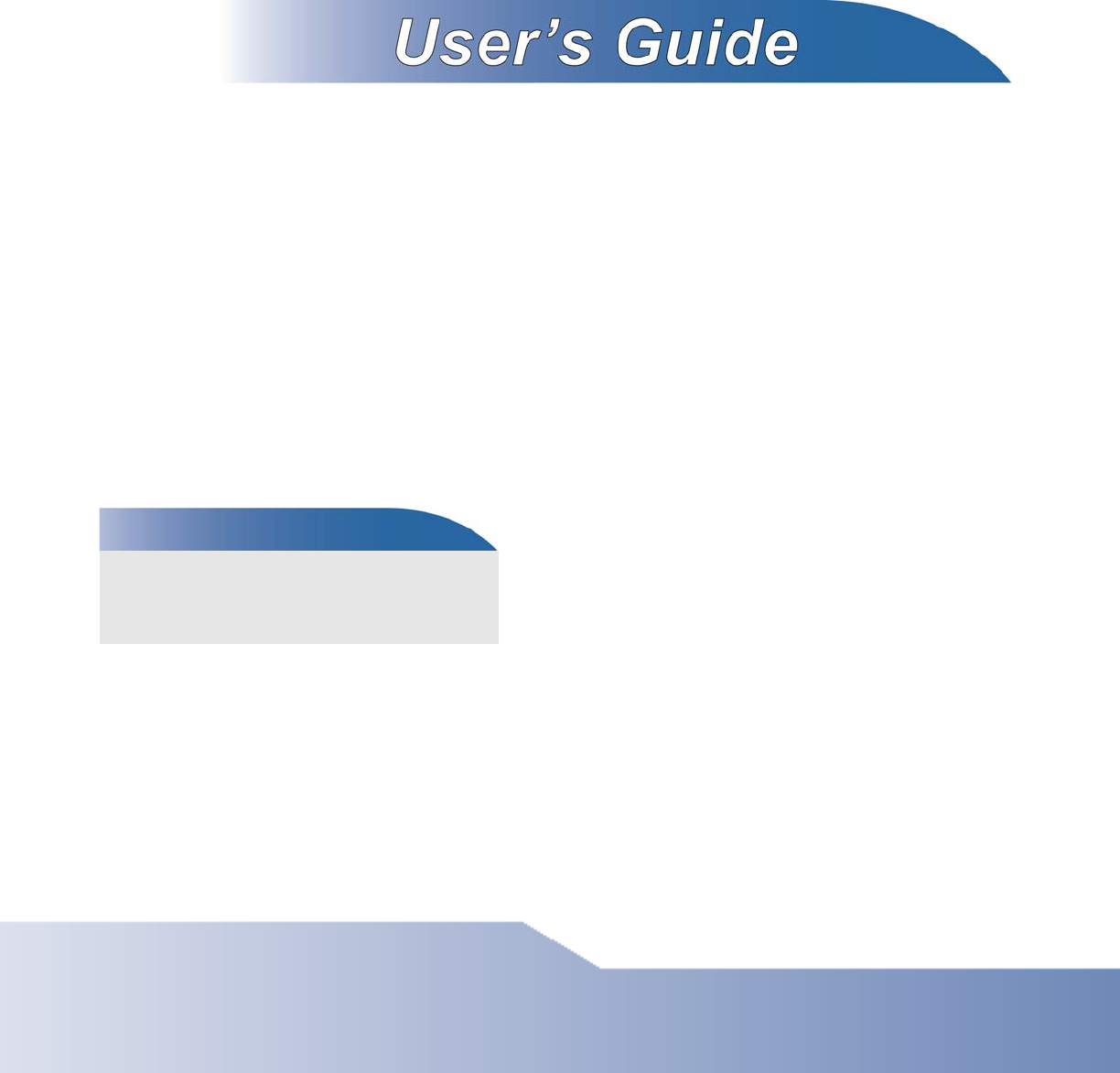
www.zyxel.com
www.zyxel.com
P-3202HN-Ba
802.11N GPON VoIP IAD
Copyright © 2009
ZyXEL Communications Corporation
Version 1.0
Edition 1, 12/2009
Default Login Details
IP Address 192.168.1.1
User Name admin
Password 1234

About This User's Guide
IAD User’s Guide 3
About This User's Guide
Intended Audience
This manual is intended for people who want to configure the IAD using the web
configurator. .
Related Documentation
•Quick Start Guide
The Quick Start Guide is designed to help you get your IAD up and running right
away. It contains information on setting up your network and configuring for
Internet access.
• Web Configurator Online Help
The embedded Web Help contains descriptions of individual screens and
supplementary information.
• Support Disc
Refer to the included CD for support documents.
Documentation Feedback
Send your comments, questions or suggestions to: techwriters@zyxel.com.tw
Thank you!
The Technical Writing Team, ZyXEL Communications Corp.,
6 Innovation Road II, Science-Based Industrial Park, Hsinchu, 30099, Taiwan.
Need More Help?
More help is available at www.zyxel.com.

About This User's Guide
IAD User’s Guide
4
• Download Library
Search for the latest product updates and documentation from this link. Read
the Tech Doc Overview to find out how to efficiently use the documentation in
order to better understand how to use your product.
• Knowledge Base
If you have a specific question about your product, the answer may be here.
This is a collection of answers to previously asked questions about ZyXEL
products.
•Forum
This contains discussions on ZyXEL products. Learn from others who use ZyXEL
products and share your experiences as well.
Customer Support
Should problems arise that cannot be solved by the methods listed above, you
should contact your vendor. If you cannot contact your vendor, then contact a
ZyXEL office for the region in which you bought the device.
See http://www.zyxel.com/web/contact_us.php for contact information. Please
have the following information ready when you contact an office.
• Product model and serial number.
•Warranty Information.
• Date that you received your device.
• Brief description of the problem and the steps you took to solve it.

Document Conventions
IAD User’s Guide 5
Document Conventions
Warnings and Notes
These are how warnings and notes are shown in this User’s Guide.
Warnings tell you about things that could harm you or your device.
Note: Notes tell you other important information (for example, other things you may
need to configure or helpful tips) or recommendations.
Syntax Conventions
• This product may be referred to as the “IAD”, the “device” or the “system” in
this User’s Guide.
• Product labels, screen names, field labels and field choices are all in bold font.
• A key stroke is denoted by square brackets and uppercase text, for example,
[ENTER] means the “enter” or “return” key on your keyboard.
• “Enter” means for you to type one or more characters and then press the
[ENTER] key. “Select” or “choose” means for you to use one of the predefined
choices.
• A right angle bracket ( > ) within a screen name denotes a mouse click. For
example, Maintenance > Log > Log Setting means you first click
Maintenance in the navigation panel, then the Log sub menu and finally the
Log Setting tab to get to that screen.
• Units of measurement may denote the “metric” value or the “scientific” value.
For example, “k” for kilo may denote “1000” or “1024”, “M” for mega may
denote “1000000” or “1048576” and so on.
• “e.g.,” is a shorthand for “for instance”, and “i.e.,” means “that is” or “in other
words”.
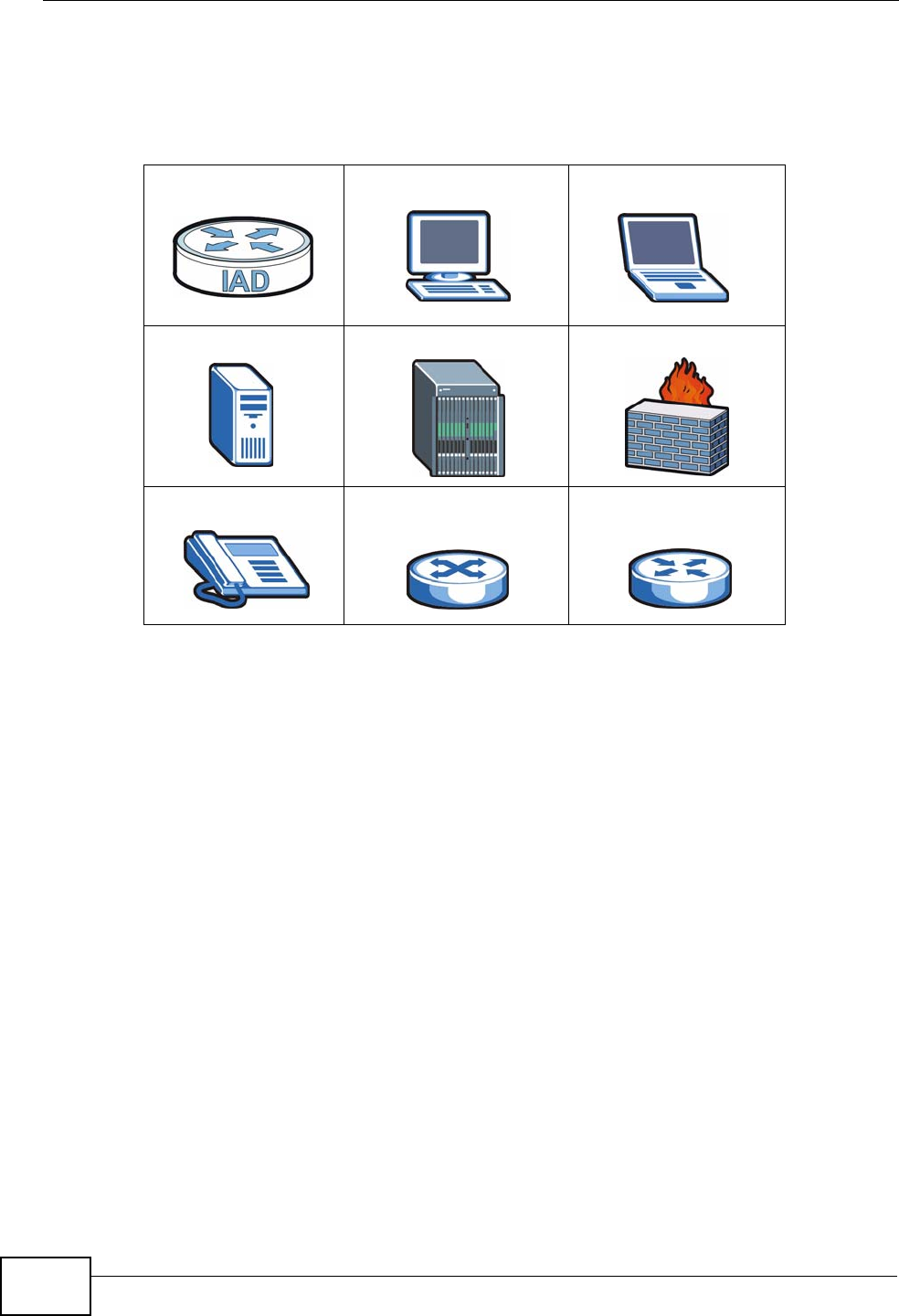
Document Conventions
IAD User’s Guide
6
Icons Used in Figures
Figures in this User’s Guide may use the following generic icons. The IAD icon is
not an exact representation of your device.
IAD Computer Notebook computer
Server DSLAM Firewall
Telephone Switch Router

Safety Warnings
IAD User’s Guide 7
Safety Warnings
• Do NOT use this product near water, for example, in a wet basement or near a swimming
pool.
• Do NOT expose your device to dampness, dust or corrosive liquids.
• Do NOT store things on the device.
• Do NOT install, use, or service this device during a thunderstorm. There is a remote risk
of electric shock from lightning.
• Connect ONLY suitable accessories to the device.
• Do NOT open the device or unit. Opening or removing covers can expose you to
dangerous high voltage points or other risks. ONLY qualified service personnel should
service or disassemble this device. Please contact your vendor for further information.
• Make sure to connect the cables to the correct ports.
• Place connecting cables carefully so that no one will step on them or stumble over them.
• Always disconnect all cables from this device before servicing or disassembling.
• Use ONLY an appropriate power adaptor or cord for your device.
• Connect the power adaptor or cord to the right supply voltage (for example, 110V AC in
North America or 230V AC in Europe).
• Do NOT allow anything to rest on the power adaptor or cord and do NOT place the
product where anyone can walk on the power adaptor or cord.
• Do NOT use the device if the power adaptor or cord is damaged as it might cause
electrocution.
• If the power adaptor or cord is damaged, remove it from the device and the power
source.
• Do NOT attempt to repair the power adaptor or cord. Contact your local vendor to order a
new one.
• Do not use the device outside, and make sure all the connections are indoors. There is a
remote risk of electric shock from lightning.
• Do NOT obstruct the device ventilation slots, as insufficient airflow may harm your
device.
• Use only No. 26 AWG (American Wire Gauge) or larger telecommunication line cord.
• Antenna Warning! This device meets ETSI and FCC certification requirements when using
the included antenna(s). Only use the included antenna(s).
• If you wall mount your device, make sure that no electrical lines, gas or water pipes will
be damaged.
Your product is marked with this symbol, which is known as the
WEEE mark. WEEE stands for Waste Electronics and Electrical
Equipment. It means that used electrical and electronic products
should not be mixed with general waste. Used electrical and
electronic equipment should be treated separately.

Safety Warnings
IAD User’s Guide
8

Contents Overview
IAD User’s Guide 9
Contents Overview
User’s Guide ...........................................................................................................................19
Introduction ................................................................................................................................ 21
The Web Configurator ............................................................................................................... 29
Tutorials ..................................................................................................................................... 35
Technical Reference ..............................................................................................................39
Status Screens .......................................................................................................................... 41
Device Mode Screen ................................................................................................................. 51
WAN .......................................................................................................................................... 55
LAN Setup ................................................................................................................................. 59
Wireless LAN ............................................................................................................................. 69
Network Address Translation (NAT) ........................................................................................ 101
Voice .........................................................................................................................................117
Phone Usage ........................................................................................................................... 129
Firewalls .................................................................................................................................. 137
Static Route ............................................................................................................................. 159
Quality of Service (QoS) .......................................................................................................... 163
Dynamic DNS Setup ................................................................................................................ 179
Remote Management ..............................................................................................................183
Universal Plug-and-Play (UPnP) ............................................................................................. 197
System ......................................................................................................................................211
Logs ........................................................................................................................................ 215
Tools ........................................................................................................................................ 219
Diagnostic ............................................................................................................................... 223
Troubleshooting ....................................................................................................................... 225
Product Specifications ............................................................................................................. 231

Contents Overview
IAD User’s Guide
10

Table of Contents
IAD User’s Guide 11
Table of Contents
About This User's Guide..........................................................................................................3
Document Conventions............................................................................................................5
Safety Warnings........................................................................................................................7
Contents Overview ...................................................................................................................9
Table of Contents....................................................................................................................11
Part I: User’s Guide................................................................................ 19
Chapter 1
Introduction.............................................................................................................................21
1.1 Overview .............................................................................................................................. 21
1.2 Managing the IAD ................................................................................................................ 21
1.3 Good Habits for Managing the IAD ...................................................................................... 21
1.4 Applications for the IAD ....................................................................................................... 22
1.4.1 Internet Access and Device Mode ............................................................................. 22
1.4.2 Internet Calls (VoIP) ................................................................................................... 23
1.4.3 Wireless Connection .................................................................................................. 23
1.4.4 Triple Play .................................................................................................................. 24
1.5 The Reset Button ................................................................................................................. 25
1.5.1 Using the Reset Button .............................................................................................. 25
1.6 LEDs (Lights) ....................................................................................................................... 26
Chapter 2
The Web Configurator ............................................................................................................29
2.1 Overview ............................................................................................................................. 29
2.1.1 Accessing the Web Configurator ................................................................................ 29
2.2 Web Configurator Main Screen ........................................................................................... 31
2.2.1 Title Bar ...................................................................................................................... 31
2.2.2 Navigation Panel ........................................................................................................ 32
2.2.3 Main Window ..............................................................................................................34
2.2.4 Status Bar ................................................................................................................... 34
Chapter 3
Tutorials...................................................................................................................................35

Table of Contents
IAD User’s Guide
12
3.1 Overview .............................................................................................................................. 35
3.2 Getting Starting with the IAD ............................................................................................... 35
3.3 Placing Phone Calls Over the Internet ................................................................................ 36
Part II: Technical Reference.................................................................. 39
Chapter 4
Status Screens ........................................................................................................................41
4.1 Overview .............................................................................................................................. 41
4.2 Status Screen ...................................................................................................................... 42
4.2.1 VoIP Status ................................................................................................................. 47
4.2.2 WLAN Status ..............................................................................................................49
Chapter 5
Device Mode Screen...............................................................................................................51
5.1 Overview .............................................................................................................................. 51
5.1.1 Hybrid Mode (Router Mode) ....................................................................................... 51
5.1.2 Bridge Mode ............................................................................................................... 51
5.2 Device Mode Screen ........................................................................................................... 52
Chapter 6
WAN..........................................................................................................................................55
6.1 Overview .............................................................................................................................. 55
6.1.1 What You Need to Know ............................................................................................ 55
6.2 Internet Access Setup ........................................................................................................ 56
Chapter 7
LAN Setup................................................................................................................................59
7.1 LAN Overview ..................................................................................................................... 59
7.1.1 LANs, WANs and the ZyXEL Device .......................................................................... 59
7.1.2 DHCP Setup ...............................................................................................................59
7.2 DNS Server Addresses .......................................................................................................60
7.3 LAN TCP/IP ......................................................................................................................... 60
7.3.1 IP Address and Subnet Mask ..................................................................................... 61
7.3.2 RIP Setup ................................................................................................................... 62
7.3.3 Multicast ..................................................................................................................... 62
7.4 Configuring LAN IP and DHCP ........................................................................................... 63
7.5 LAN Client List ..................................................................................................................... 65
7.6 LAN IP Alias ........................................................................................................................ 66
Chapter 8
Wireless LAN...........................................................................................................................69

Table of Contents
IAD User’s Guide 13
8.1 Overview .............................................................................................................................. 69
8.1.1 What You Can Do in this Chapter .............................................................................. 69
8.2 What You Need to Know ......................................................................................................70
8.3 Before You Begin ................................................................................................................. 72
8.4 The General Screen ........................................................................................................... 73
8.4.1 No Security ................................................................................................................. 75
8.4.2 WEP Encryption ......................................................................................................... 76
8.4.3 WPA(2)-PSK .............................................................................................................. 77
8.4.4 WPA(2) Authentication ............................................................................................... 78
8.4.5 MAC Filter ............................................................................................................. 80
8.4.6 Adding a New MAC Filtering Rule ......................................................................... 81
8.5 The More AP Screen .......................................................................................................... 82
8.5.1 More AP Edit .............................................................................................................. 83
8.6 The WPS Screen ................................................................................................................ 83
8.7 The WPS Station Screen ....................................................................................................85
8.8 The WDS Screen ................................................................................................................ 86
8.9 The Advanced Setup Screen .............................................................................................. 88
8.10 Technical Reference .......................................................................................................... 89
8.10.1 Wireless Network Overview ..................................................................................... 90
8.10.2 Additional Wireless Terms ........................................................................................ 91
8.10.3 Wireless Security Overview ..................................................................................... 91
8.10.4 WiFi Protected Setup ............................................................................................... 93
Chapter 9
Network Address Translation (NAT)....................................................................................101
9.1 Overview ........................................................................................................................... 101
9.1.1 What You Can Do in this Chapter ............................................................................ 101
9.1.2 What You Need To Know ......................................................................................... 101
9.2 The NAT General Screen .................................................................................................. 102
9.3 The Port Forwarding Screen ............................................................................................ 104
9.3.1 Configuring the Port Forwarding Screen .................................................................. 105
9.3.2 The Port Forwarding Rule Edit Screen .................................................................... 107
9.4 The Address Mapping Screen ........................................................................................... 108
9.4.1 The Address Mapping Rule Edit Screen ...................................................................110
9.5 The ALG Screen ................................................................................................................111
9.6 NAT Technical Reference ...................................................................................................112
9.6.1 NAT Definitions .........................................................................................................112
9.6.2 What NAT Does ........................................................................................................112
9.6.3 How NAT Works ........................................................................................................113
9.6.4 NAT Application .........................................................................................................114
9.6.5 NAT Mapping Types ..................................................................................................114
9.6.6 Port Translation .........................................................................................................115

Table of Contents
IAD User’s Guide
14
Chapter 10
Voice....................................................................................................................................... 117
10.1 Introduction ......................................................................................................................117
10.1.1 What You Need to Know .........................................................................................117
10.2 SIP Service Provider ........................................................................................................118
10.2.1 Advanced SIP Settings .......................................................................................... 120
10.3 SIP Account ..................................................................................................................... 122
10.3.1 Advanced Account Settings ................................................................................... 123
10.4 Analog Phone ................................................................................................................. 125
10.5 Speed Dial ...................................................................................................................... 126
Chapter 11
Phone Usage.........................................................................................................................129
11.1 Overview .......................................................................................................................... 129
11.2 Dialing a Telephone Number ............................................................................................ 129
11.3 Using Speed Dial ............................................................................................................. 129
11.4 Using Call Park and Pickup ............................................................................................. 129
11.5 Checking the IAD’s IP Address ........................................................................................ 130
11.6 Auto Provisioning and Auto Firmware Upgrade ............................................................... 130
11.7 Phone Services Overview ................................................................................................ 131
11.7.1 The Flash Key ........................................................................................................ 131
11.7.2 Europe Type Supplementary Phone Services ........................................................ 131
11.7.3 USA Type Supplementary Services ....................................................................... 133
11.8 Phone Functions Summary .............................................................................................. 135
Chapter 12
Firewalls.................................................................................................................................137
12.1 Overview ......................................................................................................................... 137
12.1.1 What You Can Do in this Chapter .......................................................................... 138
12.1.2 What You Need to Know ........................................................................................ 138
12.1.3 Firewall Rule Setup Example ................................................................................. 140
12.2 The Firewall General Screen .......................................................................................... 143
12.3 The Firewall Rules Screen .............................................................................................. 145
12.3.1 Configuring Firewall Rules ................................................................................... 146
12.3.2 Customized Services ............................................................................................ 149
12.3.3 Configuring A Customized Service ...................................................................... 150
12.4 The Firewall Threshold Screen ........................................................................................ 151
12.4.1 Threshold Values ................................................................................................... 151
12.4.2 Configuring Firewall Thresholds ............................................................................. 152
12.5 Technical Reference ........................................................................................................ 154
12.5.1 Guidelines For Enhancing Security With Your Firewall .......................................... 154
12.5.2 Security Considerations ......................................................................................... 154
12.5.3 Triangle Route ........................................................................................................ 155

Table of Contents
IAD User’s Guide 15
Chapter 13
Static Route ...........................................................................................................................159
13.1 Overview ....................................................................................................................... 159
13.1.1 What You Can Do in this Chapter .......................................................................... 159
13.2 The Static Route Screen .................................................................................................. 160
13.2.1 Static Route Edit ................................................................................................... 161
Chapter 14
Quality of Service (QoS).......................................................................................................163
14.1 Overview ......................................................................................................................... 163
14.1.1 What You Can Do in this Chapter .......................................................................... 163
14.1.2 What You Need to Know ........................................................................................ 164
14.2 The QoS General Screen ............................................................................................... 164
14.3 The Class Setup Screen ................................................................................................ 166
14.3.1 Class Configuration ............................................................................................... 168
14.3.2 QoS Example ......................................................................................................... 171
14.4 The QoS Monitor Screen ................................................................................................ 175
14.5 Technical Reference ........................................................................................................ 175
14.5.1 IEEE 802.1Q Tag ................................................................................................... 176
14.5.2 IP Precedence ........................................................................................................ 176
14.5.3 DiffServ ................................................................................................................. 176
14.5.4 Automatic Priority Queue Assignment ................................................................... 177
Chapter 15
Dynamic DNS Setup .............................................................................................................179
15.1 Overview ........................................................................................................................ 179
15.1.1 What You Can Do in this Chapter .......................................................................... 179
15.1.2 What You Need To Know ....................................................................................... 179
15.2 The Dynamic DNS Screen ............................................................................................. 180
Chapter 16
Remote Management............................................................................................................183
16.1 Overview ......................................................................................................................... 183
16.1.1 What You Can Do in this Chapter .......................................................................... 184
16.1.2 What You Need to Know ........................................................................................ 184
16.2 The HTTP Screen ............................................................................................................ 185
16.3 The Telnet Screen ........................................................................................................... 186
16.4 The FTP Screen ............................................................................................................. 187
16.5 SNMP .............................................................................................................................. 188
16.5.1 Supported MIBs ..................................................................................................... 190
16.5.2 SNMP Traps ........................................................................................................... 190
16.5.3 The SNMP Screen ................................................................................................. 190
16.6 The DNS Screen ........................................................................................................... 191

Table of Contents
IAD User’s Guide
16
16.7 The ICMP Screen ............................................................................................................ 192
16.8 SSH ............................................................................................................................... 193
16.9 How SSH Works .............................................................................................................. 194
16.10 SSH Implementation on the IAD .................................................................................... 195
16.10.1 Requirements for Using SSH ............................................................................... 195
16.11 The SSH Screen ............................................................................................................ 195
Chapter 17
Universal Plug-and-Play (UPnP)..........................................................................................197
17.1 Overview ......................................................................................................................... 197
17.1.1 What You Can Do in this Chapter .......................................................................... 197
17.1.2 What You Need to Know ........................................................................................ 197
17.2 The UPnP Screen ............................................................................................................ 198
17.3 Installing UPnP in Windows Example .............................................................................. 199
17.4 Using UPnP in Windows XP Example ............................................................................. 203
Chapter 18
System ................................................................................................................................... 211
18.1 Overview ...........................................................................................................................211
18.1.1 What You Need to Know .........................................................................................211
18.2 General Setup ............................................................................................................... 212
18.3 Time Setting .................................................................................................................... 213
Chapter 19
Logs ......................................................................................................................................215
19.1 Overview .......................................................................................................................... 215
19.2 View Log .......................................................................................................................... 215
19.3 Log Settings .................................................................................................................... 217
Chapter 20
Tools.......................................................................................................................................219
20.1 Overview .......................................................................................................................... 219
20.1.1 Some Warnings ...................................................................................................... 219
20.2 Firmware Upgrade ......................................................................................................... 220
20.3 Configuration .................................................................................................................. 221
20.3.1 Backup Configuration ............................................................................................ 221
20.3.2 Restore Configuration ........................................................................................... 221
20.3.3 Reset to Factory Defaults ...................................................................................... 222
20.4 Restart ............................................................................................................................. 222
Chapter 21
Diagnostic .............................................................................................................................223
21.1 Overview .......................................................................................................................... 223

Table of Contents
IAD User’s Guide 17
21.2 General ........................................................................................................................... 223
Chapter 22
Troubleshooting....................................................................................................................225
22.1 Overview .......................................................................................................................... 225
22.2 Power, Hardware Connections, and LEDs ...................................................................... 225
22.3 IAD Access and Login ..................................................................................................... 226
22.4 Internet Access ................................................................................................................ 227
22.5 Phone Calls and VoIP ......................................................................................................228
Chapter 23
Product Specifications.........................................................................................................231
Appendix A Passive Optical Networks .................................................................................239
Appendix B Setting Up Your Computer’s IP Address...........................................................245
Appendix C Pop-up Windows, JavaScripts and Java Permissions......................................275
Appendix D IP Addresses and Subnetting ...........................................................................285
Appendix E Wireless LANs ..................................................................................................297
Appendix F Common Services.............................................................................................313
Appendix G Legal Information..............................................................................................317
Index.......................................................................................................................................321

Table of Contents
IAD User’s Guide
18

19
PART I
User’s Guide

20

IAD User’s Guide 21
CHAPTER 1
Introduction
1.1 Overview
This device is an Integrated Access Device (IAD) which combines high-speed fiber
optic (G-PON) Internet access, a built-in switch, wireless networking capability
and Voice over IP (VoIP) technology to allow you to use an analog telephone to
make phone calls over the Internet. The device also comes with one coaxial CATV
connector to connect to a television or set-top-box.
Please refer to the following description of the product name format.
• “H” denotes an integrated 4-port hub (switch).
• “N” denotes IEEE 802.11n wireless functionality. There is an embedded mini-PCI
module for IEEE 802.11b/g/n wireless LAN connectivity.
Only use firmware for your IAD’s specific model. Refer to the label
on the bottom of your IAD.
1.2 Managing the IAD
Use the IAD’s built-in Web Configurator to manage it. You can connect to it using a
web browser such as Firefox 2.0 (and higher) or Internet Explorer 6 (and higher).
The web configurator gives you access to all the available settings for this product.
For details on connecting to it, see the Quick Start Guide.
1.3 Good Habits for Managing the IAD
Do the following things regularly to make the IAD more secure and to manage the
IAD more effectively.
• Change the password. Use a password that’s not easy to guess and that consists
of different types of characters, such as numbers and letters.
• Write down the password and put it in a safe place.
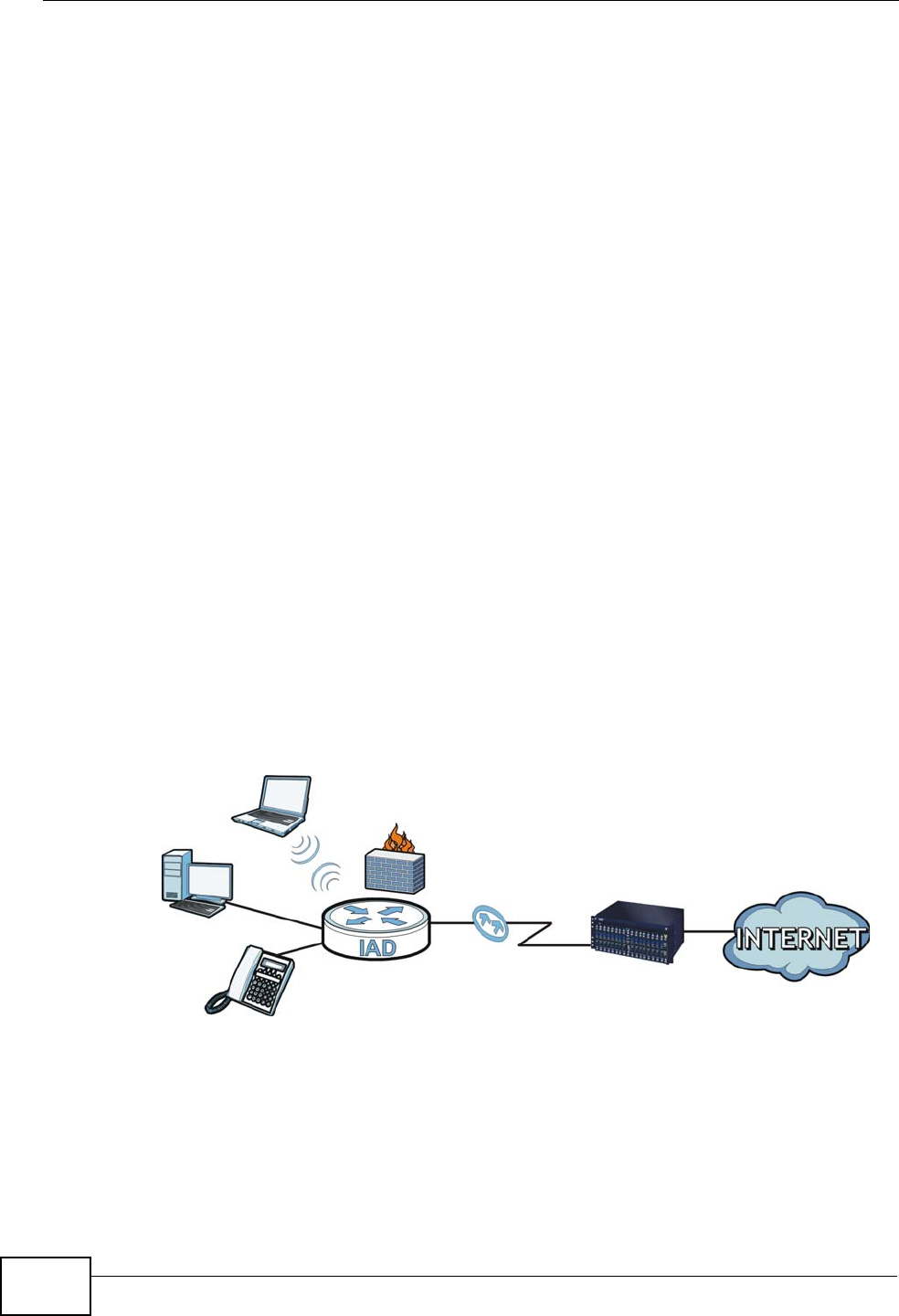
Chapter 1 Introduction
IAD User’s Guide
22
• Back up the configuration (and make sure you know how to restore it).
Restoring an earlier working configuration may be useful if the device becomes
unstable or even crashes. If you forget your password, you will have to reset the
IAD to its factory default settings. If you backed up an earlier configuration file,
you would not have to totally re-configure the IAD. You could simply restore
your last configuration.
1.4 Applications for the IAD
Here are some example uses for which the IAD is well suited.
1.4.1 Internet Access and Device Mode
Your IAD provides shared Internet access by connecting a fiber optic line provided
by your ISP to the PON port.
In hybrid mode, the IAD works as a router. You can enable NAT, firewall and use
Quality of Service (QoS) to efficiently manage traffic on your network by giving
priority to certain types of traffic and/or to particular computers.
If you have a router deployed in your network already, set the IAD to act as a
bridge. The routing features, such as NAT and static route are not available on the
IAD in bridge mode and QoS configuration is done remotely by the ISP’s OLT
(Optical Line Terminal). This allows you put the IAD into an existing network that
has a router with minimum configuration.
Figure 1 Internet Access Application (Router Mode)
OLT
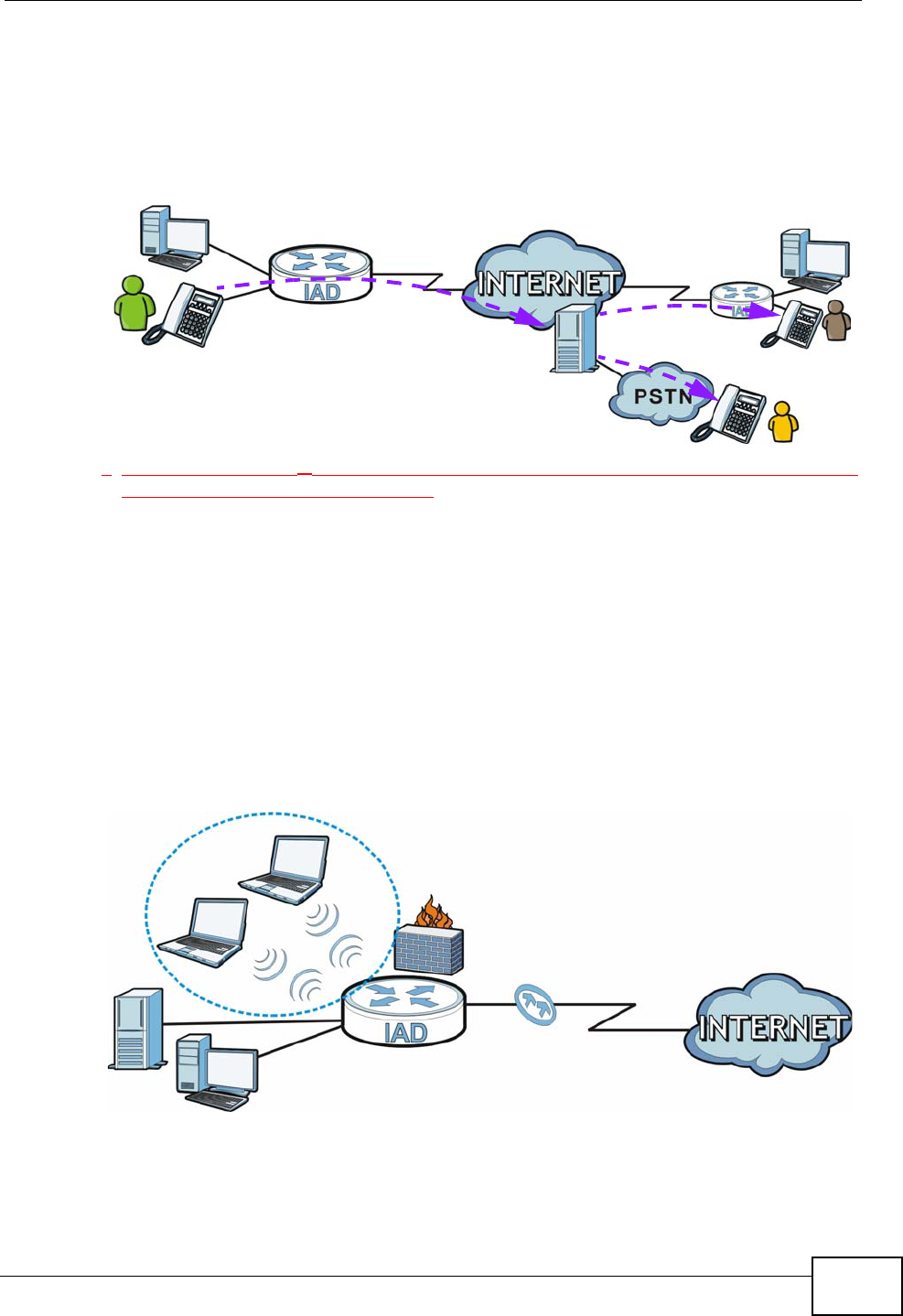
Chapter 1 Introduction
IAD User’s Guide 23
1.4.2 Internet Calls (VoIP)
You can register up to 2 SIP (Session Initiation Protocol) accounts and use the IAD
to make and receive VoIP telephone calls:
Figure 2 VoIP Applicarion
•Peer-to-Peer calls (A) - Use the IAD to make a call to the recipient’s IP address
without using a SIP proxy server.
• Calls via a VoIP service provider (A) - The IAD sends your call to a VoIP service
provider’s SIP server which forwards your calls to either VoIP or PSTN phones.
1.4.3 Wireless Connection
By default, the wireless LAN (WLAN) is enabled on the IAD. IEEE 802.11b/g
compliant clients can wirelessly connect to the IAD to access network resources.
You can set up a wireless network with WPS (WiFi Protected Setup) or manually
add a client to your wireless network.
Figure 3 Wireless Connection Application
A
LAN
WLAN
WAN

Chapter 1 Introduction
IAD User’s Guide
24
1.4.3.1 The WPS/WLAN Button
You can use the WPS/WLAN button on the top of the device to turn the wireless
LAN off or on. You can also use it to activate WPS in order to quickly set up a
wireless network with strong security.
Turn the Wireless LAN Off or On
1Make sure the POWER LED is on (not blinking).
2Press the WPS/WLAN button for one second and release it. The WLAN/WPS
LED should change from on to off or vice versa.
Activate WPS
1Make sure the POWER LED is on (not blinking).
2Press the WPS/WLAN button for more than five seconds and release it. Press the
WPS button on another WPS -enabled device within range of the IAD. The WLAN/
WPS LED should flash while the IAD sets up a WPS connection with the wireless
device.
Note: You must activate WPS in the IAD and in another wireless device within two
minutes of each other. See Section 7.10.4 on page 151 for more information.
1.4.4 Triple Play
Your ISP may provide “triple play” service to your IAD. This allows you to take
advantage of such features as broadband Internet access, Voice over IP telephony,
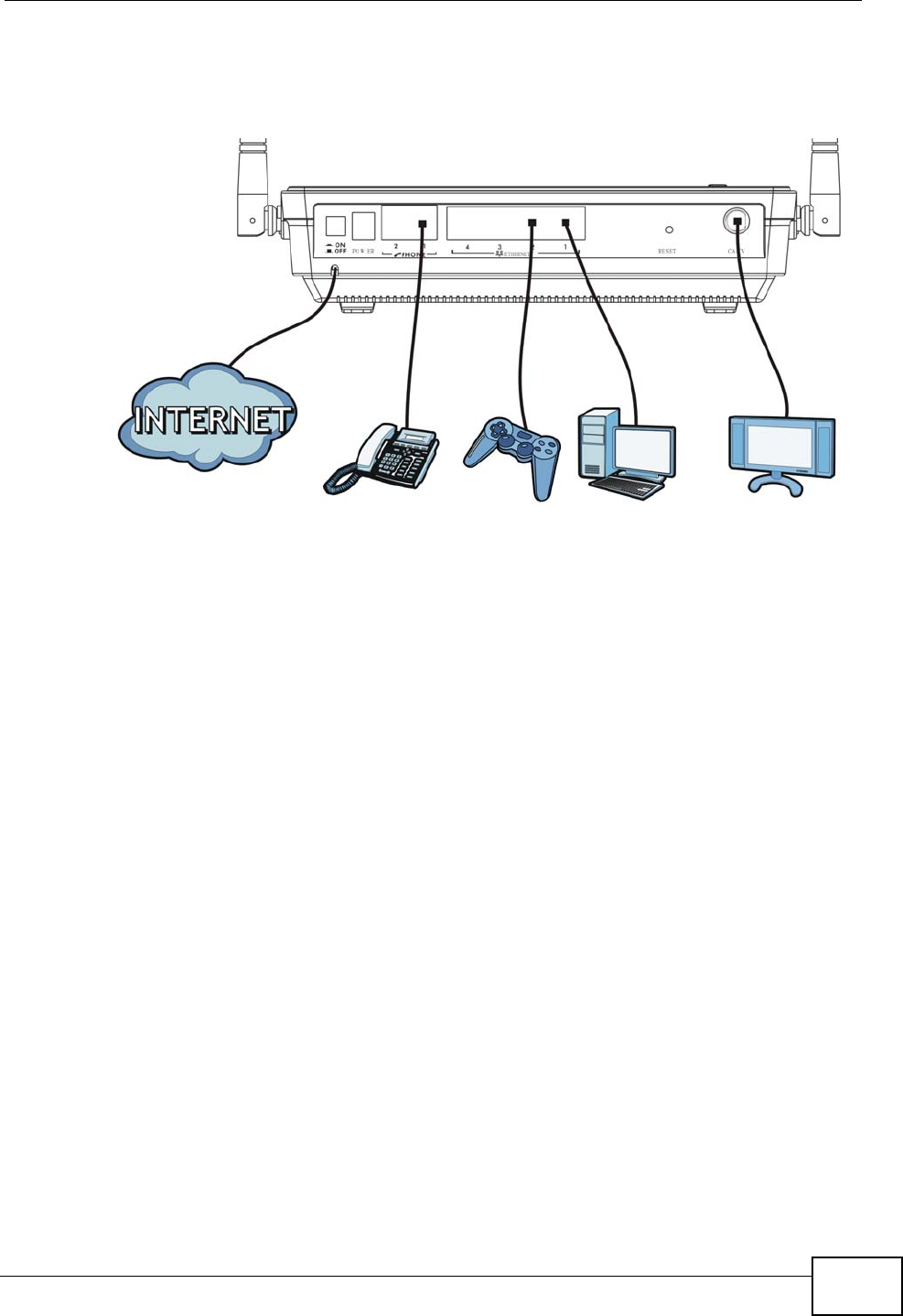
Chapter 1 Introduction
IAD User’s Guide 25
and streaming video/audio media, all at the same time with no noticeable loss in
bandwidth.
Figure 4 Triple Play Example
1.5 The Reset Button
If you forget your password or cannot access the web configurator, you will need
to use the RESET button at the back of the device to reload the factory-default
configuration file. This means that you will lose all configurations that you had
previously and the password will be reset to “1234”.
1.5.1 Using the Reset Button
1Make sure the POWER LED is on (not blinking).
2To set the device back to the factory default settings, press the RESET button for
ten seconds or until the POWER LED begins to blink and then release it. When the
POWER LED begins to blink, the defaults have been restored and the device
restarts.
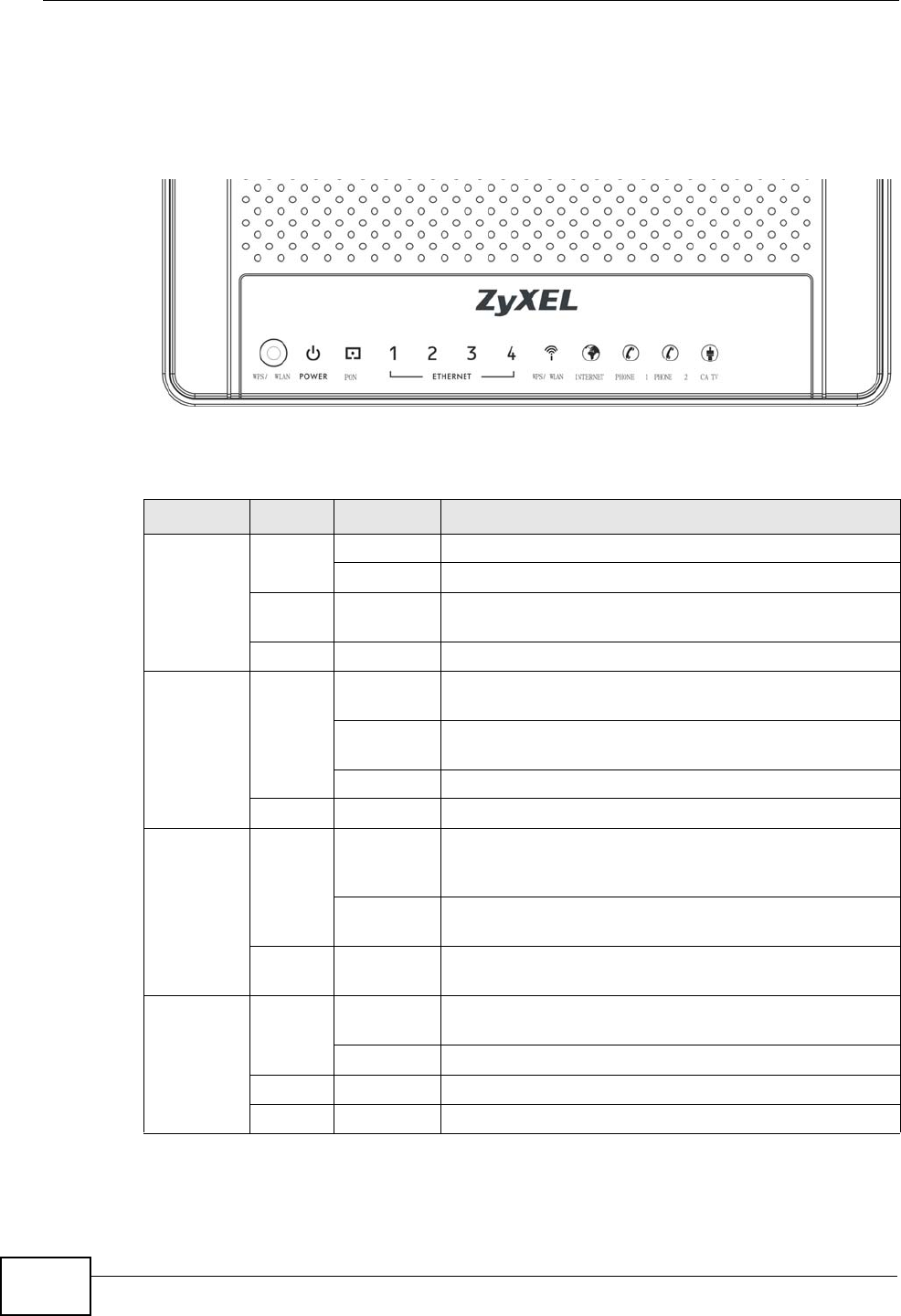
Chapter 1 Introduction
IAD User’s Guide
26
1.6 LEDs (Lights)
The following graphic displays the labels of the LEDs.
Figure 5 LEDs on the Top Panel
None of the LEDs are on if the IAD is not receiving power.
Table 1 LED Descriptions
LED COLOR STATUS DESCRIPTION
POWER Green On The IAD is receiving power and ready for use.
Blinking The IAD is self-testing.
Red On The IAD detected an error while self-testing, or there
is a device malfunction.
Off The IAD is not receiving power.
PON Green On The IAD has established a PON line connection with
the ISP.
Off The IAD has not established a PON connection with
the ISP or the fiber optic line is down.
Blinking The IAD is in the process of downloading firmware.
Red On The IAD PON link has failed or has generated errors.
ETHERNET
1~4 Green On The IAD has an Ethernet connection with another
device (such as a computer) on the Local Area
Network (LAN) through this port.
Blinking The IAD is sending/receiving data to /from the LAN
through this port.
Off The IAD does not have an Ethernet connection with
the LAN through this port.
WPS/
WLAN Green On The wireless network is activated and is operating in
IEEE 802.11b/g/n mode.
Blinking The IAD is communicating with other wireless clients.
Orange Blinking The IAD is setting up a WPS connection.
Off The wireless network is not activated.

Chapter 1 Introduction
IAD User’s Guide 27
Refer to the Quick Start Guide for information on hardware connections.
INTERNET Green On The IAD has an IP connection but no traffic.
Your device has a WAN IP address (either static or
assigned by a DHCP server), PPP negotiation was
successfully completed (if used) and the DSL
connection is up.
Blinking The IAD is sending or receiving IP traffic.
Red On The IAD attempted to make an IP connection but
failed. Possible causes are no response from a DHCP
server, no PPPoE response, PPPoE authentication
failed.
Off The IAD does not have an IP connection, or the IAD is
in bridge mode.
PHONE 1/2 Green On A SIP account is registered for the phone port.
Blinking A telephone connected to the phone port has its
receiver off of the hook or there is an incoming call.
Orange On A SIP account is registered for the phone port and
there is a voice message in the corresponding SIP
account.
Blinking A telephone connected to the phone port has its
receiver off of the hook and there is a voice message
in the corresponding SIP account.
Off The phone port does not have a SIP account
registered.
CATV Green On The IAD is receiving video signals.
Off The IAD is not receiving video signals.
Table 1 LED Descriptions
LED COLOR STATUS DESCRIPTION

Chapter 1 Introduction
IAD User’s Guide
28

IAD User’s Guide 29
CHAPTER 2
The Web Configurator
2.1 Overview
The web configurator is an HTML-based management interface that allows easy
device setup and management via Internet browser. Use Internet Explorer 6.0 and
later or Firefox 2.0 and later versions. The recommended screen resolution is
1024 by 768 pixels.
In order to use the web configurator you need to allow:
• Web browser pop-up windows from your device. Web pop-up blocking is enabled
by default in Windows XP SP (Service Pack) 2.
• JavaScript (enabled by default).
• Java permissions (enabled by default).
See Appendix C on page 275 if you need to make sure these functions are allowed
in Internet Explorer.
2.1.1 Accessing the Web Configurator
1Make sure your IAD hardware is properly connected (refer to the Quick Start
Guide for details on this).
2Launch your web browser.
3Type "192.168.1.1" as the URL.
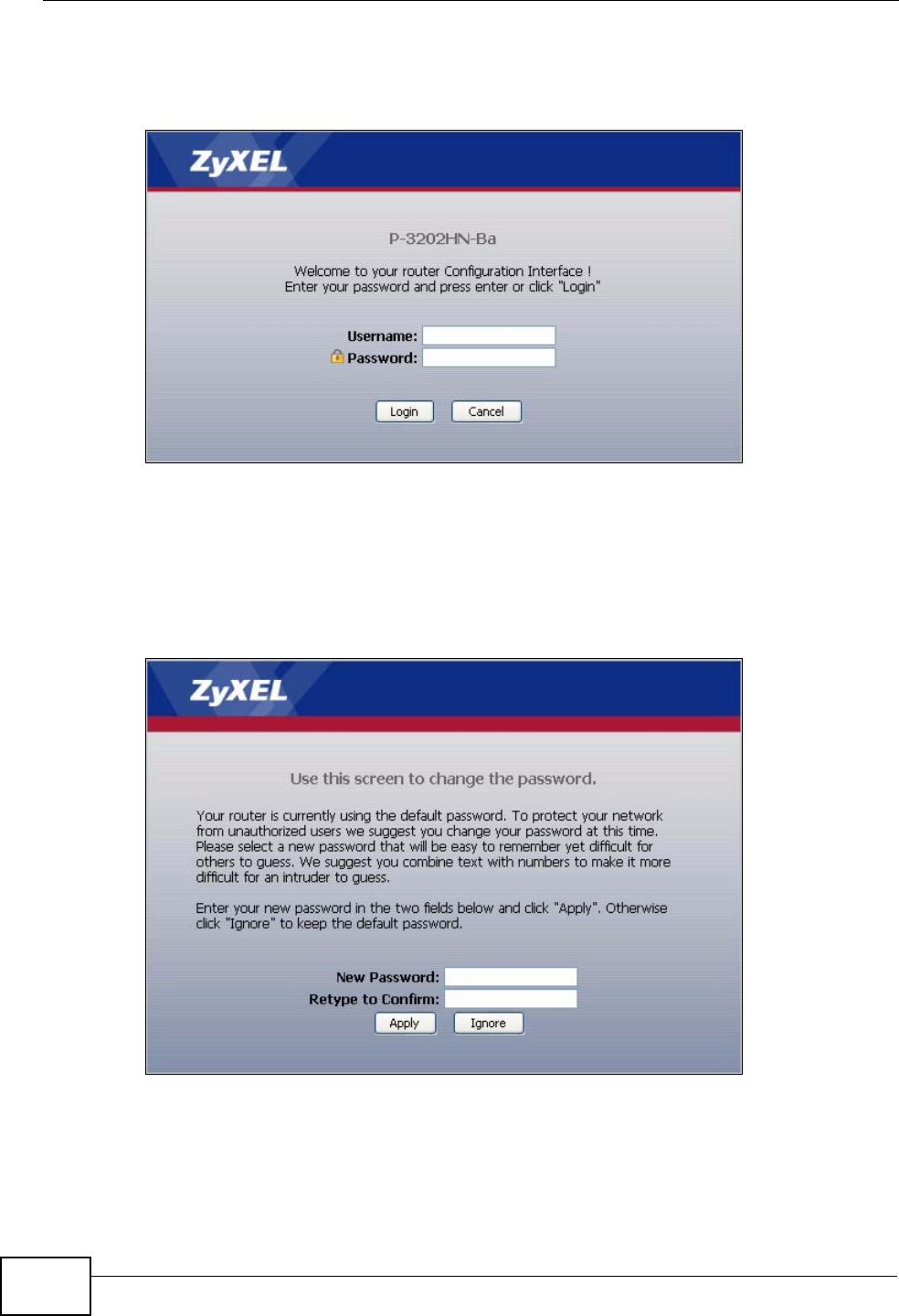
Chapter 2 The Web Configurator
IAD User’s Guide
30
4A password screen displays. Enter your user name and password. The default user
name is admin and the default password is 1234. Click Login.
Figure 6 Password Screen
5The following screen displays if you have not yet changed your password. It is
strongly recommended you change the default password. Enter a new password of
up to 30 characters, retype it to confirm and click Apply; alternatively click
Ignore to proceed to the main menu if you do not want to change the password
now.
Figure 7 Change Password Screen
Note: For security reasons, the IAD automatically logs you out if you do not use the
web configurator for five minutes (default). If this happens, log in again.
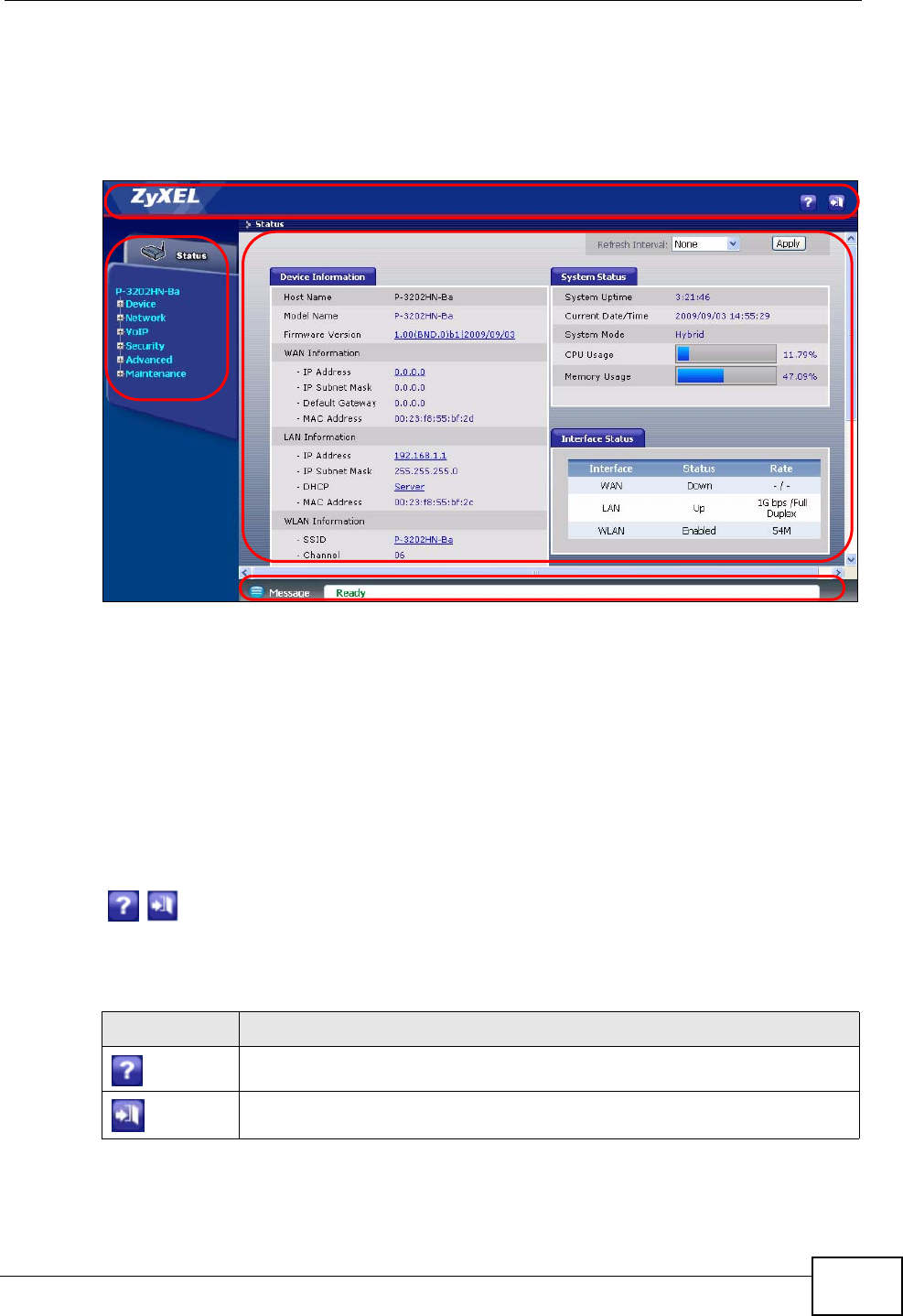
Chapter 2 The Web Configurator
IAD User’s Guide 31
2.2 Web Configurator Main Screen
The main screen is divided into these parts:
Figure 8 Main Screen
•A - title bar
•B - navigation panel
•C - main window
•D - status bar
2.2.1 Title Bar
The title bar allows you to change the language and provides some icons in the
upper right corner.
The icons provide the following functions:
A
B
C
D
Table 2 Web Configurator Icons in the Title Bar
ICON DESCRIPTION
Help: Click this icon to open the online help.
Logout: Click this icon to log out of the web configurator.

Chapter 2 The Web Configurator
IAD User’s Guide
32
2.2.2 Navigation Panel
Use the menu items on the navigation panel to open screens to configure IAD
features. The following tables describe each menu item.
Table 3 Navigation Panel Summary
LINK TAB FUNCTION
Status This screen shows the IAD’s general device and network status
information. Use this screen to access the statistics and client list.
Device
Device Mode Use this screen to select whether the IAD acts as a router
(Hybrid Mode) or a bridge (Bridge Mode).
Network
WAN Internet
Access Setup Use this screen to configure ISP parameters, WAN IP address
assignment, DNS servers and other advanced properties.
LAN IP Use this screen to configure LAN TCP/IP settings, enable Any IP
and other advanced properties.
Wireless LAN General Use this screen to configure the wireless LAN settings, WLAN
authentication/security settings.
WPS Use this screen to enable WPS (Wi-Fi Protected Setup) and view
the WPS status.
WPS Station Use this screen to use WPS to set up your wireless network.
MAC Filter Use this screen to configure MAC filtering rules.
QoS Use this screen to enable WMM QoS (Wi-Fi MultiMedia Quality of
Service). WMM QoS allows you to prioritize wireless traffic
according to the delivery requirements of individual services.
NAT General Use this screen to enable NAT on the IAD.
Port
Forwarding Use this screen to make your local servers visible to the outside
world.
ALG Use this screen to allow certain applications to pass through the
IAD.
VoIP
SIP SIP Service
Provider Use this screen to configure the SIP settings used by the IAD
when you place calls over the Internet.
SIP Account Use this screen to configure your SIP account information.
Phone Analog Phone Use this screen to set which phone ports use which SIP accounts.
Phone Book Speed Dial Use this screen to configure speed dial for SIP phone numbers
that you call often.
Security
Firewall General Use this screen to activate/deactivate the firewall and the default
action to take on network traffic going in specific directions.
Rules This screen shows a summary of the firewall rules, and allows you
to edit/add a firewall rule.
Advanced

Chapter 2 The Web Configurator
IAD User’s Guide 33
Static Route Static Route Use this screen to configure IP static routes to tell your device
about networks beyond the directly connected remote nodes.
Bandwidth
MGMT General Use this screen to enable QoS and configure bandwidth
management on the WAN.
Rule Setup Use this screen to define a classifier.
QoS Monitor Use this screen to view QoS packets statistics.
Dynamic DNS This screen allows you to use a static hostname alias for a
dynamic IP address.
Remote
MGMT WWW Use this screen to configure through which interface(s) and from
which IP address(es) users can use HTTP to manage the IAD.
Telnet Use this screen to configure through which interface(s) and from
which IP address(es) users can use Telnet to manage the IAD.
FTP Use this screen to configure through which interface(s) and from
which IP address(es) users can use FTP to access the IAD.
SSH Use this screen to configure Secure SHell (SSH) connections to
and from the IAD.
ICMP Use this screen to set whether or not your device will respond to
pings and probes for services that you have not made available.
TR-069 Use this screen to enable remote management via TR-069 on the
WAN.
Maintenance
System General Use this screen to configure your device’s name, management
inactivity timeout and password.
Time Setting Use this screen to change your IAD’s time and date.
Logs View Log Use this screen to display your device’s logs.
Log Settings Use this screen to select which logs and/or immediate alerts your
device is to record. You can also set it to e-mail the logs to you.
Tools Firmware Use this screen to upload firmware to your device.
Configuration Use this screen to backup and restore your device’s configuration
(settings) or reset the factory default settings.
Restart This screen allows you to reboot the IAD without turning the
power off.
Diagnostic General Use this screen to test the connections to other devices.
Table 3 Navigation Panel Summary
LINK TAB FUNCTION

Chapter 2 The Web Configurator
IAD User’s Guide
34
2.2.3 Main Window
The main window displays information and configuration fields. It is discussed in
the rest of this document.
Right after you log in, the Status screen is displayed. See Chapter 4 on page 41
for more information about the Status screen.
2.2.4 Status Bar
Check the status bar when you click Apply or OK to verify that the configuration
has been updated.

IAD User’s Guide 35
CHAPTER 3
Tutorials
3.1 Overview
This chapter introduces you to some basic networking and Voice over IP (VoIP)
concepts as well as how to configure your IAD for specific functions.
3.2 Getting Starting with the IAD
This quick overview provides pointers on where in this User’s Guide you can go to
get started with configuring and using the IAD.
Your IAD may have come pre-configured from your ISP. If such is
the case, changing any network settings may affect your ability to
get online or connect to other computers on your network.
1Install the device as described in the included Quick Start Guide.
2Connect and login to the Web Configurator at its default IP address as described in
Section 2.2 on page 31. This is where you configure all available settings related
to your device and its network connections. You will most likely need to connect to
the IAD directly from your computer rather than over an existing network, since
the device’s default IP address won’t match that network’s existing topology.
3Once you’re in the Web Configurator, you can assign the IAD a new Local Area
Network (LAN) IP address. This allows you to position in your LAN topology where
you it is most beneficial to you. See Section 7.4 on page 63 for details.
4If you were given settings to configure the IAD’s WAN connection, then you can do
so in Section 6.2 on page 56.
5Finally, if you have a SIP account and want to place phone calls over the Internet,
see Section 3.3 on page 36.
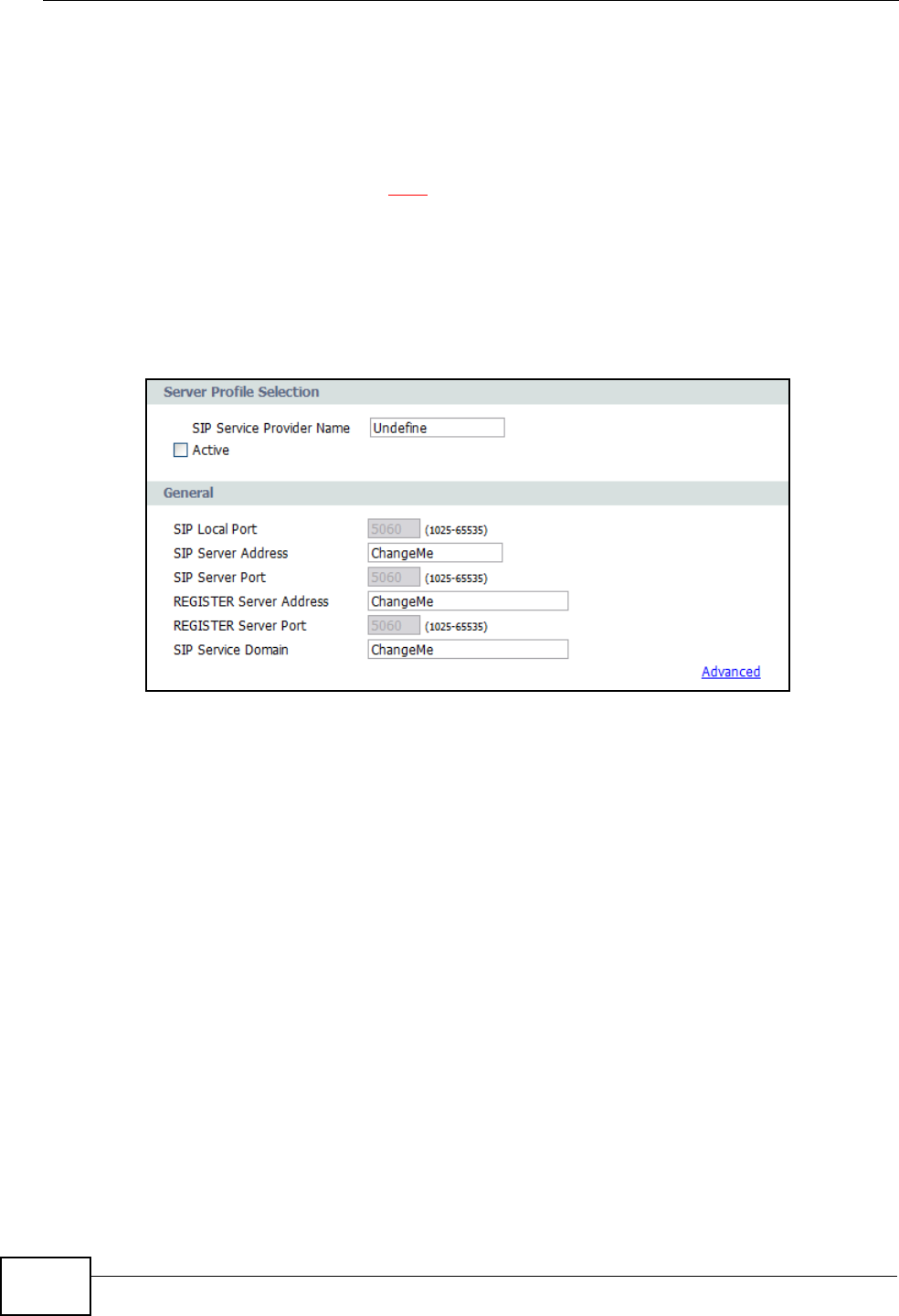
Chapter 3 Tutorials
IAD User’s Guide
36
3.3 Placing Phone Calls Over the Internet
The IAD allows you to plug an analog phone into it and place calls over the
Internet as if you were using an IP Phone or a SIP phone. Making Internet phone
calls requries that first have a SIP account set up with either your ISP (if they
provide such a service) or with a third-party SIP provider.
To configure your SIP settings:
1Connect to the Web Configurator (see the Quick Start Guide for details).
2Open the VoIP > SIP screen, enter the following information, then click Apply:
Active - Select this to enable these SIP service settings. If left unchecked, then
any configuration you do here will be saved but left unused.
SIP Local Port, SIP Server Address, SIP Server Port, Register Server
Address, Register Server Port, SIP Server Domain - These server settings
are provided by the company that issues your VoIP account.
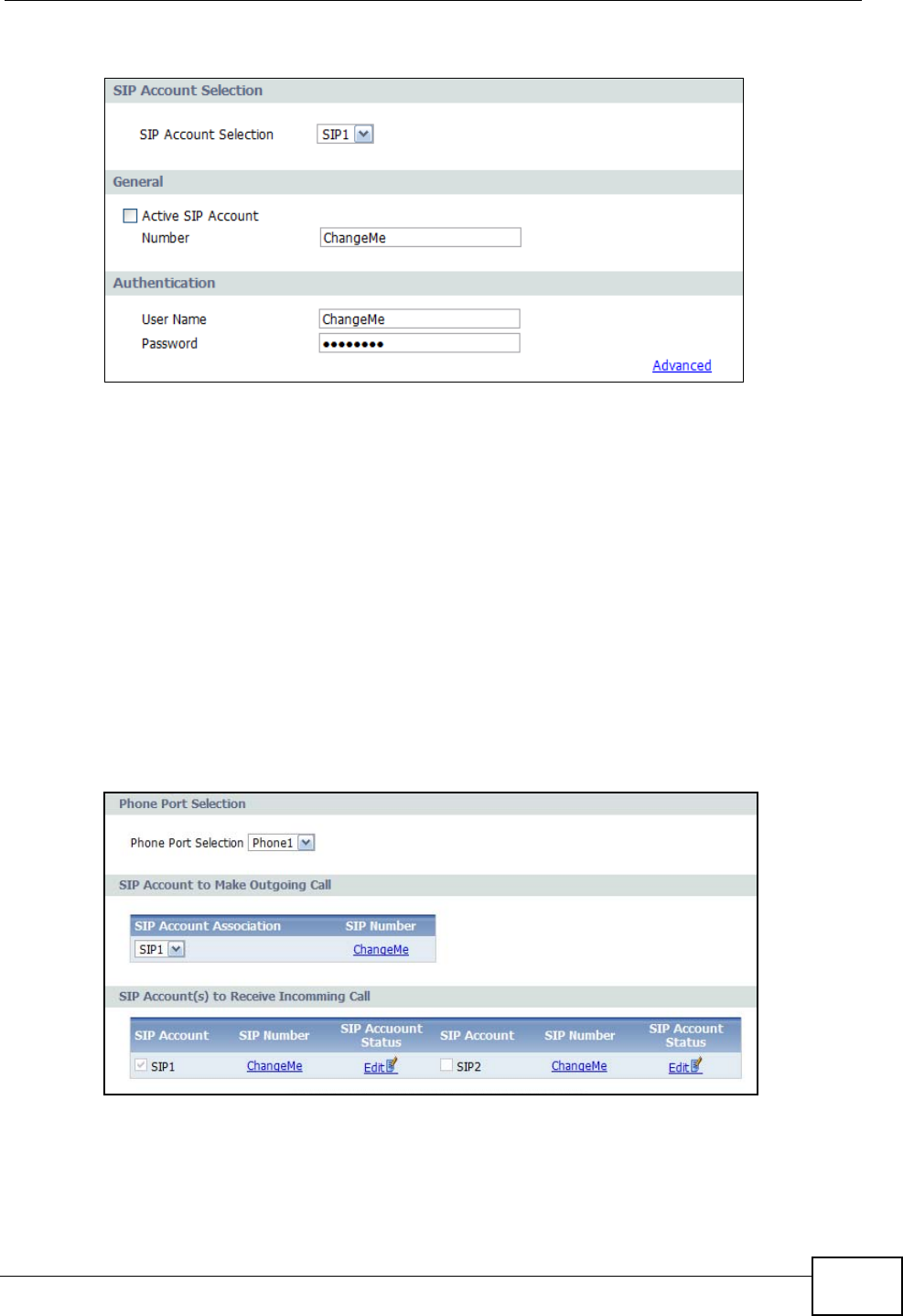
Chapter 3 Tutorials
IAD User’s Guide 37
3Click VoIP > SIP > SIP Account to enter your SIP account information:
SIP Account Selector - The IAD allows you to set up multiple SIP accounts. The
first time you do this, you won’t need to make a selection but in the future if you
set up additional SIP accounts this is where you choose the one to configure.
Active SIP Account - Select this to make the current SIP account active. If you
do not select this option, then you cannot use the settings configured here for the
selected SIP account.
Number - Enter your SIP number. If you were given a SIP number that looked
this – 1234567@sipaccount.com – then your number is the part before the “@”.
User Name -This is your SIP account user name.
Password - This is the password for your SIP account.
4Next, you must configure your Phone settings to bind your newly configured SIP
settings to a single phone. Click VoIP > Phone to display the following screen:

Chapter 3 Tutorials
IAD User’s Guide
38
5Select a phone from the Phone Port Settings list, then select a SIP Account to
use for all outgoing calls. The phone you choose corresponds to one of two phones
physically connected to your IAD.
For Incoming Calls, you can assign multiple SIP accounts to a single phone. This
means any call sent to the selected SIP account is forwarded to the phone chosen
in Phone Port Settings.
Click Apply to save your settings.
6Connect your analog phone to one of two phone ports on the IAD, as described in
the Quick Start Guide. When you pick up the handset and hear a dial tone, enter
the SIP phone number you want to call.

39
PART II
Technical Reference

40

IAD User’s Guide 41
CHAPTER 4
Status Screens
4.1 Overview
Use the Status screens to look at the current status of the device, system
resources, interfaces (LAN and WAN), and SIP accounts. You can also register and
unregister SIP accounts.
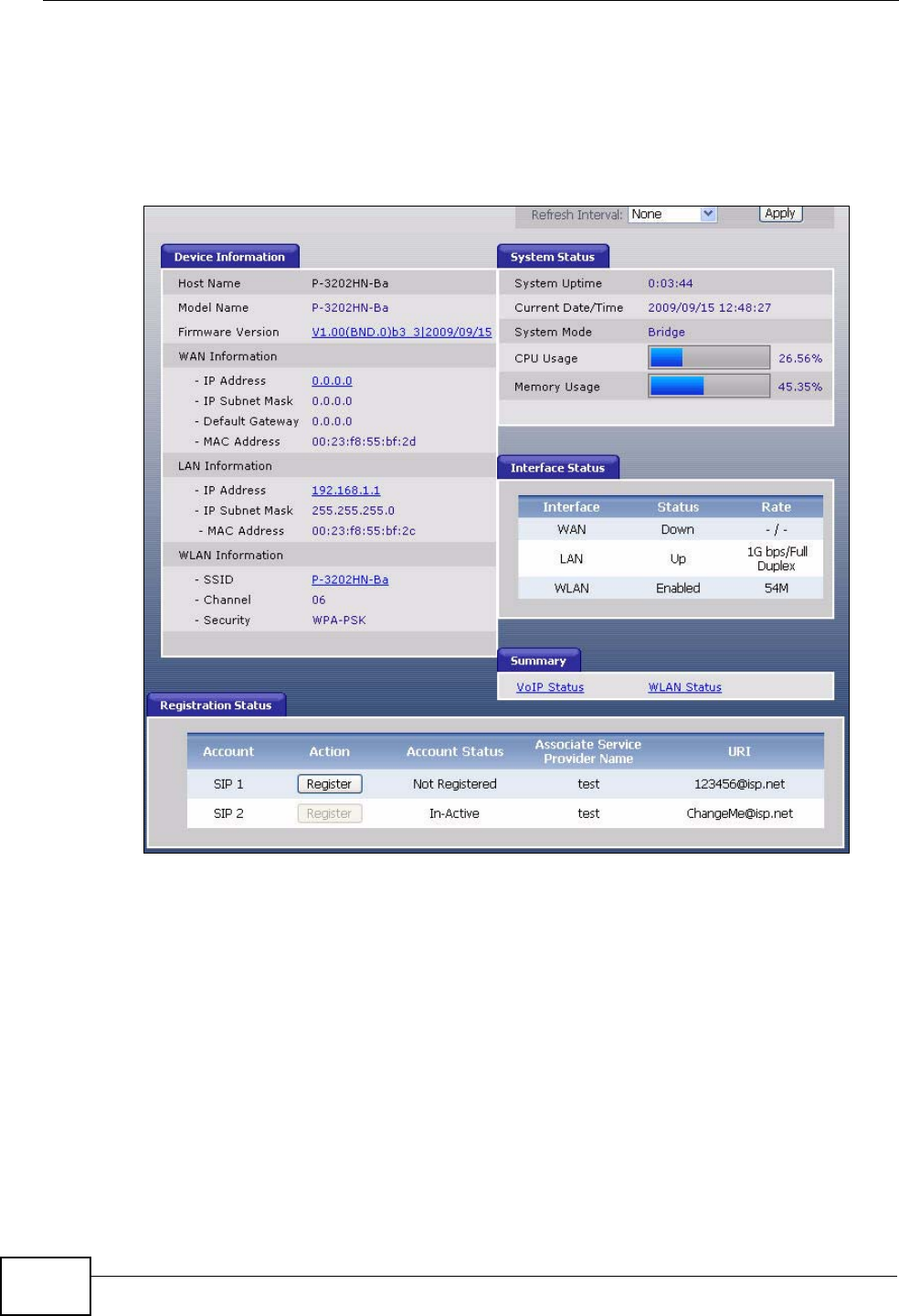
Chapter 4 Status Screens
IAD User’s Guide
42
4.2 Status Screen
Click Status to open this screen. The screen varies slightly depending on the
IAD’s device mode. See Chapter 5 on page 51 for more information.
Figure 9 Status Screen (Bridge Mode)
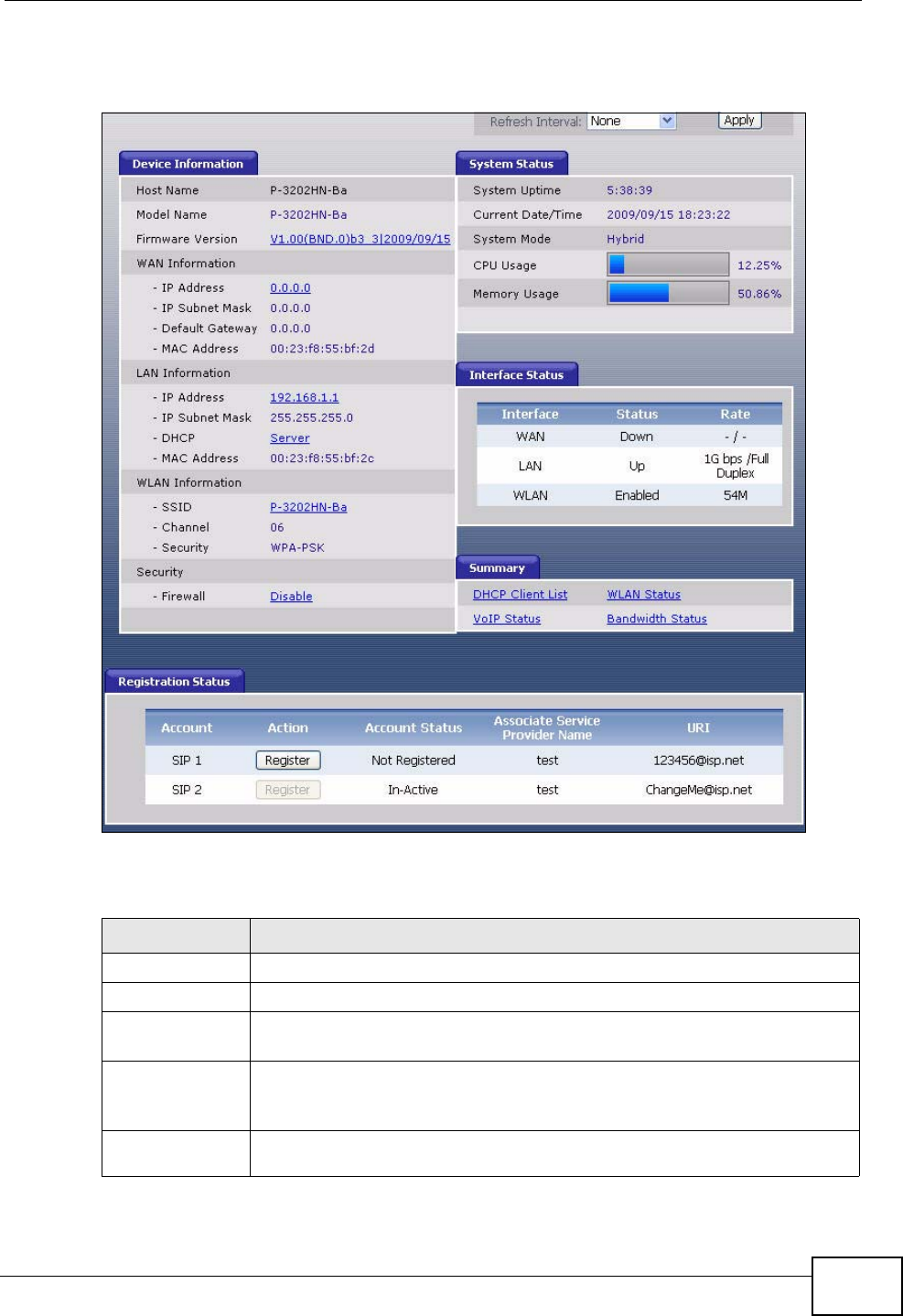
Chapter 4 Status Screens
IAD User’s Guide 43
Figure 10 Status Screen (Hybrid Mode)
Each field is described in the following table.
Table 4 Status Screen
LABEL DESCRIPTION
Refresh Interval Enter how often you want the IAD to update this screen.
Apply Click this to update this screen immediately.
Device
Information
Host Name This field displays the IAD system name. It is used for identification.
You can change this in the Maintenance > System > General
screen’s System Name field.
Model
Number This is the model name of your device.

Chapter 4 Status Screens
IAD User’s Guide
44
Firmware
Version This field displays the current version of the firmware inside the device.
It also shows the date the firmware version was created. Click this to go
to the screen where you can change it.
WAN
Information
IP Address This field displays the current IP address of the IAD in the WAN. Click
this to go to the screen where you can change it.
IP Subnet
Mask This field displays the current subnet mask in the WAN.
Default
Gateway This field displays the IP address of the default gateway, if applicable.
MAC
Address This is the MAC (Media Access Control) or Ethernet address unique to
your IAD. This MAC is used for VoIP connections made over the WAN
and is different from the LAN MAC.
LAN
Information
IP Address This field displays the current IP address of the IAD in the LAN. Click
this to go to the screen where you can change it.
IP Subnet
Mask This field displays the current subnet mask in the LAN.
DHCP This field displays what DHCP services the IAD is providing to the LAN.
Choices are:
Server - The IAD is a DHCP server in the LAN. It assigns IP addresses
to other computers in the LAN.
Relay - The ZyXEL Device acts as a surrogate DHCP server and relays
DHCP requests and responses between the remote server and the
clients.
None - The IAD is not providing any DHCP services to the LAN.
Click this to go to the screen where you can change it.
MAC
Address This is the MAC (Media Access Control) or Ethernet address unique to
your IAD. This MAC is used for LAN connections and differs from the
WAN MAC.
WLAN
Information
SSID This is the descriptive name used to identify the IAD in the wireless
LAN. Click this to go to the screen where you can change it.
Channel This is the channel number used by the IAD now.
Security This displays the type of security mode the IAD is using in the wireless
LAN.
Security
Firewall This displays whether or not the IAD’s firewall is activated. Click this to
go to the screen where you can change it.
System Status
Table 4 Status Screen
LABEL DESCRIPTION

Chapter 4 Status Screens
IAD User’s Guide 45
System
Uptime This field displays how long the IAD has been running since it last
started up. The IAD starts up when you plug it in, when you restart it
(Maintenance > Tools > Restart), or when you reset it (see Section
1.5 on page 25).
Current
Date/Time This field displays the current date and time in the IAD. You can change
this in Maintenance > System > Time Setting.
System
Mode This displays whether the IAD is functioning as a router or a bridge.
CPU Usage This field displays what percentage of the IAD’s processing ability is
currently used. When this percentage is close to 100%, the IAD is
running at full load, and the throughput is not going to improve
anymore. If you want some applications to have more throughput, you
should turn off other applications.
Memory
Usage This field displays what percentage of the IAD’s memory is currently
used. Usually, this percentage should not increase much. If memory
usage does get close to 100%, the IAD is probably becoming unstable,
and you should restart the device. See Section 20.4 on page 222, or
turn it off (unplug the power) for a few seconds.
Interface Status
Interface This column displays each interface the IAD has.
Status This field indicates whether or not the IAD is using the interface.
For the WAN interface, this field displays Up when the IAD is using the
interface and Down when the IAD is not using the interface.
For the LAN interface, this field displays Up when the IAD is using the
interface and Down when the IAD is not using the interface.
For the WLAN interface, it displays Enabled when WLAN is activated or
Disabled when WLAN is not active.
Rate For the LAN interface, this displays the port speed and duplex setting.
For the WAN interface, this displays the port speed and duplex setting.
For the WLAN interface, it displays the maximum transmission rate
when WLAN is enabled or N/A when WLAN is disabled.
Summary
DHCP Client
List Click this link to view current DHCP client information. See Section 7.5
on page 65.
VoIP Status Click this link to view statistics about your VoIP usage. See Section
4.2.1 on page 47.
WLAN
Status Click this link to display the MAC address(es) of the wireless stations
that are currently associating with the IAD. See Section 4.2.2 on page
49.
Bandwidth
Status Click this link to view QoS packets statistics on the IAD. See Section
4.2.2 on page 49.
Registration
Status
Account This column displays each SIP account in the IAD.
Table 4 Status Screen
LABEL DESCRIPTION

Chapter 4 Status Screens
IAD User’s Guide
46
Registration This field displays the current registration status of the SIP account. You
have to register SIP accounts with a SIP server to use VoIP.
If the SIP account is already registered with the SIP server,
•Click Unregister to delete the SIP account’s registration in the SIP
server. This does not cancel your SIP account, but it deletes the
mapping between your SIP identity and your IP address.
•The second field displays Registered.
If the SIP account is not registered with the SIP server,
•Click Register to have the IAD attempt to register the SIP account
with the SIP server.
•The second field displays the reason the account is not registered.
Inactive - The SIP account is not active. You can activate it in VoIP >
SIP > SIP Settings.
Register Fail - The last time the IAD tried to register the SIP account
with the SIP server, the attempt failed. The IAD automatically tries to
register the SIP account when you turn on the IAD or when you activate
it.
Action If the SIP account is already registered with the SIP server, the
Account Status field displays Registered.
• Click Unregister to delete the SIP account’s registration in the SIP
server. This does not cancel your SIP account, but it deletes the
mapping between your SIP identity and your IP address or domain
name.
If the SIP account is not registered with the SIP server, the Account
Status field displays Not Registered.
• Click Register to have the IAD attempt to register the SIP account
with the SIP server.
•The second field displays the reason the account is not registered.
The button is grayed out if the SIP account is disabled.
Account Status This field displays the current registration status of the SIP account. You
have to register SIP accounts with a SIP server to use VoIP.
In-Active - The SIP account is not active. You can activate it in VoIP >
SIP > SIP Account.
Not Registered - The last time the IAD tried to register the SIP
account with the SIP server, the attempt failed. Use the Register
button to register the account again. The IAD automatically tries to
register the SIP account when you turn on the IAD or when you activate
it.
Registered - The SIP account is already registered with the SIP
server. You can use it to make a VoIP call.
Register Fail - The last time the IAD tried to register the SIP account
with the SIP server, the attempt failed. The IAD automatically tries to
register the SIP account when you turn on the IAD or when you activate
it.
Table 4 Status Screen
LABEL DESCRIPTION
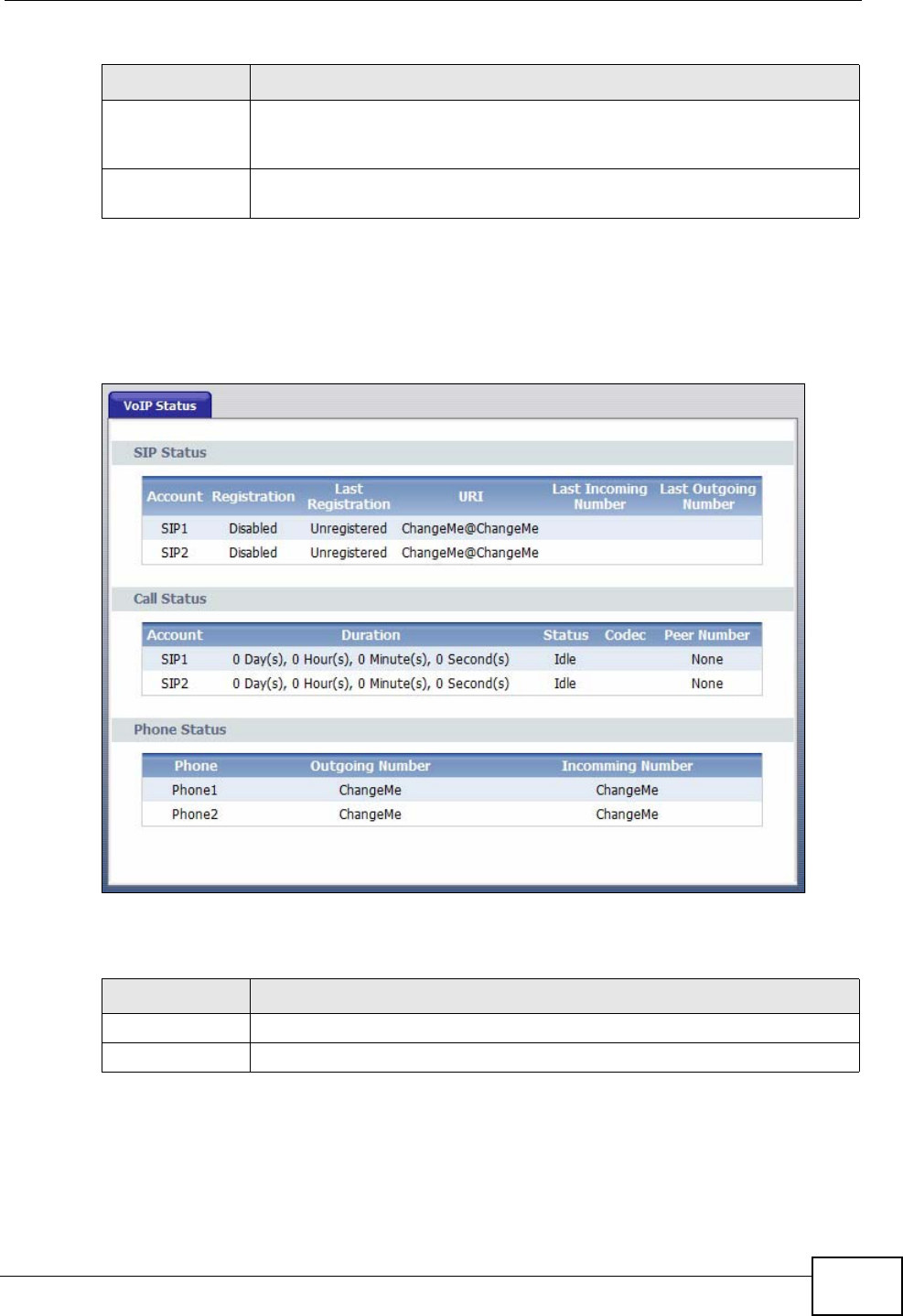
Chapter 4 Status Screens
IAD User’s Guide 47
4.2.1 VoIP Status
Click Status > VoIP Status to access this screen.
Figure 11 VoIP Status
Each field is described in the following table.
Associate
Service
Provider Name
This field displays the VoIP service provider’s name that you specified in
the VoIP > SIP > SIP Service Provider screen.
URI This field displays the account number and service domain of the SIP
account. You can change these in the VoIP > SIP screens.
Table 4 Status Screen
LABEL DESCRIPTION
Table 5 VoIP Status
LABEL DESCRIPTION
SIP Status
Account This column displays each SIP account in the IAD.
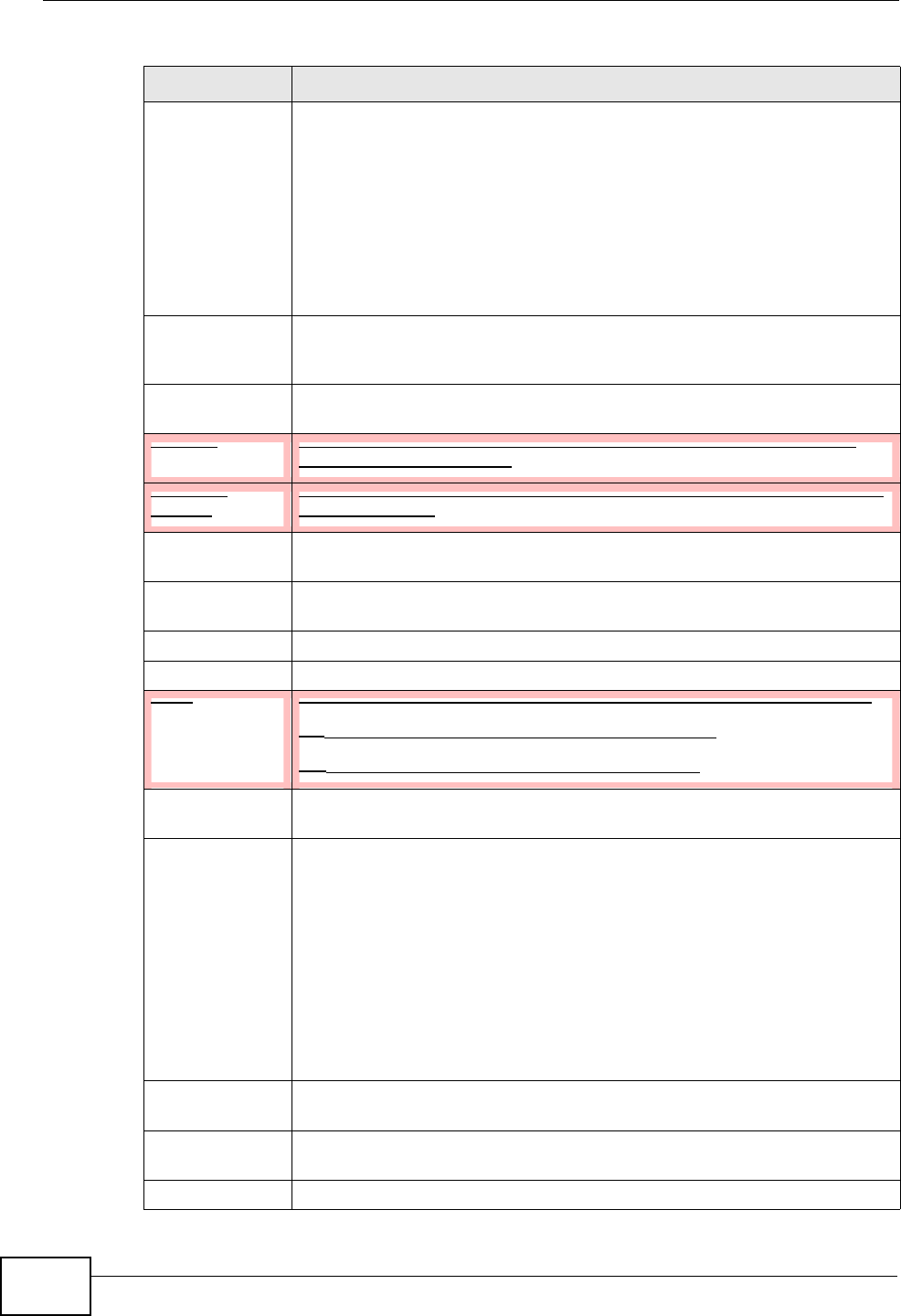
Chapter 4 Status Screens
IAD User’s Guide
48
Registration This field displays the current registration status of the SIP account. You
can change this in the Status screen.
Registered - The SIP account is registered with a SIP server.
Error - The last time the IAD tried to register the SIP account with the
SIP server, the attempt failed. The IAD automatically tries to register
the SIP account when you turn on the IAD or when you activate it.
Diabled - The SIP account is not active. You can activate it in VoIP >
SIP > SIP Account.
Last
Registration This field displays the last time you successfully registered the SIP
account. It displays Unregistered if you never successfully registered
this account.
URI This field displays the account number and service domain of the SIP
account. You can change these in the VoIP > SIP screens.
Protocol This field displays the transport protocol the SIP account uses. SIP
accounts always use UDP.
Message
Waiting This field indicates whether or not there are any messages waiting for
the SIP account.
Last Incoming
Number This field displays the last number that called the SIP account. The field
is blank if no number has ever dialed the SIP account.
Last Outgoing
Number This field displays the last number the SIP account called. The field is
blank if the SIP account has never dialed a number.
Call Status
Account This column displays each SIP account in the IAD.
Hook This field indicates whether the phone is on the hook or off the hook.
On - The phone is hanging up or already hung up.
Off - The phone is dialing, calling, or connected.
Duration This field displays how long the current call has lasted. It displays 0 if
no call has ever been made using the SIP account.
Status This field displays the current state of the phone call.
Idle - There are no current VoIP calls, incoming calls or outgoing calls
being made.
Dial - The callee’s phone is ringing.
Ring - The phone is ringing for an incoming VoIP call.
Process - There is a VoIP call in progress.
DISC - The callee’s line is busy, the callee hung up or your phone was
left off the hook.
Codec This field displays what voice codec is being used for a current VoIP call
through a phone port.
Peer Number This field displays the SIP number of the party that is currently engaged
in a VoIP call through a phone port.
Phone Status
Table 5 VoIP Status
LABEL DESCRIPTION
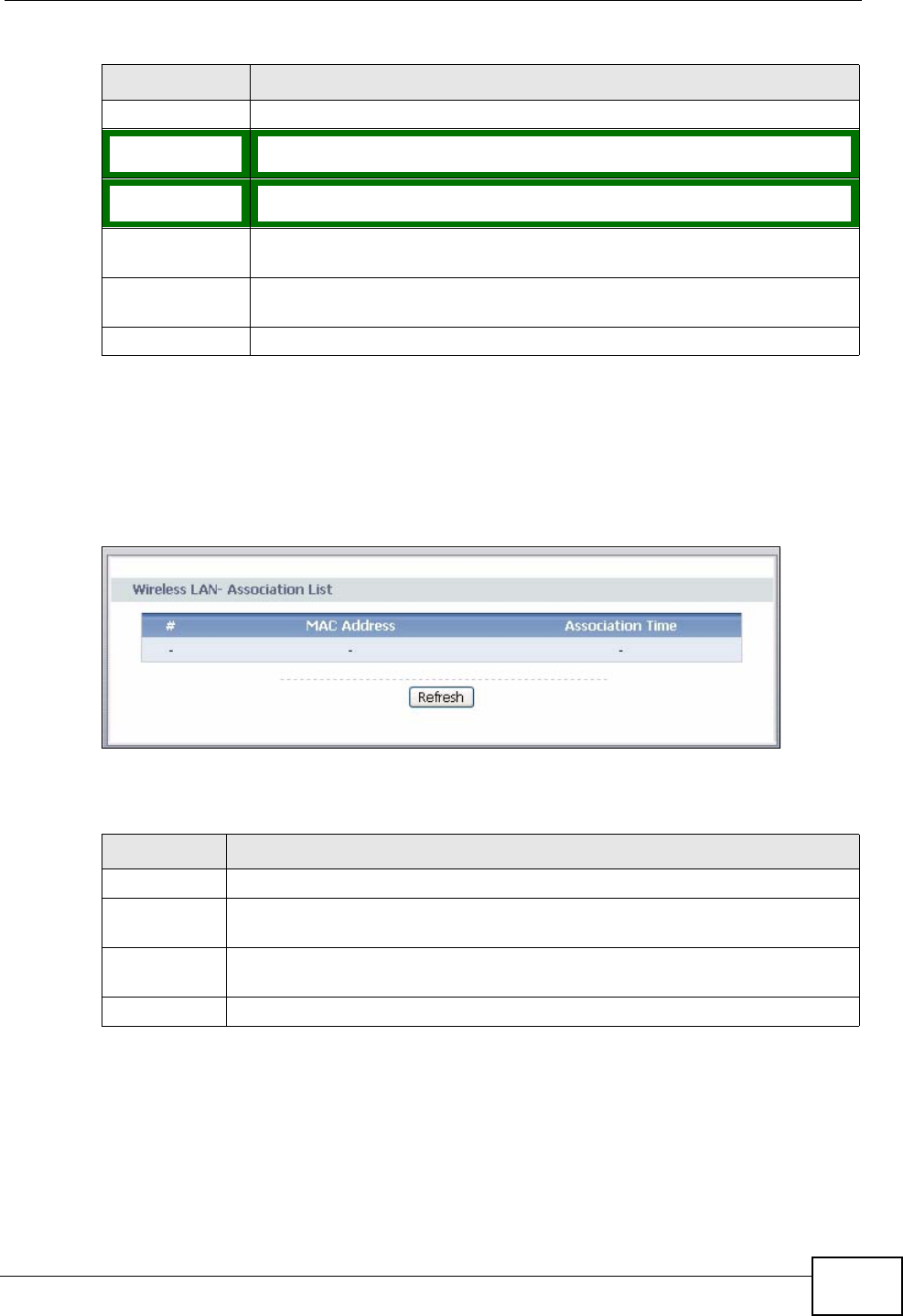
Chapter 4 Status Screens
IAD User’s Guide 49
4.2.2 WLAN Status
Click Status > WLAN Status to access this screen. Use this screen to view the
wireless stations that are currently associated to the IAD.
Figure 12 Status > WLAN Status
The following table describes the labels in this screen.
Phone This field displays each phone port in the IAD.
Outgoing
Number This field displays the SIP number that you use to make calls on this
phone port.
Incomming
Number This field displays the SIP number that you use to receive calls on this
phone port.
Poll Interval(s) Enter how often you want the IAD to update this screen, and click Set
Interval.
Set Interval Click this to make the IAD update the screen based on the amount of
time you specified in Poll Interval.
Stop Click this to make the IAD stop updating the screen.
Table 5 VoIP Status
LABEL DESCRIPTION
Table 6 Status > WLAN Status
LABEL DESCRIPTION
# This is the index number of an associated wireless station.
MAC Address This field displays the MAC (Media Access Control) address of an
associated wireless station.
Association
TIme This field displays the time a wireless station first associated with the IAD.
Refresh Click Refresh to reload this screen.

Chapter 4 Status Screens
IAD User’s Guide
50
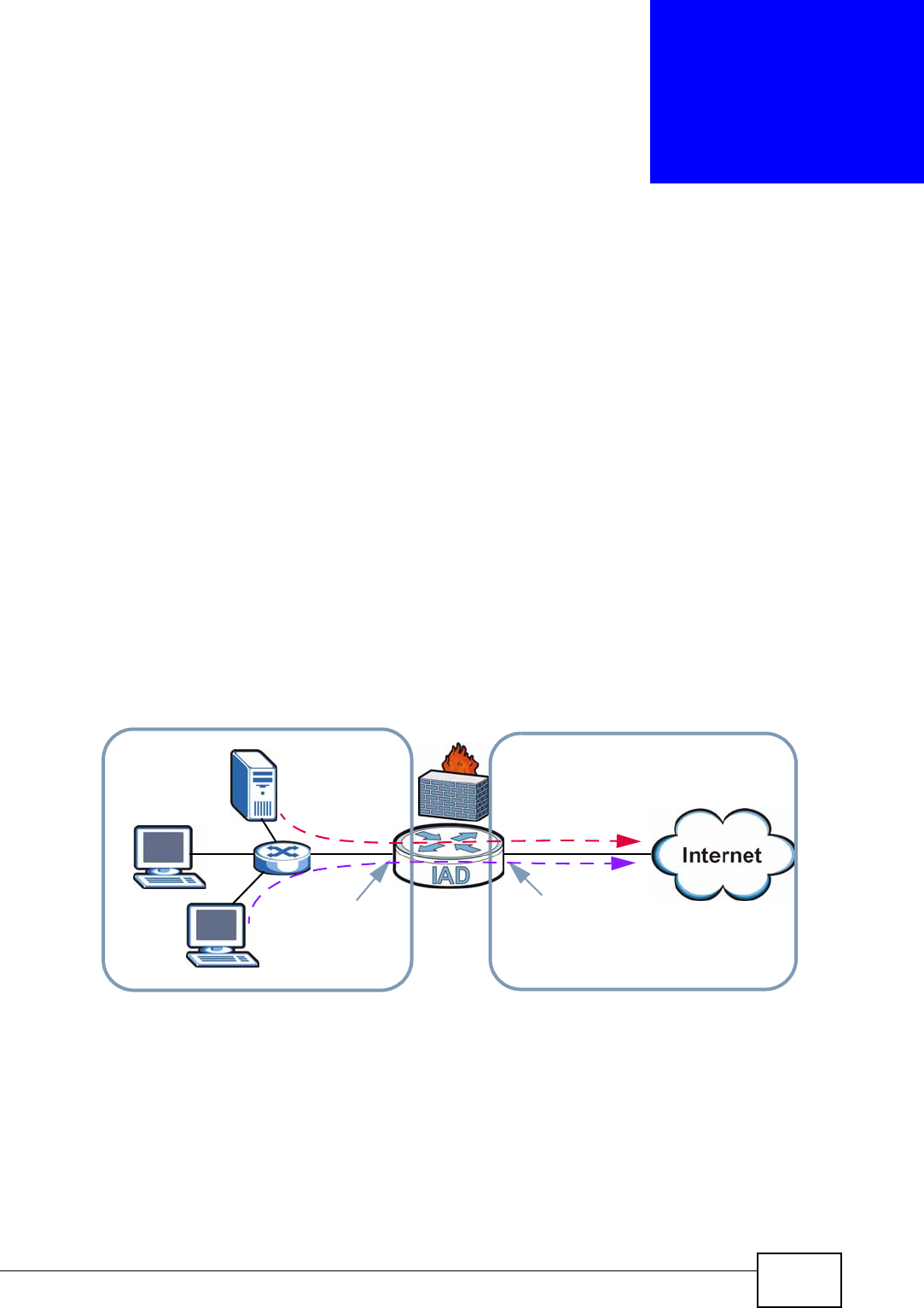
IAD User’s Guide 51
CHAPTER 5
Device Mode Screen
5.1 Overview
The Status screen lets you configure whether the IAD is a router or bridge. You
can choose between Hybride Mode and Bridge Mode depending on your
network topology and the features you require from your IAD. See Section 1.4 on
page 22 for more information on which mode to choose.
5.1.1 Hybrid Mode (Router Mode)
A router connects your local network with another network, such as the Internet.
The router has two IP addresses, the LAN IP address and the WAN IP address. The
router can use NAT to translate the packet’s source IP address before forwarding it
from the LAN to the WAN or from the LAN to the WAN.
Figure 13 LAN and WAN IP Addresses in Hybrid Mode (Router Mode)
5.1.2 Bridge Mode
When the IAD acts as a bridge, the routing features will not be available. That
means a bridge can not use NAT to translate the packet’s source IP address before
forwarding it. You need to set the client computer to receive an IP address
automatically from the ISP. Computers behind the IAD cannot share the same
Internet account. To configure the IAD, you need to manually set the computer’s
192.168.1.33
192.168.1.35
192.168.1.34
WAN
LAN
WAN IP Address
192.168.1.1
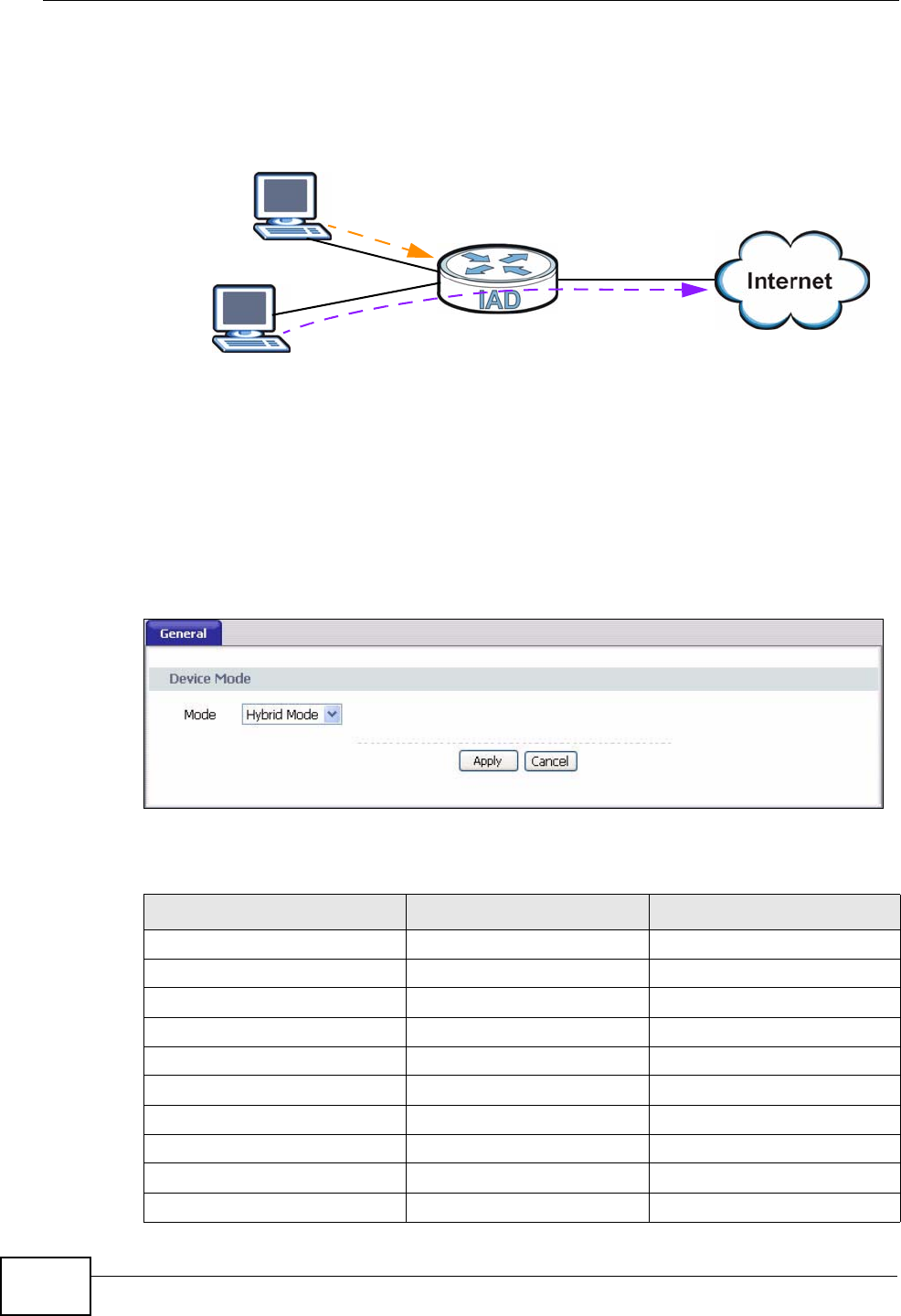
Chapter 5 Device Mode Screen
IAD User’s Guide
52
IP address to be in the same subnet as the IAD since the DHCP server is also
disabled on the IAD in bridge mode.
Figure 14 IP Addresses in Bridge Mode
5.2 Device Mode Screen
Click Device > Device Mode to open this screen. The IAD restarts automatically
after you select a different device mode and click Apply.
Figure 15 Device Mode Screen
The following table lists the features available for each device mode.
WAN
LAN
192.168.1.1
192.168.1.x
IP Address Assigned by ISP
Table 7 Hybrid and Bridge Modes Features Comparison
FEATURE HYBRID MODE BRIDGE MODE
DHCP Client List Y
WLAN Status Y Y
Bandwidth Status Y
Device Mode Y Y
WAN Y Y
LAN Y Y
Wireless LAN Y Y
NAT Y
SIP Y Y
Phone Y Y

Chapter 5 Device Mode Screen
IAD User’s Guide 53
Table Key: A Y in a mode’s column shows that the device mode has the specified
feature. The information in this table was correct at the time of writing, although it
may be subject to change.
Phone Book Y Y
VoIP Status Y Y
Firewall Y
Static Route Y
Bandwidth MGMT Y
Dynamic DNS Y
Remote MGMT Y Y
System Y Y
Logs Y Y
Tools Y Y
Diagnostic Y Y
Table 7 Hybrid and Bridge Modes Features Comparison
FEATURE HYBRID MODE BRIDGE MODE

Chapter 5 Device Mode Screen
IAD User’s Guide
54

IAD User’s Guide 55
CHAPTER 6
WAN
6.1 Overview
This chapter describes how to configure WAN settings. A WAN (Wide Area
Network) is an outside connection to another network or the Internet.
6.1.1 What You Need to Know
The following terms and concepts may help as you read through the chapter.
Encapsulation
Be sure to use the encapsulation method required by your ISP. The IAD supports
the following methods.
PPP over Ethernet
The IAD supports PPPoE (Point-to-Point Protocol over Ethernet). PPPoE is an IETF
Draft standard (RFC 2516) specifying how a personal computer (PC) interacts with
a broadband modem (DSL, cable, wireless, etc.) connection. The PPPoE option is
for a dial-up connection using PPPoE.
For the service provider, PPPoE offers an access and authentication method that
works with existing access control systems (for example RADIUS).
One of the benefits of PPPoE is the ability to let you access one of multiple network
services, a function known as dynamic service selection. This enables the service
provider to easily create and offer new IP services for individuals.
Operationally, PPPoE saves significant effort for both you and the ISP or carrier, as
it requires no specific configuration of the broadband modem at the customer site.
By implementing PPPoE directly on the IAD (rather than individual computers), the
computers on the LAN do not need PPPoE software installed, since the IAD does
that part of the task.
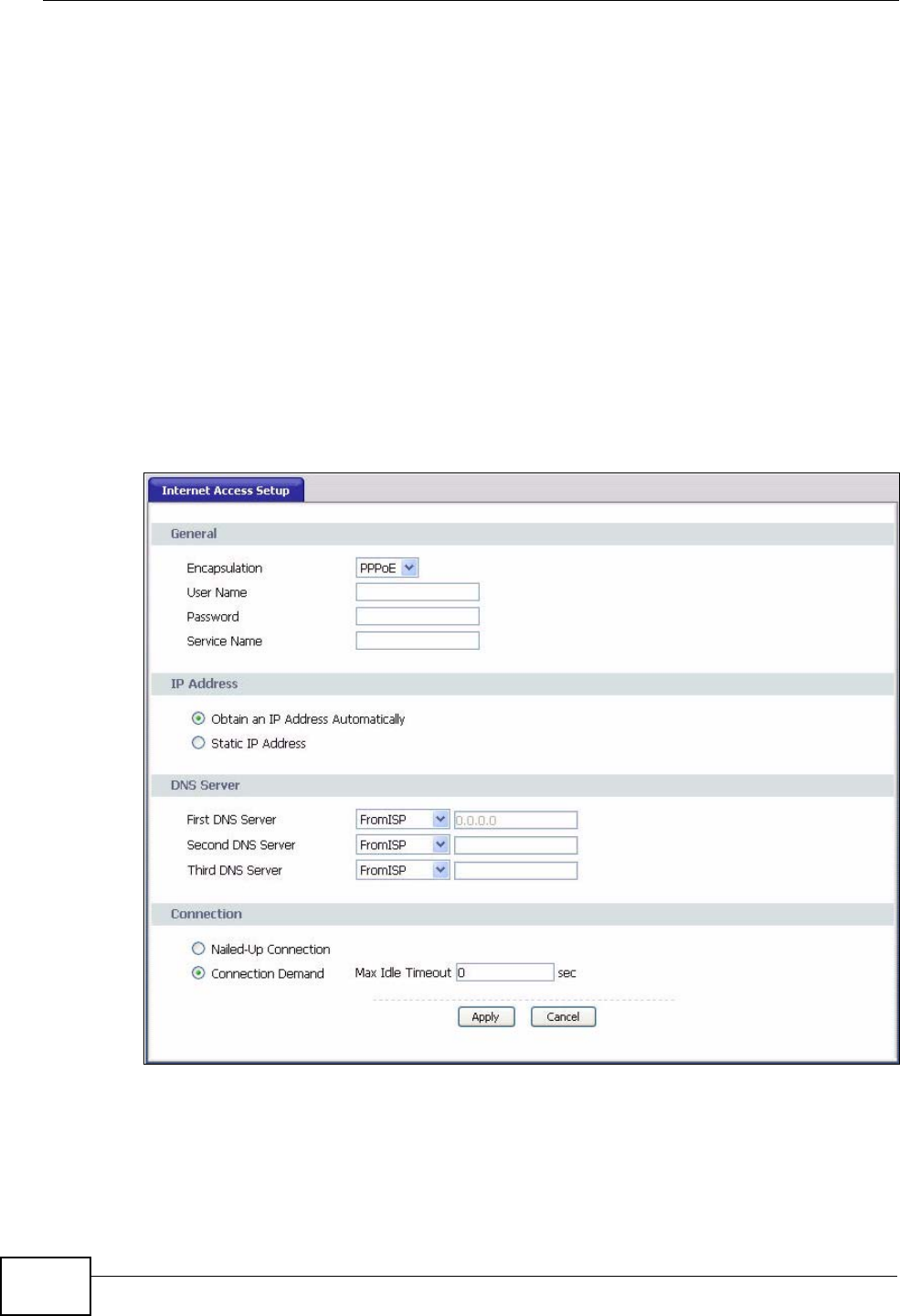
Chapter 6 WAN
IAD User’s Guide
56
IP Address Assignment
A static IP is a fixed IP that your ISP gives you. A dynamic IP is not fixed; the ISP
assigns you a different one each time. The Single User Account feature can be
enabled or disabled if you have either a dynamic or static IP. However the
encapsulation method assigned influences your choices for IP address and ENET
ENCAP gateway.
6.2 Internet Access Setup
Use this screen to change your IAD’s WAN remote node settings. Click Network >
WAN > Internet Access Setup. Although the screen differs by the
encapsulation you select, all options are presented in the image below.
Figure 16 Internet Access Setup - PPPoE
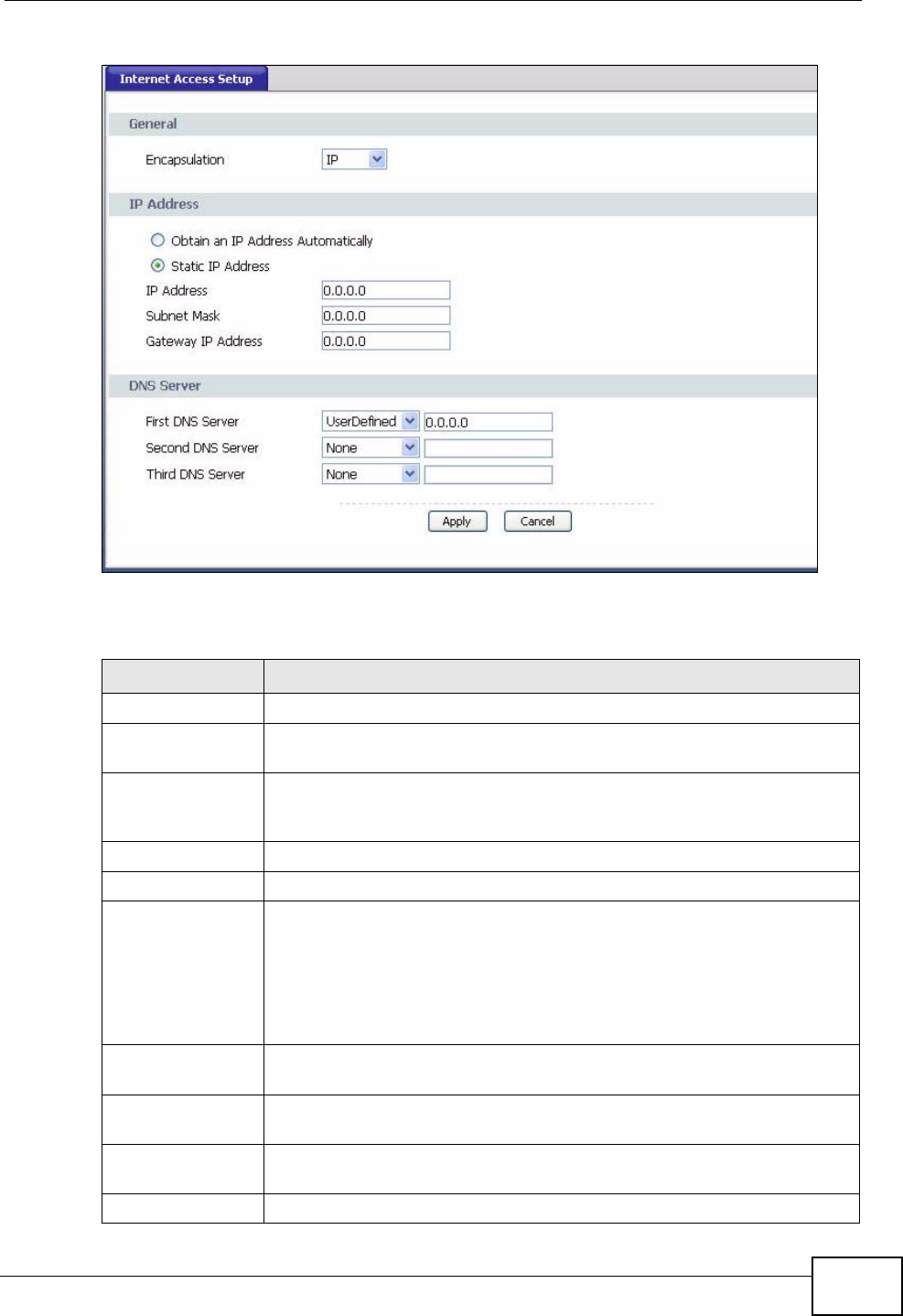
Chapter 6 WAN
IAD User’s Guide 57
Figure 17 Internet Access Setup - IP
The following table describes the labels in this screen.
Table 8 Internet Access Setup
LABEL DESCRIPTION
General
Encapsulation Select the method of encapsulation used by your ISP from the drop-
down list box
User Name Enter the user name exactly as your ISP assigned. If assigned a name
in the form user@domain where domain identifies a service name,
then enter both components exactly as given.
Password Enter the password associated with the user name above.
Service Name Type the name of your PPPoE service here.
IP Address A static IP address is a fixed IP that your ISP gives you. A dynamic IP
address is not fixed; the ISP assigns you a different one each time you
connect to the Internet.
Select Obtain an IP Address Automatically if you have a dynamic
IP address; otherwise select Static IP Address and type your ISP
assigned information in the field below.
IP Address Enter the IP address assigned by your ISP if you select Static IP
Address.
Subnet Mask Enter a subnet mask in dotted decimal notation when you select IP in
the Encapsulation field.
Gateway IP
address You must specify a gateway IP address (supplied by your ISP) when
you select IP in the Encapsulation field.
DNS Server

Chapter 6 WAN
IAD User’s Guide
58
First DNS Server
Second DNS
Server
Third DNS Server
Select FromISP if your ISP dynamically assigns DNS server
information (and the IAD's WAN IP address) and you select Obtain
an IP Address Automatically.
Select UserDefined if you have the IP address of a DNS server. Enter
the DNS server's IP address in the field to the right. If you chose
UserDefined, but leave the IP address set to 0.0.0.0, UserDefined
changes to None after you click Apply. If you set a second choice to
UserDefined, and enter the same IP address, the second
UserDefined changes to None after you click Apply.
Select None if you do not want to configure DNS servers. You must
have another DNS server on your LAN, or else the computers must
have their DNS server addresses manually configured. If you do not
configure a DNS server, you must know the IP address of a computer
in order to access it.
Connection
Nailed-Up
Connection Select Nailed-Up Connection when you want your connection up all
the time. The IAD will try to bring up the connection automatically if it
is disconnected.
Connection
Demand Select Connection Demand when you don't want the connection up
all the time and specify an idle time-out in the Max Idle Timeout
field.
Max Idle Timeout Specify an idle time-out in the Max Idle Timeout field when you
select Connection Demand. The default setting is 0, which means
the Internet session will not timeout.
Apply Click Apply to save the changes.
Cancel Click Cancel to begin configuring this screen afresh.
Table 8 Internet Access Setup (continued)
LABEL DESCRIPTION
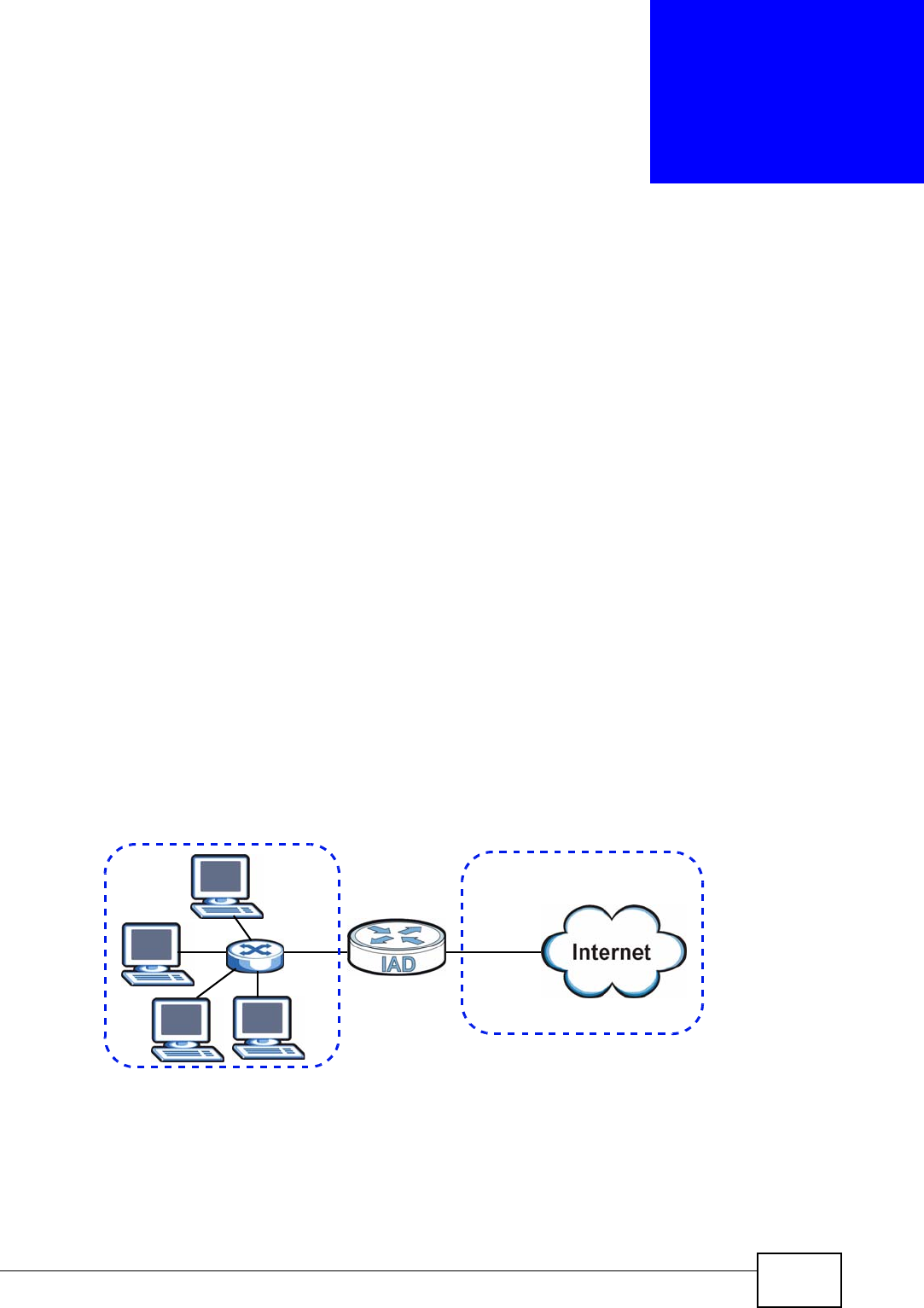
IAD User’s Guide 59
CHAPTER 7
LAN Setup
This chapter describes how to configure LAN settings.
7.1 LAN Overview
A Local Area Network (LAN) is a shared communication system to which many
computers are attached. A LAN is a computer network limited to the immediate
area, usually the same building or floor of a building. The LAN screens can help
you configure a LAN DHCP server and manage IP addresses.
See Section 7.4 on page 63 to configure the LAN screens.
7.1.1 LANs, WANs and the ZyXEL Device
The actual physical connection determines whether the IAD ports are LAN or WAN
ports. There are two separate IP networks, one inside the LAN network and the
other outside the WAN network as shown next.
Figure 18 LAN and WAN IP Addresses
7.1.2 DHCP Setup
DHCP (Dynamic Host Configuration Protocol, RFC 2131 and RFC 2132) allows
individual clients to obtain TCP/IP configuration at start-up from a server. You can
WAN
LAN

Chapter 7 LAN Setup
IAD User’s Guide
60
configure the IAD as a DHCP server or disable it. When configured as a server, the
IAD provides the TCP/IP configuration for the clients. If you turn DHCP service off,
you must have another DHCP server on your LAN, or else the computer must be
manually configured.
7.1.2.1 IP Pool Setup
The IAD is pre-configured with a pool of IP addresses for the DHCP clients (DHCP
Pool). See the product specifications in the appendices. Do not assign static IP
addresses from the DHCP pool to your LAN computers.
7.2 DNS Server Addresses
DNS (Domain Name System) maps a domain name to its corresponding IP
address and vice versa. The DNS server is extremely important because without
it, you must know the IP address of a computer before you can access it. The DNS
server addresses you enter when you set up DHCP are passed to the client
machines along with the assigned IP address and subnet mask.
There are two ways that an ISP disseminates the DNS server addresses.
• The ISP tells you the DNS server addresses, usually in the form of an
information sheet, when you sign up. If your ISP gives you DNS server
addresses, enter them in the DNS Server fields in the DHCP Setup screen.
• Some ISPs choose to disseminate the DNS server addresses using the DNS
server extensions of IPCP (IP Control Protocol) after the connection is up. If
your ISP did not give you explicit DNS servers, chances are the DNS servers are
conveyed through IPCP negotiation. The IAD supports the IPCP DNS server
extensions through the DNS proxy feature.
If the DNS Server fields in the DHCP Setup screen are set to DNS Relay, the
IAD tells the DHCP clients that it itself is the DNS server. When a computer
sends a DNS query to the IAD, the IAD acts as a DNS proxy and forwards the
query to the real DNS server learned through IPCP and relays the response back
to the computer.
Please note that DNS proxy works only when the ISP uses the IPCP DNS server
extensions. It does not mean you can leave the DNS servers out of the DHCP
setup under all circumstances. If your ISP gives you explicit DNS servers, make
sure that you enter their IP addresses in the DHCP Setup screen.
7.3 LAN TCP/IP
The IAD has built-in DHCP server capability that assigns IP addresses and DNS
servers to systems that support DHCP client capability.

Chapter 7 LAN Setup
IAD User’s Guide 61
7.3.1 IP Address and Subnet Mask
Similar to the way houses on a street share a common street name, so too do
computers on a LAN share one common network number.
Where you obtain your network number depends on your particular situation. If
the ISP or your network administrator assigns you a block of registered IP
addresses, follow their instructions in selecting the IP addresses and the subnet
mask.
If the ISP did not explicitly give you an IP network number, then most likely you
have a single user account and the ISP will assign you a dynamic IP address when
the connection is established. If this is the case, it is recommended that you select
a network number from 192.168.0.0 to 192.168.255.0 and you must enable the
Network Address Translation (NAT) feature of the IAD. The Internet Assigned
Number Authority (IANA) reserved this block of addresses specifically for private
use; please do not use any other number unless you are told otherwise. Let's say
you select 192.168.1.0 as the network number; which covers 254 individual
addresses, from 192.168.1.1 to 192.168.1.254 (zero and 255 are reserved). In
other words, the first three numbers specify the network number while the last
number identifies an individual computer on that network.
Once you have decided on the network number, pick an IP address that is easy to
remember, for instance, 10.0.0.138, for your IAD, but make sure that no other
device on your network is using that IP address.
The subnet mask specifies the network number portion of an IP address. Your IAD
will compute the subnet mask automatically based on the IP address that you
entered. You don't need to change the subnet mask computed by the IAD unless
you are instructed to do otherwise.
7.3.1.1 Private IP Addresses
Every machine on the Internet must have a unique address. If your networks are
isolated from the Internet, for example, only between your two branch offices, you
can assign any IP addresses to the hosts without problems. However, the Internet
Assigned Numbers Authority (IANA) has reserved the following three blocks of IP
addresses specifically for private networks:
• 10.0.0.0 — 10.255.255.255
• 172.16.0.0 — 172.31.255.255
• 192.168.0.0 — 192.168.255.255
You can obtain your IP address from the IANA, from an ISP or it can be assigned
from a private network. If you belong to a small organization and your Internet
access is through an ISP, the ISP can provide you with the Internet addresses for

Chapter 7 LAN Setup
IAD User’s Guide
62
your local networks. On the other hand, if you are part of a much larger
organization, you should consult your network administrator for the appropriate IP
addresses.
Note: Regardless of your particular situation, do not create an arbitrary IP address;
always follow the guidelines above. For more information on address
assignment, please refer to RFC 1597, “Address Allocation for Private
Internets” and RFC 1466, “Guidelines for Management of IP Address Space”.
7.3.2 RIP Setup
RIP (Routing Information Protocol) allows a router to exchange routing
information with other routers. The RIP Direction field controls the sending and
receiving of RIP packets. When set to:
•Both - the IAD will broadcast its routing table periodically and incorporate the
RIP information that it receives.
•In Only - the IAD will not send any RIP packets but will accept all RIP packets
received.
•Out Only - the IAD will send out RIP packets but will not accept any RIP
packets received.
•None - the IAD will not send any RIP packets and will ignore any RIP packets
received.
The Version field controls the format and the broadcasting method of the RIP
packets that the IAD sends (it recognizes both formats when receiving). RIP-1 is
universally supported; but RIP-2 carries more information. RIP-1 is probably
adequate for most networks, unless you have an unusual network topology.
Both RIP-2B and RIP-2M sends the routing data in RIP-2 format; the difference
being that RIP-2B uses subnet broadcasting while RIP-2M uses multicasting.
7.3.3 Multicast
Traditionally, IP packets are transmitted in one of either two ways - Unicast (1
sender - 1 recipient) or Broadcast (1 sender - everybody on the network).
Multicast delivers IP packets to a group of hosts on the network - not everybody
and not just 1.
IGMP (Internet Group Multicast Protocol) is a network-layer protocol used to
establish membership in a Multicast group - it is not used to carry user data. IGMP
version 2 (RFC 2236) is an improvement over version 1 (RFC 1112) but IGMP
version 1 is still in wide use. If you would like to read more detailed information
about interoperability between IGMP version 2 and version 1, please see sections
4 and 5 of RFC 2236. The class D IP address is used to identify host groups and
can be in the range 224.0.0.0 to 239.255.255.255. The address 224.0.0.0 is not
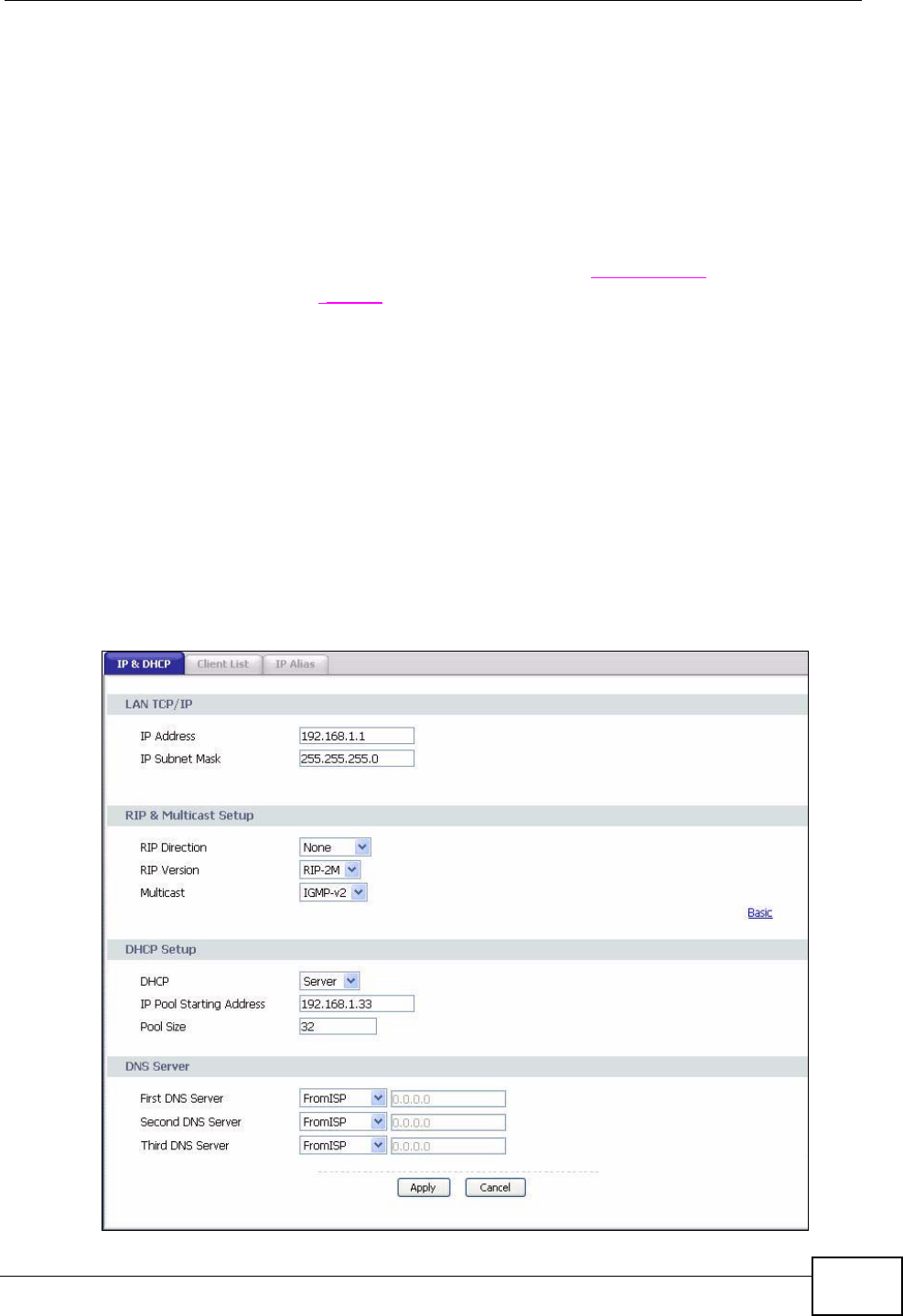
Chapter 7 LAN Setup
IAD User’s Guide 63
assigned to any group and is used by IP multicast computers. The address
224.0.0.1 is used for query messages and is assigned to the permanent group of
all IP hosts (including gateways). All hosts must join the 224.0.0.1 group in order
to participate in IGMP. The address 224.0.0.2 is assigned to the multicast routers
group.
The IAD supports both IGMP version 1 (IGMP-v1) and IGMP version 2 (IGMP-
v2). At start up, the IAD queries all directly connected networks to gather group
membership. After that, the IAD periodically updates this information. IP
multicasting can be enabled/disabled on the IAD LAN and/or WAN interfaces in the
Web Configurator (LAN; WAN). Select None to disable IP multicasting on these
interfaces.
7.4 Configuring LAN IP and DHCP
Click Network > LAN to open the IP & DHCP screen. See Section 7.1 on page
59 for background information. Use this screen to set the Local Area Network IP
address and subnet mask of your IAD. You can also edit your IAD's RIP and
multicast settings, and DNS server information that the IAD sends to the DHCP
client devices on the LAN.
Figure 19 LAN IP & DHCP

Chapter 7 LAN Setup
IAD User’s Guide
64
The following table describes the fields in this screen.
Table 9 LAN IP & DHCP
LABEL DESCRIPTION
LAN TCP/IP
IP Address Enter the LAN IP address you want to assign to your IAD in dotted
decimal notation, for example, 10.0.0.138 (factory default).
IP Subnet Mask Type the subnet mask of your network in dotted decimal notation, for
example 255.255.255.0 (factory default). Your IAD automatically
computes the subnet mask based on the IP Address you enter, so do
not change this field unless you are instructed to do so.
Advanced/Basic Click Advanced to display and edit RIP and multicast settings.
Otherwise, click Basic to hide them.
RIP & Multicast
Setup
RIP Direction Select the RIP direction from None, Both, In Only and Out Only.
RIP Version Select the RIP version from RIP-1, RIP-2B and RIP-2M.
Multicast IGMP (Internet Group Multicast Protocol) is a network-layer protocol
used to establish membership in a multicast group. The IAD supports
both IGMP version 1 (IGMP-v1) and IGMP-v2. Select None to
disable it.
DHCP Setup
DHCP If set to Server, your IAD can assign IP addresses, an IP default
gateway and DNS servers to Windows 95, Windows NT and other
systems that support the DHCP client.
If set to None, the DHCP server will be disabled.
If set to Relay, the IAD acts as a surrogate DHCP server and relays
DHCP requests and responses between the remote server and the
clients. Enter the IP address of the actual, remote DHCP server in the
Remote DHCP Server field in this case.
When DHCP is used, the following items need to be set:
IP Pool Starting
Address This field specifies the first of the contiguous addresses in the IP
address pool.
Pool Size This field specifies the size, or count of the IP address pool.
Remote DHCP
Server If Relay is selected in the DHCP field above then enter the IP address
of the actual remote DHCP server here.
DNS Server This section displays only when you select Server in the DHCP field.
The IAD passes a DNS (Domain Name System) server IP address to
the DHCP clients.
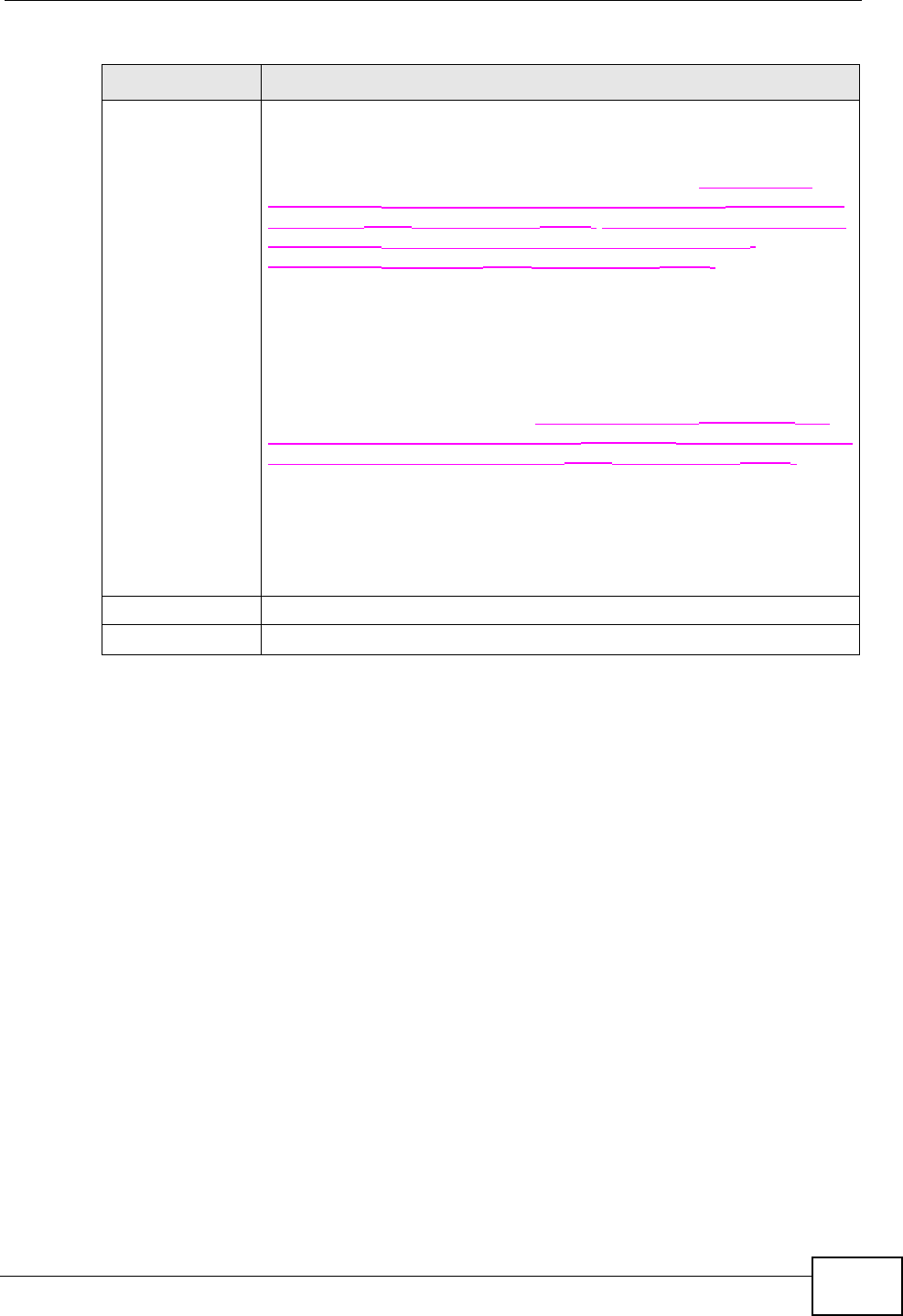
Chapter 7 LAN Setup
IAD User’s Guide 65
7.5 LAN Client List
DHCP (Dynamic Host Configuration Protocol, RFC 2131 and RFC 2132) allows
individual clients to obtain TCP/IP configuration at start-up from a server. You can
configure the IAD as a DHCP server or disable it. When configured as a server, the
IAD provides the TCP/IP configuration for the clients. If DHCP service is disabled,
you must have another DHCP server on your LAN, or else the computer must be
manually configured.
Click Network > LAN > Client List to open the following screen. The read-only
table shows current DHCP client information of all network clients using the IAD’s
First DNS Server
Second DNS
Server
Third DNS Server
Select FromISP if your ISP dynamically assigns DNS server
information (and the IAD's WAN IP address).
Select UserDefined if you have the IP address of a DNS server. Enter
the DNS server's IP address in the field to the right. If you chose
UserDefined, but leave the IP address set to 0.0.0.0, UserDefined
changes to None after you click Apply. If you set a second choice to
UserDefined, and enter the same IP address, the second
UserDefined changes to None after you click Apply.
Select DNS Relay to have the IAD act as a DNS proxy only when the
ISP uses IPCP DNS server extensions. The IAD's LAN IP address
displays in the field to the right (read-only). The IAD tells the DHCP
clients on the LAN that the IAD itself is the DNS server. When a
computer on the LAN sends a DNS query to the IAD, the IAD forwards
the query to the real DNS server learned through IPCP and relays the
response back to the computer. You can only select DNS Relay for
one of the three servers; if you select DNS Relay for a second or third
DNS server, that choice changes to None after you click Apply.
Select None if you do not want to configure DNS servers. You must
have another DHCP sever on your LAN, or else the computers must
have their DNS server addresses manually configured. If you do not
configure a DNS server, you must know the IP address of a computer
in order to access it.
Apply Click Apply to save your changes back to the IAD.
Cancel Click Cancel to begin configuring this screen afresh.
Table 9 LAN IP & DHCP (continued)
LABEL DESCRIPTION
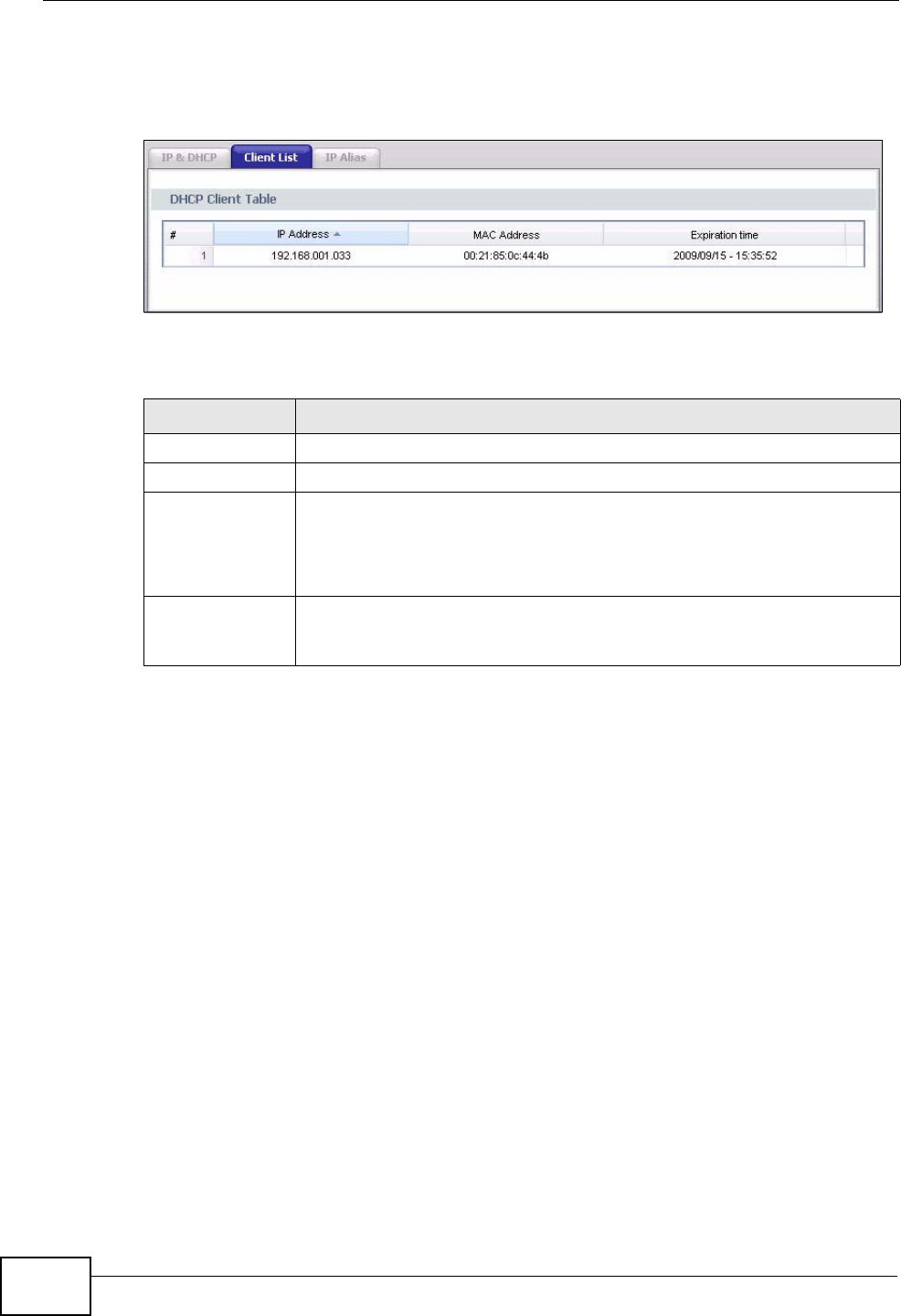
Chapter 7 LAN Setup
IAD User’s Guide
66
DHCP server. Use this screen to view IP addresses on the LAN assigned to specific
individual computers based on their MAC Addresses.
Figure 20 LAN Client List
The following table describes the labels in this screen.
7.6 LAN IP Alias
IP alias allows you to partition a physical network into different logical networks
over the same Ethernet interface. The IAD supports three logical LAN interfaces
via its single physical Ethernet interface with the IAD itself as the gateway for
each LAN network.
When you use IP alias, you can also configure firewall rules to control access
between the LAN's logical networks (subnets).
Note: Make sure that the subnets of the logical networks do not overlap.
Table 10 LAN Client List
LABEL DESCRIPTION
# This is the index number of the IP table entry (row).
IP Address This field displays the IP address assigned to the client computer.
MAC Address Every Ethernet device has a unique MAC (Media Access Control)
address. The MAC address is assigned at the factory and consists of six
pairs of hexadecimal characters, for example, 00:A0:C5:00:00:02.
This field displays the MAC address of the client computer.
Expiration Time This field displays the date and time the IP address expires. The client
computer then cannot use this IP address and needs to request
information from the DHCP server again.
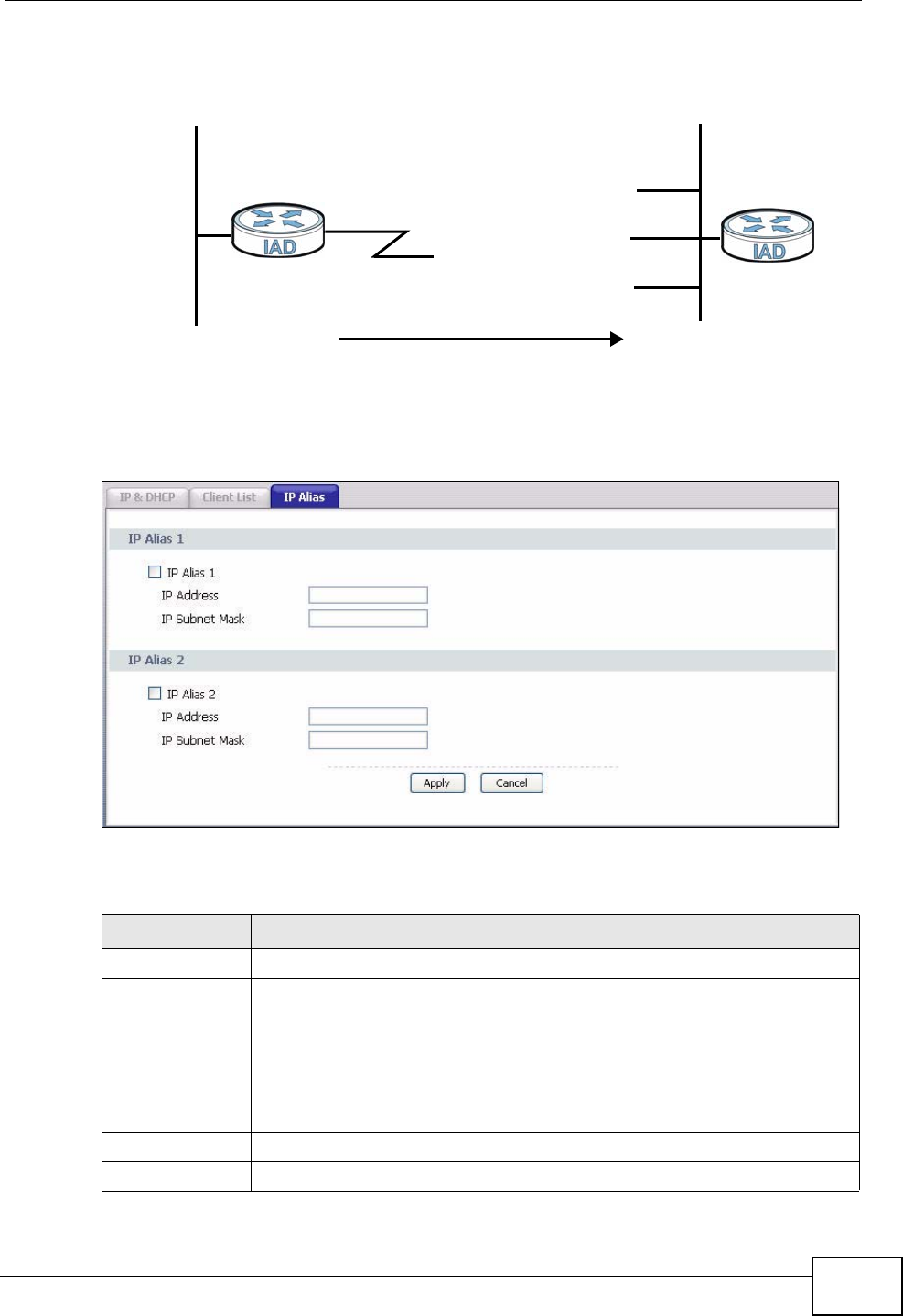
Chapter 7 LAN Setup
IAD User’s Guide 67
The following figure shows a LAN divided into subnets A, B, and C.
Figure 21 Physical Network & Partitioned Logical Networks
Click Network > LAN > IP Alias to open the following screen. Use this screen to
change your IAD’s IP alias settings.
Figure 22 LAN IP Alias
The following table describes the labels in this screen.
Table 11 LAN IP Alias
LABEL DESCRIPTION
IP Alias 1, 2 Select the check box to configure another LAN network for the IAD.
IP Address Enter the IP address of your IAD in dotted decimal notation.
Alternatively, click the right mouse button to copy and/or paste the IP
address.
IP Subnet Mask Your IAD will automatically calculate the subnet mask based on the IP
address that you assign. Unless you are implementing subnetting, use
the subnet mask computed by the IAD.
Apply Click Apply to save your changes back to the IAD.
Cancel Click Cancel to begin configuring this screen afresh.
Ethernet
Interface
A: 192.168.1.1 - 192.168.1.24
B: 192.168.2.1 - 192.168.2.24
C: 192.168.3.1 - 192.168.3.24

Chapter 7 LAN Setup
IAD User’s Guide
68

IAD User’s Guide 69
CHAPTER 8
Wireless LAN
8.1 Overview
This chapter describes how to perform tasks related to setting up and optimizing
your wireless network, including the following.
• Turning the wireless connection on or off.
• Configuring a name, wireless channel and security for the network.
• Using WiFi Protected Setup (WPS) to configure your wireless network.
• Using a MAC (Media Access Control) address filter to restrict access to the
wireless network.
See Chapter 3 on page 35 for a tutorial showing how to set up your wireless
connection in an example scenario.
See Section 8.10 on page 89 for advanced technical information on wireless
networks.
8.1.1 What You Can Do in this Chapter
This chapter describes the IAD’s Network > Wireless LAN screens. Use these
screens to set up your IAD’s wireless connection.
•The General screen lets you turn the wireless connection on or off, set up
wireless security and make other basic configuration changes (Section 8.4 on
page 73). You can also configure the MAC filter to allow or block access to the
IAD based on the MAC addresses of the wireless stations.
•The More AP screen lets you set up multiple wireless networks on your IAD
(Section 8.5 on page 82).
•Use the WPS screen and the WPS Station screen to use WiFi Protected Setup
(WPS). WPS lets you set up a secure network quickly, when connecting to other
WPS-enabled devices.
Use the WPS screen (see Section 8.6 on page 83) to enable or disable WPS,
generate a security PIN (Personal Identification Number) and see information
about the IAD’s WPS status.
Use the WPS Station (see Section 8.7 on page 85) screen to set up WPS by
pressing a button or using a PIN.

Chapter 8 Wireless LAN
IAD User’s Guide
70
•The WDS screen lets you set up a Wireless Distribution System, in which the
IAD acts as a bridge with other ZyXEL access points (Section 8.8 on page 86).
•The Advanced Setup screen lets you change the wireless mode, and make
other advanced wireless configuration changes (Section 8.9 on page 88).
You don’t necessarily need to use all these screens to set up your wireless
connection. For example, you may just want to set up a network name, a wireless
radio channel and some security in the General screen.
8.2 What You Need to Know
Wireless Basics
“Wireless” is essentially radio communication. In the same way that walkie-talkie
radios send and receive information over the airwaves, wireless networking
devices exchange information with one another. A wireless networking device is
just like a radio that lets your computer exchange information with radios
attached to other computers. Like walkie-talkies, most wireless networking
devices operate at radio frequency bands that are open to the public and do not
require a license to use. However, wireless networking is different from that of
most traditional radio communications in that there a number of wireless
networking standards available with different methods of data encryption.
Wireless Network Construction
Wireless networks consist of wireless clients, access points and bridges.
• A wireless client is a radio connected to a user’s computer.
• An access point is a radio with a wired connection to a network, which can
connect with numerous wireless clients and let them access the network.
• A bridge is a radio that relays communications between access points and
wireless clients, extending a network’s range.
Traditionally, a wireless network operates in one of two ways.
• An “infrastructure” type of network has one or more access points and one or
more wireless clients. The wireless clients connect to the access points.
• An “ad-hoc” type of network is one in which there is no access point. Wireless
clients connect to one another in order to exchange information.
Network Names
Each network must have a name, referred to as the SSID - “Service Set
IDentifier”. The “service set” is the network, so the “service set identifier” is the
network’s name. This helps you identify your wireless network when wireless

Chapter 8 Wireless LAN
IAD User’s Guide 71
networks’ coverage areas overlap and you have a variety of networks to choose
from.
Radio Channels
In the radio spectrum, there are certain frequency bands allocated for unlicensed,
civilian use. For the purposes of wireless networking, these bands are divided into
numerous channels. This allows a variety of networks to exist in the same place
without interfering with one another. When you create a network, you must select
a channel to use.
Since the available unlicensed spectrum varies from one country to another, the
number of available channels also varies.
Wireless Security
By their nature, radio communications are simple to intercept. For wireless data
networks, this means that anyone within range of a wireless network without
security can not only read the data passing over the airwaves, but also join the
network. Once an unauthorized person has access to the network she/he can
either steal information or introduce malware (malicious software) intended to
compromise the network. For these reasons, a variety of security systems have
been developed to ensure that only authorized people can use a wireless data
network, or understand the data carried on it.
These security standards do two things. First, they authenticate. This means that
only people presenting the right credentials (often a username and password, or a
“key” phrase) can access the network. Second, they encrypt. This means that the
information sent over the air is encoded. Only people with the code key can
understand the information, and only people who have been authenticated are
given the code key.
These security standards vary in effectiveness. Some can be broken, such as the
old Wired Equivalent Protocol (WEP). Using WEP is better than using no security at
all, but it will not keep a determined attacker out. Other security standards are
secure in themselves but can be broken if a user does not use them properly. For
example, the WPA-PSK security standard is perfectly secure if you use a long key
which is difficult for an attacker’s software to guess - for example, a twenty-letter
long string of apparently random numbers and letters - but it is not very secure if
you use a short key which is very easy to guess.
Because of the damage that can be done by a malicious attacker, it’s not just
people who have sensitive information on their network who should use security.
Everybody who uses any wireless network should ensure that effective security is
in place.

Chapter 8 Wireless LAN
IAD User’s Guide
72
A good way to come up with effective security keys, passwords and so on is to use
obscure information that you personally will easily remember, and to enter it in a
way that appears random and does not include real words. For example, if your
mother owns a 1970 Dodge Challenger and her favorite movie is Vanishing Point
(which you know was made in 1971) you could use “70dodchal71vanpoi” as your
security key.
Signal Problems
Because wireless networks are radio networks, their signals are subject to
limitations of distance, interference and absorption.
Problems with distance occur when the two radios are too far apart. Problems with
interference occur when other radio waves interrupt the data signal. Interference
may come from other radio transmissions, such as military or air traffic control
communications, or from machines that are coincidental emitters such as electric
motors or microwaves. Problems with absorption occur when physical objects
(such as thick walls) are between the two radios, muffling the signal.
8.3 Before You Begin
Before you start using these screens, ask yourself the following questions. See
Section 8.2 on page 70 if some of the terms used here do not make sense to you.
• What wireless standards do the other wireless devices support (IEEE 802.11g,
for example)? What is the most appropriate standard to use?
• What security options do the other wireless devices support (WPA-PSK, for
example)? What is the best one to use?
• Do the other wireless devices support WPS (Wi-Fi Protected Setup)? If so, you
can set up a well-secured network very easily.
Even if some of your devices support WPS and some do not, you can use WPS to
set up your network and then add the non-WPS devices manually, although this
is somewhat more complicated to do.
• What advanced options do you want to configure, if any? If you want to
configure advanced options, ensure that you know precisely what you want to
do. If you do not want to configure advanced options, leave them alone.
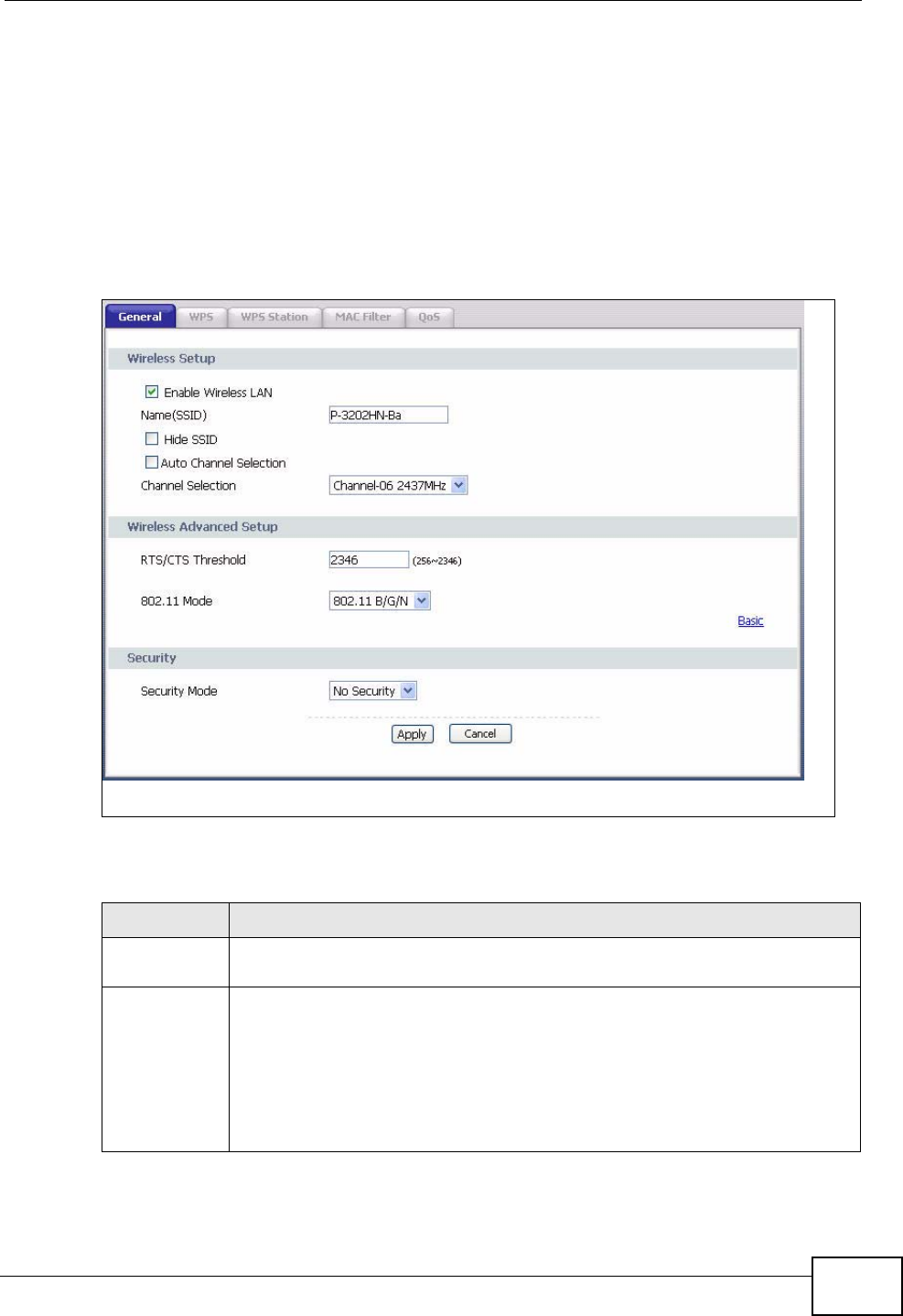
Chapter 8 Wireless LAN
IAD User’s Guide 73
8.4 The General Screen
Note: If you are configuring the IAD from a computer connected to the wireless LAN
and you change the IAD’s SSID or security settings, you will lose your wireless
connection when you press Apply to confirm. You must then change the
wireless settings of your computer to match the IAD’s new settings.
Click Network > Wireless LAN to open the General screen.
Figure 23 Network > Wireless LAN > General
The following table describes the labels in this screen.
Table 12 Network > Wireless LAN > General
LABEL DESCRIPTION
Active
Wireless LAN Click the check box to activate wireless LAN.
Channel
Selection Set the operating frequency/channel depending on your particular region.
Select a channel or use Auto to have the IAD automatically determine a
channel to use. If you are having problems with wireless interference,
changing the channel may help. Try to use a channel that is as many
channels away from any channels used by neighboring APs as possible.
The channel number which the IAD is currently using then displays next to
this field.

Chapter 8 Wireless LAN
IAD User’s Guide
74
Bandwidth Select whether the IAD uses a wireless channel width of 20MHz or
40MHz.
A standard 20MHz channel offers transfer speeds of up to 150Mbps
whereas a 40MHz channel uses two standard channels and offers speeds
of up to 300 Mbps.
40MHz (channel bonding or dual channel) bonds two adjacent radio
channels to increase throughput. The wireless clients must also support 40
MHz. It is often better to use the 20 MHz setting in a location where the
environment hinders the wireless signal.
Select 20MHz if you want to lessen radio interference with other wireless
devices in your neighborhood or the wireless clients do not support
channel bonding.
This field is available only when you set the 802.11 Mode to 802.11n
Only or 802.11b/g/n Mixed in the Advanced Setup screen.
Control
Sideband This is available for some regions when you select a specific channel and
set the Bandwidth field to 40MHz. Set whether the control channel (set
in the Channel field) should be in the Lower or Upper range of channel
bands.
This field is available only when you set the 802.11 Mode to 802.11n
Only or 802.11b/g/n Mixed in the Advanced Setup screen.
Network
Name (SSID) The SSID (Service Set IDentity) identifies the service set with which a
wireless device is associated. Wireless devices associating to the access
point (AP) must have the same SSID. Enter a descriptive name (up to 32
printable 7-bit ASCII characters) for the wireless LAN.
Note: If you are configuring the IAD from a computer connected to the
wireless LAN and you change the IAD’s SSID or wireless
security settings, you will lose your wireless connection when
you press Apply to confirm. You must then change the wireless
settings of your computer to match the IAD’s new settings.
Hide Network
Name (SSID) Select this check box to hide the SSID in the outgoing beacon frame so a
station cannot obtain the SSID through scanning using a site survey tool.
Enable
Wireless
Multicast
Forwarding
(WMF)
Select this check box to allow the IAD to convert wireless multicast traffic
into wireless unicast traffic.
BSSID This shows the MAC address of the wireless interface on the IAD when
wireless LAN is enabled.
Security
Mode See the following sections for more details about this field.
MAC Filter Click this button to go to the MAC Filter screen to configure whether the
wireless devices with the MAC addresses listed are allowed or denied to
access the IAD using this SSID.
Apply Click this to save your changes back to the IAD.
Reset Click this to reload the previous configuration for this screen.
Table 12 Network > Wireless LAN > General
LABEL DESCRIPTION
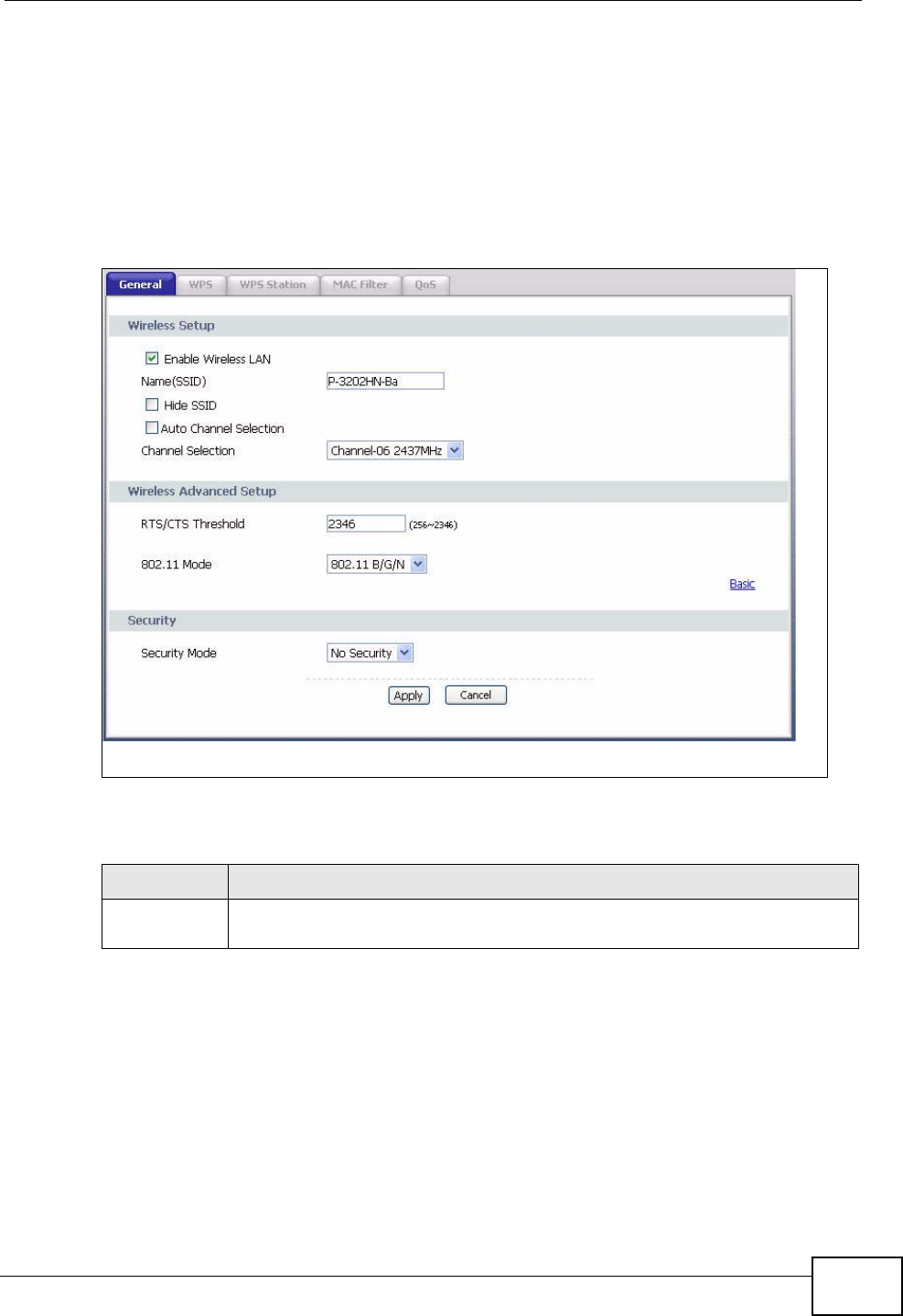
Chapter 8 Wireless LAN
IAD User’s Guide 75
8.4.1 No Security
Select No Security to allow wireless devices to communicate with the access
points without any data encryption or authentication.
Note: If you do not enable any wireless security on your IAD, your network is
accessible to any wireless networking device that is within range.
Figure 24 Wireless LAN > General: No Security
The following table describes the labels in this screen.
Table 13 Wireless LAN > General: No Security
LABEL DESCRIPTION
Security
Mode Choose No Security from the drop-down list box.
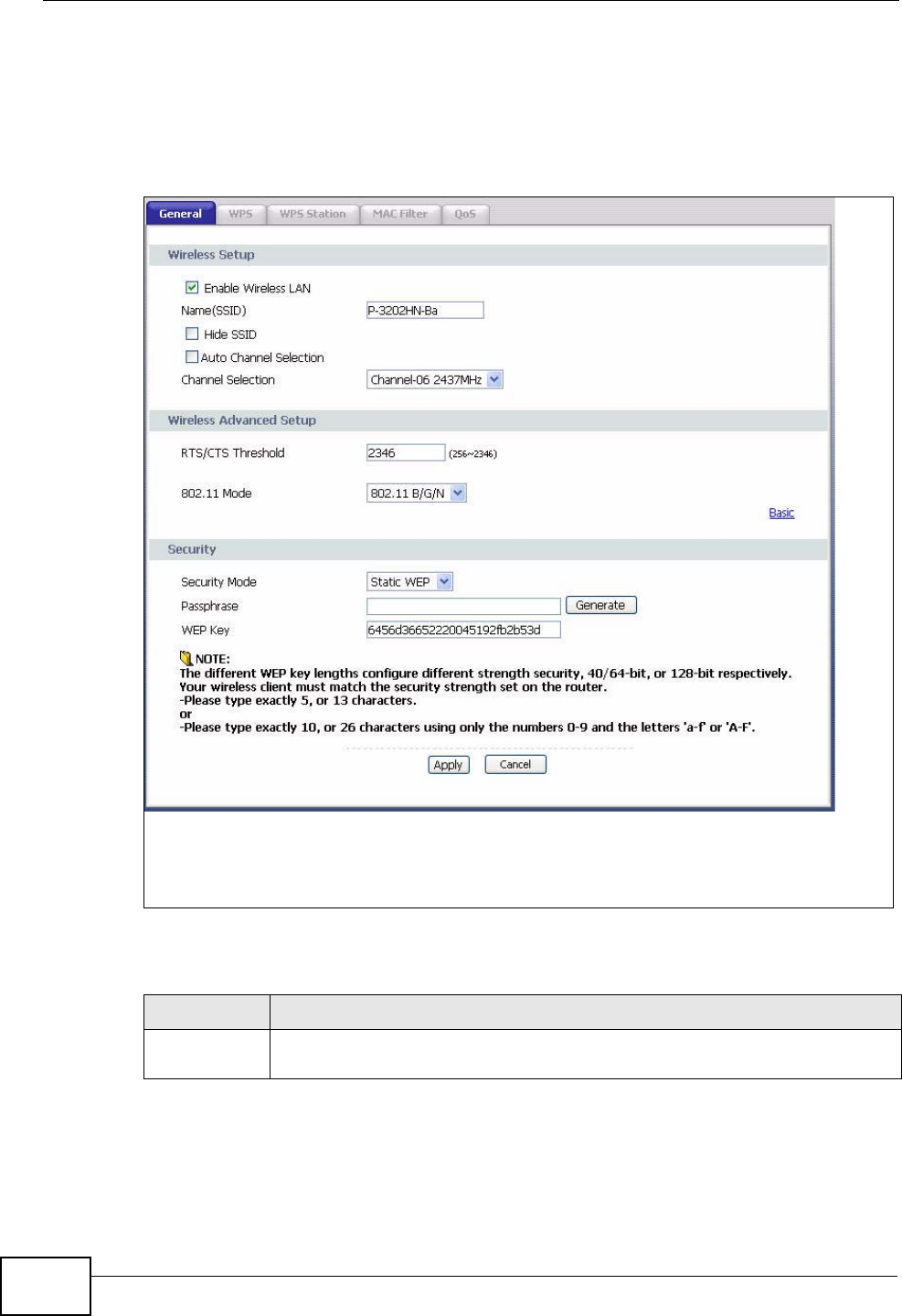
Chapter 8 Wireless LAN
IAD User’s Guide
76
8.4.2 WEP Encryption
In order to configure and enable WEP encryption; click Network > Wireless LAN
to display the General screen. Select WEP from the Security Mode list.
Figure 25 Wireless LAN > General: Static WEP Encryption
The following table describes the wireless LAN security labels in this screen.
Table 14 Network > Wireless LAN > General: Static WEP Encryption
LABEL DESCRIPTION
Security
Mode Choose WEP from the drop-down list box.
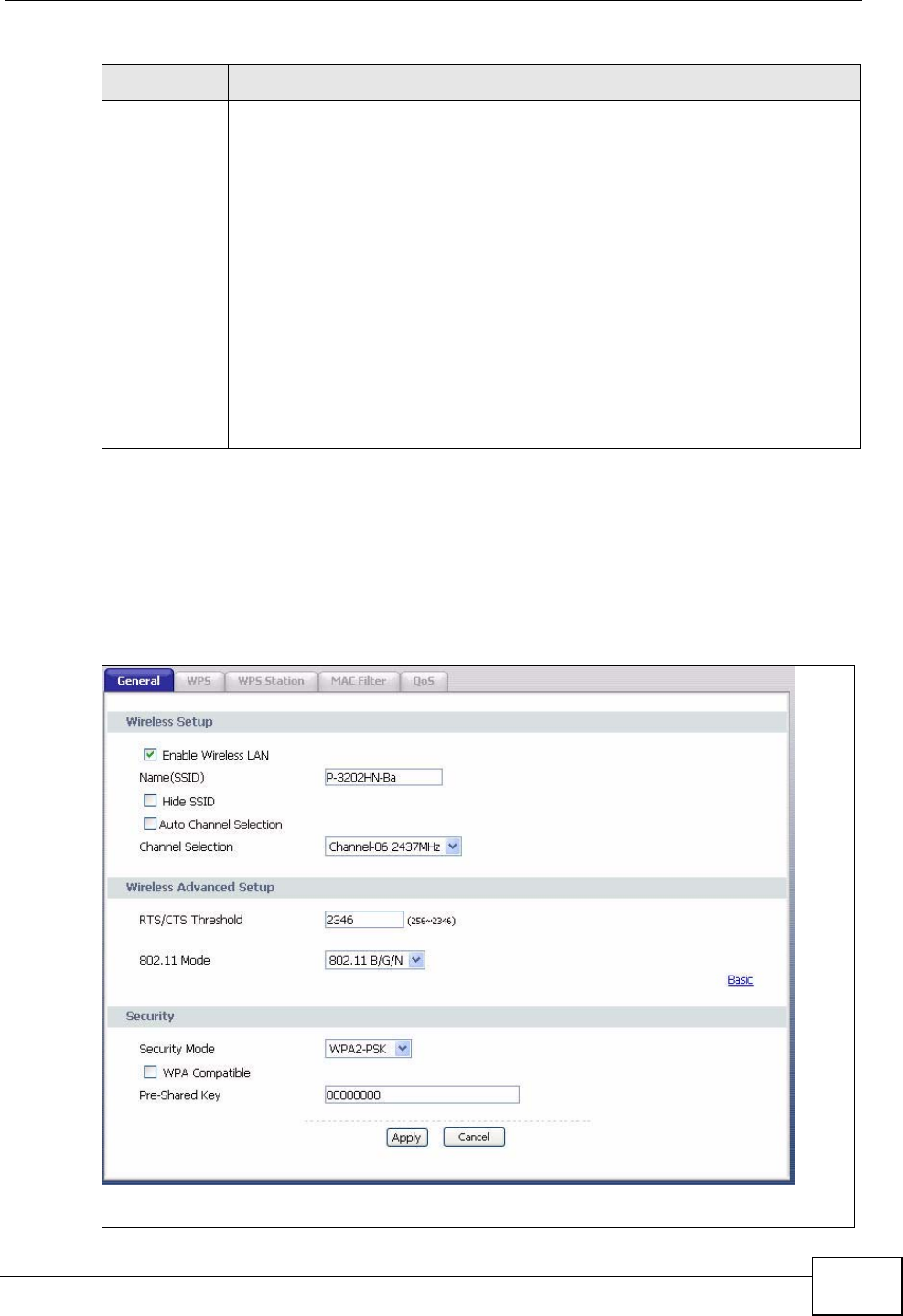
Chapter 8 Wireless LAN
IAD User’s Guide 77
8.4.3 WPA(2)-PSK
In order to configure and enable WPA(2)-PSK authentication; click Network >
Wireless LAN to display the General screen. Select WPA-PSK or WPA2-PSK
from the Security Mode list.
Figure 26 Wireless LAN > General: WPA(2)-PSK
WEP
Encryption WEP (Wired Equivalent Privacy) provides data encryption to prevent
unauthorized wireless stations from accessing data transmitted over the
wireless network.
Select 64-bit or 128-bit to enable data encryption.
Key 1 to Key
4The WEP key is used to secure your data from eavesdropping by
unauthorized wireless users. Both the IAD and the wireless stations must
use the same WEP key for data transmission.
Only one key can be activated at any one time. Select a default key to use
for data encryption.
If you chose 64-bit in the WEP Encryption field, then enter any 5
characters (ASCII string) or 10 hexadecimal characters ("0-9", "A-F")
preceded by 0x for each key.
If you chose 128-bit in the WEP Encryption field, then enter 13
characters (ASCII string) or 26 hexadecimal characters ("0-9", "A-F")
preceded by 0x for each key.
Table 14 Network > Wireless LAN > General: Static WEP Encryption
LABEL DESCRIPTION

Chapter 8 Wireless LAN
IAD User’s Guide
78
The following table describes the wireless LAN security labels in this screen.
8.4.4 WPA(2) Authentication
Use this screen to configure and enable WPA or WPA2 authentication; click the
Wireless LAN link under Network to display the General screen. Select WPA or
WPA2 from the Security Mode list.
Note: WPA or WPA2 is not available if you enable WPS before you configure WPA or
WPA2 in the Wireless LAN > General screen.
Table 15 Wireless LAN > General: WPA(2)-PSK
LABEL DESCRIPTION
Auto Generate
Key This field is only available for WPA-PSK.
Select this option to have the IAD automatically generate an SSID and
pre-shared key. The SSID and Pre-Shared Key fields will not be
configurable when you select this option.
Security Mode Choose WPA-PSK or WPA2-PSK from the drop-down list box.
Active
Compatible This field is only available for WPA2-PSK. Select this if you want the IAD
to support WPA-PSK and WPA2-PSK simultaneously.
Encryption Select the encryption type (TKIP, AES or TKIP+AES) for data
encryption.
Select TKIP if your wireless clients can all use TKIP.
Select AES if your wireless clients can all use AES.
Select TKIP+AES to allow the wireless clients to use either TKIP or
AES.
Pre-Shared Key The encryption mechanisms used for WPA(2) and WPA(2)-PSK are the
same. The only difference between the two is that WPA(2)-PSK uses a
simple common password, instead of user-specific credentials.
Type a pre-shared key from 8 to 63 case-sensitive ASCII characters
(including spaces and symbols).
Group Key
Update Timer The Group Key Update Timer is the rate at which the AP sends a new
group key out to all clients.
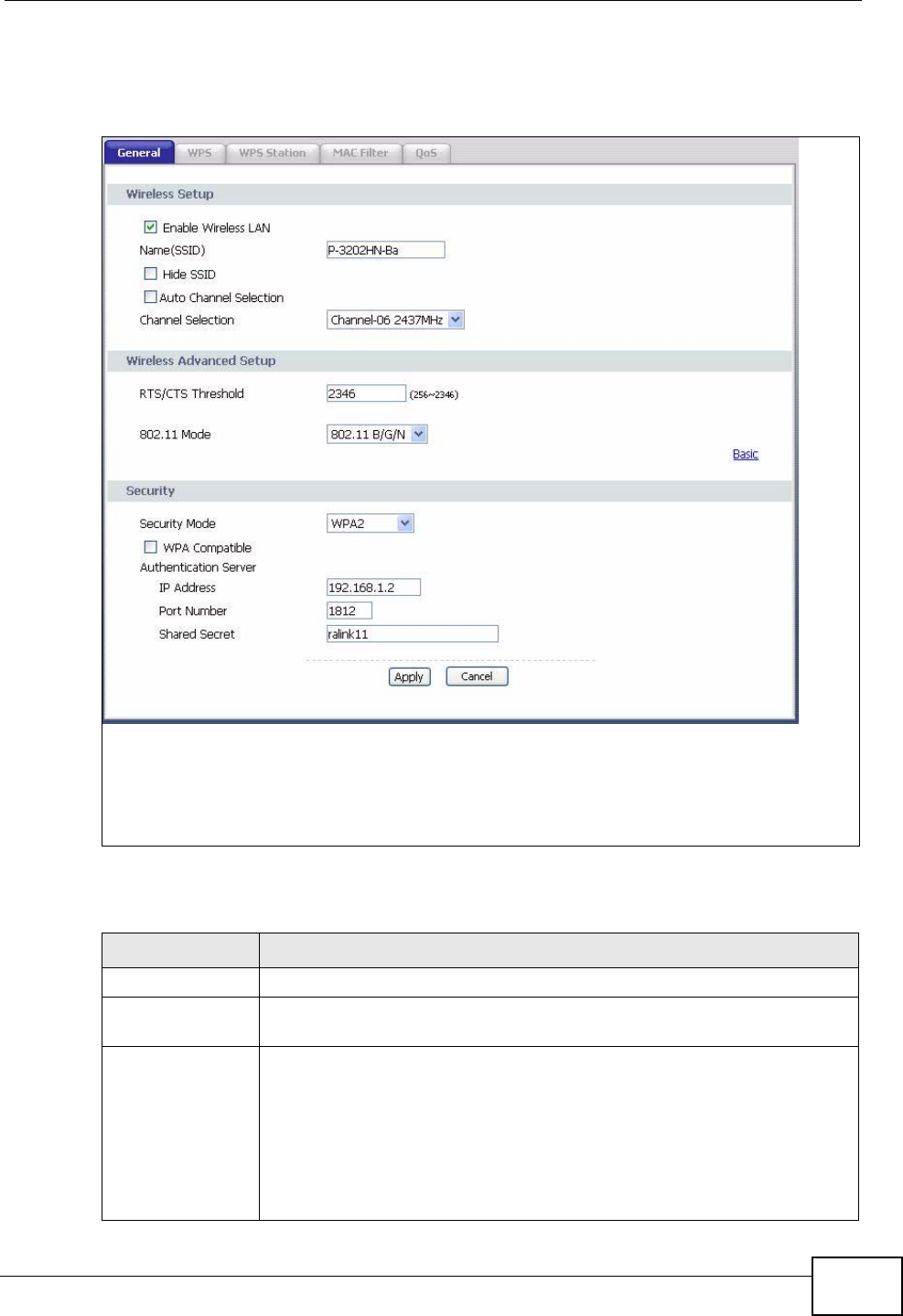
Chapter 8 Wireless LAN
IAD User’s Guide 79
Note: If you select WPA or WPA2 in the Wireless LAN > General screen, the WDS
and WPS features are not available on the IAD.
Figure 27 Wireless LAN > General: WPA(2)
The following table describes the wireless LAN security labels in this screen.
Table 16 Wireless LAN > General: WPA(2)
LABEL DESCRIPTION
Security Mode Choose WPA or WPA2 from the drop-down list box.
Active
Compatible This field is only available for WPA2. Select this if you want the IAD to
support WPA and WPA2 simultaneously.
Encryption Select the encryption type (TKIP, AES or TKIP+AES) for data
encryption.
Select TKIP if your wireless clients can all use TKIP.
Select AES if your wireless clients can all use AES.
Select TKIP+AES to allow the wireless clients to use either TKIP or
AES.

Chapter 8 Wireless LAN
IAD User’s Guide
80
8.4.5 MAC Filter
This screen allows you to configure the IAD to give exclusive access to specific
devices (Allow) or exclude specific devices from accessing the IAD (Deny). Every
Ethernet device has a unique MAC (Media Access Control) address. The MAC
address is assigned at the factory and consists of six pairs of hexadecimal
characters, for example, 00:A0:C5:00:00:02. You need to know the MAC
addresses of the devices to configure this screen.
WPA2
Preauthenticatio
n
This field is available only when you select WPA2.
Pre-authentication enables fast roaming by allowing the wireless client
(already connecting to an AP) to perform IEEE 802.1x authentication
with another AP before connecting to it. Select Enabled to turn on
preauthentication in WAP2. Otherwise, select Disabled.
Network Re-auth
Interval This field is available only when you select WPA2.
Specify how often wireless clients have to resend usernames and
passwords in order to stay connected. Enter a time interval between
10 and 2147483647 seconds.
Note: If wireless client authentication is done using a RADIUS
server, the reauthentication timer on the RADIUS server has
priority.
Group Key
Update Timer The Group Key Update Timer is the rate at which the RADIUS server
sends a new group key out to all clients.
Authentication Server
IP Address Enter the IP address of the external authentication server in dotted
decimal notation.
Port Number Enter the port number of the external authentication server. The
default port number is 1812.
You need not change this value unless your network administrator
instructs you to do so with additional information.
Shared Secret Enter a password (up to 31 alphanumeric characters) as the key to be
shared between the external authentication server and the IAD.
The key must be the same on the external authentication server and
your IAD. The key is not sent over the network.
Table 16 Wireless LAN > General: WPA(2)
LABEL DESCRIPTION
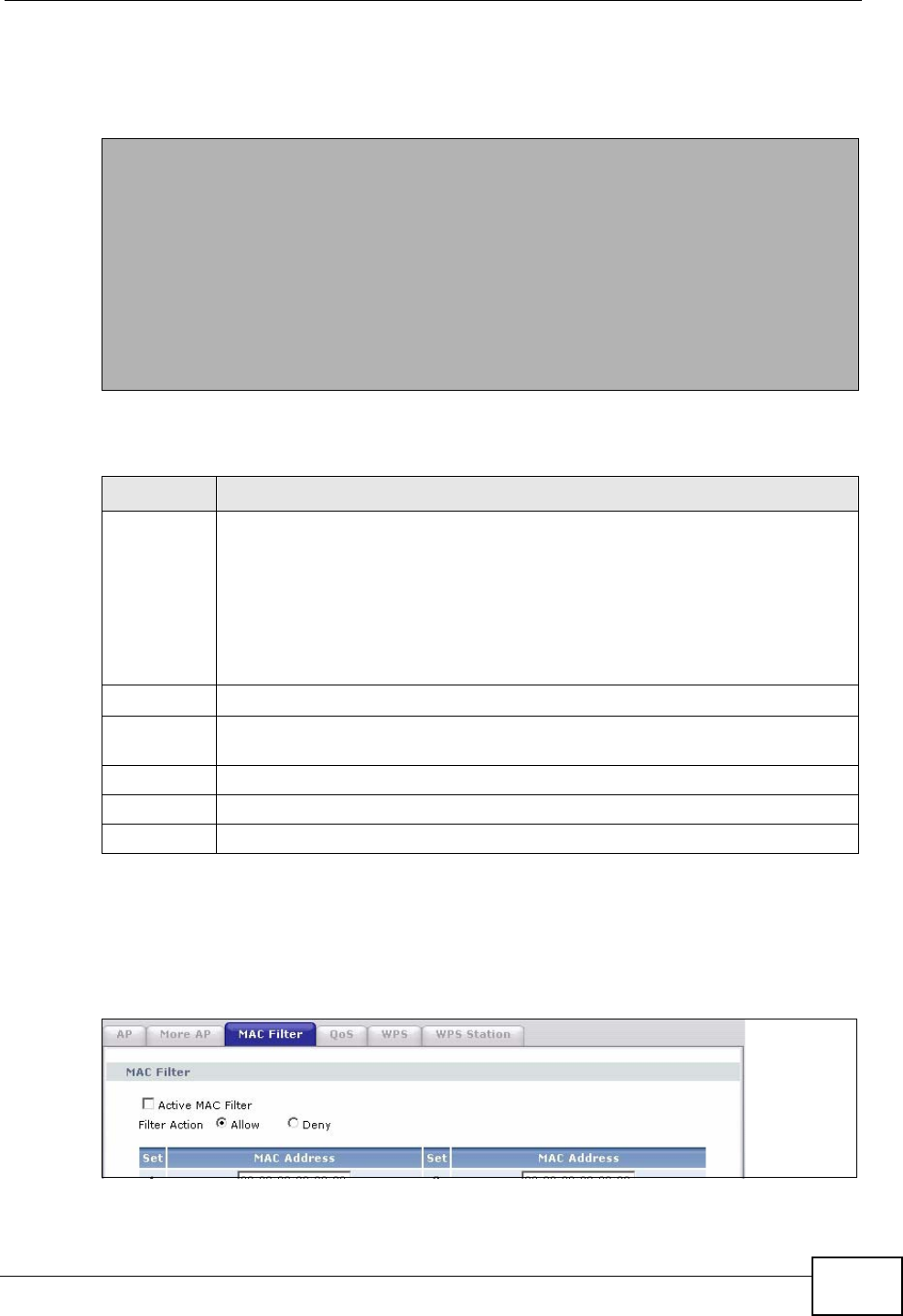
Chapter 8 Wireless LAN
IAD User’s Guide 81
Use this screen to change your IAD’s MAC filter settings. Click the Edit button in
the Wireless LAN > General screen. The following screen displays.
Figure 28 Wireless LAN > MAC Filter
The following table describes the labels in this screen.
8.4.6 Adding a New MAC Filtering Rule
Click the Add button in the MAC Filter screen. The following screen displays.
Figure 29 Wireless LAN > MAC Filter > Add
Table 17 Wireless LAN > MAC Filter
LABEL DESCRIPTION
MAC Restrict
Mode
Define the filter action for the list of MAC addresses in the table below.
Select Disabled to turn off MAC address filtering.
Select Allow to permit access to the IAD, MAC addresses not listed will be
denied access to the IAD.
Select Deny to block access to the IAD, MAC addresses not listed will be
allowed to access the IAD
#This is the index number of the MAC address.
MAC
Address This is the MAC addresses of the wireless devices that are allowed or denied
access to the IAD.
Modify Click the Remove icon to delete the entry.
Back Click this to return to the previous screen without saving changes.
Add Click this to create a new MAC filtering rule.

Chapter 8 Wireless LAN
IAD User’s Guide
82
The following table describes the labels in this screen.
8.5 The More AP Screen
This screen allows you to enable and configure multiple wireless networks on the
IAD.
Click Network > Wireless LAN > More AP. The following screen displays.
Figure 30 Network > Wireless LAN > More AP
The following table describes the labels in this screen.
Table 18 Wireless LAN > MAC Filter > Add
LABEL DESCRIPTION
MAC
Address Enter the MAC addresses of the wireless devices that are allowed or denied
access to the IAD in these address fields. Enter the MAC addresses in a
valid MAC address format, that is, six hexadecimal character pairs, for
example, 12:34:56:78:9a:bc.
Back Click this to return to the previous screen without saving changes.
Apply Click this to save your changes and go back to the previous screen.
Table 19 Network > Wireless LAN > More AP
LABEL DESCRIPTION
# This is the index number of each SSID profile.
Active Select the check box to activate an SSID profile.
SSID An SSID profile is the set of parameters relating to one of the IAD’s
BSSs. The SSID (Service Set IDentifier) identifies the Service Set with
which a wireless device is associated.
This field displays the name of the wireless profile on the network. When
a wireless client scans for an AP to associate with, this is the name that
is broadcast and seen in the wireless client utility.
Security This field indicates the security mode of the SSID profile.
Modify Click the Edit icon to configure the SSID profile.

Chapter 8 Wireless LAN
IAD User’s Guide 83
8.5.1 More AP Edit
Use this screen to edit an SSID profile. Click the Edit icon next to an SSID in the
More AP screen. The following screen displays.
Figure 31 Network > Wireless LAN > More AP: Edit
See Section 8.4 on page 73 for more details about the fields in this screen.
8.6 The WPS Screen
Use this screen to configure WiFi Protected Setup (WPS) on your IAD.
WPS allows you to quickly set up a wireless network with strong security, without
having to configure security settings manually. Set up each WPS connection
between two devices. Both devices must support WPS.
Apply Click Apply to save your changes back to the IAD.
Reset Click Reset to reload the previous configuration for this screen.
Table 19 Network > Wireless LAN > More AP
LABEL DESCRIPTION
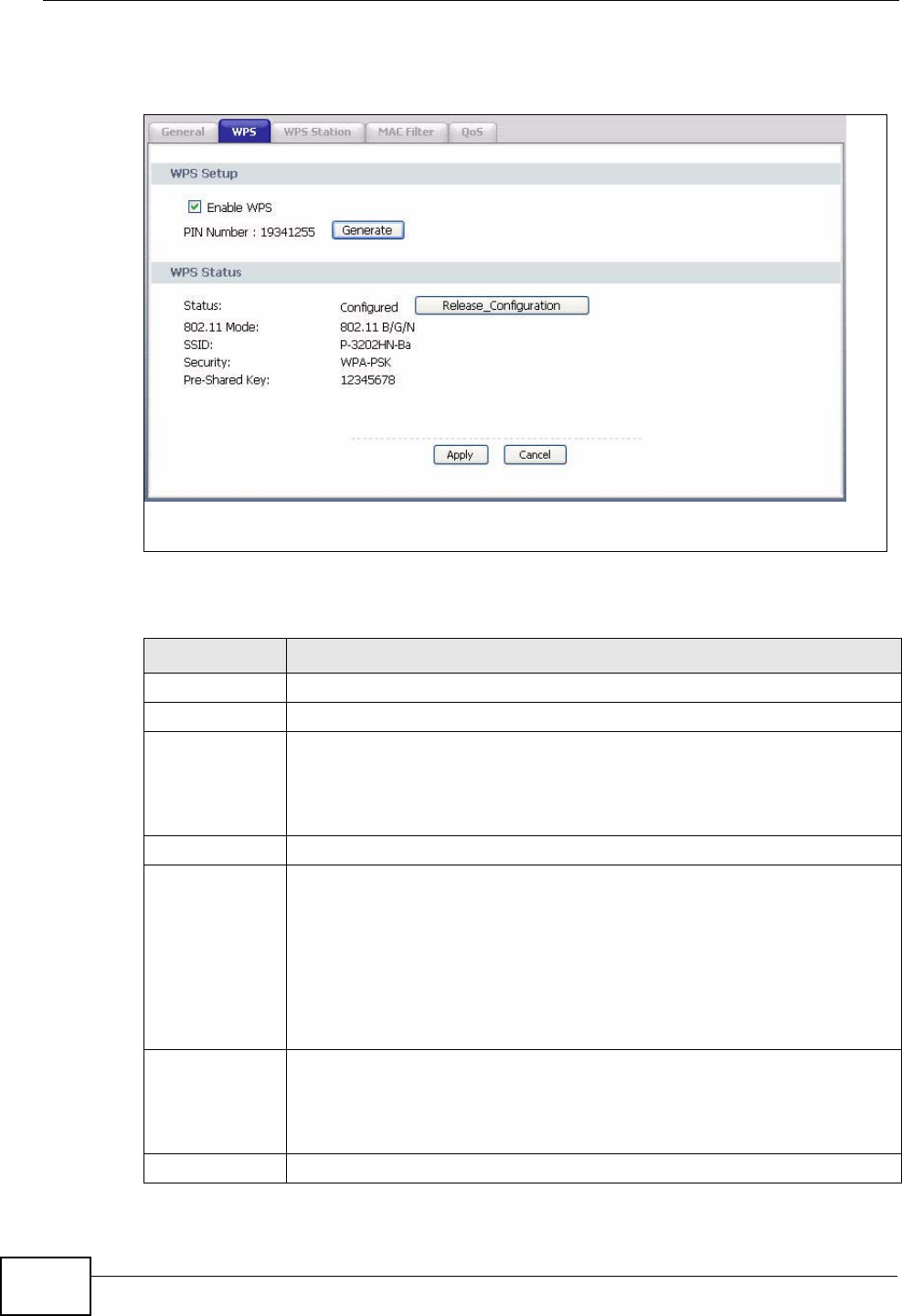
Chapter 8 Wireless LAN
IAD User’s Guide
84
Click Network > Wireless LAN >WPS. The following screen displays.
Figure 32 Network > Wireless LAN > WPS
The following table describes the labels in this screen.
Table 20 Network > Wireless LAN > WPS
LABEL DESCRIPTION
WPS Setup
Enable WPS Select the check box to activate WPS on the IAD.
PIN Number This shows the PIN (Personal Identification Number) of the IAD. Enter
this PIN in the configuration utility of the device you want to connect to
using WPS.
The PIN is not necessary when you use WPS push-button method.
Generate Click this button to have the IAD create a new PIN.
WPS Status This displays Configured when the IAD has connected to a wireless
network using WPS or Enable WPS is selected and wireless or wireless
security settings have been changed. The current wireless and wireless
security settings also appear in the screen.
This displays Unconfigured if WPS is disabled and there is no wireless
or wireless security changes on the IAD or you click
Release_Configuration to remove the configured wireless and
wireless security settings.
Release_Co
nfiguration This button is available when the WPS status is Configured but not
configurable if you disable WPS.
Click this button to remove all configured wireless and wireless security
settings for WPS connections on the IAD.
Apply Click Apply to save your changes back to the IAD.
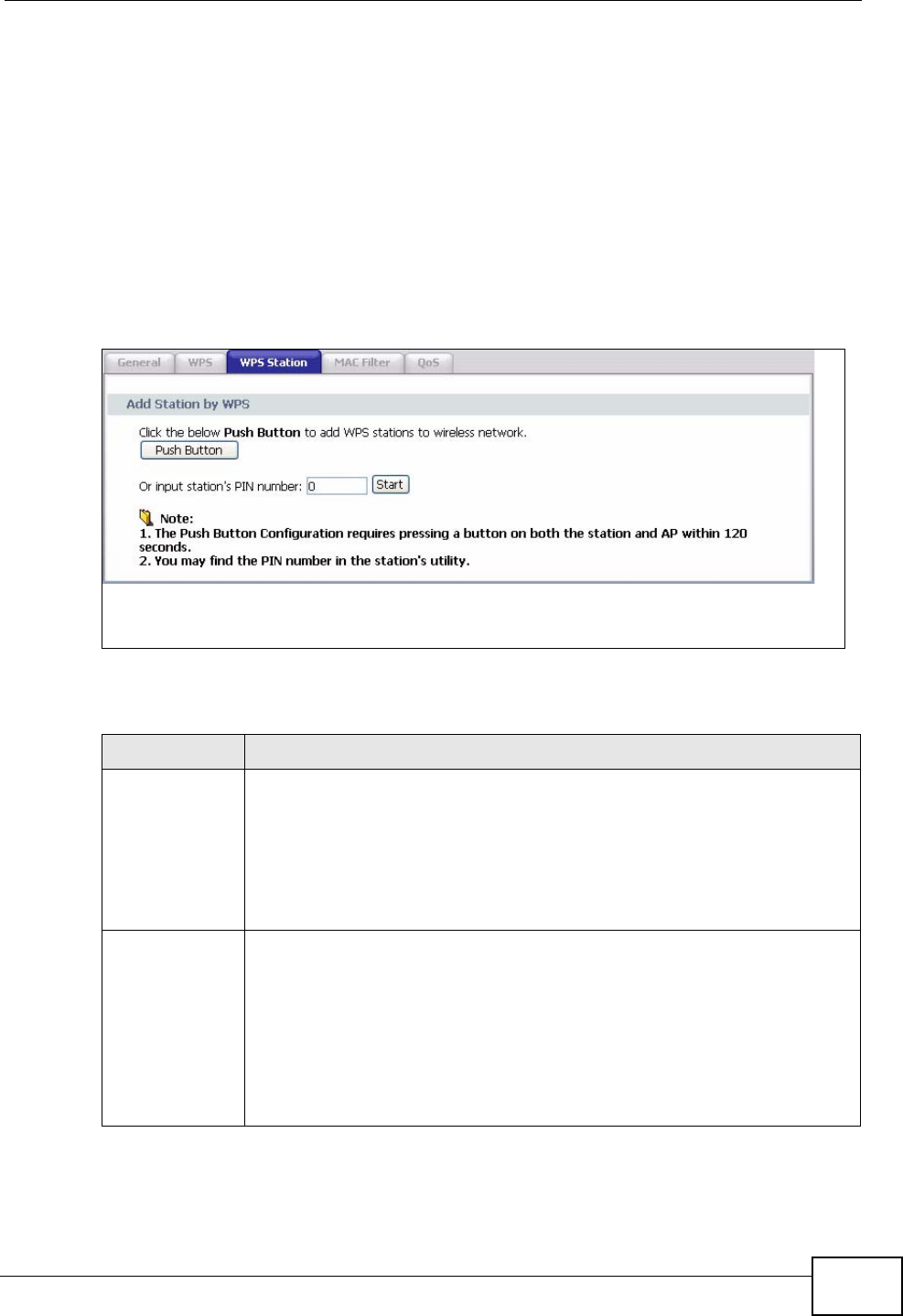
Chapter 8 Wireless LAN
IAD User’s Guide 85
8.7 The WPS Station Screen
Use this screen to set up a WPS wireless network using either Push Button
Configuration (PBC) or PIN Configuration.
Note: If you select No Security in the Wireless LAN > General screen and click
Push Button in the WPS Station screen, the IAD automatically changes to use
WPA-PSK/WPA2-PSK mixed mode and generates a pre-shared key.
Click Network > Wireless LAN > WPS Station. The following screen displays.
Figure 33 Network > Wireless LAN > WPS Station
The following table describes the labels in this screen.
Table 21 Network > Wireless LAN > WPS Station
LABEL DESCRIPTION
Push Button Click this button to add another WPS-enabled wireless device (within
wireless range of the IAD) to your wireless network. This button may
either be a physical button on the outside of device, or a menu button
similar to the Push Button on this screen.
Note: You must press the other wireless device’s WPS button within
two minutes of pressing this button.
Or input
station's PIN
number
Enter the PIN of the device that you are setting up a WPS connection
with and click Start to authenticate and add the wireless device to your
wireless network.
You can find the PIN either on the outside of the device, or by checking
the device’s settings.
Note: You must also activate WPS on that device within two minutes
to have it present its PIN to the IAD.

Chapter 8 Wireless LAN
IAD User’s Guide
86
8.8 The WDS Screen
A Wireless Distribution System (WDS) is a wireless connection between two or
more APs. Use this screen to set up your WDS links between the IADs. You need
to know the MAC address of the peer device. Once the security settings of peer
sides match one another, the connection between the devices is made.
Note: You cannot use WDS when WPS is enabled or wireless security is set to “WPA"
or "WPA2". The wireless security settings apply to both WDS links and the
connections between the ZyXEL Device and any wireless clients.
Note: At the time of writing, WDS is only compatible with other ZyXEL Devices of the
same model.
Click Network > Wireless LAN > WDS. The following screen displays. WDS is
turned on and this screen is configurable when the ZyXEL Device's wireless
security mode is No Security, WEP or WPA(2)-PSK.
Figure 34 Network > Wireless LAN > WDS

Chapter 8 Wireless LAN
IAD User’s Guide 87
The following table describes the labels in this screen.
Table 22 Network > Wireless LAN > WDS
LABEL DESCRIPTION
WDS
Operating Mode Select the operating mode for your IAD.
•Access Point + Bridge - The IAD functions as a bridge and access
point simultaneously.
•Wireless Bridge - The IAD acts as a wireless network bridge and
establishes wireless links with other APs. In this mode, clients
cannot connect to the IAD wirelessly.
You need to know the MAC address of the peer device, which must be of
the same model and also WDS-enabled. The IAD can establish up to
four wireless links with other APs.
Bridge Restrict This field is available only when you set operating mode to Access
Point + Bridge.
Select Enabled to turn on WDS and enter the peer device’s MAC
address manually in the table below.
Select Enabled(Scan) to turn on WDS, search and display the
available APs within range in the table below.
Remote Bridges
MAC Address Enter the MAC address of the peer device that your IAD wants to make
a bridge connection with.
You can connect to up to 4 peer devices.
This field is available only when you select Enabled(Scan) in the
Bridge Restrict field.
Select the check box and click Apply to have the IAD establish a
wireless link with the selected wireless device.
SSID This field is available only when you select Enabled(Scan) in the
Bridge Restrict field.
This shows the SSID of the available wireless device within range.
BSSID This field is available only when you select Enabled(Scan) in the
Bridge Restrict field.
This shows the MAC address of the available wireless device within
range.
Refresh Click Refresh to update the Remote Bridges MAC Address table
when Bridge Restrict is set to Enabled(Scan).
Apply Click Apply to save your changes to IAD.
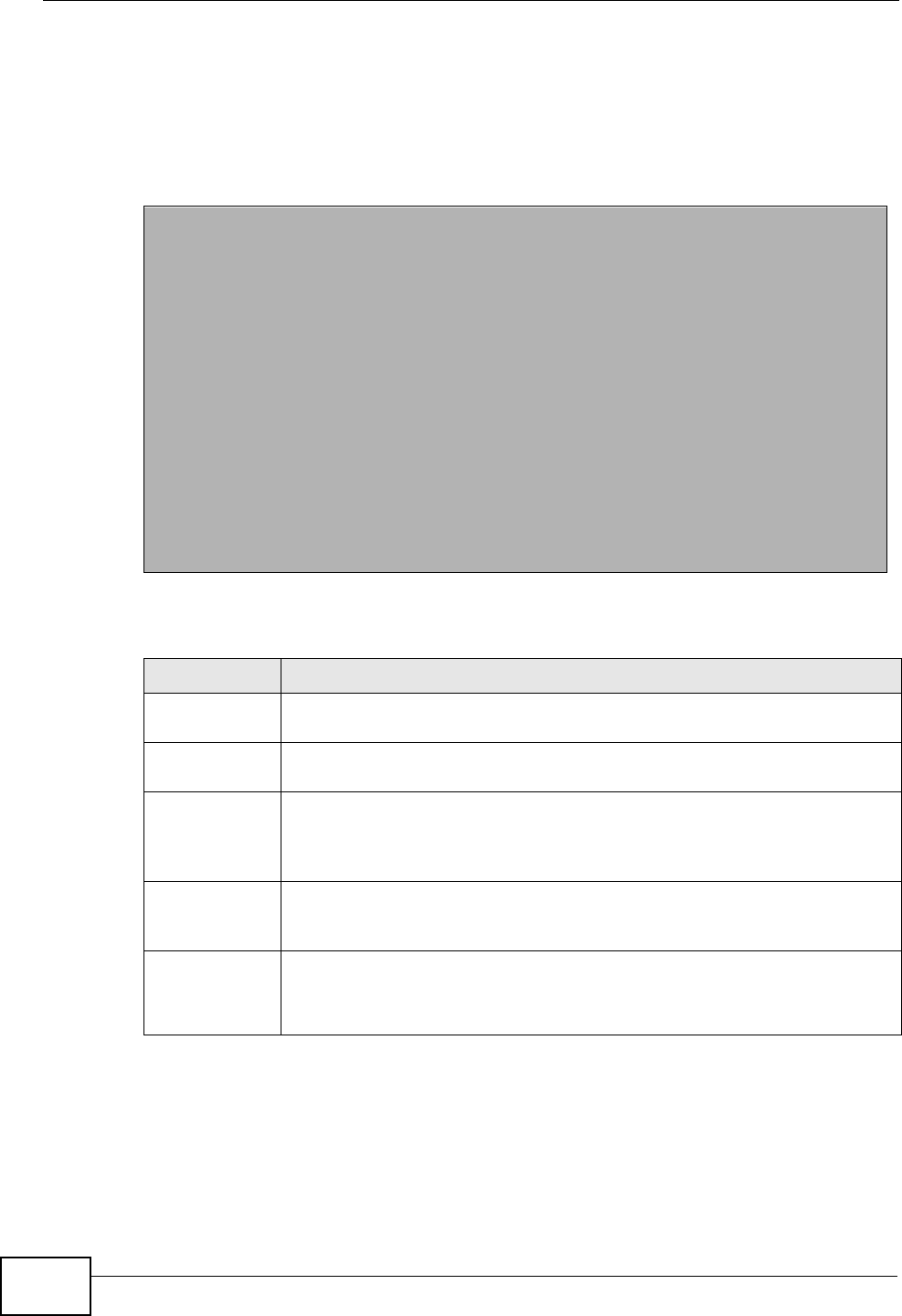
Chapter 8 Wireless LAN
IAD User’s Guide
88
8.9 The Advanced Setup Screen
To configure advanced wireless settings, click Network > Wireless LAN >
Advanced Setup. The screen appears as shown.
Figure 35 Wireless LAN > Advanced Setup
The following table describes the labels in this screen.
Table 23 Wireless LAN > Advanced Setup
LABEL DESCRIPTION
RTS/CTS
Threshold Enter a value between 0 and 2432.
Fragmentation
Threshold This is the maximum data fragment size that can be sent. Enter a value
between 256 and 2432.
Number of
Wireless
Stations
Allowed
Specify the maximum number (from 1 to 64) of the wireless stations that
may connect to the IAD.
Output Power Set the output power of the IAD. If there is a high density of APs in an
area, decrease the output power to reduce interference with other APs.
Select one of the following 20%, 40%, 60%, 80% or 100%.
Multicast Rate Select a data rate at which the IAD transmits wireless multicast traffic.
If you select a high rate, multicast traffic may occupy all the bandwidth
and cause metwork congestion.

Chapter 8 Wireless LAN
IAD User’s Guide 89
8.10 Technical Reference
This section discusses wireless LANs in depth. For more information, see the
appendix.
802.11 Mode Select 802.11b Only to only allow IEEE 802.11b compliant WLAN
devices to associate with the IAD.
Select 802.11g Only to allow IEEE 802.11g compliant WLAN devices to
associate with the IAD. IEEE 802.11b compliant WLAN devices can
associate with the IAD only when they use the short premble type.
Select 802.11n Only to only allow IEEE 802.11n compliant WLAN
devices to associate with the IAD. This can increase transmission rates,
although IEEE 802.11b or IEEE 802.11g clients will not be able to
connect to the IAD.
Select 802.11b/g Mixed to allow either IEEE 802.11b or IEEE 802.11g
compliant WLAN devices to associate with the IAD. The IAD adjusts the
transmission rate automatically according to the wireless standard
supported by the wireless devices.
Select 802.11 b/g/n mixed mode to allow both IEEE802.11b,
IEEE802.11g and IEEE802.11n compliant WLAN devices to associate with
the IAD. The transmission rate of your IAD might be reduced.
802.11
Protection Enabling this feature can help prevent collisions in mixed-mode networks
(networks with both IEEE 802.11b and IEEE 802.11g traffic).
Select Auto to have the wireless devices transmit data after a RTS/CTS
handshake. This helps improve IEEE 802.11g performance.
Select Off to disable 802.11 protection. The transmission rate of your
IAD might be reduced in a mixed-mode network.
This field displays Off and is not configurable when you set 802.11
Mode to 802.11b Only.
Preamble Select a preamble type from the drop-down list menu. Choices are Long
or Short. The default setting is Long. See the appendix for more
information.
This field is not configurable and the IAD uses Short when you set
802.11 Mode to 802.11g Only or 802.11n Only.
Apply Click this to save your changes back to the IAD.
Reset Click this to reload the previous configuration for this screen.
Table 23 Wireless LAN > Advanced Setup
LABEL DESCRIPTION
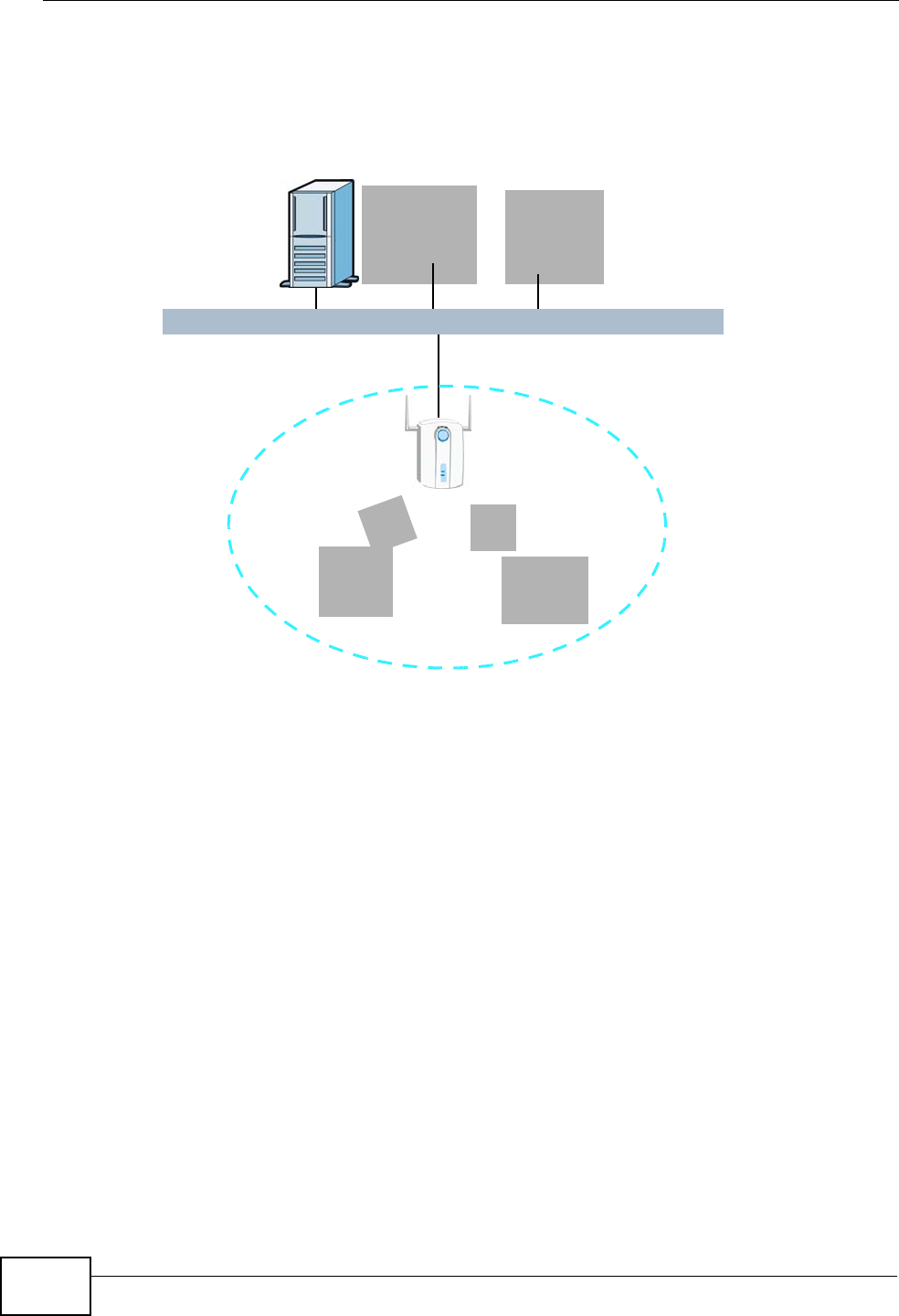
Chapter 8 Wireless LAN
IAD User’s Guide
90
8.10.1 Wireless Network Overview
The following figure provides an example of a wireless network.
Figure 36 Example of a Wireless Network
The wireless network is the part in the blue circle. In this wireless network,
devices A and B use the access point (AP) to interact with the other devices (such
as the printer) or with the Internet. Your IAD is the AP.
Every wireless network must follow these basic guidelines.
• Every device in the same wireless network must use the same SSID.
The SSID is the name of the wireless network. It stands for Service Set IDentity.
• If two wireless networks overlap, they should use a different channel.
Like radio stations or television channels, each wireless network uses a specific
channel, or frequency, to send and receive information.
• Every device in the same wireless network must use security compatible with
the AP.
Security stops unauthorized devices from using the wireless network. It can also
protect the information that is sent in the wireless network.
AB
AP

Chapter 8 Wireless LAN
IAD User’s Guide 91
8.10.2 Additional Wireless Terms
The following table describes some wireless network terms and acronyms used in
the IAD’s Web Configurator.
8.10.3 Wireless Security Overview
The following sections introduce different types of wireless security you can set up
in the wireless network.
8.10.3.1 SSID
Normally, the IAD acts like a beacon and regularly broadcasts the SSID in the
area. You can hide the SSID instead, in which case the IAD does not broadcast the
SSID. In addition, you should change the default SSID to something that is
difficult to guess.
This type of security is fairly weak, however, because there are ways for
unauthorized wireless devices to get the SSID. In addition, unauthorized wireless
devices can still see the information that is sent in the wireless network.
8.10.3.2 MAC Address Filter
Every device that can use a wireless network has a unique identification number,
called a MAC address.1 A MAC address is usually written using twelve hexadecimal
Table 24 Additional Wireless Terms
TERM DESCRIPTION
RTS/CTS Threshold In a wireless network which covers a large area, wireless devices
are sometimes not aware of each other’s presence. This may cause
them to send information to the AP at the same time and result in
information colliding and not getting through.
By setting this value lower than the default value, the wireless
devices must sometimes get permission to send information to the
IAD. The lower the value, the more often the devices must get
permission.
If this value is greater than the fragmentation threshold value (see
below), then wireless devices never have to get permission to send
information to the IAD.
Preamble A preamble affects the timing in your wireless network. There are
two preamble modes: long and short. If a device uses a different
preamble mode than the IAD does, it cannot communicate with the
IAD.
Authentication The process of verifying whether a wireless device is allowed to use
the wireless network.
Fragmentation
Threshold A small fragmentation threshold is recommended for busy networks,
while a larger threshold provides faster performance if the network
is not very busy.

Chapter 8 Wireless LAN
IAD User’s Guide
92
characters2; for example, 00A0C5000002 or 00:A0:C5:00:00:02. To get the MAC
address for each device in the wireless network, see the device’s User’s Guide or
other documentation.
You can use the MAC address filter to tell the IAD which devices are allowed or not
allowed to use the wireless network. If a device is allowed to use the wireless
network, it still has to have the correct information (SSID, channel, and security).
If a device is not allowed to use the wireless network, it does not matter if it has
the correct information.
This type of security does not protect the information that is sent in the wireless
network. Furthermore, there are ways for unauthorized wireless devices to get the
MAC address of an authorized device. Then, they can use that MAC address to use
the wireless network.
8.10.3.3 User Authentication
Authentication is the process of verifying whether a wireless device is allowed to
use the wireless network. You can make every user log in to the wireless network
before they can use it. However, every device in the wireless network has to
support IEEE 802.1x to do this.
For wireless networks, you can store the user names and passwords for each user
in a RADIUS server. This is a server used in businesses more than in homes. If you
do not have a RADIUS server, you cannot set up user names and passwords for
your users.
Unauthorized wireless devices can still see the information that is sent in the
wireless network, even if they cannot use the wireless network. Furthermore,
there are ways for unauthorized wireless users to get a valid user name and
password. Then, they can use that user name and password to use the wireless
network.
8.10.3.4 Encryption
Wireless networks can use encryption to protect the information that is sent in the
wireless network. Encryption is like a secret code. If you do not know the secret
code, you cannot understand the message.
1. Some wireless devices, such as scanners, can detect wireless networks but cannot use wireless networks.
These kinds of wireless devices might not have MAC addresses.
2. Hexadecimal characters are 0, 1, 2, 3, 4, 5, 6, 7, 8, 9, A, B, C, D, E, and F.

Chapter 8 Wireless LAN
IAD User’s Guide 93
The types of encryption you can choose depend on the type of authentication.
(See Section 8.10.3.3 on page 92 for information about this.)
For example, if the wireless network has a RADIUS server, you can choose WPA
or WPA2. If users do not log in to the wireless network, you can choose no
encryption, Static WEP, WPA-PSK, or WPA2-PSK.
Usually, you should set up the strongest encryption that every device in the
wireless network supports. For example, suppose you have a wireless network
with the IAD and you do not have a RADIUS server. Therefore, there is no
authentication. Suppose the wireless network has two devices. Device A only
supports WEP, and device B supports WEP and WPA. Therefore, you should set up
Static WEP in the wireless network.
Note: It is recommended that wireless networks use WPA-PSK, WPA, or stronger
encryption. The other types of encryption are better than none at all, but it is still
possible for unauthorized wireless devices to figure out the original information
pretty quickly.
When you select WPA2 or WPA2-PSK in your IAD, you can also select an option
(WPA compatible) to support WPA as well. In this case, if some of the devices
support WPA and some support WPA2, you should set up WPA2-PSK or WPA2
(depending on the type of wireless network login) and select the WPA
compatible option in the IAD.
Many types of encryption use a key to protect the information in the wireless
network. The longer the key, the stronger the encryption. Every device in the
wireless network must have the same key.
8.10.4 WiFi Protected Setup
Your IAD supports WiFi Protected Setup (WPS), which is an easy way to set up a
secure wireless network. WPS is an industry standard specification, defined by the
WiFi Alliance.
WPS allows you to quickly set up a wireless network with strong security, without
having to configure security settings manually. Each WPS connection works
Table 25 Types of Encryption for Each Type of Authentication
NO AUTHENTICATION RADIUS SERVER
Weakest No Security
WPA
Static WEP
WPA-PSK
Stronges
tWPA2-PSK WPA2

Chapter 8 Wireless LAN
IAD User’s Guide
94
between two devices. Both devices must support WPS (check each device’s
documentation to make sure).
Depending on the devices you have, you can either press a button (on the device
itself, or in its configuration utility) or enter a PIN (a unique Personal Identification
Number that allows one device to authenticate the other) in each of the two
devices. When WPS is activated on a device, it has two minutes to find another
device that also has WPS activated. Then, the two devices connect and set up a
secure network by themselves.
8.10.4.1 Push Button Configuration
WPS Push Button Configuration (PBC) is initiated by pressing a button on each
WPS-enabled device, and allowing them to connect automatically. You do not need
to enter any information.
Not every WPS-enabled device has a physical WPS button. Some may have a WPS
PBC button in their configuration utilities instead of or in addition to the physical
button.
Take the following steps to set up WPS using the button.
1Ensure that the two devices you want to set up are within wireless range of one
another.
2Look for a WPS button on each device. If the device does not have one, log into its
configuration utility and locate the button (see the device’s User’s Guide for how to
do this - for the IAD, see Section 8.7 on page 85).
3Press the button on one of the devices (it doesn’t matter which). For the IAD you
must press the WPS button for more than three seconds.
4Within two minutes, press the button on the other device. The registrar sends the
network name (SSID) and security key through an secure connection to the
enrollee.
If you need to make sure that WPS worked, check the list of associated wireless
clients in the AP’s configuration utility. If you see the wireless client in the list,
WPS was successful.
8.10.4.2 PIN Configuration
Each WPS-enabled device has its own PIN (Personal Identification Number). This
may either be static (it cannot be changed) or dynamic (in some devices you can
generate a new PIN by clicking on a button in the configuration interface).

Chapter 8 Wireless LAN
IAD User’s Guide 95
Use the PIN method instead of the push-button configuration (PBC) method if you
want to ensure that the connection is established between the devices you specify,
not just the first two devices to activate WPS in range of each other. However, you
need to log into the configuration interfaces of both devices to use the PIN
method.
When you use the PIN method, you must enter the PIN from one device (usually
the wireless client) into the second device (usually the Access Point or wireless
router). Then, when WPS is activated on the first device, it presents its PIN to the
second device. If the PIN matches, one device sends the network and security
information to the other, allowing it to join the network.
Take the following steps to set up a WPS connection between an access point or
wireless router (referred to here as the AP) and a client device using the PIN
method.
1Ensure WPS is enabled on both devices.
2Access the WPS section of the AP’s configuration interface. See the device’s User’s
Guide for how to do this.
3Look for the client’s WPS PIN; it will be displayed either on the device, or in the
WPS section of the client’s configuration interface (see the device’s User’s Guide
for how to find the WPS PIN - for the IAD, see Section 8.6 on page 83).
4Enter the client’s PIN in the AP’s configuration interface.
Note: If the client device’s configuration interface has an area for entering another
device’s PIN, you can either enter the client’s PIN in the AP, or enter the AP’s
PIN in the client - it does not matter which.
5Start WPS on both devices within two minutes.
Note: Use the configuration utility to activate WPS, not the push-button on the device
itself.
6On a computer connected to the wireless client, try to connect to the Internet. If
you can connect, WPS was successful.
If you cannot connect, check the list of associated wireless clients in the AP’s
configuration utility. If you see the wireless client in the list, WPS was successful.
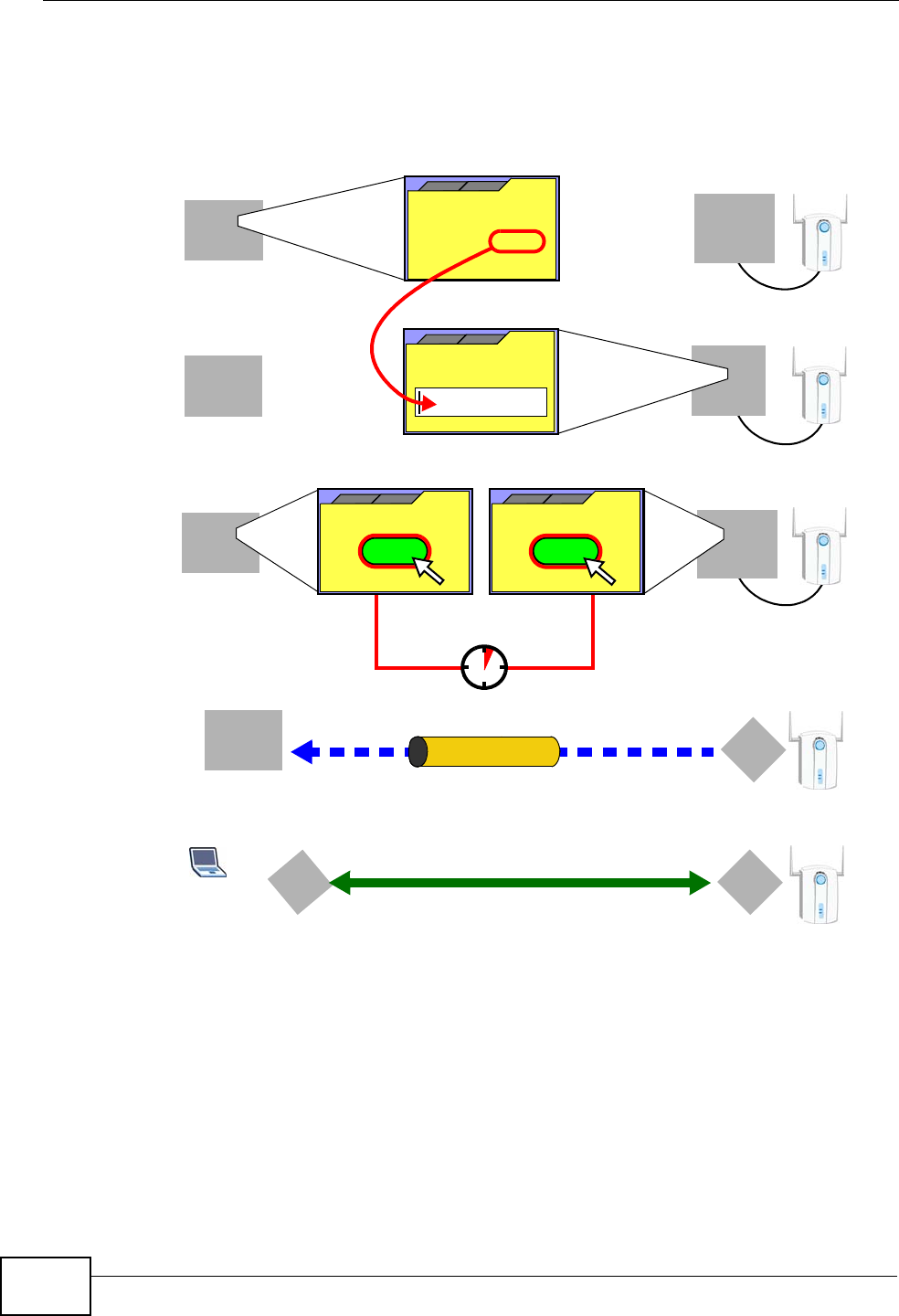
Chapter 8 Wireless LAN
IAD User’s Guide
96
The following figure shows a WPS-enabled wireless client (installed in a notebook
computer) connecting to the WPS-enabled AP via the PIN method.
Figure 37 Example WPS Process: PIN Method
8.10.4.3 How WPS Works
When two WPS-enabled devices connect, each device must assume a specific role.
One device acts as the registrar (the device that supplies network and security
settings) and the other device acts as the enrollee (the device that receives
network and security settings. The registrar creates a secure EAP (Extensible
Authentication Protocol) tunnel and sends the network name (SSID) and the WPA-
PSK or WPA2-PSK pre-shared key to the enrollee. Whether WPA-PSK or WPA2-PSK
is used depends on the standards supported by the devices. If the registrar is
already part of a network, it sends the existing information. If not, it generates
the SSID and WPA(2)-PSK randomly.
ENROLLEE
SECURE EAP TUNNEL
SSID
WPA(2)-PSK
WITHIN 2 MINUTES
COMMUNICATION
This device’s
WPS
Enter WPS PIN
WPS
from other device:
WPS PIN: 123456
WPS
START
WPS
START
REGISTRAR
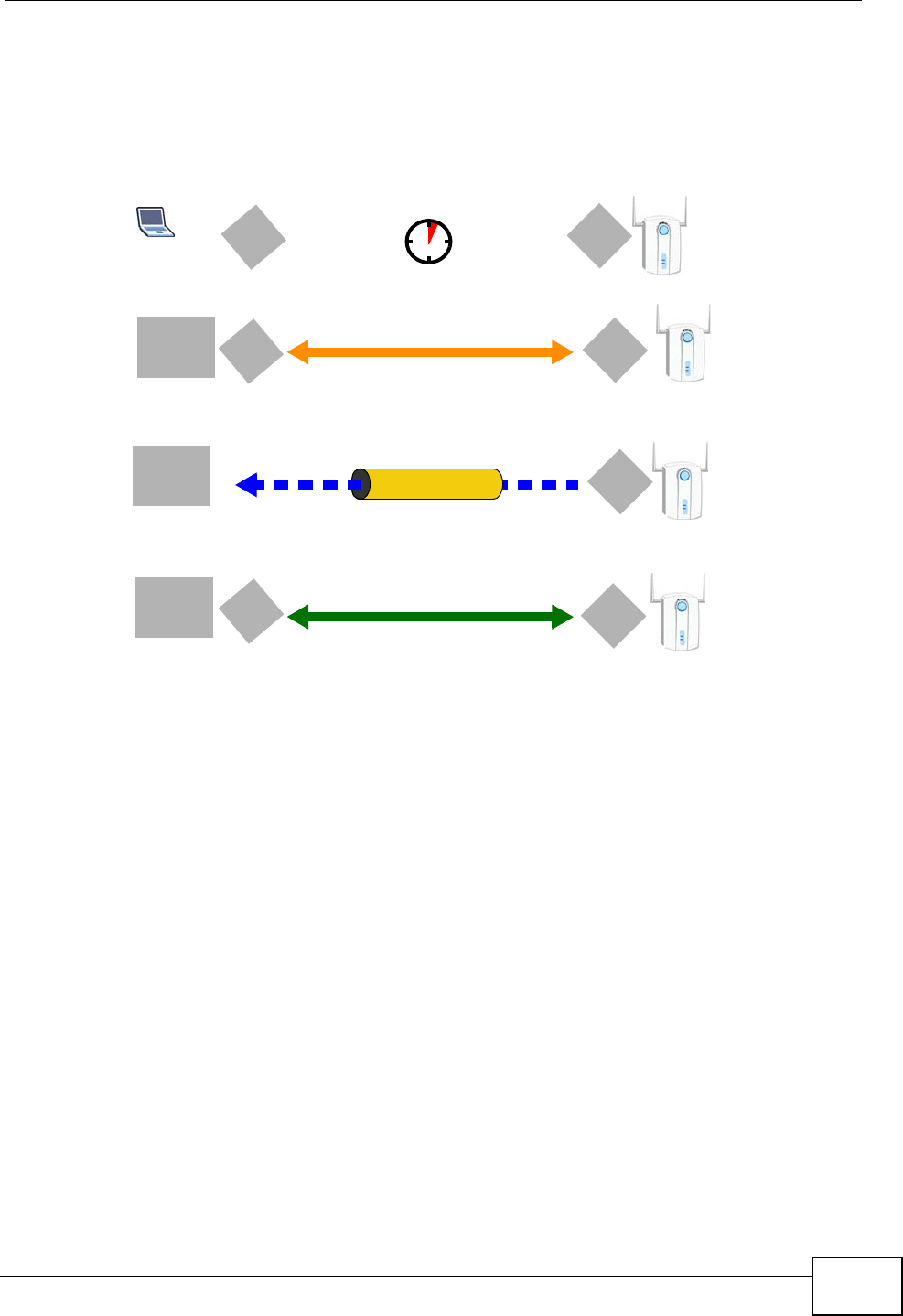
Chapter 8 Wireless LAN
IAD User’s Guide 97
The following figure shows a WPS-enabled client (installed in a notebook
computer) connecting to a WPS-enabled access point.
Figure 38 How WPS works
The roles of registrar and enrollee last only as long as the WPS setup process is
active (two minutes). The next time you use WPS, a different device can be the
registrar if necessary.
The WPS connection process is like a handshake; only two devices participate in
each WPS transaction. If you want to add more devices you should repeat the
process with one of the existing networked devices and the new device.
Note that the access point (AP) is not always the registrar, and the wireless client
is not always the enrollee. All WPS-certified APs can be a registrar, and so can
some WPS-enabled wireless clients.
By default, a WPS devices is “unconfigured”. This means that it is not part of an
existing network and can act as either enrollee or registrar (if it supports both
functions). If the registrar is unconfigured, the security settings it transmits to the
enrollee are randomly-generated. Once a WPS-enabled device has connected to
another device using WPS, it becomes “configured”. A configured wireless client
can still act as enrollee or registrar in subsequent WPS connections, but a
configured access point can no longer act as enrollee. It will be the registrar in all
subsequent WPS connections in which it is involved. If you want a configured AP to
act as an enrollee, you must reset it to its factory defaults.
SECURE TUNNEL
SECURITY INFO
WITHIN 2 MINUTES
COMMUNICATION
ACTIVATE
WPS
ACTIVATE
WPS
WPS HANDSHAKE
REGISTRAR
ENROLLEE
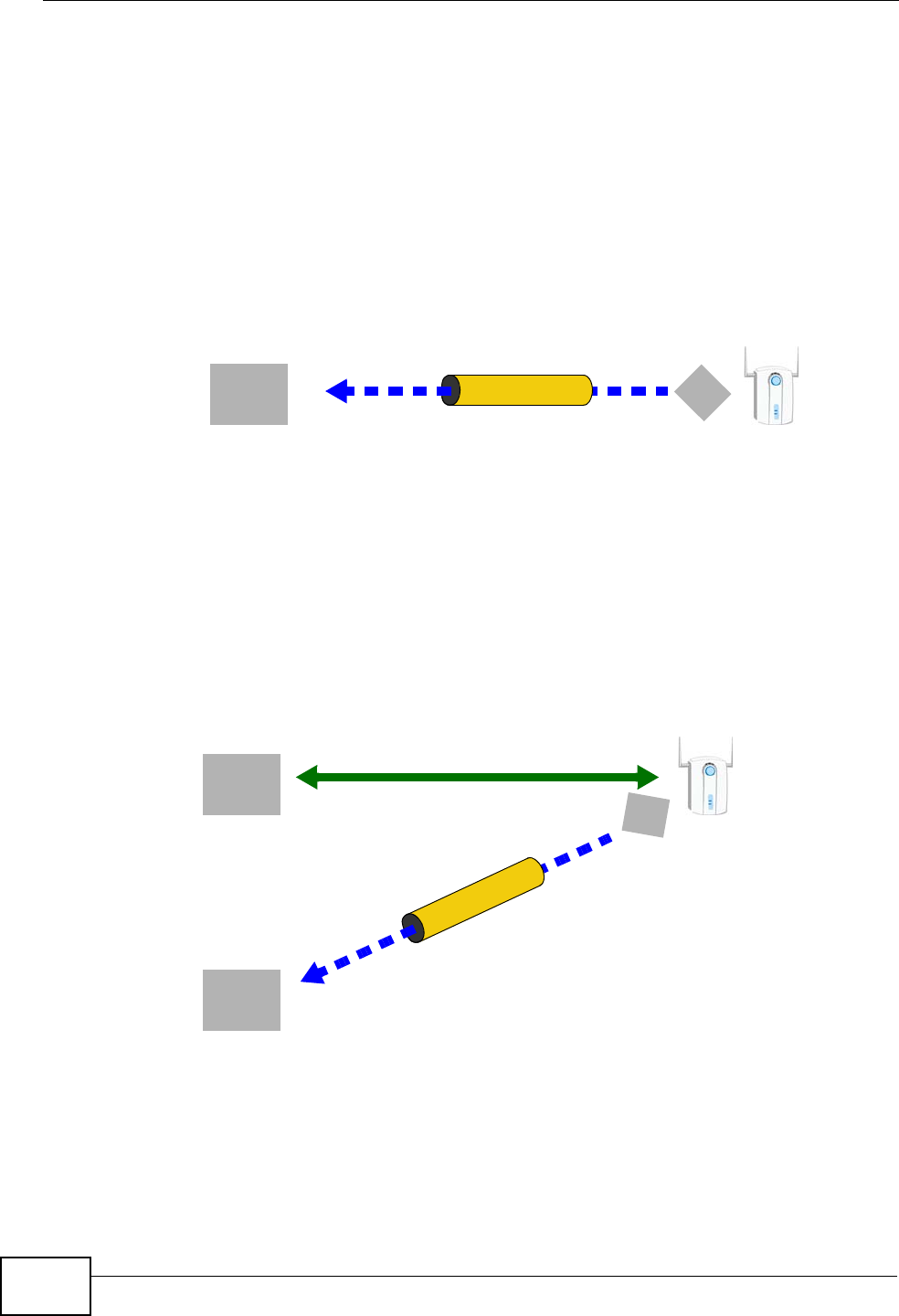
Chapter 8 Wireless LAN
IAD User’s Guide
98
8.10.4.4 Example WPS Network Setup
This section shows how security settings are distributed in an example WPS setup.
The following figure shows an example network. In step 1, both AP1 and Client 1
are unconfigured. When WPS is activated on both, they perform the handshake. In
this example, AP1 is the registrar, and Client 1 is the enrollee. The registrar
randomly generates the security information to set up the network, since it is
unconfigured and has no existing information.
Figure 39 WPS: Example Network Step 1
In step 2, you add another wireless client to the network. You know that Client 1
supports registrar mode, but it is better to use AP1 for the WPS handshake with
the new client since you must connect to the access point anyway in order to use
the network. In this case, AP1 must be the registrar, since it is configured (it
already has security information for the network). AP1 supplies the existing
security information to Client 2.
Figure 40 WPS: Example Network Step 2
In step 3, you add another access point (AP2) to your network. AP2 is out of
range of AP1, so you cannot use AP1 for the WPS handshake with the new access
REGISTRARENROLLEE
SECURITY INFO
CLIENT 1 AP1
REGISTRAR
CLIENT 1 AP1
ENROLLEE
CLIENT 2
EXISTING CONNECTION
SECURITY INFO
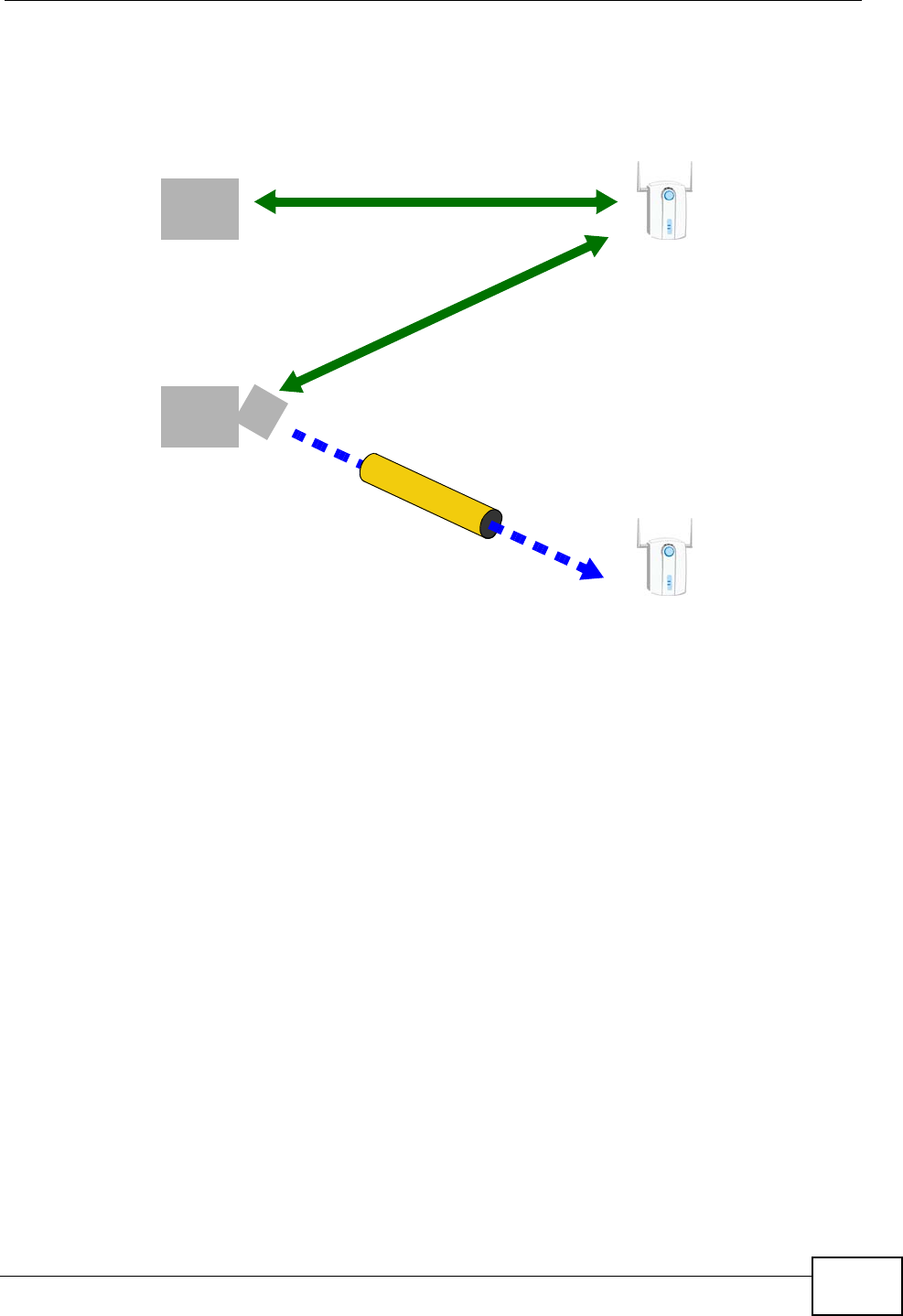
Chapter 8 Wireless LAN
IAD User’s Guide 99
point. However, you know that Client 2 supports the registrar function, so you use
it to perform the WPS handshake instead.
Figure 41 WPS: Example Network Step 3
8.10.4.5 Limitations of WPS
WPS has some limitations of which you should be aware.
• WPS works in Infrastructure networks only (where an AP and a wireless client
communicate). It does not work in Ad-Hoc networks (where there is no AP).
• When you use WPS, it works between two devices only. You cannot enroll
multiple devices simultaneously, you must enroll one after the other.
For instance, if you have two enrollees and one registrar you must set up the
first enrollee (by pressing the WPS button on the registrar and the first enrollee,
for example), then check that it successfully enrolled, then set up the second
device in the same way.
• WPS works only with other WPS-enabled devices. However, you can still add
non-WPS devices to a network you already set up using WPS.
WPS works by automatically issuing a randomly-generated WPA-PSK or WPA2-
PSK pre-shared key from the registrar device to the enrollee devices. Whether
the network uses WPA-PSK or WPA2-PSK depends on the device. You can check
the configuration interface of the registrar device to discover the key the
network is using (if the device supports this feature). Then, you can enter the
key into the non-WPS device and join the network as normal (the non-WPS
device must also support WPA-PSK or WPA2-PSK).
CLIENT 1 AP1
REGISTRAR
CLIENT 2
EXISTING CONNECTION
SECURITY INFO
ENROLLEE
AP2
EXISTING CONNECTION

Chapter 8 Wireless LAN
IAD User’s Guide
100
• When you use the PBC method, there is a short period (from the moment you
press the button on one device to the moment you press the button on the
other device) when any WPS-enabled device could join the network. This is
because the registrar has no way of identifying the “correct” enrollee, and
cannot differentiate between your enrollee and a rogue device. This is a possible
way for a hacker to gain access to a network.
You can easily check to see if this has happened. WPS works between only two
devices simultaneously, so if another device has enrolled your device will be
unable to enroll, and will not have access to the network. If this happens, open
the access point’s configuration interface and look at the list of associated
clients (usually displayed by MAC address). It does not matter if the access
point is the WPS registrar, the enrollee, or was not involved in the WPS
handshake; a rogue device must still associate with the access point to gain
access to the network. Check the MAC addresses of your wireless clients
(usually printed on a label on the bottom of the device). If there is an unknown
MAC address you can remove it or reset the AP.

IAD User’s Guide 101
CHAPTER 9
Network Address Translation
(NAT)
9.1 Overview
NAT (Network Address Translation - NAT, RFC 1631) is the translation of the IP
address of a host in a packet, for example, the source address of an outgoing
packet, used within one network to a different IP address known within another
network.
This chapter discusses how to configure NAT on the IAD.
See Section 9.6 on page 112 for advanced technical information on NAT.
9.1.1 What You Can Do in this Chapter
•Use the General screen (Section 9.2 on page 102) to configure the NAT setup
settings.
•Use the Port Forwarding screen (Section 9.3 on page 104) to configure
forward incoming service requests to the server(s) on your local network.
•Use the Address Mapping screen (Section 9.4 on page 108) to change your
IAD’s address mapping settings.
•Use the ALG screen (Section 9.5 on page 111) to enable and disable the SIP
(VoIP) ALG in the IAD.
9.1.2 What You Need To Know
Inside/Outside and Global/Local
Inside/outside denotes where a host is located relative to the IAD, for example,
the computers of your subscribers are the inside hosts, while the web servers on
the Internet are the outside hosts.
Global/local denotes the IP address of a host in a packet as the packet traverses a
router, for example, the local address refers to the IP address of a host when the

Chapter 9 Network Address Translation (NAT)
IAD User’s Guide
102
packet is in the local network, while the global address refers to the IP address of
the host when the same packet is traveling in the WAN side.
NAT
In the simplest form, NAT changes the source IP address in a packet received from
a subscriber (the inside local address) to another (the inside global address)
before forwarding the packet to the WAN side. When the response comes back,
NAT translates the destination address (the inside global address) back to the
inside local address before forwarding it to the original inside host.
Port Forwarding
A port forwarding set is a list of inside (behind NAT on the LAN) servers, for
example, web or FTP, that you can make visible to the outside world even though
NAT makes your whole inside network appear as a single computer to the outside
world.
SUA (Single User Account) Versus NAT
SUA (Single User Account) is a ZyNOS implementation of a subset of NAT that
supports two types of mapping, Many-to-One and Server. The IAD also supports
Full Feature NAT to map multiple global IP addresses to multiple private LAN IP
addresses of clients or servers using mapping types as outlined in Table 33 on
page 115.
• Choose SUA Only if you have just one public WAN IP address for your IAD.
• Choose Full Feature if you have multiple public WAN IP addresses for your IAD.
9.2 The NAT General Screen
Note: You must create a firewall rule in addition to setting up SUA/NAT, to allow traffic
from the WAN to be forwarded through the IAD.
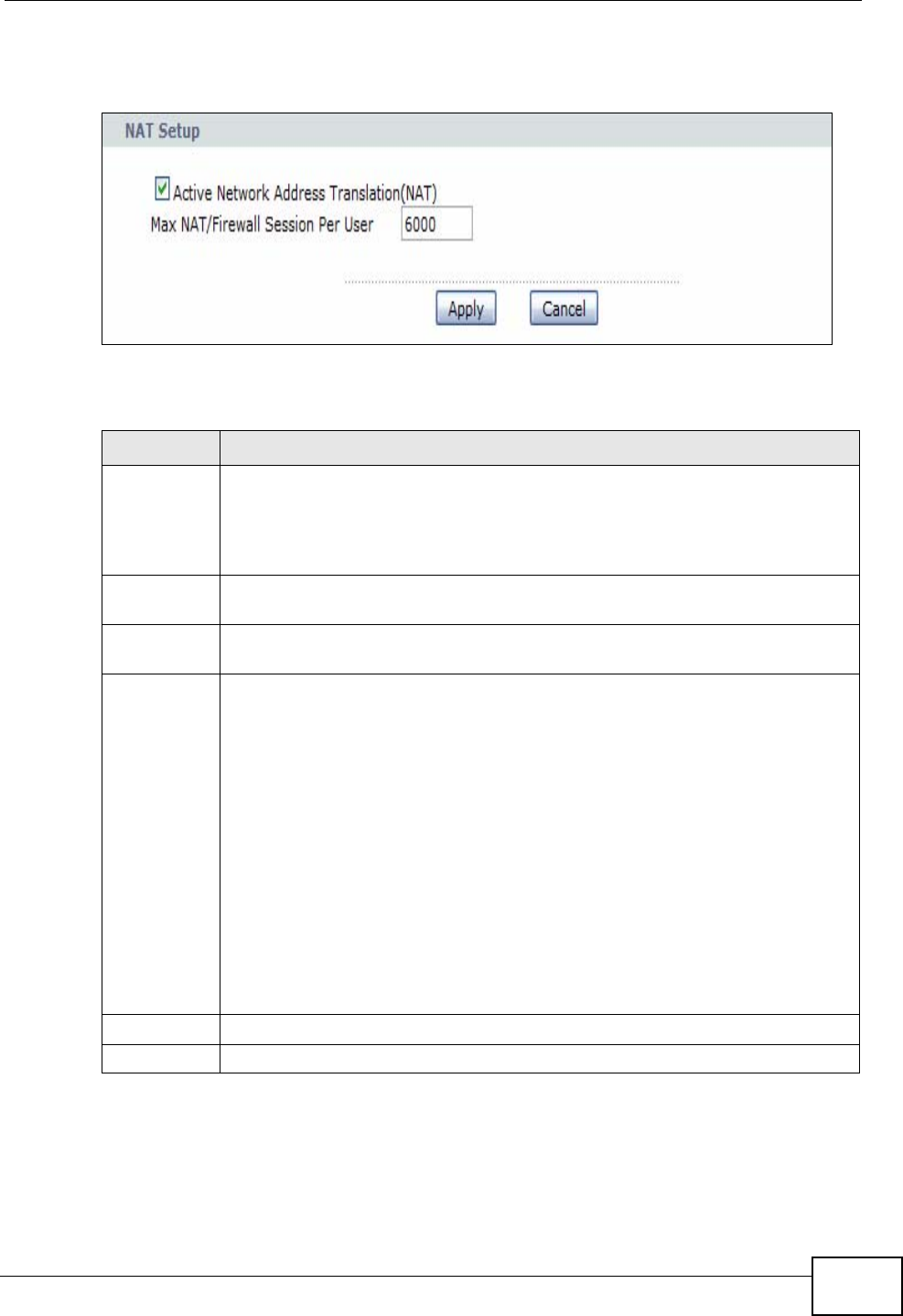
Chapter 9 Network Address Translation (NAT)
IAD User’s Guide 103
Click Network > NAT to open the following screen.
Figure 42 Network > NAT > General
The following table describes the labels in this screen.
Table 26 Network > NAT > General
LABEL DESCRIPTION
Active
Network
Address
Translation
(NAT)
Select this check box to enable NAT.
SUA Only Select this radio button if you have just one public WAN IP address for your
IAD.
Full Feature Select this radio button if you have multiple public WAN IP addresses for
your IAD.
Max NAT/
Firewall
Session Per
User
When computers use peer to peer applications, such as file sharing
applications, they need to establish NAT sessions. If you do not limit the
number of NAT sessions a single client can establish, this can result in all of
the available NAT sessions being used. In this case, no additional NAT
sessions can be established, and users may not be able to access the
Internet.
Each NAT session establishes a corresponding firewall session. Use this field
to limit the number of NAT/Firewall sessions client computers can establish
through the IAD.
If your network has a small number of clients using peer to peer
applications, you can raise this number to ensure that their performance is
not degraded by the number of NAT sessions they can establish. If your
network has a large number of users using peer to peer applications, you
can lower this number to ensure no single client is exhausting all of the
available NAT sessions.
Apply Click Apply to save your changes back to the IAD.
Cancel Click Cancel to reload the previous configuration for this screen.

Chapter 9 Network Address Translation (NAT)
IAD User’s Guide
104
9.3 The Port Forwarding Screen
Note: This screen is available only when you select SUA only in the NAT > General
screen.
Use the Port Forwarding screen to forward incoming service requests to the
server(s) on your local network.
You may enter a single port number or a range of port numbers to be forwarded,
and the local IP address of the desired server. The port number identifies a
service; for example, web service is on port 80 and FTP on port 21. In some
cases, such as for unknown services or where one server can support more than
one service (for example both FTP and web service), it might be better to specify
a range of port numbers. You can allocate a server IP address that corresponds to
a port or a range of ports.
The most often used port numbers and services are shown in Appendix F on page
313. Please refer to RFC 1700 for further information about port numbers.
Note: Many residential broadband ISP accounts do not allow you to run any server
processes (such as a Web or FTP server) from your location. Your ISP may
periodically check for servers and may suspend your account if it discovers any
active services at your location. If you are unsure, refer to your ISP.
Default Server IP Address
In addition to the servers for specified services, NAT supports a default server IP
address. A default server receives packets from ports that are not specified in this
screen.
Note: If you do not assign a Default Server IP address, the IAD discards all packets
received for ports that are not specified here or in the remote management
setup.
Configuring Servers Behind Port Forwarding (Example)
Let's say you want to assign ports 21-25 to one FTP, Telnet and SMTP server (A in
the example), port 80 to another (B in the example) and assign a default server IP
address of 192.168.1.35 to a third (C in the example). You assign the LAN IP
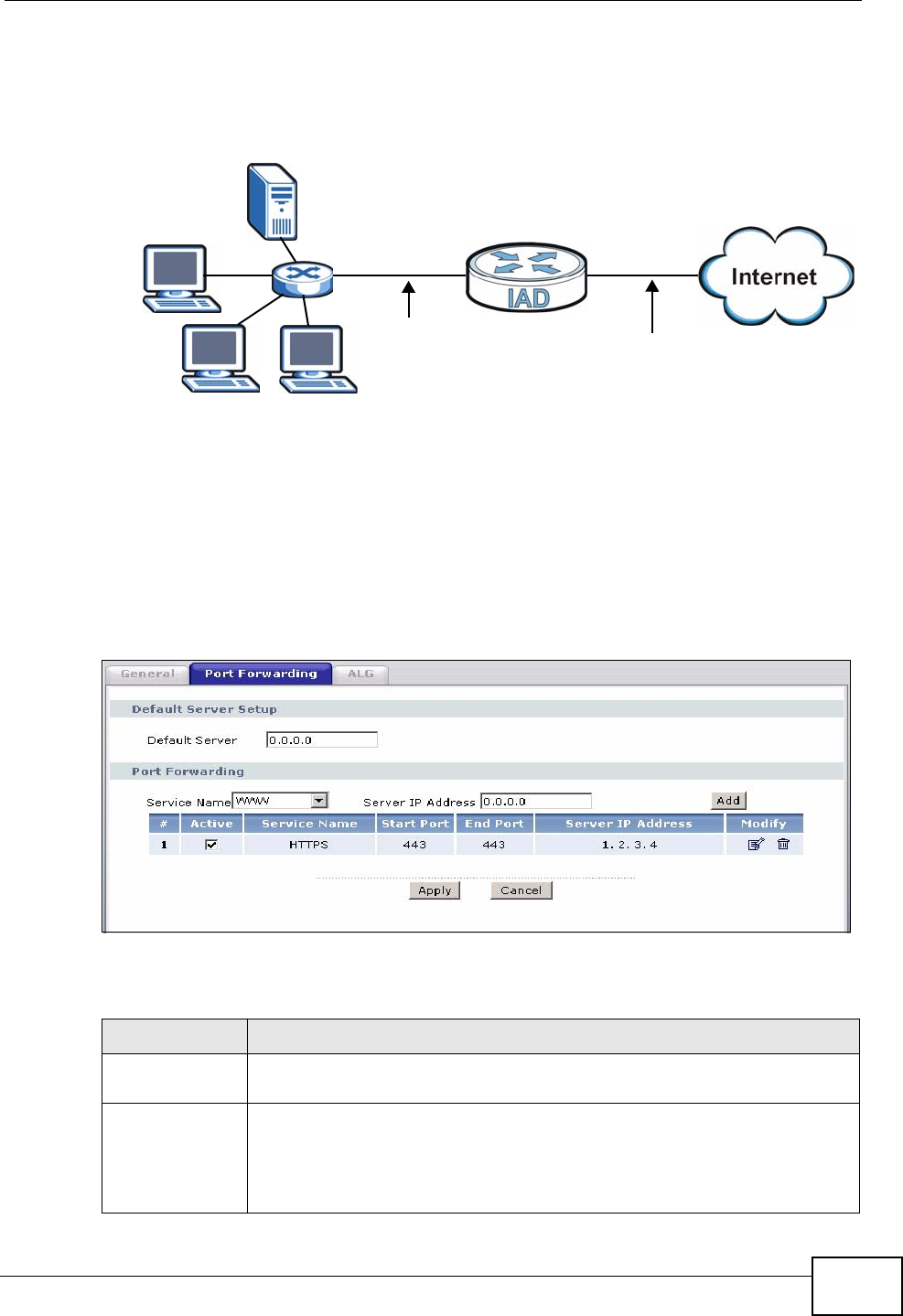
Chapter 9 Network Address Translation (NAT)
IAD User’s Guide 105
addresses and the ISP assigns the WAN IP address. The NAT network appears as a
single host on the Internet.
Figure 43 Multiple Servers Behind NAT Example
9.3.1 Configuring the Port Forwarding Screen
Click Network > NAT > Port Forwarding to open the following screen.
See Appendix F on page 313 for port numbers commonly used for particular
services.
Figure 44 Network > NAT > Port Forwarding
The following table describes the fields in this screen.
A=192.168.1.33
D=192.168.1.36
C=192.168.1.35
B=192.168.1.34
WAN
LAN
192.168.1.1 IP Address assigned by ISP
Table 27 Network > NAT > Port Forwarding
LABEL DESCRIPTION
Default Server
Setup
Default Server In addition to the servers for specified services, NAT supports a default
server. A default server receives packets from ports that are not
specified in this screen. If you do not assign a Default Server IP
address, the IAD discards all packets received for ports that are not
specified here or in the remote management setup.
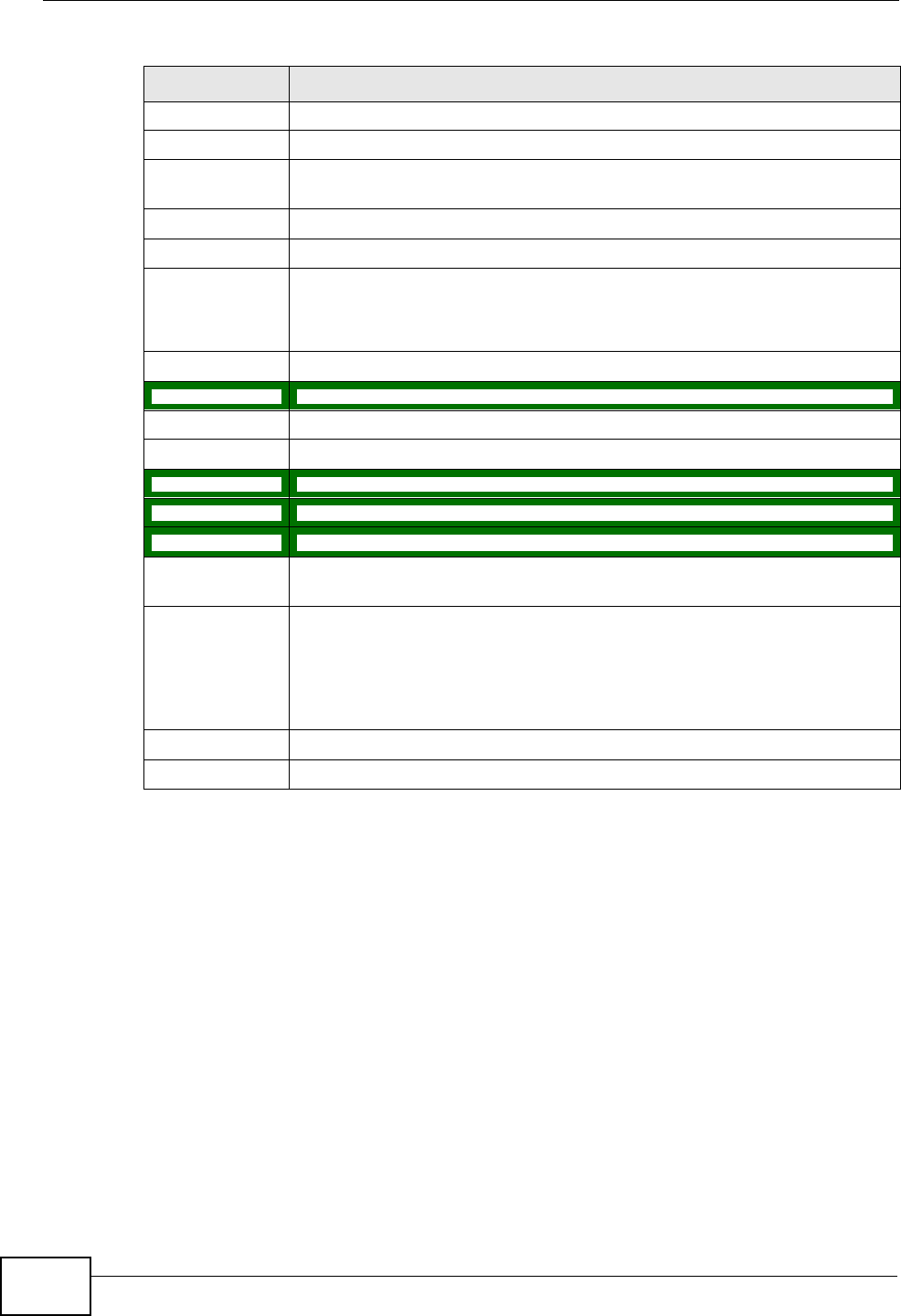
Chapter 9 Network Address Translation (NAT)
IAD User’s Guide
106
Port Forwarding
Service Name Select a service from the drop-down list box.
Server IP
Address Enter the IP address of the server for the specified service.
Add Click this button to add a rule to the table below.
#This is the rule index number (read-only).
Active This field indicates whether the rule is active or not.
Clear the check box to disable the rule. Select the check box to enable
it.
Service Name This is a service’s name.
Protocol This is the transport layer protocol used for the service.
Start Port This is the first external port number that identifies a service.
End Port This is the last external port number that identifies a service.
Port Translation
Start Port This is the first internal port number that identifies a service.
End Port This is the last internal port number that identifies a service.
Server IP
Address This is the server’s IP address.
Modify Click the edit icon to go to the screen where you can edit the port
forwarding rule.
Click the delete icon to delete an existing port forwarding rule. Note that
subsequent address mapping rules move up by one when you take this
action.
Apply Click Apply to save your changes back to the IAD.
Cancel Click Cancel to return to the previous configuration.
Table 27 Network > NAT > Port Forwarding
LABEL DESCRIPTION
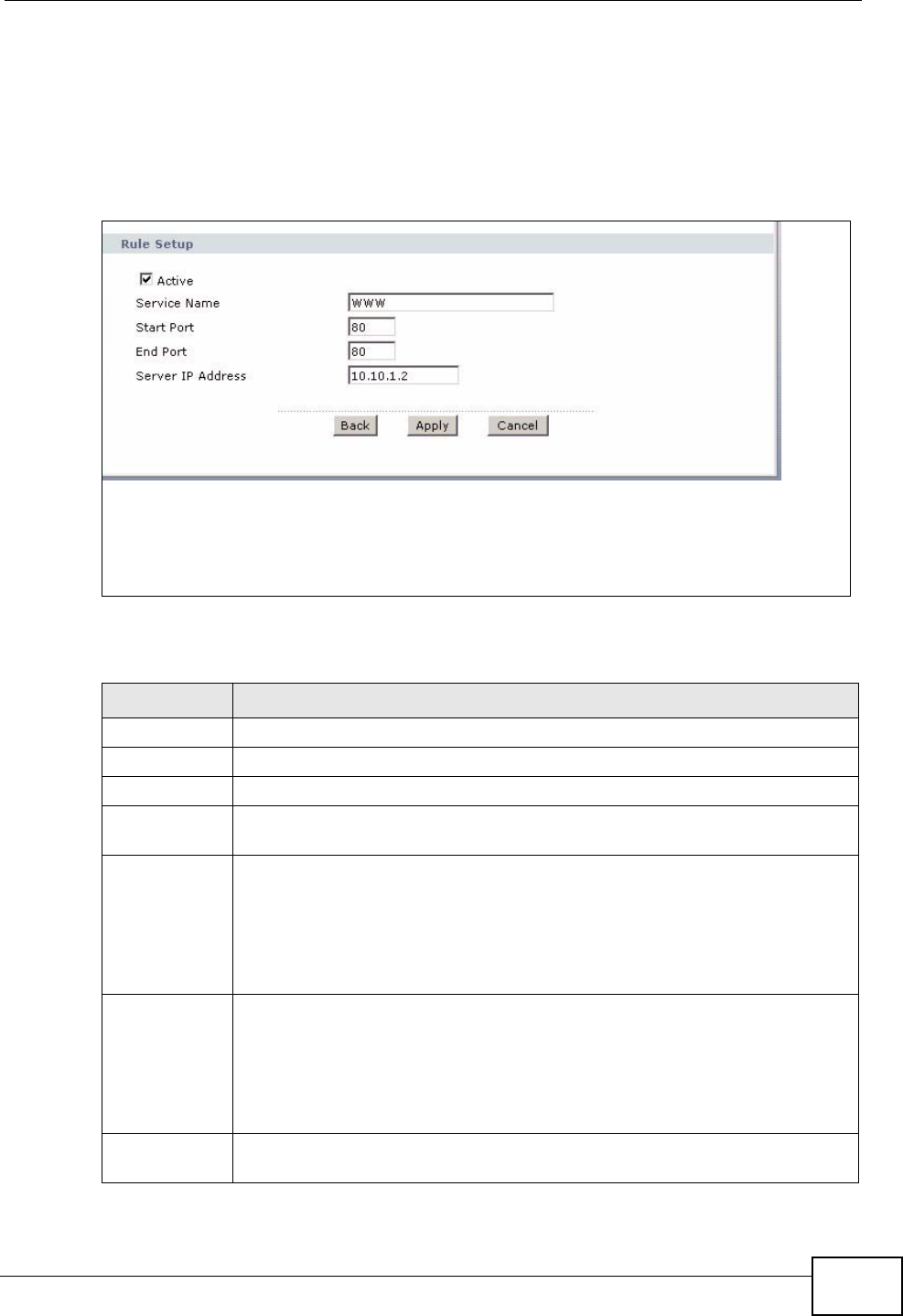
Chapter 9 Network Address Translation (NAT)
IAD User’s Guide 107
9.3.2 The Port Forwarding Rule Edit Screen
Use this screen to edit a port forwarding rule. Select User define in the Service
Name field of the Port Forwarding screen or click an existing rule’s edit icon in
the Port Forwarding screen to display the screen shown next.
Figure 45 Network > NAT > Port Forwarding: Edit
The following table describes the fields in this screen.
Table 28 Network > NAT > Port Forwarding: Edit
LABEL DESCRIPTION
Rule Setup
Active Click this check box to enable the rule.
Service Name Enter a name to identify this port-forwarding rule.
Protocol Select the transport layer protocol supported by this virtual server.
Choices are TCP, UDP, or ALL.
Start Port Enter the original destination port for the packets.
To forward only one port, enter the port number again in the End Port
field.
To forward a series of ports, enter the start port number here and the end
port number in the End Port field.
End Port Enter the last port of the original destination port range.
To forward only one port, enter the port number again in the Start Port
field above and then enter it again in this field.
To forward a series of ports, enter the last port number in a series that
begins with the port number in the Start Port field above.
Server IP
Address Enter the inside IP address of the server here.
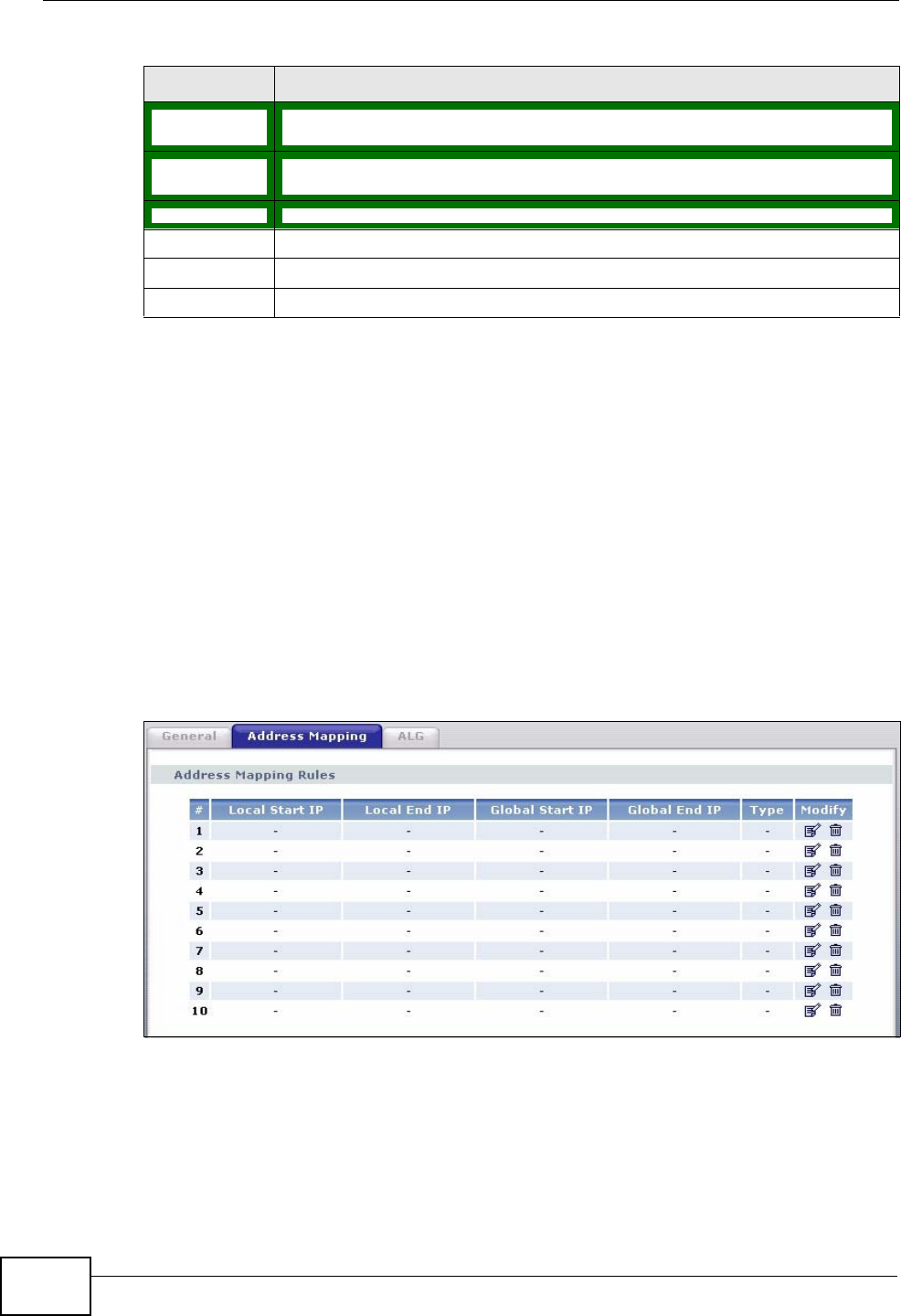
Chapter 9 Network Address Translation (NAT)
IAD User’s Guide
108
9.4 The Address Mapping Screen
Note: The Address Mapping screen is available only when you select Full Feature
in the NAT > General screen.
Ordering your rules is important because the IAD applies the rules in the order
that you specify. When a rule matches the current packet, the IAD takes the
corresponding action and the remaining rules are ignored.
To change your IAD’s address mapping settings, click Network > NAT >
Address Mapping to open the following screen.
Figure 46 Network > NAT > Address Mapping
Port
Translation Enter the port number here to which you want the IAD to translate the
incoming port.
Start Port For a range of ports, enter the first number of the range to which you
want the incoming ports translated.
End Port Enter the last port of the translated port range.
Back Click Back to return to the previous screen.
Apply Click Apply to save your changes back to the IAD.
Cancel Click Cancel to begin configuring this screen afresh.
Table 28 Network > NAT > Port Forwarding: Edit (continued)
LABEL DESCRIPTION

Chapter 9 Network Address Translation (NAT)
IAD User’s Guide 109
The following table describes the fields in this screen.
Table 29 Network > NAT > Address Mapping
LABEL DESCRIPTION
#This is the rule index number.
Local Start IP This is the starting Inside Local IP Address (ILA). Local IP addresses are -
for Server port mapping.
Local End IP This is the end Inside Local IP Address (ILA). If the rule is for all local IP
addresses, then this field displays 0.0.0.0 as the Local Start IP address
and 255.255.255.255 as the Local End IP address. This field is - for
One-to-one and Server mapping types.
Global Start
IP This is the starting Inside Global IP Address (IGA). This field is - here if
you have a dynamic IP address (0.0.0.0) from your ISP. You can only do
this for Many-to-One, one-to-one and Server mapping types.
Global End IP This is the ending Inside Global IP Address (IGA). This field is - for One-
to-one, Many-to-One and Server mapping types.
Type 1-1: One-to-one mode maps one local IP address to one global IP
address. Note that port numbers do not change for the One-to-one NAT
mapping type.
M-1: Many-to-One mode maps multiple local IP addresses to one global
IP address. This is equivalent to SUA (i.e., PAT, port address translation),
ZyXEL's Single User Account feature that previous ZyXEL routers
supported only.
M-M Ov (Overload): Many-to-Many Overload mode maps multiple local
IP addresses to shared global IP addresses.
MM No (No Overload): Many-to-Many No Overload mode maps each local
IP address to unique global IP addresses.
Server: This type allows you to specify inside servers of different
services behind the NAT to be accessible to the outside world.
Modify Click the edit icon to go to the screen where you can edit the address
mapping rule.
Click the delete icon to delete an existing address mapping rule. Note that
subsequent address mapping rules move up by one when you take this
action.
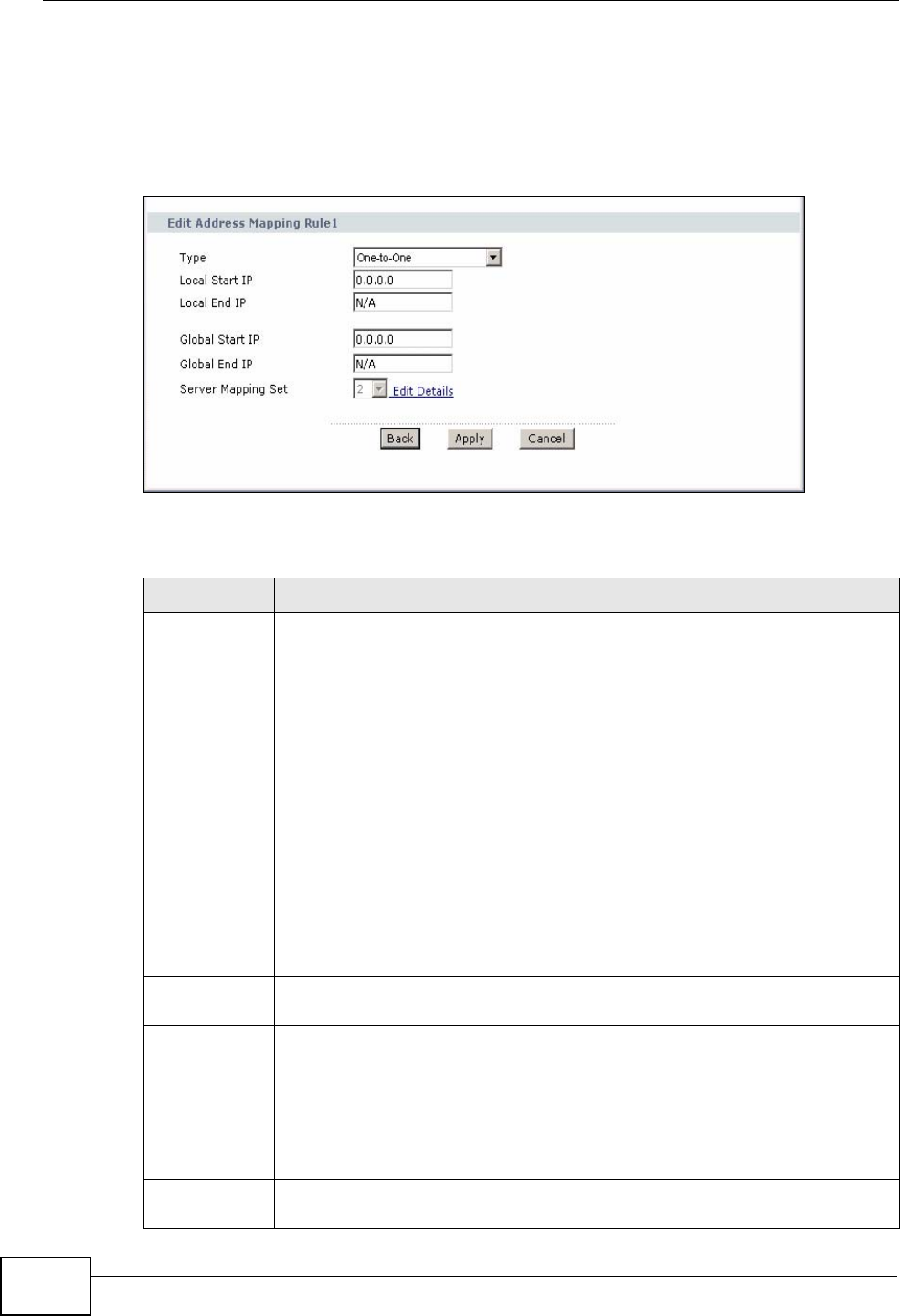
Chapter 9 Network Address Translation (NAT)
IAD User’s Guide
110
9.4.1 The Address Mapping Rule Edit Screen
To edit an address mapping rule, click the rule’s edit icon in the Address
Mapping screen to display the screen shown next.
Figure 47 Network > NAT > Address Mapping: Edit
The following table describes the fields in this screen.
Table 30 Network > NAT > Address Mapping: Edit
LABEL DESCRIPTION
Type Choose the port mapping type from one of the following.
One-to-One: One-to-One mode maps one local IP address to one global
IP address. Note that port numbers do not change for One-to-one NAT
mapping type.
Many-to-One: Many-to-One mode maps multiple local IP addresses to
one global IP address. This is equivalent to SUA (i.e., PAT, port address
translation), ZyXEL's Single User Account feature that previous ZyXEL
routers supported only.
Many-to-Many Overload: Many-to-Many Overload mode maps multiple
local IP addresses to shared global IP addresses.
Many-to-Many No Overload: Many-to-Many No Overload mode maps
each local IP address to unique global IP addresses.
Server: This type allows you to specify inside servers of different services
behind the NAT to be accessible to the outside world.
Local Start IP This is the starting local IP address (ILA). Local IP addresses are N/A for
Server port mapping.
Local End IP This is the end local IP address (ILA). If your rule is for all local IP
addresses, then enter 0.0.0.0 as the Local Start IP address and
255.255.255.255 as the Local End IP address.
This field is N/A for One-to-One and Server mapping types.
Global Start
IP This is the starting global IP address (IGA). Enter 0.0.0.0 here if you have
a dynamic IP address from your ISP.
Global End IP This is the ending global IP address (IGA). This field is N/A for One-to-
One, Many-to-One and Server mapping types.
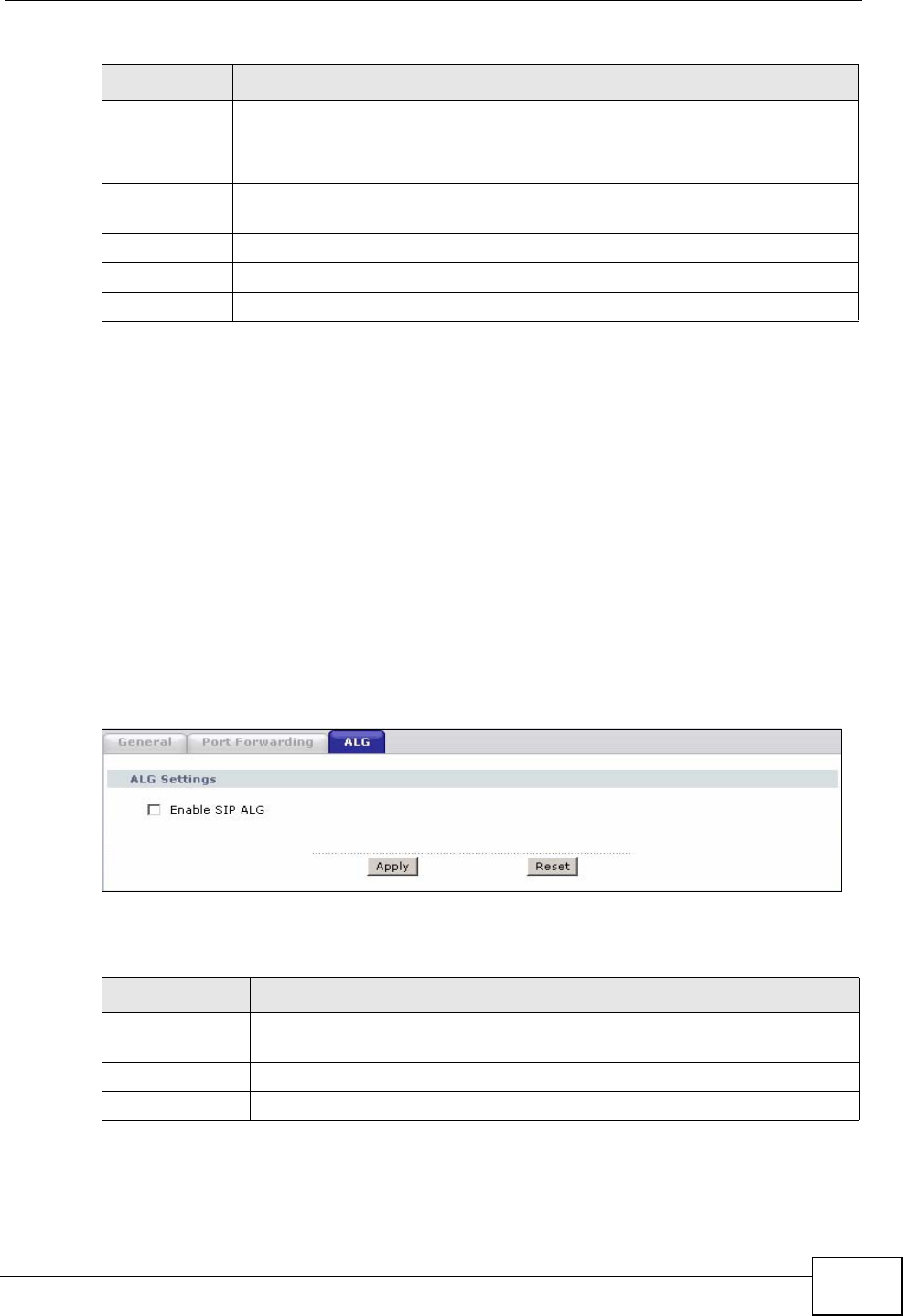
Chapter 9 Network Address Translation (NAT)
IAD User’s Guide 111
9.5 The ALG Screen
Some NAT routers may include a SIP Application Layer Gateway (ALG). A SIP ALG
allows SIP calls to pass through NAT by examining and translating IP addresses
embedded in the data stream. When the IAD registers with the SIP register server,
the SIP ALG translates the IAD’s private IP address inside the SIP data stream to a
public IP address. You do not need to use STUN or an outbound proxy if your IAD
is behind a SIP ALG.
Use this screen to enable and disable the SIP (VoIP) ALG in the IAD. To access this
screen, click Network > NAT > ALG.
Figure 48 Network > NAT > ALG
Each field is described in the following table.
Server
Mapping Set Only available when Type is set to Server.
Select a number from the drop-down menu to choose a port forwarding
set.
Edit Details Click this link to go to the Port Forwarding screen to edit a port
forwarding set that you have selected in the Server Mapping Set field.
Back Click Back to return to the previous screen.
Apply Click Apply to save your changes to the IAD.
Cancel Click Cancel to begin configuring this screen afresh.
Table 30 Network > NAT > Address Mapping: Edit (continued)
LABEL DESCRIPTION
Table 31 Network > NAT > ALG
LABEL DESCRIPTION
Enable SIP ALG Select this to make sure SIP (VoIP) works correctly with port-
forwarding and address-mapping rules.
Apply Click this to save your changes and to apply them to the IAD.
Reset Click this to return to previously saved configuration.
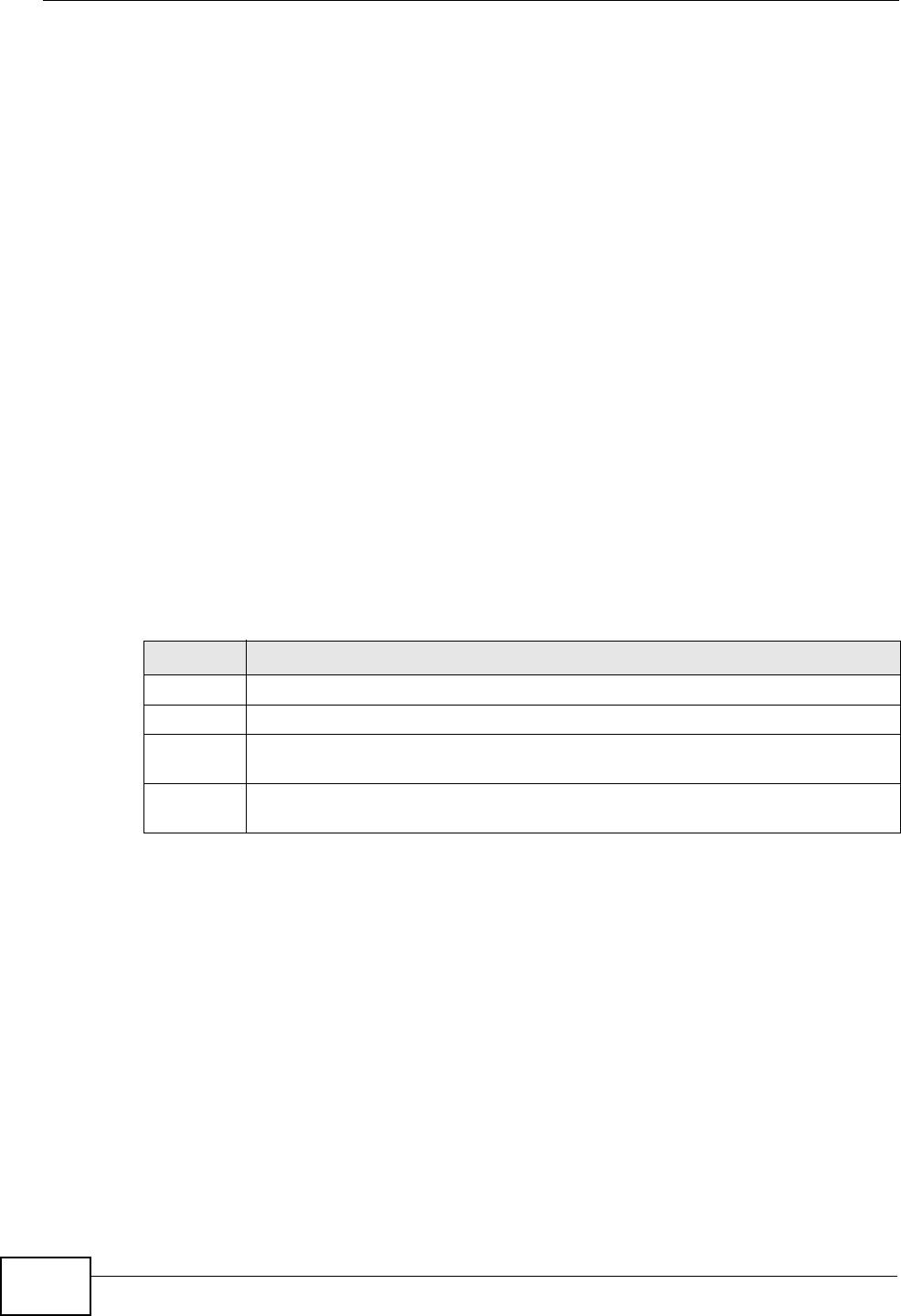
Chapter 9 Network Address Translation (NAT)
IAD User’s Guide
112
9.6 NAT Technical Reference
This chapter contains more information regarding NAT.
9.6.1 NAT Definitions
Inside/outside denotes where a host is located relative to the IAD, for example,
the computers of your subscribers are the inside hosts, while the web servers on
the Internet are the outside hosts.
Global/local denotes the IP address of a host in a packet as the packet traverses a
router, for example, the local address refers to the IP address of a host when the
packet is in the local network, while the global address refers to the IP address of
the host when the same packet is traveling in the WAN side.
Note that inside/outside refers to the location of a host, while global/local refers to
the IP address of a host used in a packet. Thus, an inside local address (ILA) is the
IP address of an inside host in a packet when the packet is still in the local
network, while an inside global address (IGA) is the IP address of the same inside
host when the packet is on the WAN side. The following table summarizes this
information.
NAT never changes the IP address (either local or global) of an outside host.
9.6.2 What NAT Does
In the simplest form, NAT changes the source IP address in a packet received from
a subscriber (the inside local address) to another (the inside global address)
before forwarding the packet to the WAN side. When the response comes back,
NAT translates the destination address (the inside global address) back to the
inside local address before forwarding it to the original inside host. Note that the
IP address (either local or global) of an outside host is never changed.
The global IP addresses for the inside hosts can be either static or dynamically
assigned by the ISP. In addition, you can designate servers, for example, a web
server and a telnet server, on your local network and make them accessible to the
Table 32 NAT Definitions
ITEM DESCRIPTION
Inside This refers to the host on the LAN.
Outside This refers to the host on the WAN.
Local This refers to the packet address (source or destination) as the packet travels
on the LAN.
Global This refers to the packet address (source or destination) as the packet travels
on the WAN.
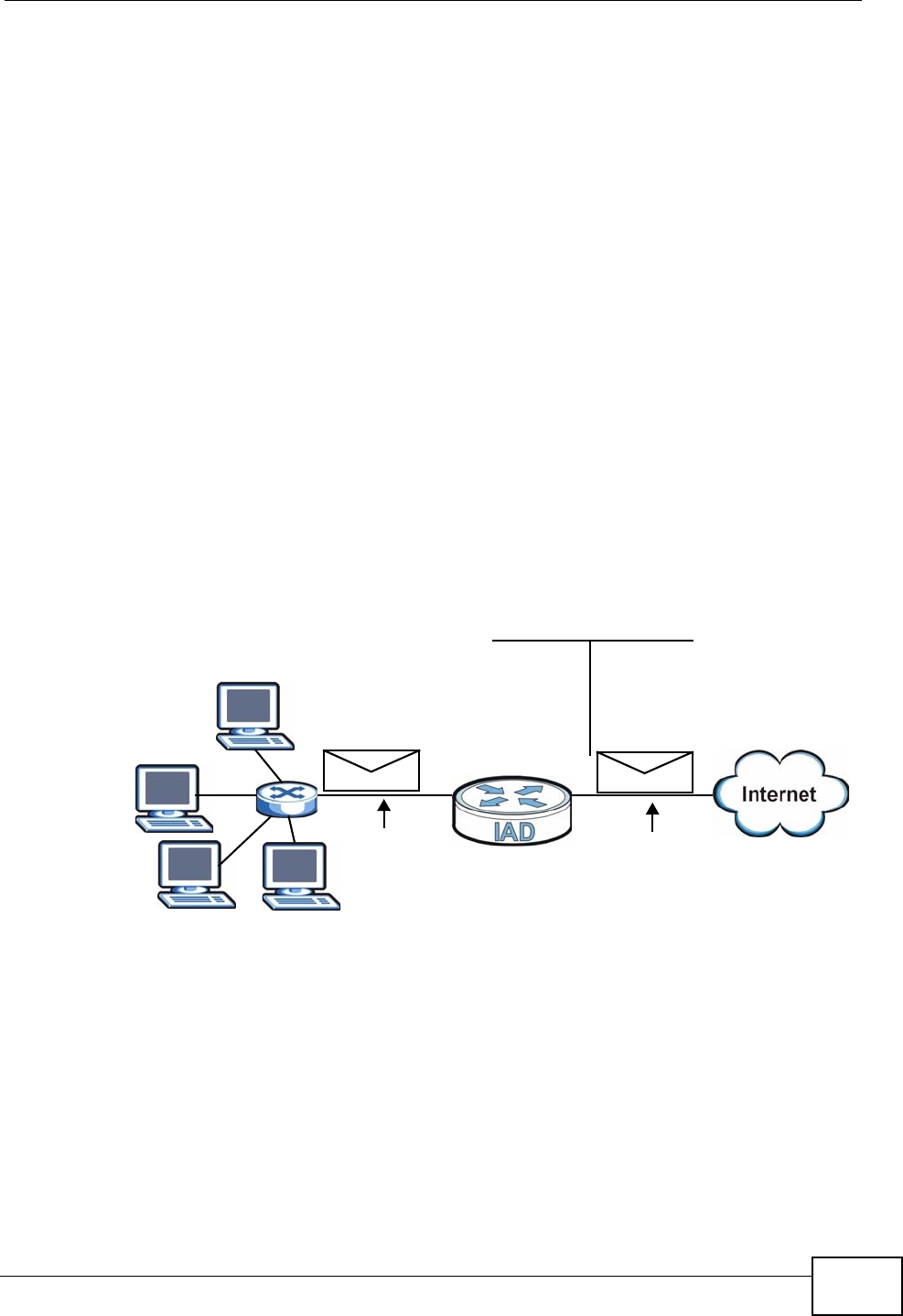
Chapter 9 Network Address Translation (NAT)
IAD User’s Guide 113
outside world. If you do not define any servers (for Many-to-One and Many-to-
Many Overload mapping – see Table 33 on page 115), NAT offers the additional
benefit of firewall protection. With no servers defined, your IAD filters out all
incoming inquiries, thus preventing intruders from probing your network. For
more information on IP address translation, refer to RFC 1631, The IP Network
Address Translator (NAT).
9.6.3 How NAT Works
Each packet has two addresses – a source address and a destination address. For
outgoing packets, the ILA (Inside Local Address) is the source address on the LAN,
and the IGA (Inside Global Address) is the source address on the WAN. For
incoming packets, the ILA is the destination address on the LAN, and the IGA is
the destination address on the WAN. NAT maps private (local) IP addresses to
globally unique ones required for communication with hosts on other networks. It
replaces the original IP source address (and TCP or UDP source port numbers for
Many-to-One and Many-to-Many Overload NAT mapping) in each packet and then
forwards it to the Internet. The IAD keeps track of the original addresses and port
numbers so incoming reply packets can have their original values restored. The
following figure illustrates this.
Figure 49 How NAT Works
192.168.1.13
192.168.1.10
192.168.1.11
192.168.1.12 SA
192.168.1.10
SA
IGA1
Inside Local
IP Address
192.168.1.10
192.168.1.11
192.168.1.12
192.168.1.13
Inside Global
IP Address
IGA 1
IGA 2
IGA 3
IGA 4
NAT Table WAN
LAN
Inside Local
Address (ILA) Inside Global
Address (IGA)
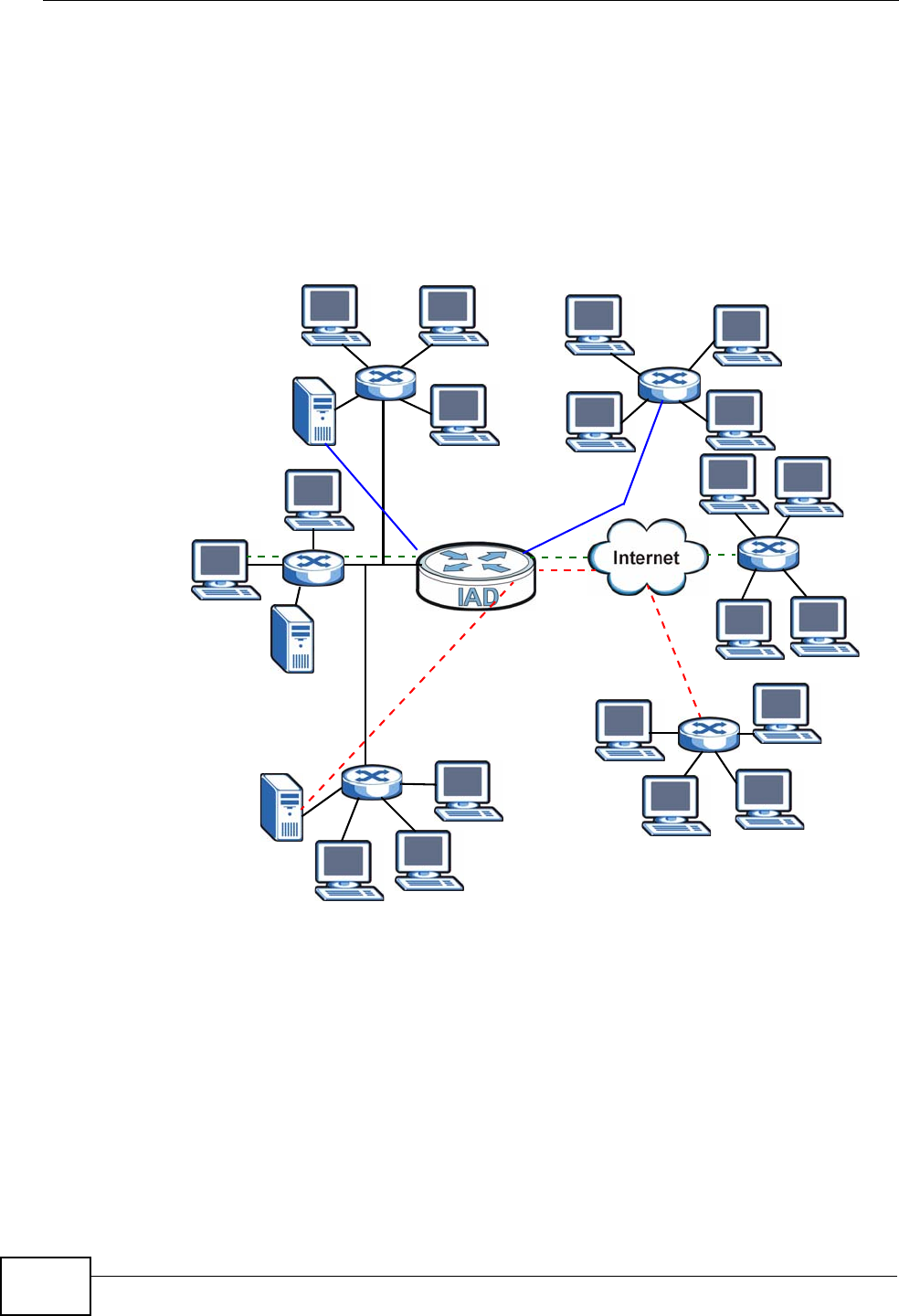
Chapter 9 Network Address Translation (NAT)
IAD User’s Guide
114
9.6.4 NAT Application
The following figure illustrates a possible NAT application, where three inside LANs
(logical LANs using IP alias) behind the IAD can communicate with three distinct
WAN networks.
Figure 50 NAT Application With IP Alias
9.6.5 NAT Mapping Types
NAT supports five types of IP/port mapping. They are:
•One to One: In One-to-One mode, the IAD maps one local IP address to one
global IP address.
•Many to One: In Many-to-One mode, the IAD maps multiple local IP addresses
to one global IP address. This is equivalent to SUA (for instance, PAT, port
address translation), ZyXEL’s Single User Account feature that previous ZyXEL
routers supported (the SUA Only option in today’s routers).
Corporation B
NAT Server
192.168.3.1
LAN3: 192.168.3.X
Network Server
“R&D”=192.168.3.1
WAN Addresses: LAN Addresses: (Default IPs)
IGA 1 ---------------> 192.168.1.1
IGA 2 ---------------> 192.168.2.1
IGA 3 ---------------> 192.168.3.1
NAT Server
192.168.2.1
LAN2: 192.168.2.X
Network Server
“Sales”=192.168.2.1
Server in
R&D Network
=IP3 (IGA 3)
NAT Server
192.168.1.1
LAN2: 192.168.1.X
Network Server
“Admin”=192.168.1.1
Corporation A
Server in
Sales Network
=IP2 (IGA 2)
Server in
Admin Network
=IP1 (IGA 1)

Chapter 9 Network Address Translation (NAT)
IAD User’s Guide 115
•Many to Many Overload: In Many-to-Many Overload mode, the IAD maps the
multiple local IP addresses to shared global IP addresses.
•Many-to-Many No Overload: In Many-to-Many No Overload mode, the IAD
maps each local IP address to a unique global IP address.
•Server: This type allows you to specify inside servers of different services
behind the NAT to be accessible to the outside world.
Port numbers do NOT change for One-to-One and Many-to-Many No Overload
NAT mapping types.
The following table summarizes these types.
9.6.6 Port Translation
The IAD can translate the destination port number or a range of port numbers of
packets coming from the WAN to another destination port number or range of port
numbers on the local network. When you use port forwarding without port
translation, a single server on the local network can use a specific port number
and be accessible to the outside world through a single WAN IP address. When
you use port translation with port forwarding, multiple servers on the local
network can use the same port number and still be accessible to the outside world
through a single WAN IP address.
Table 33 NAT Mapping Types
TYPE IP MAPPING
One-to-One ILA1ÅÆ IGA1
Many-to-One (SUA/PAT) ILA1ÅÆ IGA1
ILA2ÅÆ IGA1
…
Many-to-Many Overload ILA1ÅÆ IGA1
ILA2ÅÆ IGA2
ILA3ÅÆ IGA1
ILA4ÅÆ IGA2
…
Many-to-Many No Overload ILA1ÅÆ IGA1
ILA2ÅÆ IGA2
ILA3ÅÆ IGA3
…
Server Server 1 IPÅÆ IGA1
Server 2 IPÅÆ IGA1
Server 3 IPÅÆ IGA1
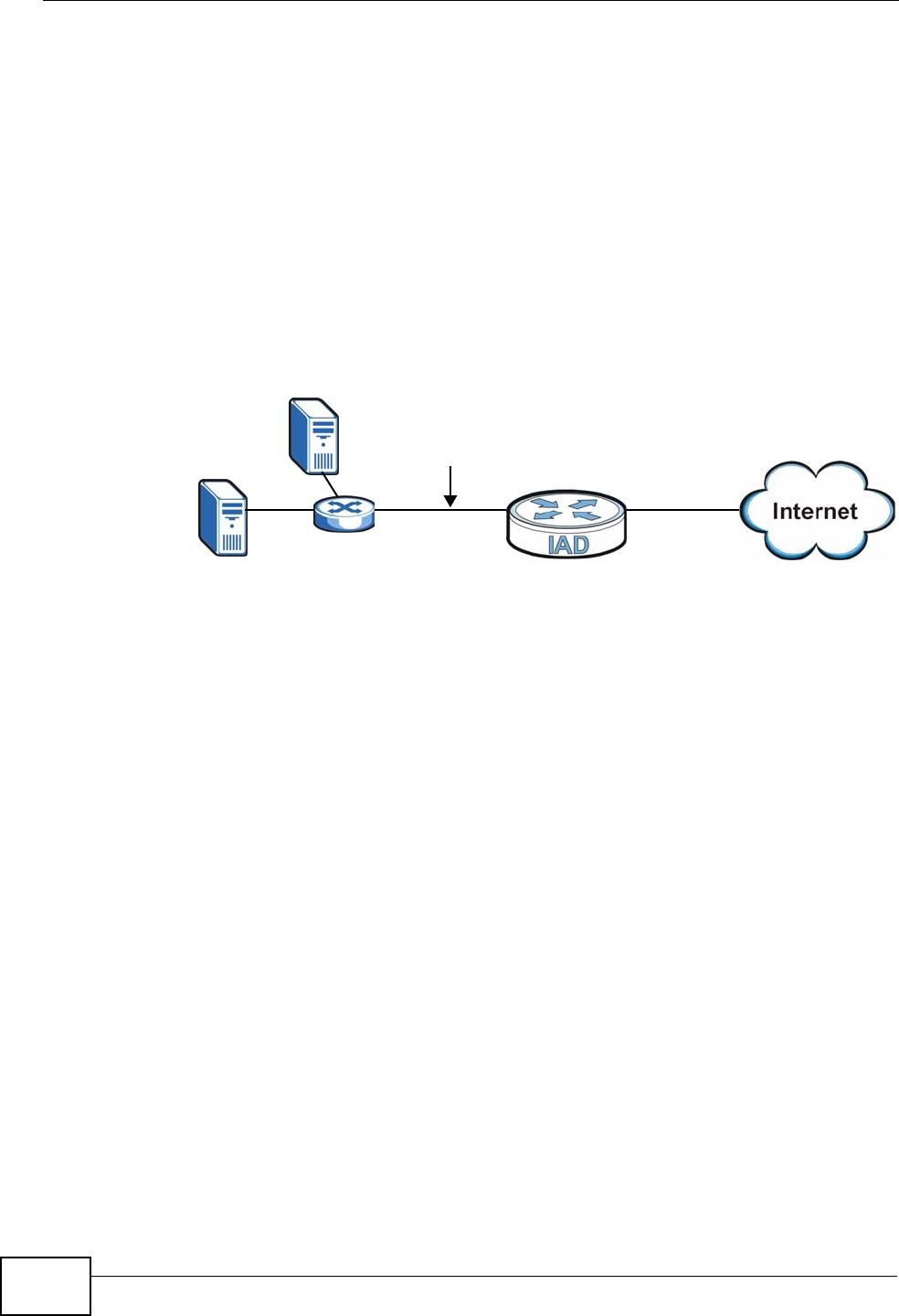
Chapter 9 Network Address Translation (NAT)
IAD User’s Guide
116
The following example has two web servers on a LAN. Server A uses IP address
192.168.1.33 and server B uses 192.168.1.34. Both servers use port 80. The
letters a.b.c.d represent the WAN port’s IP address. The IAD translates port 8080
of traffic received on the WAN port (IP address a.b.c.d) to port 80 and sends it to
server A (IP address 192.168.1.33). The IAD also translates port 8100 of traffic
received on the WAN port (also IP address a.b.c.d) to port 80, but sends it to
server B (IP address 192.168.1.34).
Note: In this example, anyone wanting to access server A from the Internet must use
port 8080. Anyone wanting to access server B from the Internet must use port
8100.
Figure 51 Port Translation Example
A=192.168.1.33
B=192.168.1.34
WAN
LAN
192.168.1.1
HTTP: 80
HTTP: 80 Port Translation
192.168.1.33: 80 <--------> a.b.c.d: 8080
192.168.1.34: 80 <--------> a.b.c.d: 8100

IAD User’s Guide 117
CHAPTER 10
Voice
10.1 Introduction
This chapter provides background information on VoIP and SIP and explains how
to configure your device’s voice settings.
VoIP is the sending of voice signals over Internet Protocol. This allows you to
make phone calls and send faxes over the Internet at a fraction of the cost of
using the traditional circuit-switched telephone network. You can also use servers
to run telephone service applications like PBX services and voice mail. Internet
Telephony Service Provider (ITSP) companies provide VoIP service.
Circuit-switched telephone networks require 64 kilobits per second (Kbps) in each
direction to handle a telephone call. VoIP can use advanced voice coding
techniques with compression to reduce the required bandwidth.
10.1.1 What You Need to Know
The following terms and concepts may help as you read through this chapter.
SIP
The Session Initiation Protocol (SIP) is an application-layer control (signaling)
protocol that handles the setting up, altering and tearing down of voice and
multimedia sessions over the Internet.
SIP signaling is separate from the media for which it handles sessions. The media
that is exchanged during the session can use a different path from that of the
signaling. SIP handles telephone calls and can interface with traditional circuit-
switched telephone networks.
SIP Identities
A SIP account uses an identity (sometimes referred to as a SIP address). A
complete SIP identity is called a SIP URI (Uniform Resource Identifier). A SIP
account's URI identifies the SIP account in a way similar to the way an e-mail
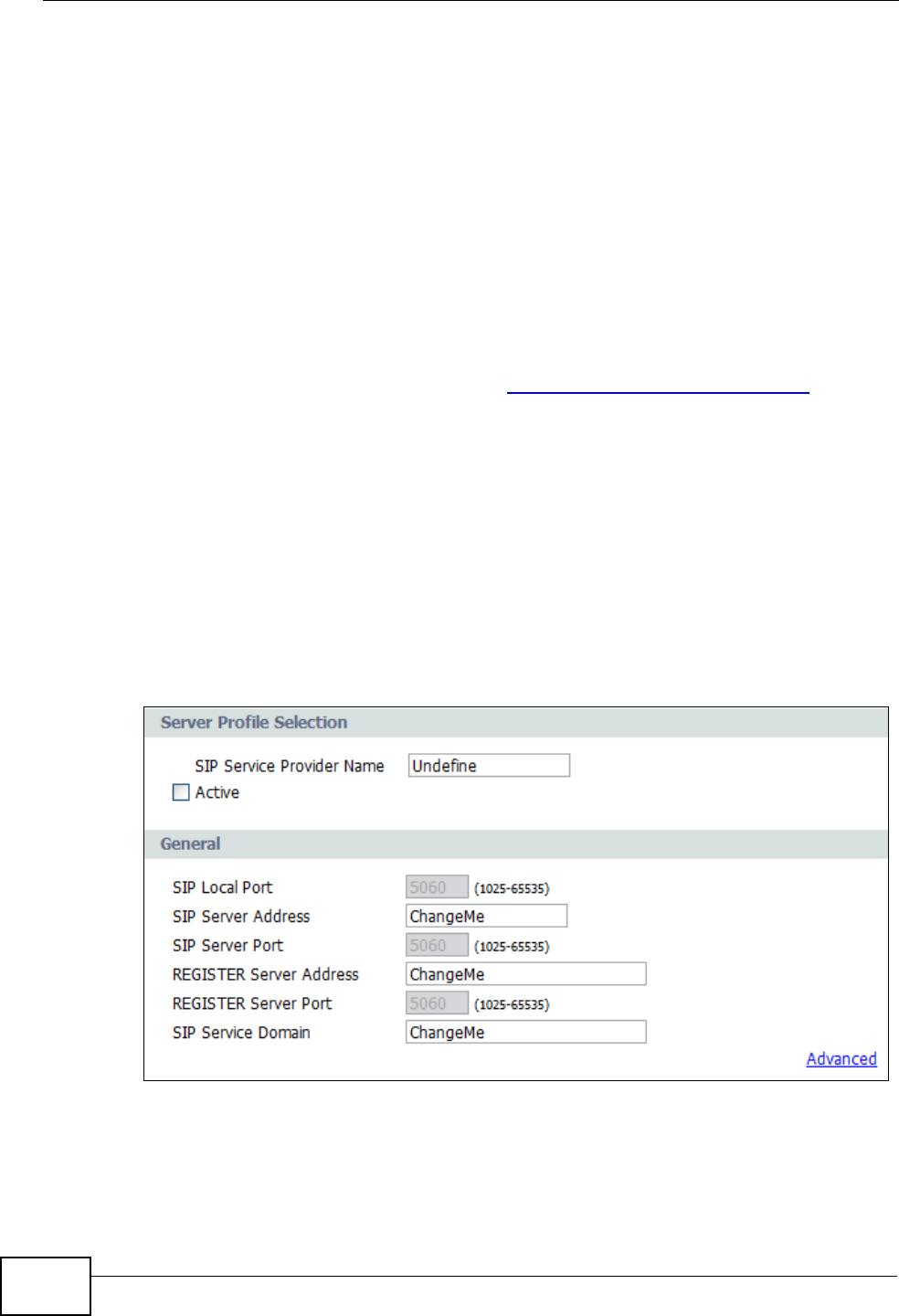
Chapter 10 Voice
IAD User’s Guide
118
address identifies an e-mail account. The format of a SIP identity is SIP-
Number@SIP-Service-Domain.
SIP Number
The SIP number is the part of the SIP URI that comes before the “@” symbol. A
SIP number can use letters like in an e-mail address (johndoe@your-ITSP.com for
example) or numbers like a telephone number (1122334455@VoIP-provider.com
for example).
SIP Service Domain
The SIP service domain of the VoIP service provider is the domain name in a SIP
URI. For example, if the SIP address is 1122334455@VoIP-provider.com, then
“VoIP-provider.com” is the SIP service domain.
10.2 SIP Service Provider
Use this screen to maintain basic information about each SIP account. Your VoIP
service provider (the company that lets you make phone calls over the Internet)
should provide this. You can also enable and disable each SIP account. To access
this screen, click VoIP > SIP.
Figure 52 VoIP > SIP > SIP Service Provider

Chapter 10 Voice
IAD User’s Guide 119
Each field is described in the following table.
Table 34 VoIP > SIP > SIP Service Provider
LABEL DESCRIPTION
Server Profile
Selection
SIP Service
Provider
Name
Enter your SIP service provider’s name, using up to 256 printable
English-keyboard characters.
Active Select this to make use these settings for all SIP phone calls.
General
SIP Local
Port Enter the IAD’s listening port number, if your VoIP service provider gave
you one. Otherwise, keep the default value.
SIP Server
Address Enter the IP address or domain name of the SIP server provided by
your VoIP service provider. You can use up to 32 printable English key-
board characters. It does not matter whether the SIP server is a proxy,
redirect or register server.
SIP Server
Port Enter the SIP server’s listening port number, if your VoIP service pro-
vider gave you one. Otherwise, keep the default value.
REGISTER
Server
Address
Enter the IP address or domain name of the SIP register server, if your
VoIP service provider gave you one. Otherwise, enter the same address
you entered in the SIP Server Address field. You can use up to 32
printable English keyboard characters.
REGISTER
Server Port Enter the SIP register server’s listening port number, if your VoIP ser-
vice provider gave you one. Otherwise, enter the same port number
you entered in the SIP Server Port field.
SIP Service
Domain Enter the SIP service domain name. In the full SIP URI, this is the part
after the @ symbol. You can use up to 32 printable English keyboard
characters.
Apply Click this to save your changes.
Cancel Click this to exit the screen without saving any changes.
Advanced Setup Click this to edit the advanced settings for this SIP account. The
Advanced SIP Settings screen appears.
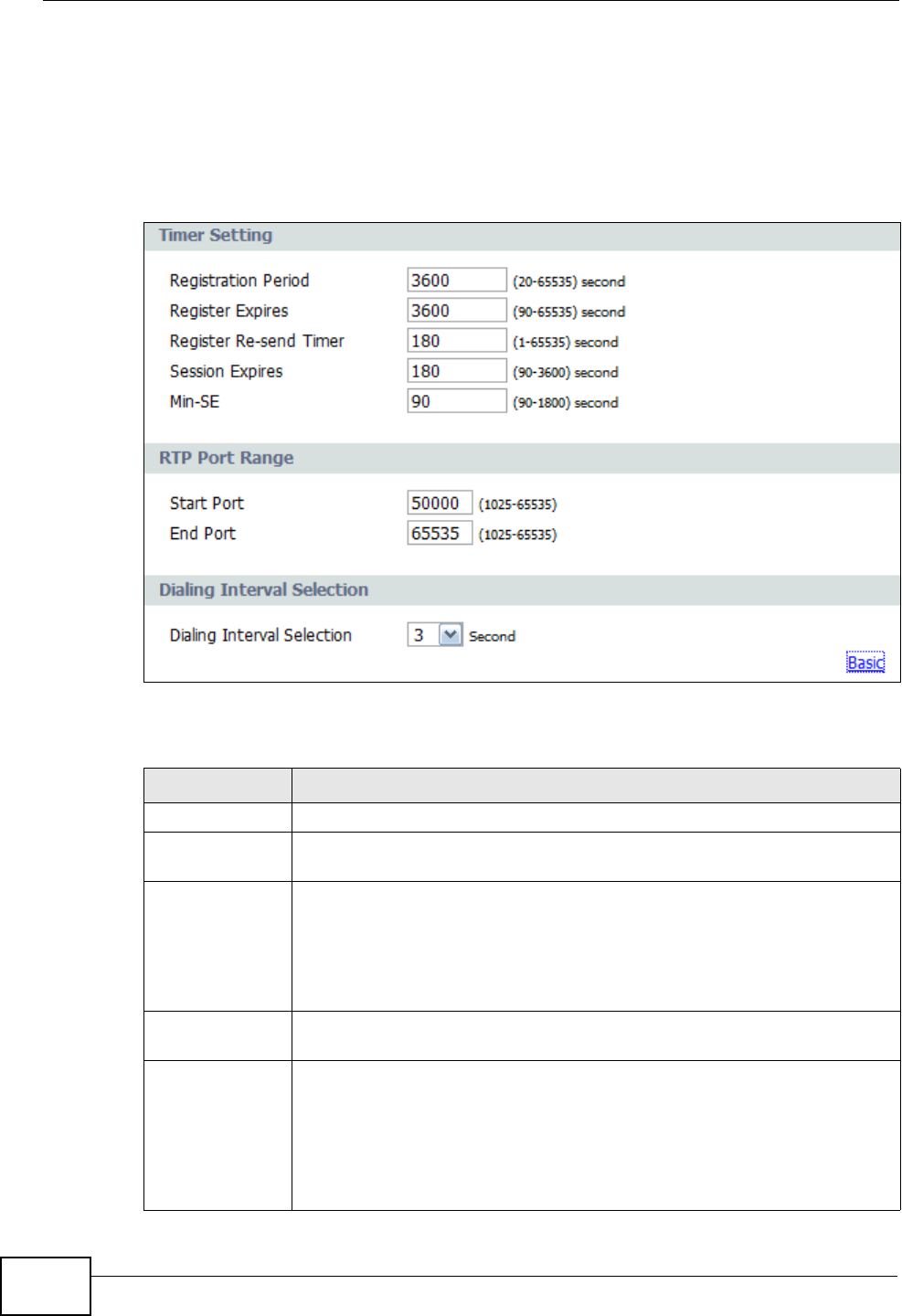
Chapter 10 Voice
IAD User’s Guide
120
10.2.1 Advanced SIP Settings
Use this screen to maintain advanced settings for each SIP account. Click
Advanced in VoIP > SIP > SIP Service Provider. The following screen
displays.
Figure 53 SIP Service Provider > Advanced
Each field is described in the following table.
Table 35 SIP Service Provider > Advanced
LABEL DESCRIPTION
Timer Settings
Registration
Period Enter the number of seconds allocated for the IAD to register with a SIP
service.
Register
Expires Enter the number of seconds your SIP account is registered with the
SIP register server before the registration is downgraded to ‘inactive’
and all SIP functions for the account are blocked. The IAD automatically
tries to re-register your SIP account when one-half of this time has
passed. (The SIP register server might have a different expiration,
which takes priority over this setting.)
Register Re-
send timer Enter the number of seconds the IAD waits before it tries again to
register the SIP account, if the first try failed or if there is no response.
Session
Expires Enter the number of seconds the SIP server waits for a ‘keep alive’
signal from the IAD before disconnecting the call. The keep alive signal
is periodically sent from the IAD during a call as long as the connection
between it and the server remains constant. If interference happens
somewhere along the line, or the connection is unexpectedly
terminated, then the SIP server uses this setting as a timer to
automatically disconnect the call.

Chapter 10 Voice
IAD User’s Guide 121
Min-SE Enter the minimum number of seconds the IAD accepts for a session
expiration time when it receives a request to start a SIP session. If the
request has a shorter time, the IAD rejects it.
RTP Port Range
Start Port
End Port Enter the listening port number(s) for RTP traffic, if your VoIP service
provider gave you this information. Otherwise, keep the default values.
To enter one port number, enter the port number in the Start Port and
End Port fields.
To enter a range of ports,
• enter the port number at the beginning of the range in the Start
Port field
• enter the port number at the end of the range in the End Port field.
Dialing Interval
Selection
Dialing
Interval
Selection
Select the number of seconds the IAD waits before placing a dialed call.
Apply Click this to save your changes.
Cancel Click this to exit the screen without saving any changes.
Basic Click this to return to the basic SIP Settings screen without saving
your changes.
Table 35 SIP Service Provider > Advanced (continued)
LABEL DESCRIPTION
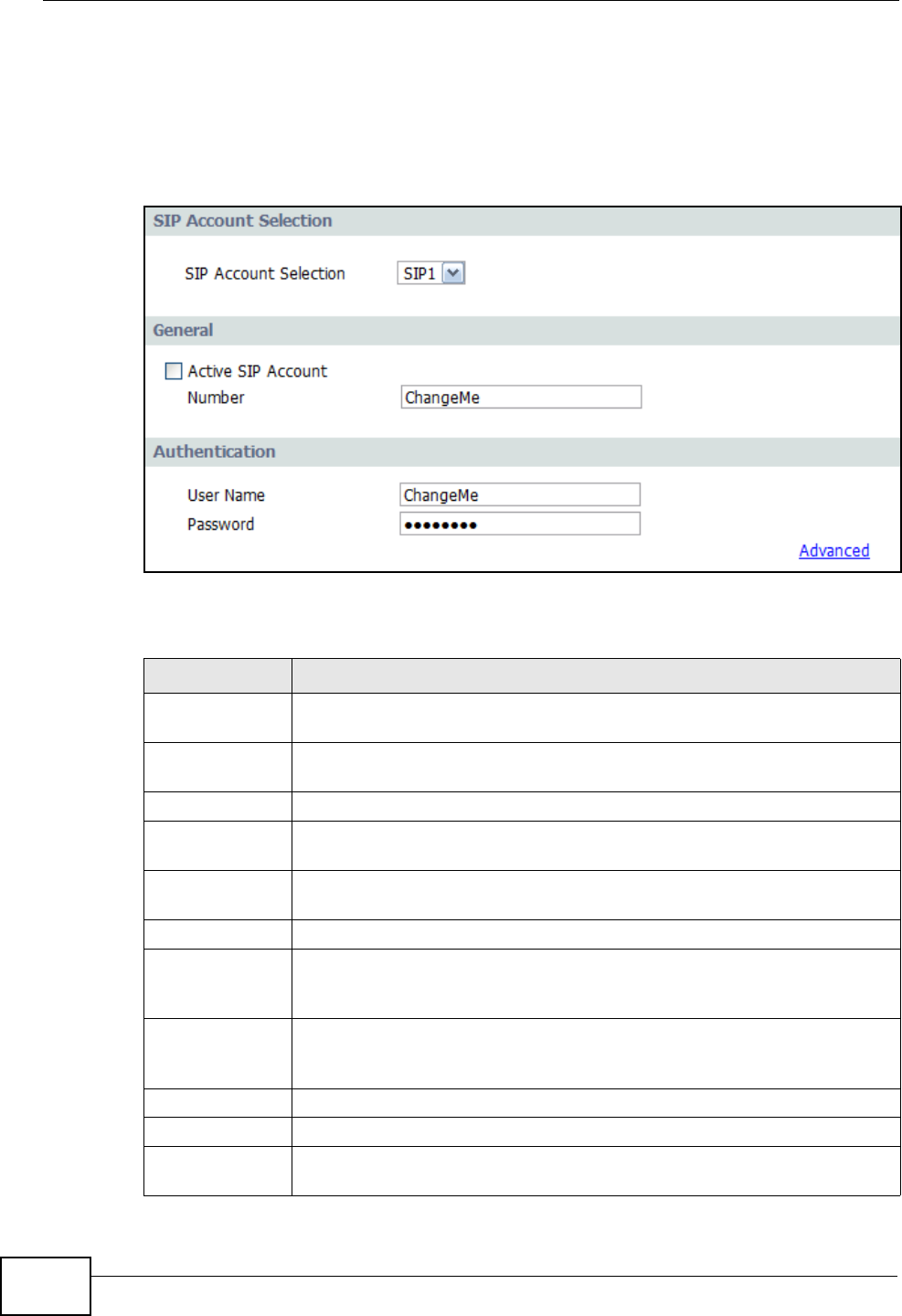
Chapter 10 Voice
IAD User’s Guide
122
10.3 SIP Account
Use this screen to set up your basic SIP account information. Click VoIP > SIP >
SIP Account to display this screen.
Figure 54 VoIP > SIP > SIP Account
Each field is described in the following table.
Table 36 VoIP > SIP > SIP Account
LABEL DESCRIPTION
SIP Account
Selection
SIP Account Select the SIP account you want to see in this screen. If you change this
field, the screen automatically refreshes.
General
Active SIP
Account Select this if you want the IAD to use this account. Clear it if you do not
want the IAD to use this account.
Number Enter your SIP number. In the full SIP URI, this is the part before the @
symbol. You can use up to 50 printable English keyboard characters.
Authentication
User Name Enter the user name for registering this SIP account, exactly as it was
given to you. You can use up to 20 printable English keyboard charac-
ters.
Password Enter the user name for registering this SIP account, exactly as it was
given to you. You can use up to 20 printable English keyboard charac-
ters.
Apply Click this to save your changes.
Cancel Click this to exit the screen without saving any changes.
Advanced Click this to edit the advanced settings for this SIP account. The
Advanced SIP Account Settings screen appears.
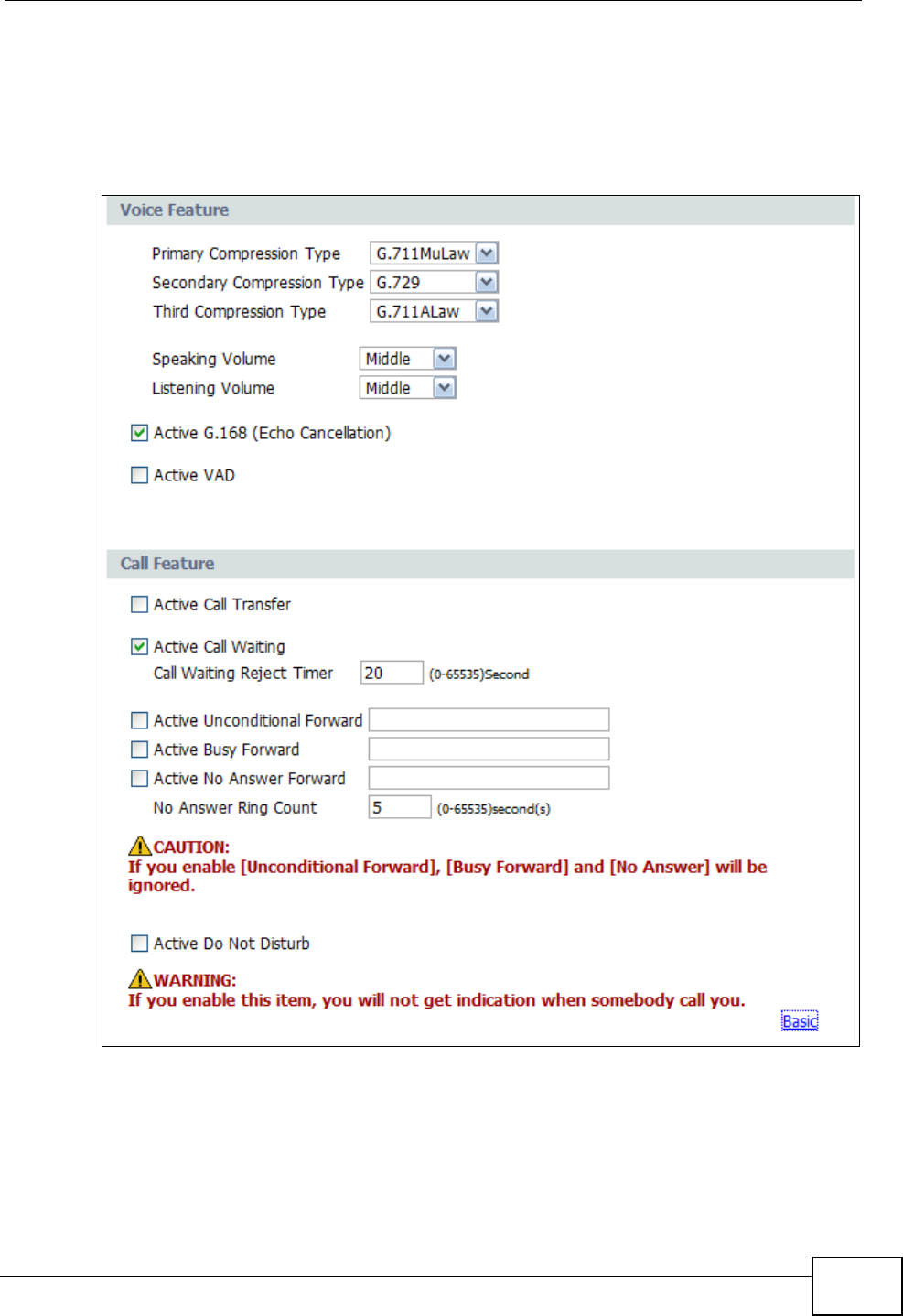
Chapter 10 Voice
IAD User’s Guide 123
10.3.1 Advanced Account Settings
Use this screen to maintain advanced settings for each SIP account. Click
Advanced in VoIP > SIP > SIP Account. The following screen displays.
Figure 55 SIP Account > Advanced

Chapter 10 Voice
IAD User’s Guide
124
Each field is described in the following table.
Table 37 SIP Account > Advanced
LABEL DESCRIPTION
Voice Feature
Primary
Compression
Type
Select the type of voice coder/decoder (codec) that you want the
IAD to use.
G.711 provides high voice quality but requires more bandwidth
(64 kbps).
•G.711A is typically used in Europe.
•G.711u is typically used in North America and Japan.
•G.729 operates at 8 kbps and is often the codec of choice for
VoIP because of its low bandwidth requirements.
The IAD must use the same codec as the peer. When two SIP
devices start a SIP session, they must agree on a codec.
Secondary
Compression
Type
Select the IAD’s second choice for voice coder/decoder.
Third
Compression
Type
Select the IAD’s third choice for voice coder/decoder.
Active G.168
(Echo
Cancellation)
Select this if you want to eliminate the echo caused by the sound
of your voice reverberating in the telephone receiver while you
talk.
Active VAD Select this if the IAD should transmit smaller packets when you
are not speaking. This reduces the bandwidth used.
Call Feature Call features are described in detail in Chapter 11 on page 129.
Active Call Transfer Select this to enable the call transfer feature.
Active Call Waiting Select this to enable the call waiting feature.
Call Waiting
Reject Timer Enter the number of seconds for call waiting to stay engaged
before disconnecting the caller.
Active Unconditional
Forward Select this, then enter a phone number to which incoming calls are
forwarded.
Active Busy Forward Select this, then enter a phone number to which calls are
forwarded when your phone is off the hook.
Active No Answer
Forward Select this, then enter a phone number to which calls are
forwarded when the phone is not answered.
No Answer Ring
Count Enter the number of rings the IAD waits before forwarding
unanswered calls.
Active Do Not
Disturb Select this to enable the DND feature.
Apply Click this to save your changes.
Cancel Click this to exit the screen without saving any changes.
Basic Click this to return to the basic SIP Account screen without
saving your changes.
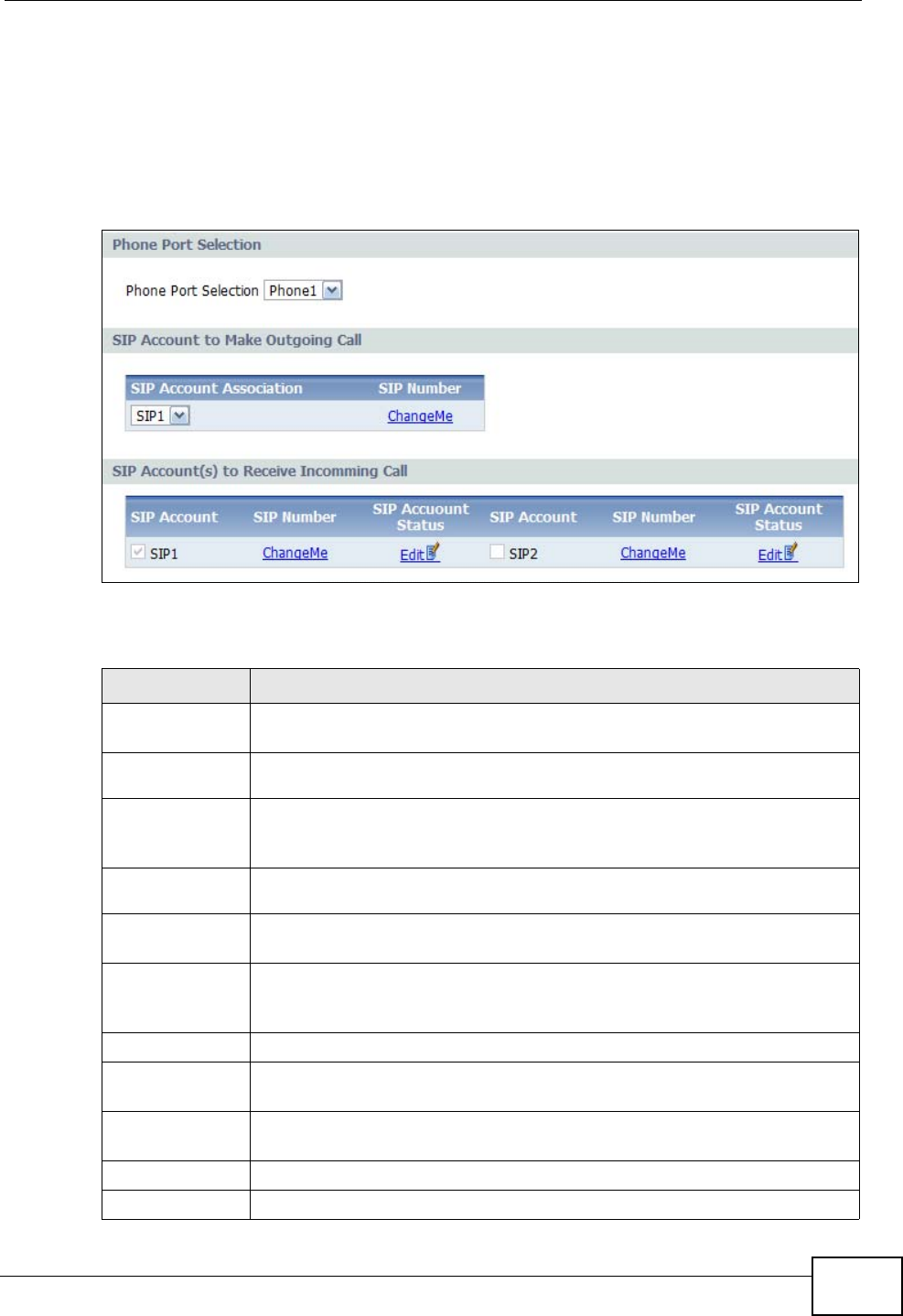
Chapter 10 Voice
IAD User’s Guide 125
10.4 Analog Phone
Use this screen to link the IAD’s analog phone ports with one or more SIP
accounts to handle outgoing and incoming calls. Click VoIP > Phone. The
following screen displays.
Figure 56 Phone > Analog Phone
Each field is described in the following table.
Table 38 Phone > Analog Phone
LABEL DESCRIPTION
Phone Port
Selection
Phone Port
Selection Select a phone port to configure on this screen.
SIP Account to
Make Outgoing
Call
SIP Account
Association Select a SIP account for all outgoing calls on this port to use.
SIP Number Indicates the SIP number associated with this account. Click it to open
the SIP Account screen, where you can enter a new number.
SIP Account(s)
to Receive
Incoming Calls
SIP Account This indicates the SIP account.
SIP Number This indicates the SIP account’s number. You can click it to open the
SIP Account screen, where you can change it.
SIP Account
Status This indicates whether the account is active or not. Click it to open the
SIP Account screen, where you can change the status.
Apply Click this to save your changes.
Cancel Click this to exit the screen without saving any changes.
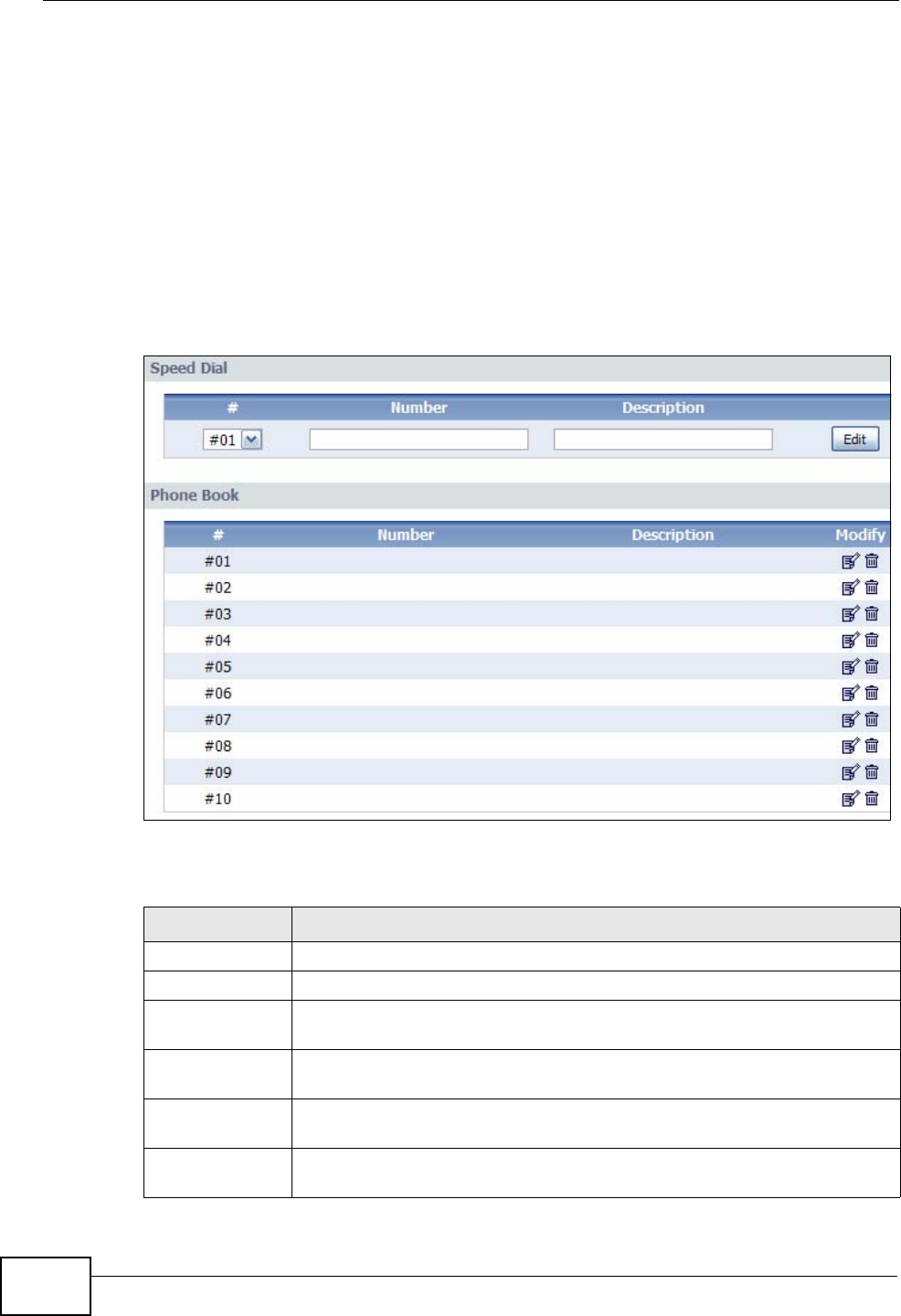
Chapter 10 Voice
IAD User’s Guide
126
10.5 Speed Dial
Speed dial provides shortcuts for dialing frequently used (VoIP) phone numbers.
You also have to create speed-dial entries if you want to make peer-to-peer calls
or call SIP numbers that contain letters. Once you have configured a speed dial
rule, you can use a shortcut (the speed dial number, #01 for example) on your
phone's keypad to call the phone number.
Use this screen to add, edit, or remove speed-dial numbers for outgoing calls. To
access this screen, click VoIP > Phone Book > Speed Dial.
Figure 57 Phone Book > Speed Dial
Each field is described in the following table.
Table 39 Phone Book > Speed Dial
LABEL DESCRIPTION
Speed Dial Use this section to create or edit speed-dial entries.
#Select the speed-dial number you want to use for this phone number.
Number Enter the SIP number you want the IAD to call when you dial the speed-
dial number.
Description Enter a description for this speed dial number. You can use up to 127
alphanumeric characters.
Add Click this to use the information in the Speed Dial section to update
the Speed Dial Phone Book section.
Speed Dial
Phone Book Use this section to look at all the speed-dial entries and to erase them.

Chapter 10 Voice
IAD User’s Guide 127
# This field displays the speed-dial number you should dial to use this
entry.
Number This field displays the SIP number the IAD calls when you dial the
speed-dial number.
Destination This field is blank, if the speed-dial entry uses one of your SIP accounts.
Otherwise, this field shows the IP address or domain name of the SIP
server or other party. (This field corresponds with the Type field in the
Speed Dial section.)
Modify Use this field to edit or erase the speed-dial entry.
Click the Edit icon to copy the information for this speed-dial entry into
the Speed Dial section, where you can change it.
Click the Remove icon to erase this speed-dial entry.
Clear Click this to erase all the speed-dial entries.
Cancel Click this to set every field in this screen to its last-saved value.
Table 39 Phone Book > Speed Dial (continued)
LABEL DESCRIPTION

Chapter 10 Voice
IAD User’s Guide
128

IAD User’s Guide 129
CHAPTER 11
Phone Usage
11.1 Overview
This chapter describes how to use a phone connected to your IAD for basic tasks.
Note: Not all service providers support all features.
11.2 Dialing a Telephone Number
The PHONE LED turns green when your SIP account is registered. Dial a SIP
number like “12345” on your phone’s keypad.
Use speed dial entries (see Section 10.5 on page 126) for peer-to-peer calls or SIP
numbers that use letters. Dial the speed dial entry on your telephone’s keypad.
Use your VoIP service provider’s dialing plan to call regular telephone numbers.
11.3 Using Speed Dial
After configuring the speed dial entry and adding it to the phonebook, press the
speed dial entry’s key combination on your phone’s keypad.
11.4 Using Call Park and Pickup
Do the following to put a call on hold on one phone and continue it on another
(connected to the IAD). This feature may not be supported by all service
providers.
1During the call, press “*97#” and then any number (up to 8 digits long). You need
to remember this number in order to pick up the call on another phone. Hang up
the receiver.

Chapter 11 Phone Usage
IAD User’s Guide
130
2Pick up another phone’s receiver. Press “#97#” followed by the same number you
entered before to continue the call.
11.5 Checking the IAD’s IP Address
Do the following to listen to the IAD’s current IP address.
1Pick up your phone’s receiver.
2Press “****” on your phone’s keypad and wait for the message that says you are
in the configuration menu.
3Press “5” followed by the # key.
4Listen to the IP address and make a note of it.
5Hang up the receiver.
11.6 Auto Provisioning and Auto Firmware
Upgrade
If your service provider uses an auto-provisioning server to set up your device,
you must first authenticate your IAD with the auto provisioning server, allowing
you to use the service.
• On a phone connected to the device, enter “*99**”, your SIP number, “*”, then
“#”.
• For example, if your SIP number is 0123456, you would enter
“*99**0123456#”.
During auto-provisioning, the IAD checks to see if there is a newer firmware
version (if your service provider activates this feature). If newer firmware is
available, the IAD plays a recording when you pick up your phone’s handset.
• Press “*99#” to upgrade the IAD’s firmware.
• Press “#99#” to not upgrade the IAD’s firmware.

Chapter 11 Phone Usage
IAD User’s Guide 131
11.7 Phone Services Overview
Supplementary services such as call hold, call waiting, call transfer, etc. are
generally available from your VoIP service provider. The IAD supports the
following services:
• Call Hold
• Call Waiting
• Making a Second Call
• Call Transfer
• Call Forwarding
• Three-Way Conference
•Internal Calls
• Call Park and Pickup
•Do not Disturb
Note: To take full advantage of the supplementary phone services available through
the IAD's phone port, you may need to subscribe to the services from your VoIP
service provider.
11.7.1 The Flash Key
Flashing means to press the hook for a short period of time (a few hundred
milliseconds) before releasing it. On newer telephones, there should be a "flash"
key (button) that generates the signal electronically. If the flash key is not
available, you can tap (press and immediately release) the hook by hand to
achieve the same effect. However, using the flash key is preferred since the timing
is much more precise. With manual tapping, if the duration is too long, it may be
interpreted as hanging up by the IAD.
You can invoke all the supplementary services by using the flash key.
11.7.2 Europe Type Supplementary Phone Services
This section describes how to use supplementary phone services with the Europe
Type Call Service Mode. Commands for supplementary services are listed in the
table below.

Chapter 11 Phone Usage
IAD User’s Guide
132
After pressing the flash key, if you do not issue the sub-command before the
default sub-command timeout (2 seconds) expires or issue an invalid sub-
command, the current operation will be aborted.
11.7.2.1 European Call Hold
Call hold allows you to put a call (A) on hold by pressing the flash key.
If you have another call, press the flash key and then “2” to switch back and forth
between caller A and B by putting either one on hold.
Press the flash key and then “0” to disconnect the call presently on hold and keep
the current call on line.
Press the flash key and then “1” to disconnect the current call and resume the call
on hold.
If you hang up the phone but a caller is still on hold, there will be a remind ring.
11.7.2.2 European Call Waiting
This allows you to place a call on hold while you answer another incoming call on
the same telephone (directory) number.
If there is a second call to a telephone number, you will hear a call waiting tone.
Take one of the following actions.
• Reject the second call.
Press the flash key and then press “0”.
Table 40 European Flash Key Commands
COMMAND SUB-
COMMAND DESCRIPTION
Flash Put a current call on hold to place a second call.
Switch back to the call (if there is no second call).
Flash 0 Drop the call presently on hold or reject an incoming call
which is waiting for answer.
Flash 1 Disconnect the current phone connection and answer the
incoming call or resume with caller presently on hold.
Flash 2 1. Switch back and forth between two calls.
2. Put a current call on hold to answer an incoming call.
3. Separate the current three-way conference call into
two individual calls (one is on-line, the other is on hold).
Flash 3 Create three-way conference connection.
Flash *98# Transfer the call to another phone.

Chapter 11 Phone Usage
IAD User’s Guide 133
• Disconnect the first call and answer the second call.
Either press the flash key and press “1”, or just hang up the phone and then
answer the phone after it rings.
• Put the first call on hold and answer the second call.
Press the flash key and then “2”.
11.7.2.3 European Call Transfer
Do the following to transfer an incoming call (that you have answered) to another
phone.
1Press the flash key to put the caller on hold.
2When you hear the dial tone, dial “*98#” followed by the number to which you
want to transfer the call. to operate the Intercom.
3After you hear the ring signal or the second party answers it, hang up the phone.
11.7.2.4 European Three-Way Conference
Use the following steps to make three-way conference calls.
1When you are on the phone talking to someone, press the flash key to put the
caller on hold and get a dial tone.
2Dial a phone number directly to make another call.
3When the second call is answered, press the flash key and press “3” to create a
three-way conversation.
4Hang up the phone to drop the connection.
5If you want to separate the activated three-way conference into two individual
connections (one is on-line, the other is on hold), press the flash key and press
“2”.
11.7.3 USA Type Supplementary Services
This section describes how to use supplementary phone services with the USA
Type Call Service Mode. Commands for supplementary services are listed in the
table below.

Chapter 11 Phone Usage
IAD User’s Guide
134
After pressing the flash key, if you do not issue the sub-command before the
default sub-command timeout (2 seconds) expires or issue an invalid sub-
command, the current operation will be aborted.
11.7.3.1 USA Call Hold
Call hold allows you to put a call (A) on hold by pressing the flash key.
If you have another call, press the flash key to switch back and forth between
caller A and B by putting either one on hold.
If you hang up the phone but a caller is still on hold, there will be a remind ring.
11.7.3.2 USA Call Waiting
This allows you to place a call on hold while you answer another incoming call on
the same telephone (directory) number.
If there is a second call to your telephone number, you will hear a call waiting
tone.
Press the flash key to put the first call on hold and answer the second call.
11.7.3.3 USA Call Transfer
Do the following to transfer an incoming call (that you have answered) to another
phone.
1Press the flash key to put the caller on hold.
2When you hear the dial tone, dial “*98#” followed by the number to which you
want to transfer the call. to operate the Intercom.
3After you hear the ring signal or the second party answers it, hang up the phone.
Table 41 USA Flash Key Commands
COMMAND SUB-
COMMAND DESCRIPTION
Flash Put a current call on hold to place a second call. After the
second call is successful, press the flash key again to
have a three-way conference call.
Put a current call on hold to answer an incoming call.
Flash *98# Transfer the call to another phone.
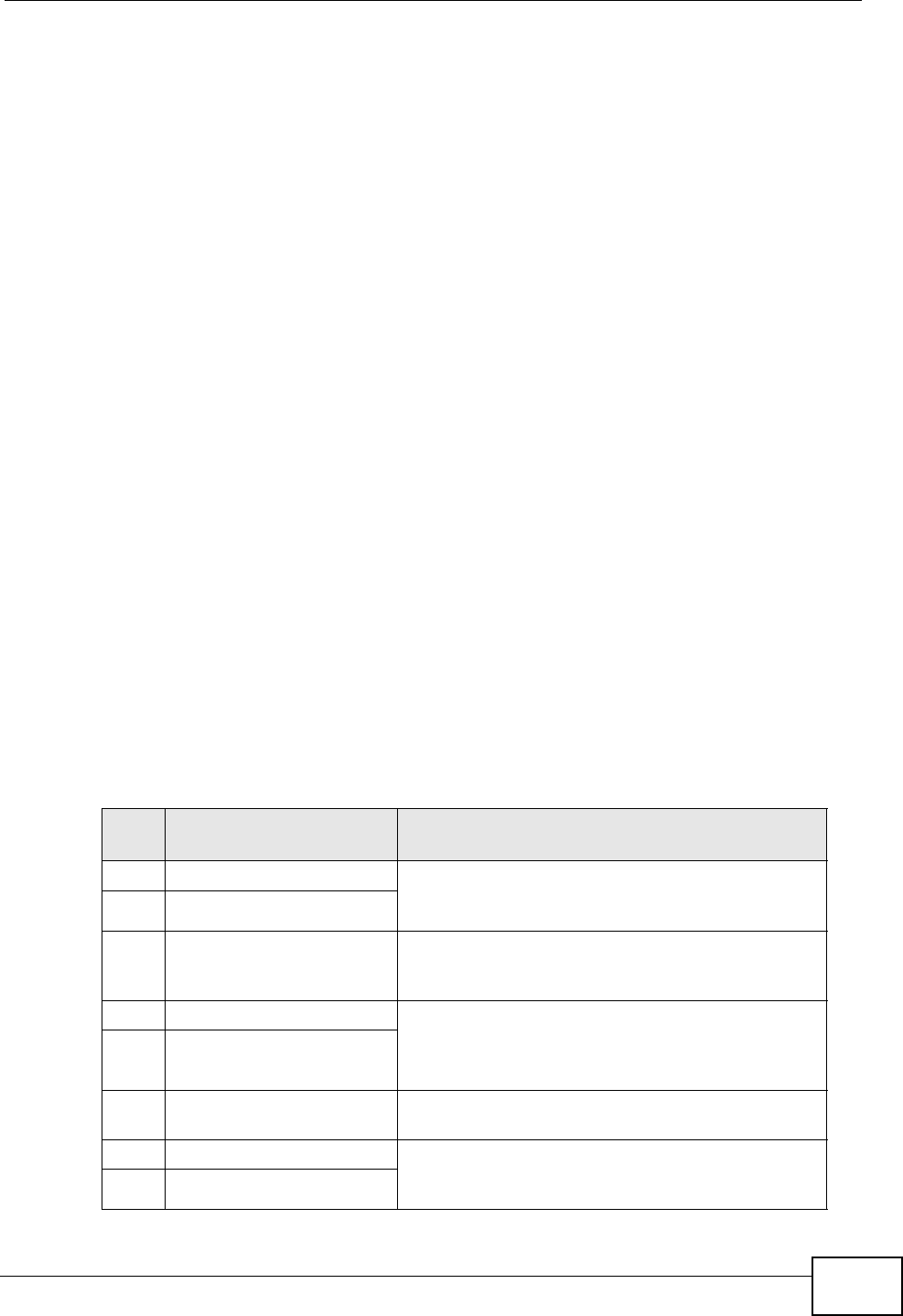
Chapter 11 Phone Usage
IAD User’s Guide 135
11.7.3.4 USA Three-Way Conference
Use the following steps to make three-way conference calls.
1When you are on the phone talking to someone (party A), press the flash key to
put the caller on hold and get a dial tone.
2Dial a phone number directly to make another call (to party B).
3When party B answers the second call, press the flash key to create a three-way
conversation.
4Hang up the phone to drop the connection.
5If you want to separate the activated three-way conference into two individual
connections (with party A on-line and party B on hold), press the flash key.
6If you want to go back to the three-way conversation, press the flash key again.
7If you want to separate the activated three-way conference into two individual
connections again, press the flash key. This time the party B is on-line and party A
is on hold.
11.8 Phone Functions Summary
The following table shows the key combinations you can enter on your phone’s
keypad to use certain features.
Table 42 Phone Functions Summary
ACTI
ON FUNCTION DESCRIPTION
*99# Enable firmware update Use these to upload or not upload new firmware
to the IAD, if requested by your service provider.
See Section 11.6 on page 130.
#99# Disable firmware update
*98# Call transfer Transfer a call to another phone. See Section
11.7.2 on page 131 (Europe type) and Section
11.7.3 on page 133 (USA type).
*97# Call park Use these to place a call on hold on one phone
and then continue it on another (if supported by
your service provider). See Chapter 23 on page
231.
#97# Call pickup
*66# Call return Place a call to the last person who called you. See
Chapter 23 on page 231.
*95# Enable Do Not Disturb Use these to set your phone not to ring when
someone calls you, or to turn this function off.
Chapter 23 on page 231
#95# Disable Do Not Disturb

Chapter 11 Phone Usage
IAD User’s Guide
136
*41# Enable call waiting Use these to allow you to put a call on hold while
answering another, or to turn this function off.
See Section 11.7.2 on page 131 (Europe type)
and Section 11.7.3 on page 133 (USA type).
#41# Disable call waiting
*21# Enable call forward Use these to allow you to use the call forwarding
tables you set in the IAD, or to turn this function
off.
#21# Disable call forward
*22* Uncondition forward Forward all incoming calls.
*23* No answer forward Forward incoming calls if you do not answer.
*24* Busy forward Forward calls if you are already making a call.
Table 42 Phone Functions Summary
ACTI
ON FUNCTION DESCRIPTION
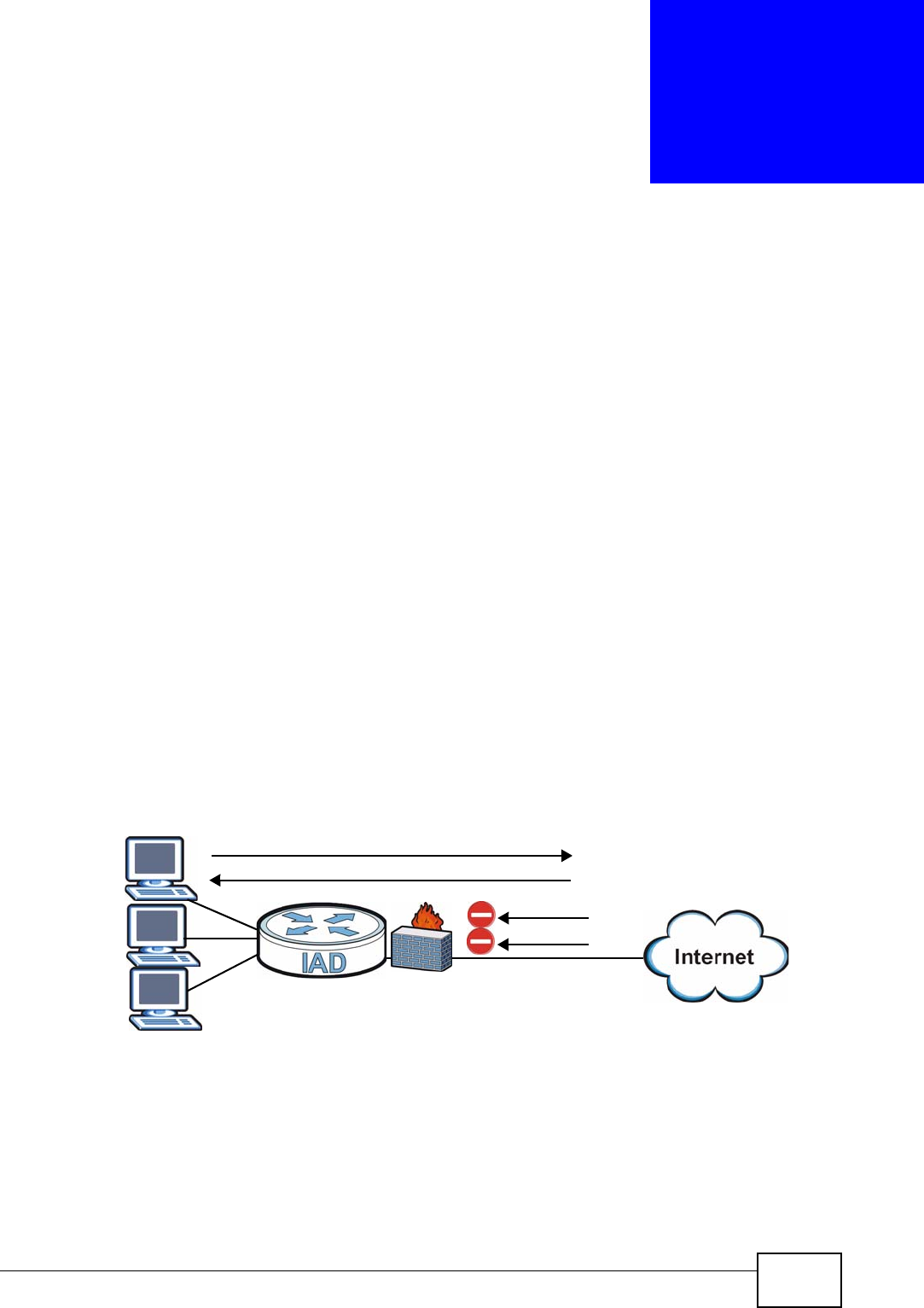
IAD User’s Guide 137
CHAPTER 12
Firewalls
12.1 Overview
Use these screens to enable and configure the firewall that protects your IAD and
your LAN from unwanted or malicious traffic.
Enable the firewall to protect your LAN computers from attacks by hackers on the
Internet and control access between the LAN and WAN. By default the firewall:
• allows traffic that originates from your LAN computers to go to all of the
networks.
• blocks traffic that originates on the other networks from going to the LAN.
The following figure illustrates the default firewall action. User A can initiate an IM
(Instant Messaging) session from the LAN to the WAN (1). Return traffic for this
session is also allowed (2). However other traffic initiated from the WAN is blocked
(3 and 4).
Figure 58 Default Firewall Action
• See Section 12.1.3 on page 140 for an example of setting up a firewall.
• See Section 12.5 on page 154 for advanced technical information on firewall.
WAN
LAN
3
4
1
2
A

Chapter 12 Firewalls
IAD User’s Guide
138
12.1.1 What You Can Do in this Chapter
•Use the General screen (Section 12.2 on page 143) to enable firewall and/or
triangle route on the IAD, and set the default action that the firewall takes on
packets that do not match any of the firewall rules.
•Use the Rules screen (Section 12.3 on page 145) to view the configured firewall
rules and add, edit or remove a firewall rule.
•Use the Threshold screen (Section 12.4 on page 151) to set the thresholds that
the IAD uses to determine when to start dropping sessions that do not become
fully established (half-open sessions).
12.1.2 What You Need to Know
Firewall
The networking term firewall is a system or group of systems that enforces an
access-control policy between two networks. It is generally a mechanism used to
protect a trusted network from an untrusted network.
The IAD firewall is a stateful inspection firewall and restricts access by screening
data packets against defined access rules. The IAD physically separates the LAN
and the WAN and acts as a secure gateway for all data passing between the
networks. The IAD protects against Denial of Service (DoS) attacks, prevents
theft, destruction and modification of data, and logs events.
Firewall Rules
Your customized rules take precedence and override the IAD’s default settings.
The IAD checks the source IP address, destination IP address and IP protocol type
of network traffic against the firewall rules (in the order you list them). When the
traffic matches a rule, the IAD takes the action specified in the rule.
Firewall rules are grouped based on the direction of travel of packets to which they
apply:
Note: The LAN includes both the LAN port and the WLAN.
By default, the IAD’s stateful packet inspection allows packets traveling in the
following directions:
•LAN to LAN/ Router •WAN to LAN
• LAN to WAN • WAN to WAN/ Router

Chapter 12 Firewalls
IAD User’s Guide 139
•LAN to LAN/ Router
These rules specify which computers on the LAN can manage the IAD (remote
management) and communicate between networks or subnets connected to the
LAN interface (IP alias).
Note: You can also configure the remote management settings to allow only a specific
computer to manage the IAD.
•LAN to WAN
These rules specify which computers on the LAN can access which computers or
services on the WAN.
By default, the IAD’s stateful packet inspection drops packets traveling in the
following directions:
•WAN to LAN
These rules specify which computers on the WAN can access which computers
or services on the LAN.
Note: You also need to configure NAT port forwarding (or full featured NAT address
mapping rules) to allow computers on the WAN to access devices on the LAN.
•WAN to WAN/ Router
By default the IAD stops computers on the WAN from managing the IAD or
using the IAD as a gateway to communicate with other computers on the WAN.
You could configure one of these rules to allow a WAN computer to manage the
IAD.
Note: You also need to configure the remote management settings to allow a WAN
computer to manage the IAD.
You may define additional rules and sets or modify existing ones but please
exercise extreme caution in doing so.
For example, you may create rules to:
• Block certain types of traffic, such as IRC (Internet Relay Chat), from the LAN to
the Internet.
• Allow certain types of traffic, such as Lotus Notes database synchronization,
from specific hosts on the Internet to specific hosts on the LAN.
• Allow everyone except your competitors to access a web server.
• Restrict use of certain protocols, such as Telnet, to authorized users on the LAN.
These custom rules work by comparing the source IP address, destination IP
address and IP protocol type of network traffic to rules set by the administrator.
Your customized rules take precedence and override the IAD’s default rules.
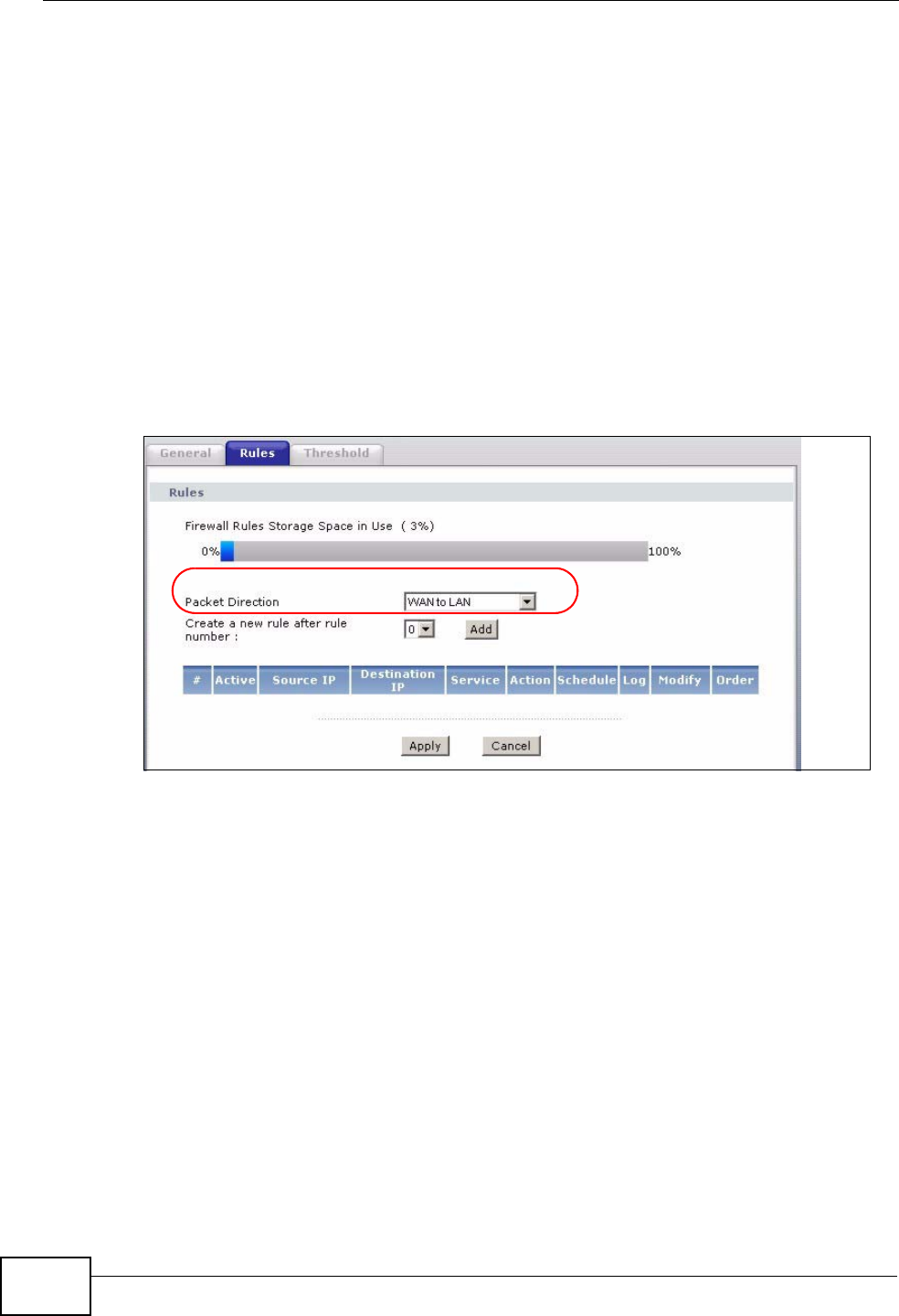
Chapter 12 Firewalls
IAD User’s Guide
140
12.1.3 Firewall Rule Setup Example
The following Internet firewall rule example allows a “Doom” connection from the
Internet.
1Click Security > Firewall > Rules.
2Select WAN to LAN in the Packet Direction field.
3Select the index number after that you want to add the rule. For example, if you
select “6”, your new rule becomes number 7 and the previous rule 7 (if there is
one) becomes rule 8.
4Click Add to display the firewall rule configuration screen.
Figure 59 Firewall Example: Rules
5In the Edit Rule screen, click the Edit Customized Services link to open the
Customized Service screen.
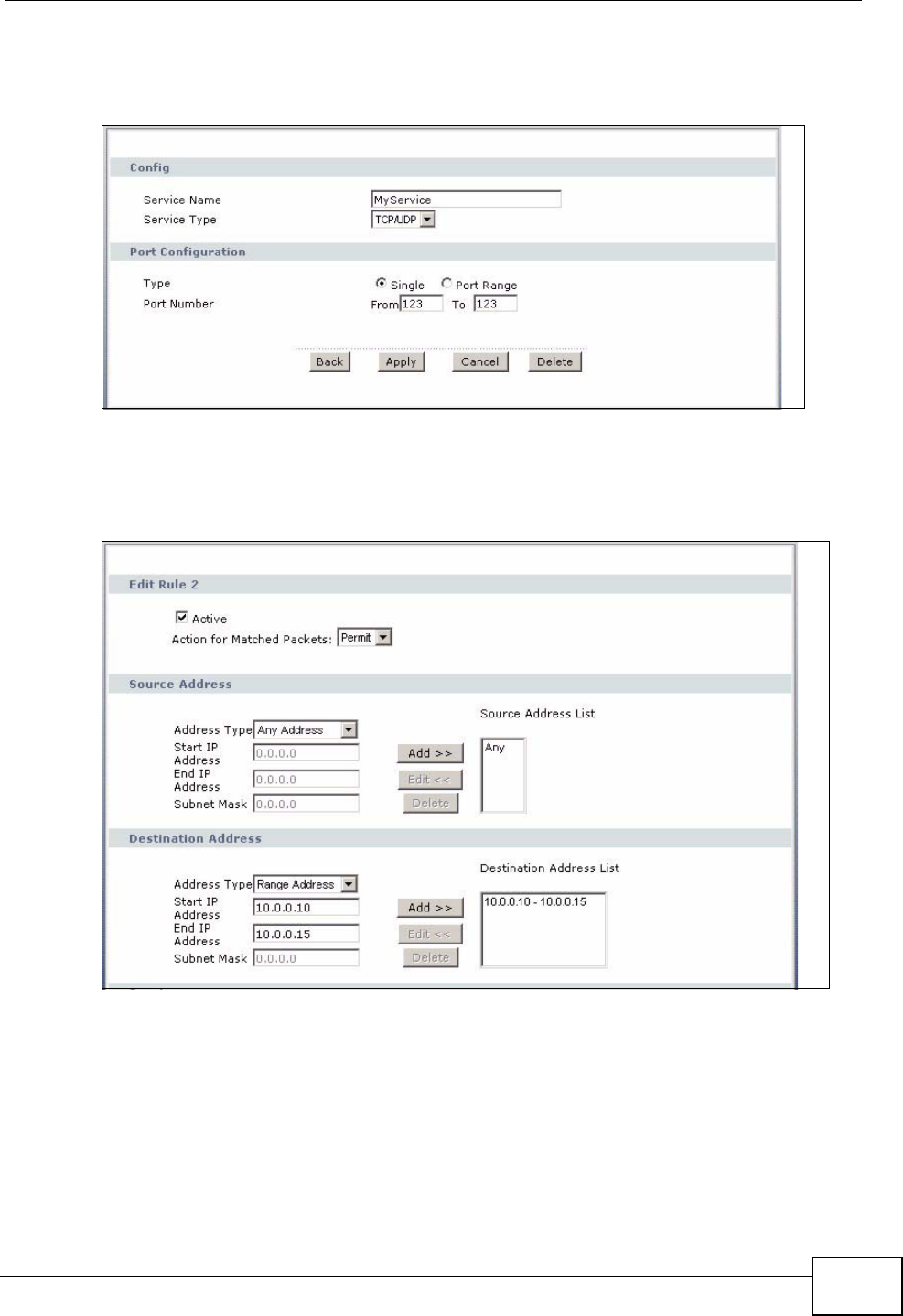
Chapter 12 Firewalls
IAD User’s Guide 141
6Click an index number to display the Customized Services Config screen and
configure the screen as follows and click Apply.
Figure 60 Edit Custom Port Example
7Select Any in the Destination Address List box and then click Delete.
8Configure the destination address screen as follows and click Add.
Figure 61 Firewall Example: Edit Rule: Destination Address
9Use the Add >> and Remove buttons between Available Services and
Selected Services list boxes to configure it as follows. Click Apply when you are
done.
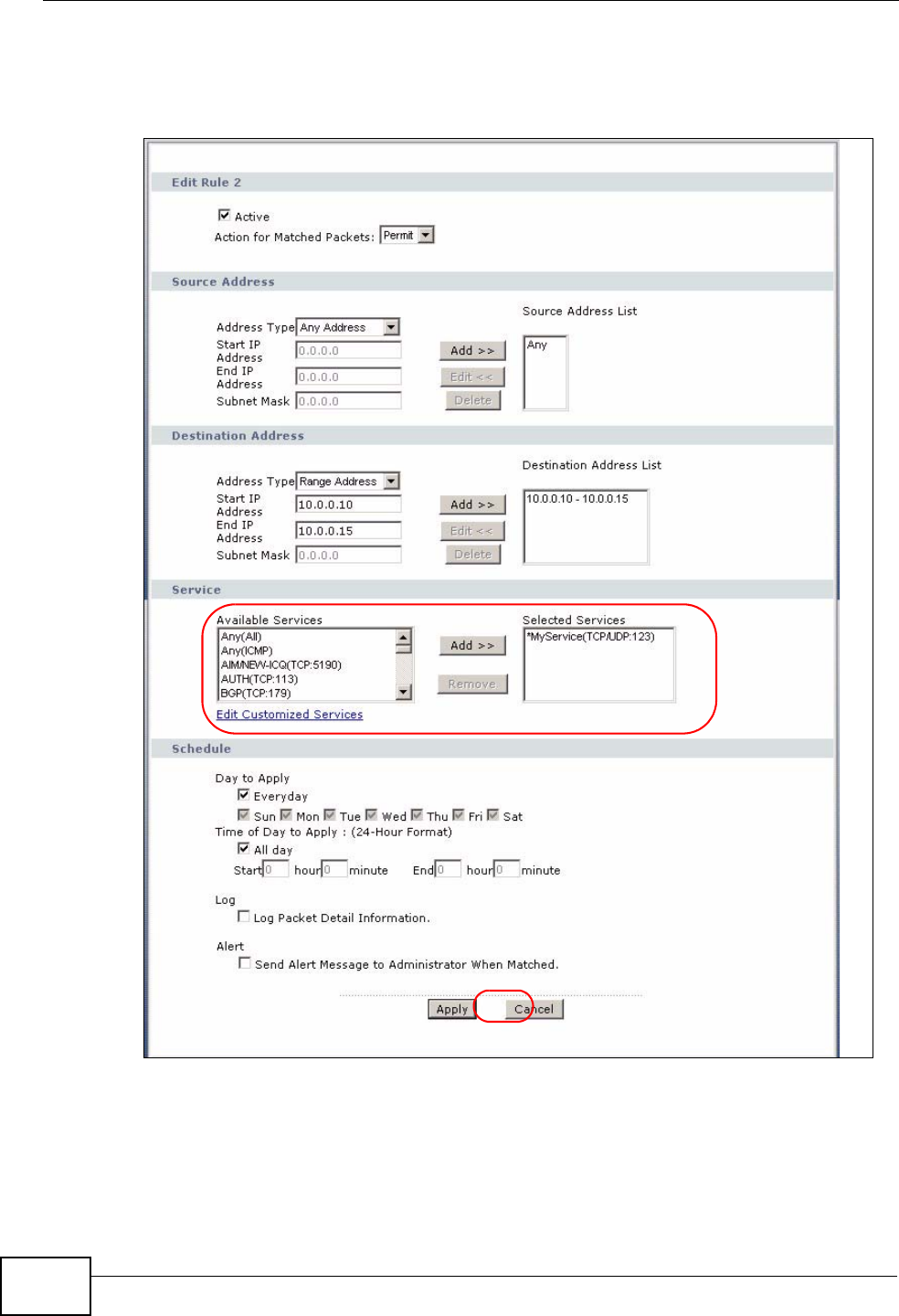
Chapter 12 Firewalls
IAD User’s Guide
142
Note: Custom services show up with an “*” before their names in the Services list box
and the Rules list box.
Figure 62 Firewall Example: Edit Rule: Select Customized Services
On completing the configuration procedure for this Internet firewall rule, the
Rules screen should look like the following.
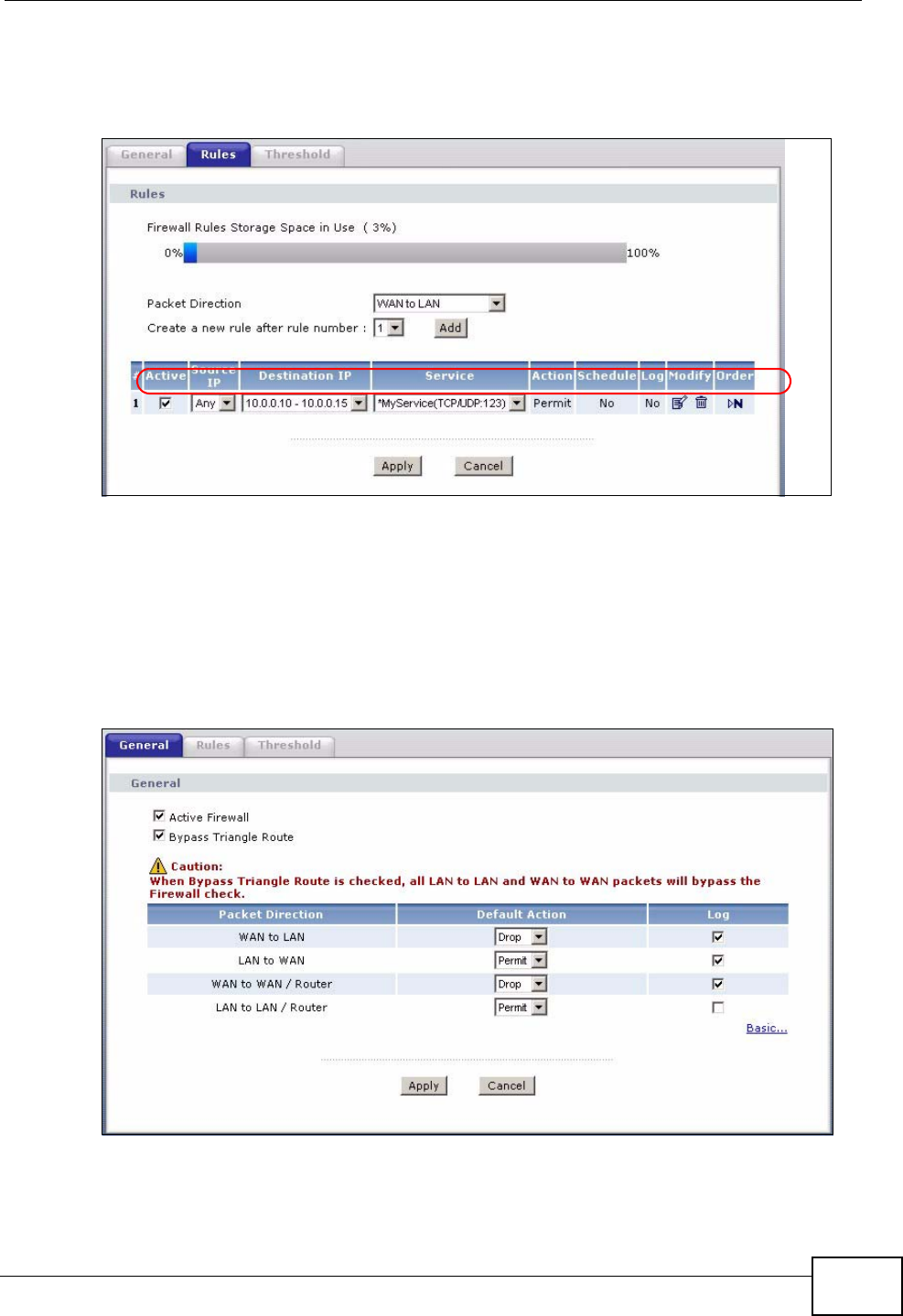
Chapter 12 Firewalls
IAD User’s Guide 143
Rule 1 allows a “Doom” connection from the WAN to IP addresses 10.1.1.10
through 10.1.1.15 on the LAN.
Figure 63 Firewall Example: Rules: MyService
12.2 The Firewall General Screen
Click Security > Firewall to display the following screen. Activate the firewall by
selecting the Active Firewall check box as seen in the following screen.
Figure 64 Security > Firewall > General

Chapter 12 Firewalls
IAD User’s Guide
144
The following table describes the labels in this screen.
Table 43 Security > Firewall > General
LABEL DESCRIPTION
Active Firewall Select this check box to activate the firewall. The IAD performs access
control and protects against Denial of Service (DoS) attacks when the
firewall is activated.
Bypass Triangle
Route If an alternate gateway on the LAN has an IP address in the same
subnet as the IAD’s LAN IP address, return traffic may not go through
the IAD. This is called an asymmetrical or “triangle” route. This causes
the IAD to reset the connection, as the connection has not been
acknowledged.
Select this check box to have the IAD permit the use of asymmetrical
route topology on the network (not reset the connection).
Note: Allowing asymmetrical routes may let traffic from the WAN go
directly to the LAN without passing through the IAD. A better
solution is to use IP alias to put the IAD and the backup
gateway on separate subnets. See Section 12.5.3.1 on page
155 for an example.
Packet
Direction This is the direction of travel of packets (LAN to LAN / Router, LAN to
WAN, WAN to WAN / Router, WAN to LAN).
Firewall rules are grouped based on the direction of travel of packets to
which they apply. For example, LAN to LAN / Router means packets
traveling from a computer/subnet on the LAN to either another
computer/subnet on the LAN interface of the IAD or the IAD itself.
Default Action Use the drop-down list boxes to select the default action that the
firewall is to take on packets that are traveling in the selected direction
and do not match any of the firewall rules.
Select Drop to silently discard the packets without sending a TCP reset
packet or an ICMP destination-unreachable message to the sender.
Select Reject to deny the packets and send a TCP reset packet (for a
TCP packet) or an ICMP destination-unreachable message (for a UDP
packet) to the sender.
Select Permit to allow the passage of the packets.
Log Select the check box to create a log (when the above action is taken)
for packets that are traveling in the selected direction and do not match
any of your customized rules.
Expand... Click this button to display more information.
Basic... Click this button to display less information.
Apply Click Apply to save your changes back to the IAD.
Cancel Click Cancel to begin configuring this screen afresh.
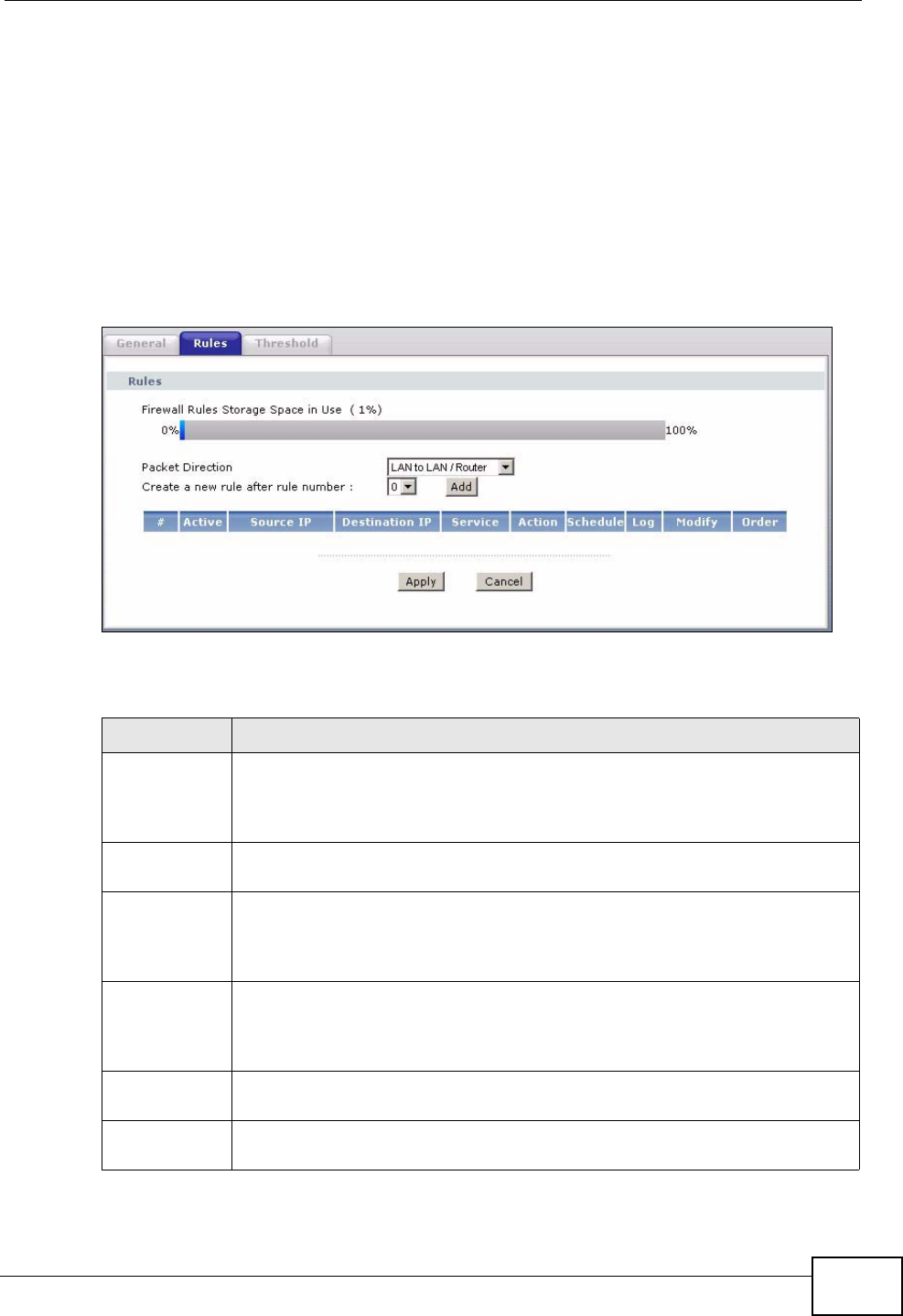
Chapter 12 Firewalls
IAD User’s Guide 145
12.3 The Firewall Rules Screen
Note: The ordering of your rules is very important as rules are applied in turn.
Refer to Section 12.5 on page 154 for more information.
Click Security > Firewall > Rules to bring up the following screen. This screen
displays a list of the configured firewall rules. Note the order in which the rules are
listed.
Figure 65 Security > Firewall > Rules
The following table describes the labels in this screen.
Table 44 Security > Firewall > Rules
LABEL DESCRIPTION
Firewall Rules
Storage
Space in Use
This read-only bar shows how much of the IAD's memory for recording
firewall rules it is currently using. When you are using 80% or less of the
storage space, the bar is green. When the amount of space used is over
80%, the bar is red.
Packet
Direction Use the drop-down list box to select a direction of travel of packets for
which you want to configure firewall rules.
Create a new
rule after rule
number
Select an index number and click Add to add a new firewall rule after the
selected index number. For example, if you select “6”, your new rule
becomes number 7 and the previous rule 7 (if there is one) becomes rule
8.
The following read-only fields summarize the rules you have created that
apply to traffic traveling in the selected packet direction. The firewall rules
that you configure (summarized below) take priority over the general
firewall action settings in the General screen.
#This is your firewall rule number. The ordering of your rules is important
as rules are applied in turn.
Active This field displays whether a firewall is turned on or not. Select the check
box to enable the rule. Clear the check box to disable the rule.

Chapter 12 Firewalls
IAD User’s Guide
146
12.3.1 Configuring Firewall Rules
Refer to Section 12.1.2 on page 138 for more information.
Source IP This drop-down list box displays the source addresses or ranges of
addresses to which this firewall rule applies. Please note that a blank
source or destination address is equivalent to Any.
Destination IP This drop-down list box displays the destination addresses or ranges of
addresses to which this firewall rule applies. Please note that a blank
source or destination address is equivalent to Any.
Service This drop-down list box displays the services to which this firewall rule
applies. See Appendix F on page 313 for more information.
Action This field displays whether the firewall silently discards packets (Drop),
discards packets and sends a TCP reset packet or an ICMP destination-
unreachable message to the sender (Reject) or allows the passage of
packets (Permit).
Schedule This field tells you whether a schedule is specified (Yes) or not (No).
Log This field shows you whether a log is created when packets match this
rule (Yes) or not (No).
Modify Click the Edit icon to go to the screen where you can edit the rule.
Click the Remove icon to delete an existing firewall rule. A window
displays asking you to confirm that you want to delete the firewall rule.
Note that subsequent firewall rules move up by one when you take this
action.
Order Click the Move icon to display the Move the rule to field. Type a number
in the Move the rule to field and click the Move button to move the rule
to the number that you typed. The ordering of your rules is important as
they are applied in order of their numbering.
Apply Click Apply to save your changes back to the IAD.
Cancel Click Cancel to begin configuring this screen afresh.
Table 44 Security > Firewall > Rules (continued)
LABEL DESCRIPTION
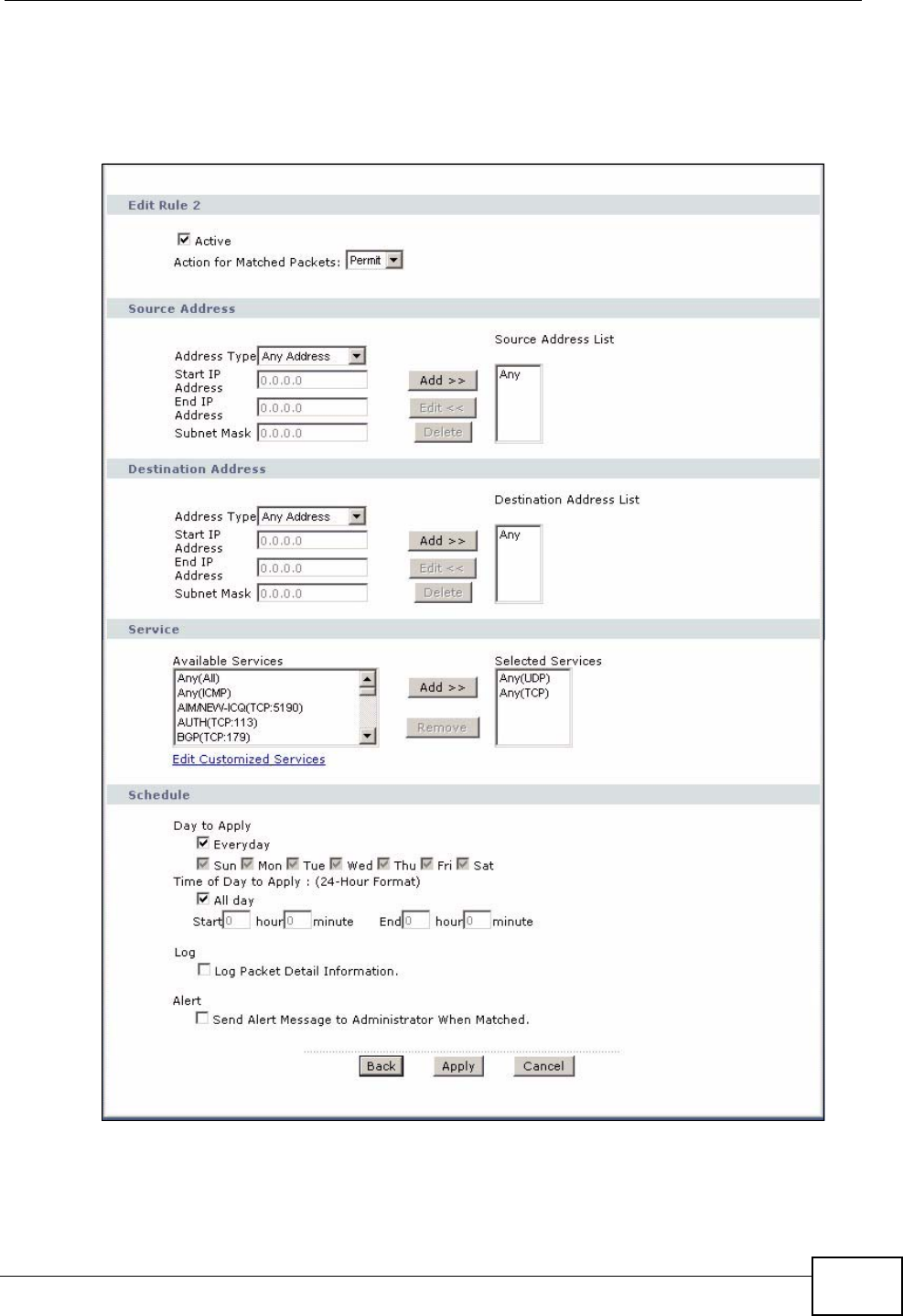
Chapter 12 Firewalls
IAD User’s Guide 147
In the Rules screen, select an index number and click Add or click a rule’s Edit
icon to display this screen and refer to the following table for information on the
labels.
Figure 66 Security > Firewall > Rules: Edit

Chapter 12 Firewalls
IAD User’s Guide
148
The following table describes the labels in this screen.
Table 45 Security > Firewall > Rules: Edit
LABEL DESCRIPTION
Active Select this option to enable this firewall rule.
Action for
Matched Packet Use the drop-down list box to select whether to discard (Drop), deny
and send an ICMP destination-unreachable message to the sender of
(Reject) or allow the passage of (Permit) packets that match this
rule.
Source/
Destination
Address
Address Type Do you want your rule to apply to packets with a particular (single) IP,
a range of IP addresses (for instance, 192.168.1.10 to 192.169.1.50),
a subnet or any IP address? Select an option from the drop-down list
box that includes: Single Address, Range Address, Subnet
Address and Any Address.
Start IP Address Enter the single IP address or the starting IP address in a range here.
End IP Address Enter the ending IP address in a range here.
Subnet Mask Enter the subnet mask here, if applicable.
Add >> Click Add >> to add a new address to the Source or Destination
Address box. You can add multiple addresses, ranges of addresses,
and/or subnets.
Edit << To edit an existing source or destination address, select it from the box
and click Edit <<.
Delete Highlight an existing source or destination address from the Source or
Destination Address box above and click Delete to remove it.
Services
Available/
Selected Services Please see Appendix F on page 313 for more information on services
available. Highlight a service from the Available Services box on the
left, then click Add >> to add it to the Selected Services box on the
right. To remove a service, highlight it in the Selected Services box
on the right, then click Remove.
Custom services are prefixed with an asterisk.
Edit Customized
Service Click the Edit Customized Services link to bring up the screen that
you use to configure a new custom service that is not in the predefined
list of services.
Schedule
Day to Apply Select everyday or the day(s) of the week to apply the rule.
Time of Day to
Apply (24-Hour
Format)
Select All Day or enter the start and end times in the hour-minute
format to apply the rule.
Log
Log Packet Detail
Information This field determines if a log for packets that match the rule is created
or not. Go to the Log Settings page and select the Access Control
logs category to have the IAD record these logs.
Alert
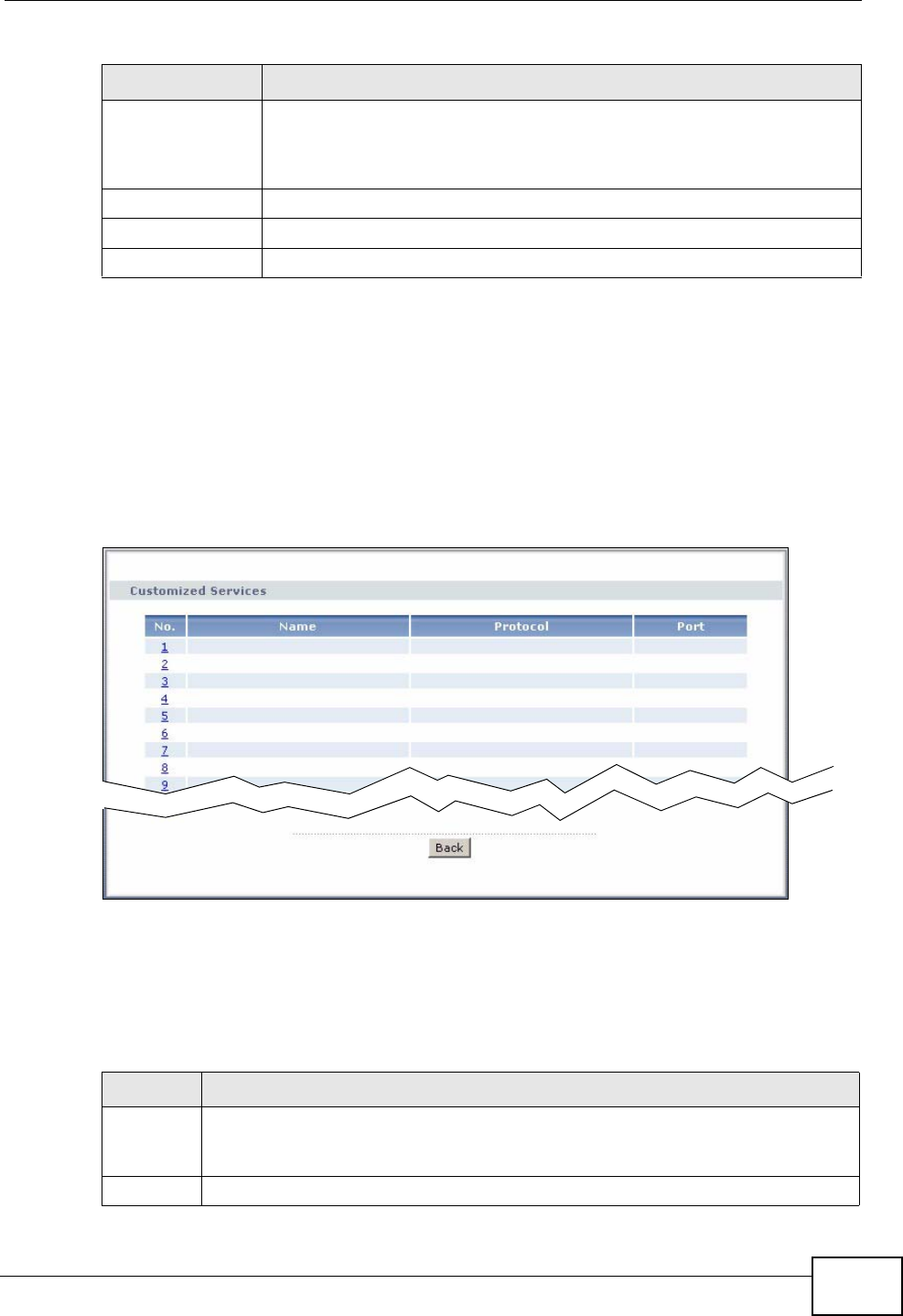
Chapter 12 Firewalls
IAD User’s Guide 149
12.3.2 Customized Services
Configure customized services and port numbers not predefined by the IAD. For a
comprehensive list of port numbers and services, visit the IANA (Internet
Assigned Number Authority) website. See Appendix F on page 313 for some
examples. Click the Edit Customized Services link while editing a firewall rule to
configure a custom service port. This displays the following screen.
Figure 67 Security > Firewall > Rules: Edit: Edit Customized Services
The following table describes the labels in this screen.
Send Alert
Message to
Administrator
When Matched
Select the check box to have the IAD generate an alert when the rule
is matched.
Back Click Back to return to the previous screen.
Apply Click Apply to save your customized settings and exit this screen.
Cancel Click Cancel to exit this screen without saving.
Table 45 Security > Firewall > Rules: Edit (continued)
LABEL DESCRIPTION
Table 46 Security > Firewall > Rules: Edit: Edit Customized Services
LABEL DESCRIPTION
No. This is the number of your customized port. Click a rule’s number of a service
to go to the Firewall Customized Services Config screen to configure or
edit a customized service.
Name This is the name of your customized service.
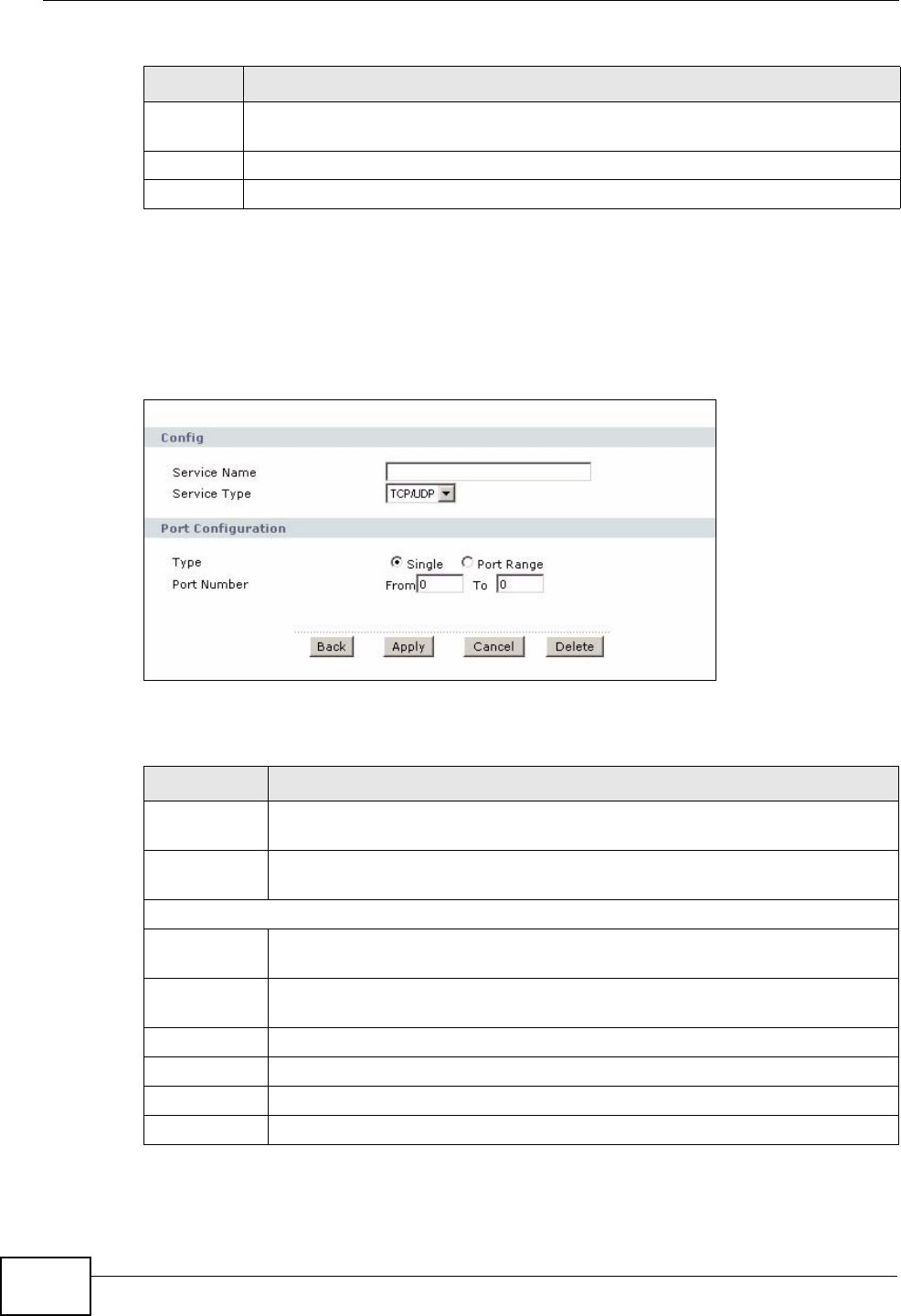
Chapter 12 Firewalls
IAD User’s Guide
150
12.3.3 Configuring A Customized Service
Click a rule number in the Firewall Customized Services screen to create a new
custom port or edit an existing one. This action displays the following screen.
Figure 68 Security > Firewall > Rules: Edit: Edit Customized Services: Config
The following table describes the labels in this screen.
Protocol This shows the IP protocol (TCP, UDP or TCP/UDP) that defines your
customized service.
Port This is the port number or range that defines your customized service.
Back Click Back to return to the Firewall Edit Rule screen.
Table 46 Security > Firewall > Rules: Edit: Edit Customized Services
LABEL DESCRIPTION
Table 47 Security > Firewall > Rules: Edit: Edit Customized Services: Config
LABEL DESCRIPTION
Service
Name Type a unique name for your custom port.
Service Type Choose the IP port (TCP, UDP or TCP/UDP) that defines your customized
port from the drop down list box.
Port Configuration
Type Click Single to specify one port only or Range to specify a span of ports
that define your customized service.
Port Number Type a single port number or the range of port numbers that define your
customized service.
Back Click Back to return to the previous screen.
Apply Click Apply to save your customized settings and exit this screen.
Cancel Click Cancel to return to the previously saved settings.
Delete Click Delete to delete the current rule.
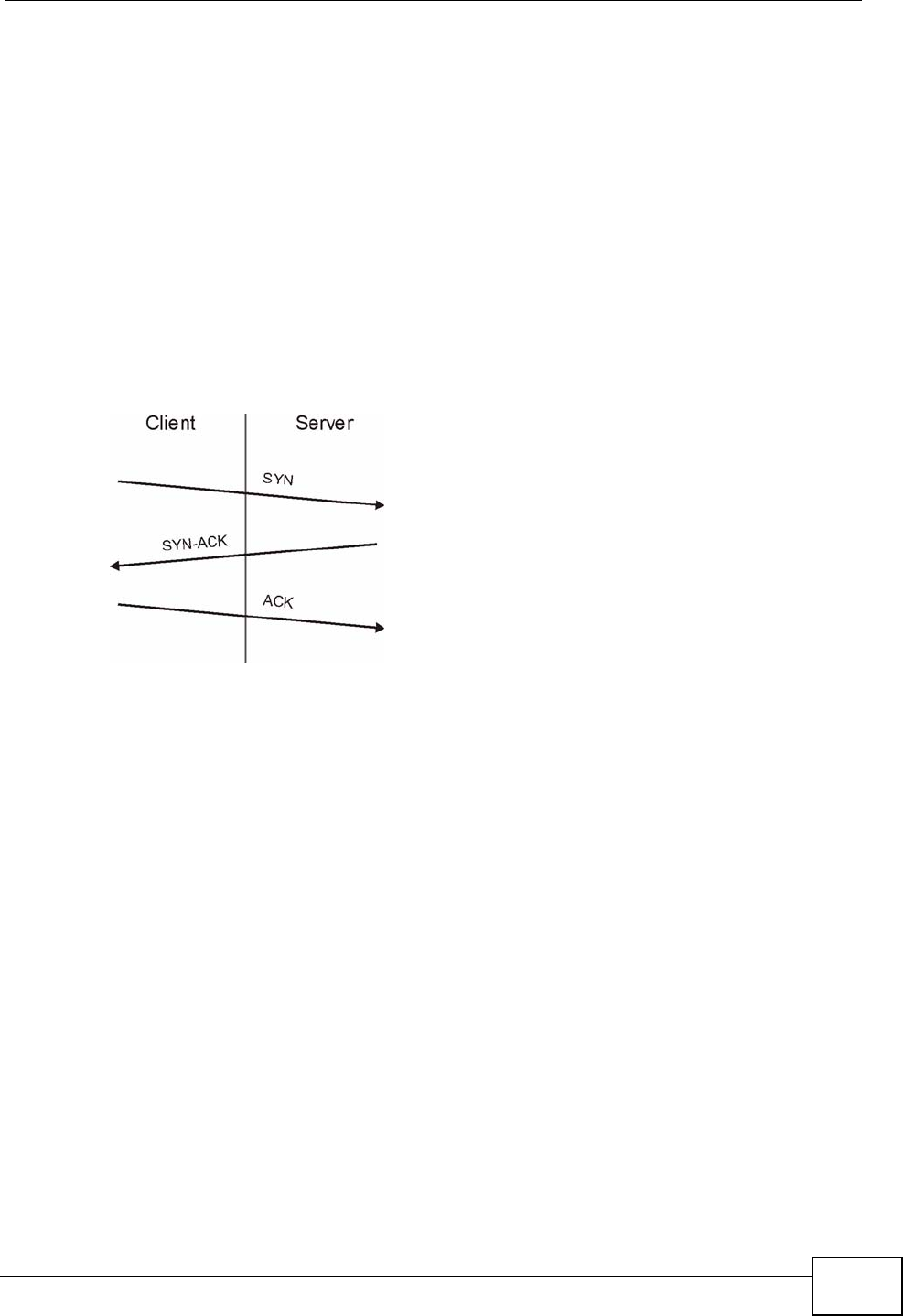
Chapter 12 Firewalls
IAD User’s Guide 151
12.4 The Firewall Threshold Screen
For DoS attacks, the IAD uses thresholds to determine when to start dropping
sessions that do not become fully established (half-open sessions). These
thresholds apply globally to all sessions.
For TCP, half-open means that the session has not reached the established state-
the TCP three-way handshake has not yet been completed. Under normal
circumstances, the application that initiates a session sends a SYN (synchronize)
packet to the receiving server. The receiver sends back an ACK (acknowledgment)
packet and its own SYN, and then the initiator responds with an ACK
(acknowledgment). After this handshake, a connection is established.
Figure 69 Three-Way Handshake
For UDP, half-open means that the firewall has detected no return traffic. An
unusually high number (or arrival rate) of half-open sessions could indicate a DOS
attack.
12.4.1 Threshold Values
If everything is working properly, you probably do not need to change the
threshold settings as the default threshold values should work for most small
offices. Tune these parameters when you believe the IAD has been receiving DoS
attacks that are not recorded in the logs or the logs show that the IAD is
classifying normal traffic as DoS attacks. Factors influencing choices for threshold
values are:
1The maximum number of opened sessions.
2The minimum capacity of server backlog in your LAN network.
3The CPU power of servers in your LAN network.
4Network bandwidth.
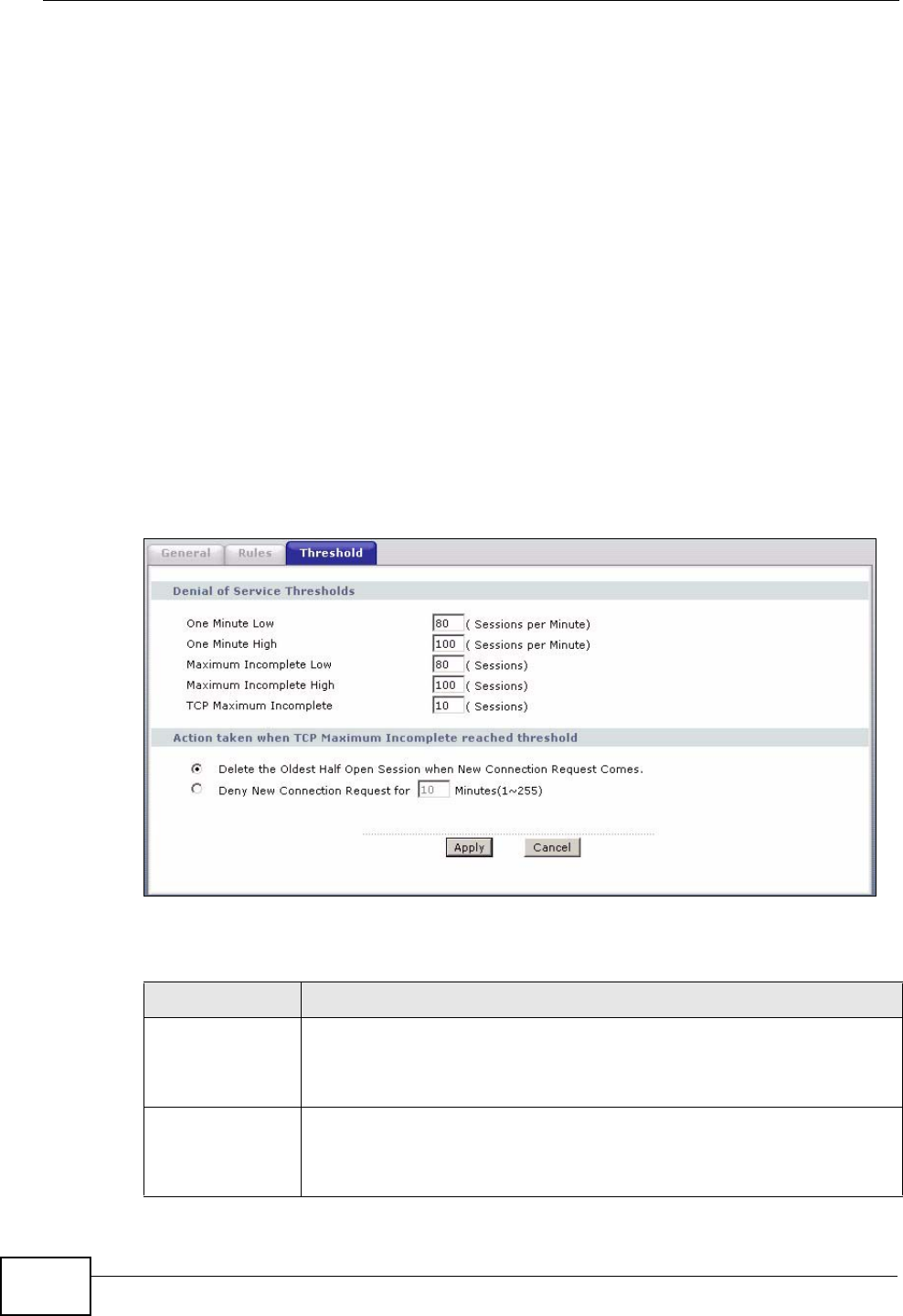
Chapter 12 Firewalls
IAD User’s Guide
152
5Type of traffic for certain servers.
Reduce the threshold values if your network is slower than average for any of
these factors (especially if you have servers that are slow or handle many tasks
and are often busy).
• If you often use P2P applications such as file sharing with eMule or eDonkey, it’s
recommended that you increase the threshold values since lots of sessions will
be established during a small period of time and the IAD may classify them as
DoS attacks.
12.4.2 Configuring Firewall Thresholds
The IAD also sends alerts whenever TCP Maximum Incomplete is exceeded.
The global values specified for the threshold and timeout apply to all TCP
connections.
Click Firewall > Threshold to bring up the next screen.
Figure 70 Security > Firewall > Threshold
The following table describes the labels in this screen.
Table 48 Security > Firewall > Threshold
LABEL DESCRIPTION
Denial of Service
Thresholds The IAD measures both the total number of existing half-open sessions
and the rate of session establishment attempts. Both TCP and UDP
half-open sessions are counted in the total number and rate
measurements. Measurements are made once a minute.
One Minute Low This is the rate of new half-open sessions per minute that causes the
firewall to stop deleting half-open sessions. The IAD continues to
delete half-open sessions as necessary, until the rate of new
connection attempts drops below this number.

Chapter 12 Firewalls
IAD User’s Guide 153
One Minute High This is the rate of new half-open sessions per minute that causes the
firewall to start deleting half-open sessions. When the rate of new
connection attempts rises above this number, the IAD deletes half-
open sessions as required to accommodate new connection attempts.
For example, if you set the one minute high to 100, the IAD starts
deleting half-open sessions when more than 100 session establishment
attempts have been detected in the last minute. It stops deleting half-
open sessions when the number of session establishment attempts
detected in a minute goes below the number set as the one minute
low.
Maximum
Incomplete Low This is the number of existing half-open sessions that causes the
firewall to stop deleting half-open sessions. The IAD continues to
delete half-open requests as necessary, until the number of existing
half-open sessions drops below this number.
Maximum
Incomplete High This is the number of existing half-open sessions that causes the
firewall to start deleting half-open sessions. When the number of
existing half-open sessions rises above this number, the IAD deletes
half-open sessions as required to accommodate new connection
requests. Do not set Maximum Incomplete High to lower than the
current Maximum Incomplete Low number.
For example, if you set the maximum incomplete high to 100, the IAD
starts deleting half-open sessions when the number of existing half-
open sessions rises above 100. It stops deleting half-open sessions
when the number of existing half-open sessions drops below the
number set as the maximum incomplete low.
TCP Maximum
Incomplete An unusually high number of half-open sessions with the same
destination host address could indicate that a DoS attack is being
launched against the host.
Specify the number of existing half-open TCP sessions with the same
destination host IP address that causes the firewall to start dropping
half-open sessions to that same destination host IP address. Enter a
number between 1 and 256. As a general rule, you should choose a
smaller number for a smaller network, a slower system or limited
bandwidth. The IAD sends alerts whenever the TCP Maximum
Incomplete is exceeded.
Action taken
when TCP
Maximum
Incomplete
reached
threshold
Select the action that IAD should take when the TCP maximum
incomplete threshold is reached. You can have the IAD either:
Delete the oldest half open session when a new connection request
comes.
or
Deny new connection requests for the number of minutes that you
specify (between 1 and 255).
Apply Click Apply to save your changes back to the IAD.
Cancel Click Cancel to begin configuring this screen afresh.
Table 48 Security > Firewall > Threshold (continued)
LABEL DESCRIPTION

Chapter 12 Firewalls
IAD User’s Guide
154
12.5 Technical Reference
This section provides some technical background information about the topics
covered in this chapter.
12.5.1 Guidelines For Enhancing Security With Your Firewall
1Change the default password via web configurator.
2Think about access control before you connect to the network in any way.
3Limit who can access your router.
4Don't enable any local service (such as telnet or FTP) that you don't use. Any
enabled service could present a potential security risk. A determined hacker might
be able to find creative ways to misuse the enabled services to access the firewall
or the network.
5For local services that are enabled, protect against misuse. Protect by configuring
the services to communicate only with specific peers, and protect by configuring
rules to block packets for the services at specific interfaces.
6Protect against IP spoofing by making sure the firewall is active.
7Keep the firewall in a secured (locked) room.
12.5.2 Security Considerations
Note: Incorrectly configuring the firewall may block valid access or introduce security
risks to the IAD and your protected network. Use caution when creating or
deleting firewall rules and test your rules after you configure them.
Consider these security ramifications before creating a rule:
1Does this rule stop LAN users from accessing critical resources on the Internet?
For example, if IRC is blocked, are there users that require this service?
2Is it possible to modify the rule to be more specific? For example, if IRC is blocked
for all users, will a rule that blocks just certain users be more effective?
3Does a rule that allows Internet users access to resources on the LAN create a
security vulnerability? For example, if FTP ports (TCP 20, 21) are allowed from the
Internet to the LAN, Internet users may be able to connect to computers with
running FTP servers.
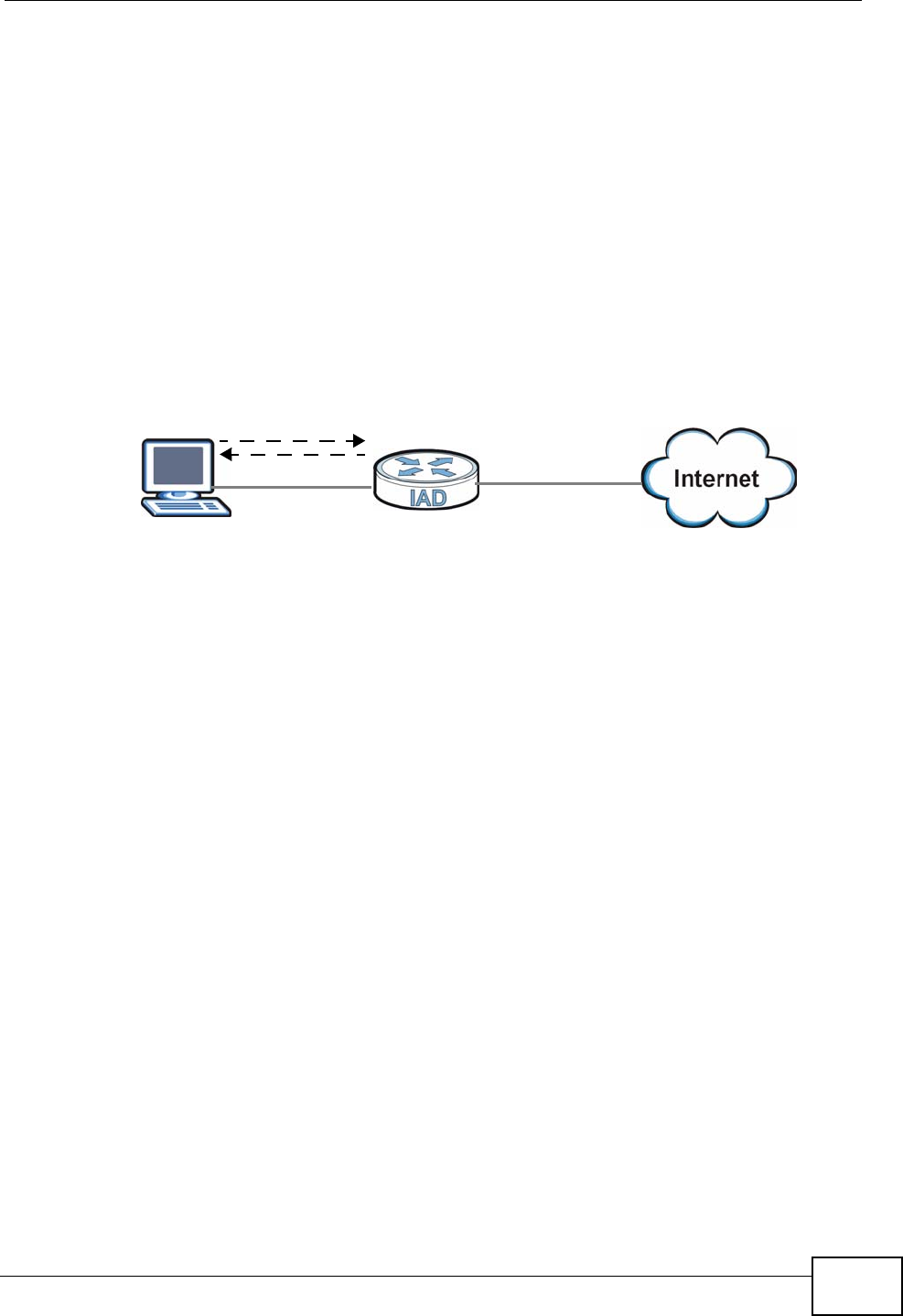
Chapter 12 Firewalls
IAD User’s Guide 155
4Does this rule conflict with any existing rules?
Once these questions have been answered, adding rules is simply a matter of
entering the information into the correct fields in the web configurator screens.
12.5.3 Triangle Route
When the firewall is on, your IAD acts as a secure gateway between your LAN and
the Internet. In an ideal network topology, all incoming and outgoing network
traffic passes through the IAD to protect your LAN against attacks.
Figure 71 Ideal Firewall Setup
12.5.3.1 The “Triangle Route” Problem
A traffic route is a path for sending or receiving data packets between two
Ethernet devices. You may have more than one connection to the Internet
(through one or more ISPs). If an alternate gateway is on the LAN (and its IP
address is in the same subnet as the IAD’s LAN IP address), the “triangle route”
(also called asymmetrical route) problem may occur. The steps below describe the
“triangle route” problem.
1A computer on the LAN initiates a connection by sending out a SYN packet to a
receiving server on the WAN.
2The IAD reroutes the SYN packet through Gateway A on the LAN to the WAN.
3The reply from the WAN goes directly to the computer on the LAN without going
through the IAD.
1
2
WAN
LAN
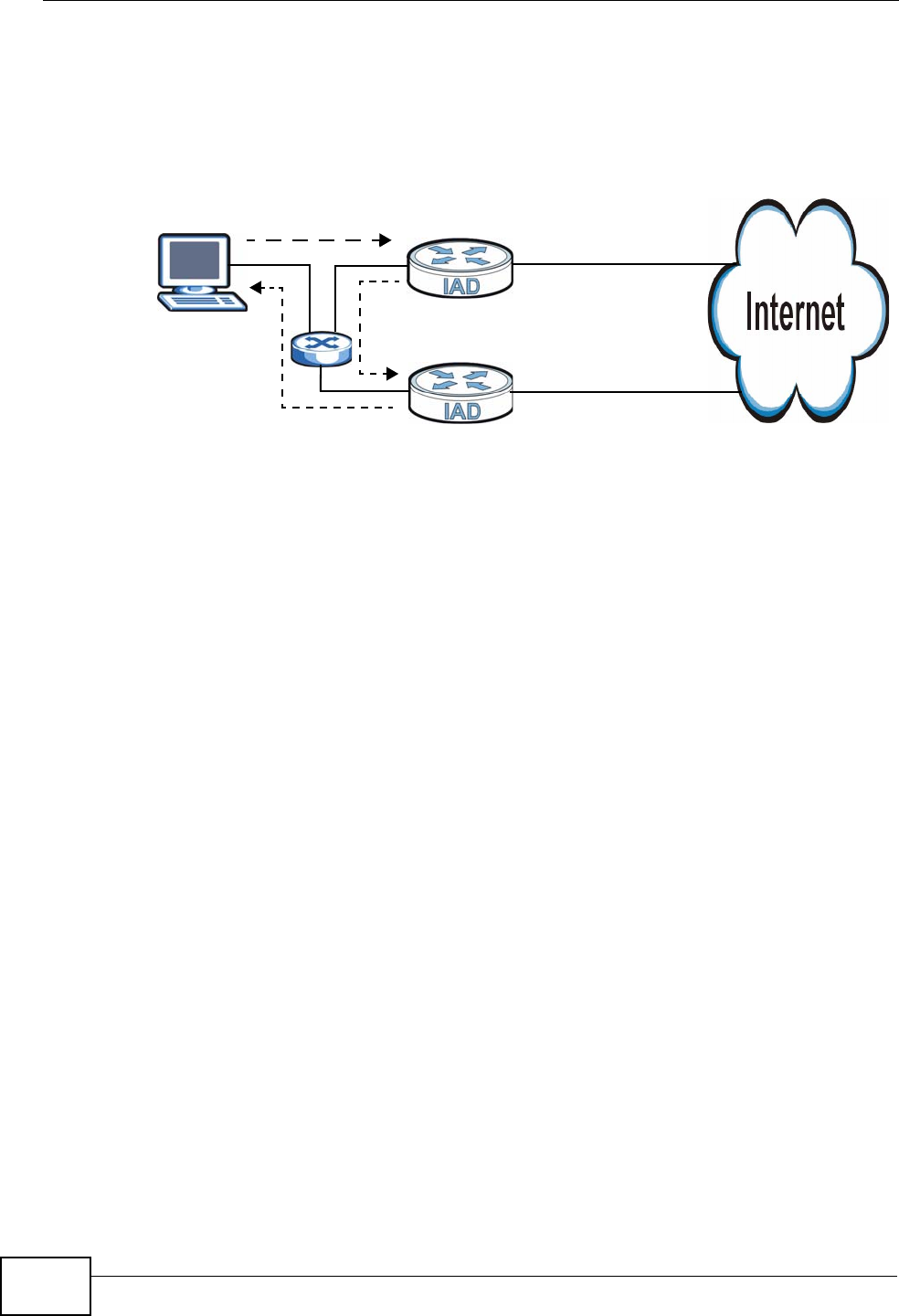
Chapter 12 Firewalls
IAD User’s Guide
156
As a result, the IAD resets the connection, as the connection has not been
acknowledged.
Figure 72 “Triangle Route” Problem
12.5.3.2 Solving the “Triangle Route” Problem
If you have the IAD allow triangle route sessions, traffic from the WAN can go
directly to a LAN computer without passing through the IAD and its firewall
protection.
Another solution is to use IP alias. IP alias allows you to partition your network
into logical sections over the same Ethernet interface. Your IAD supports up to
three logical LAN interfaces with the IAD being the gateway for each logical
network.
It’s like having multiple LAN networks that actually use the same physical cables
and ports. By putting your LAN and Gateway A in different subnets, all returning
network traffic must pass through the IAD to your LAN. The following steps
describe such a scenario.
1A computer on the LAN initiates a connection by sending a SYN packet to a
receiving server on the WAN.
2The IAD reroutes the packet to Gateway A, which is in Subnet 2.
3The reply from the WAN goes to the IAD.
1
2
3
WAN
LAN
A
ISP 1
ISP 2
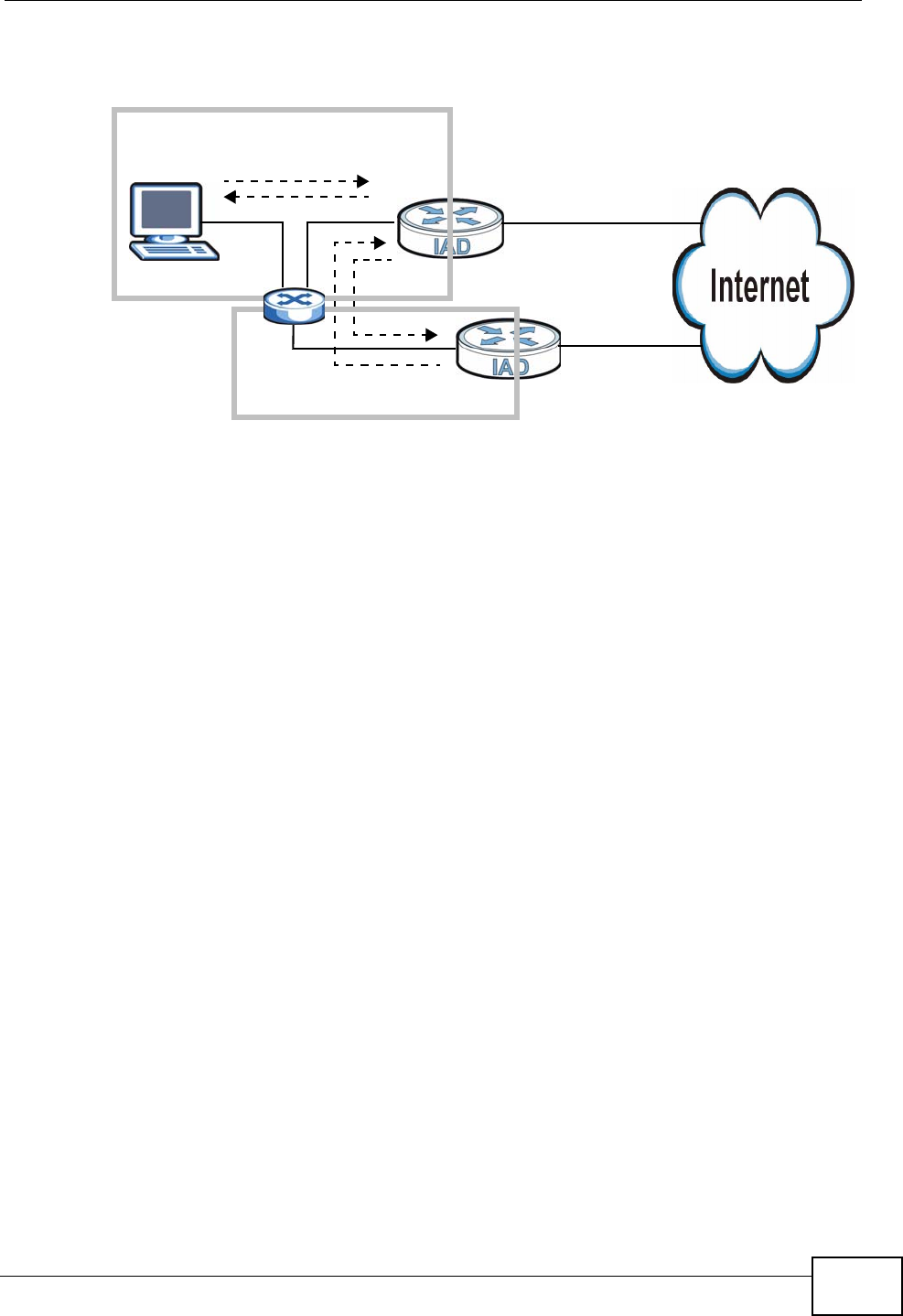
Chapter 12 Firewalls
IAD User’s Guide 157
4The IAD then sends it to the computer on the LAN in Subnet 1.
Figure 73 IP Alias
1
2
3
LAN
A
ISP 1
ISP 2
4
WAN
Subnet 1
Subnet 2

Chapter 12 Firewalls
IAD User’s Guide
158
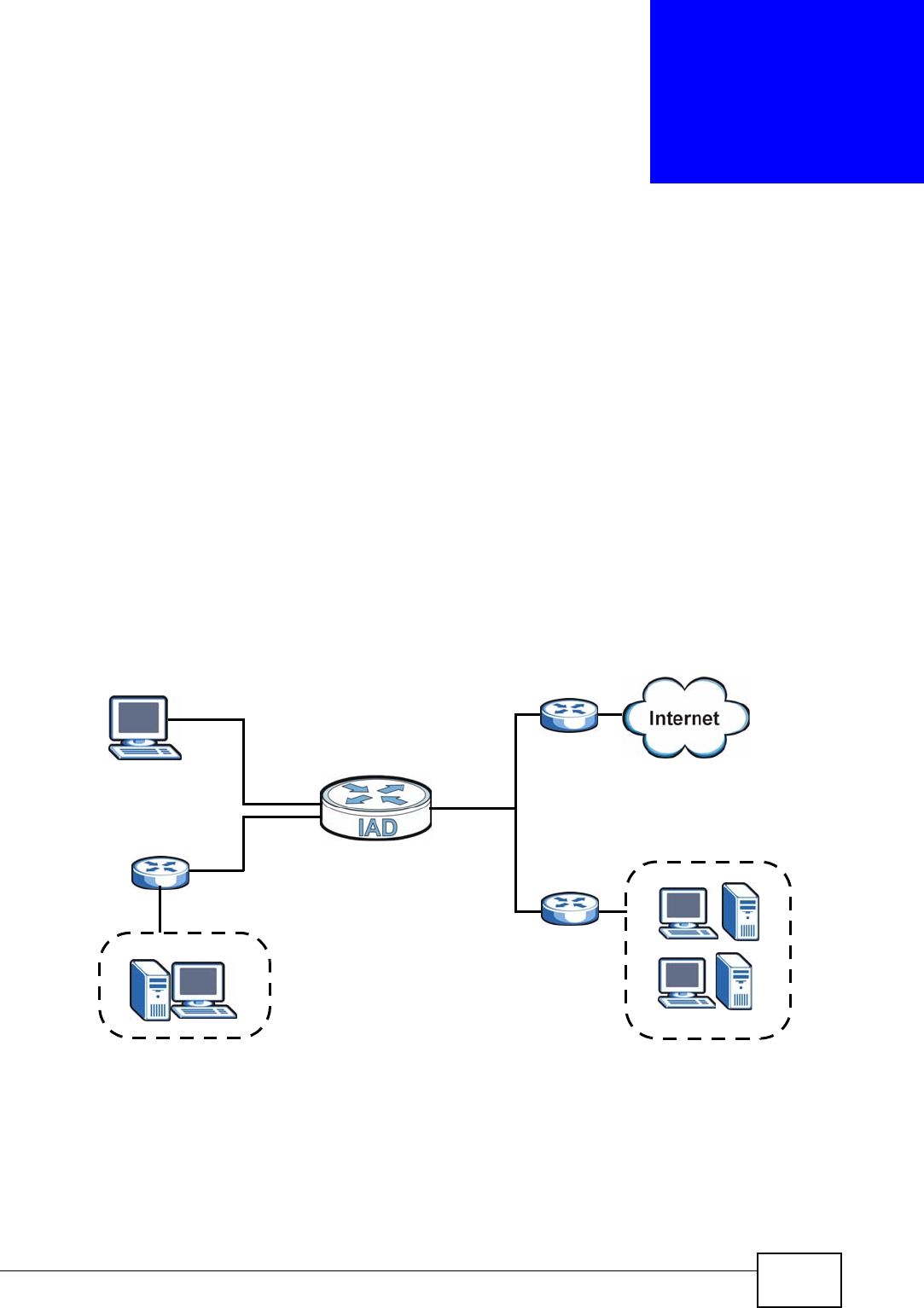
IAD User’s Guide 159
CHAPTER 13
Static Route
13.1 Overview
The IAD usually uses the default gateway to route outbound traffic from
computers on the LAN to the Internet. To have the IAD send data to devices not
reachable through the default gateway, use static routes.
For example, the next figure shows a computer (A) connected to the IAD’s LAN
interface. The IAD routes most traffic from A to the Internet through the IAD’s
default gateway (R1). You create one static route to connect to services offered by
your ISP behind router R2. You create another static route to communicate with a
separate network behind a router R3 connected to the LAN.
Figure 74 Example of Static Routing Topology
13.1.1 What You Can Do in this Chapter
The Static Route screens let you view and configure IP static routes on the IAD
(Section 13.2 on page 160).
WAN
R1
R2
A
R3
LAN
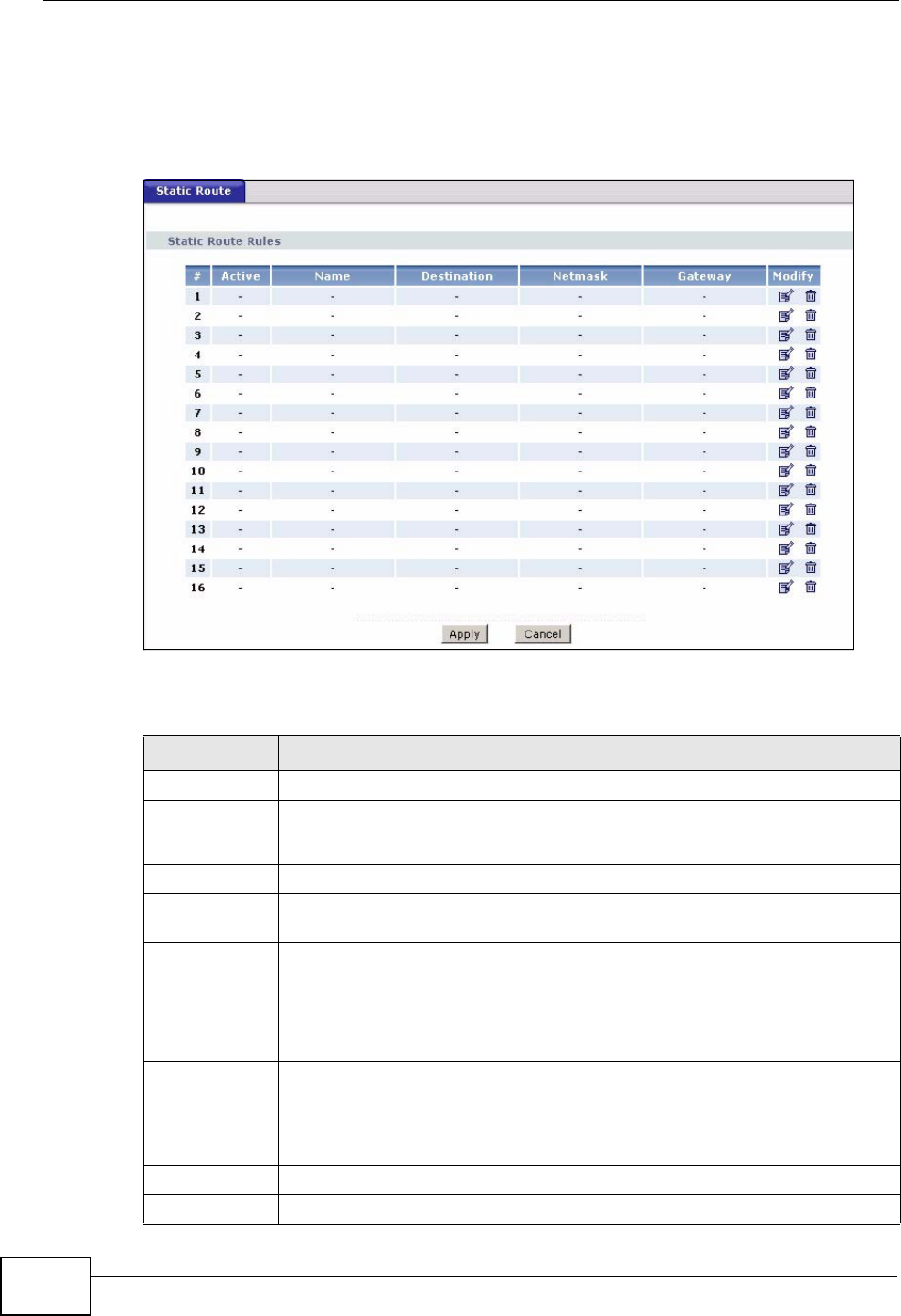
Chapter 13 Static Route
IAD User’s Guide
160
13.2 The Static Route Screen
Click Advanced > Static Route to open the Static Route screen.
Figure 75 Static Route
The following table describes the labels in this screen.
Table 49 Static Route
LABEL DESCRIPTION
#This is the number of an individual static route.
Active This field indicates whether the rule is active or not.
Clear the check box to disable the rule. Select the check box to enable it.
Name This is the name that describes or identifies this route.
Destination This parameter specifies the IP network address of the final destination.
Routing is always based on network number.
Netmask This parameter specifies the IP network subnet mask of the final
destination.
Gateway This is the IP address of the gateway. The gateway is a router or switch
on the same network segment as the device's LAN or WAN port. The
gateway helps forward packets to their destinations.
Modify Click the Edit icon to go to the screen where you can set up a static route
on the IAD.
Click the Remove icon to remove a static route from the IAD. A window
displays asking you to confirm that you want to delete the route.
Apply Click this to apply your changes to the IAD.
Cancel Click this to return to the previously saved configuration.
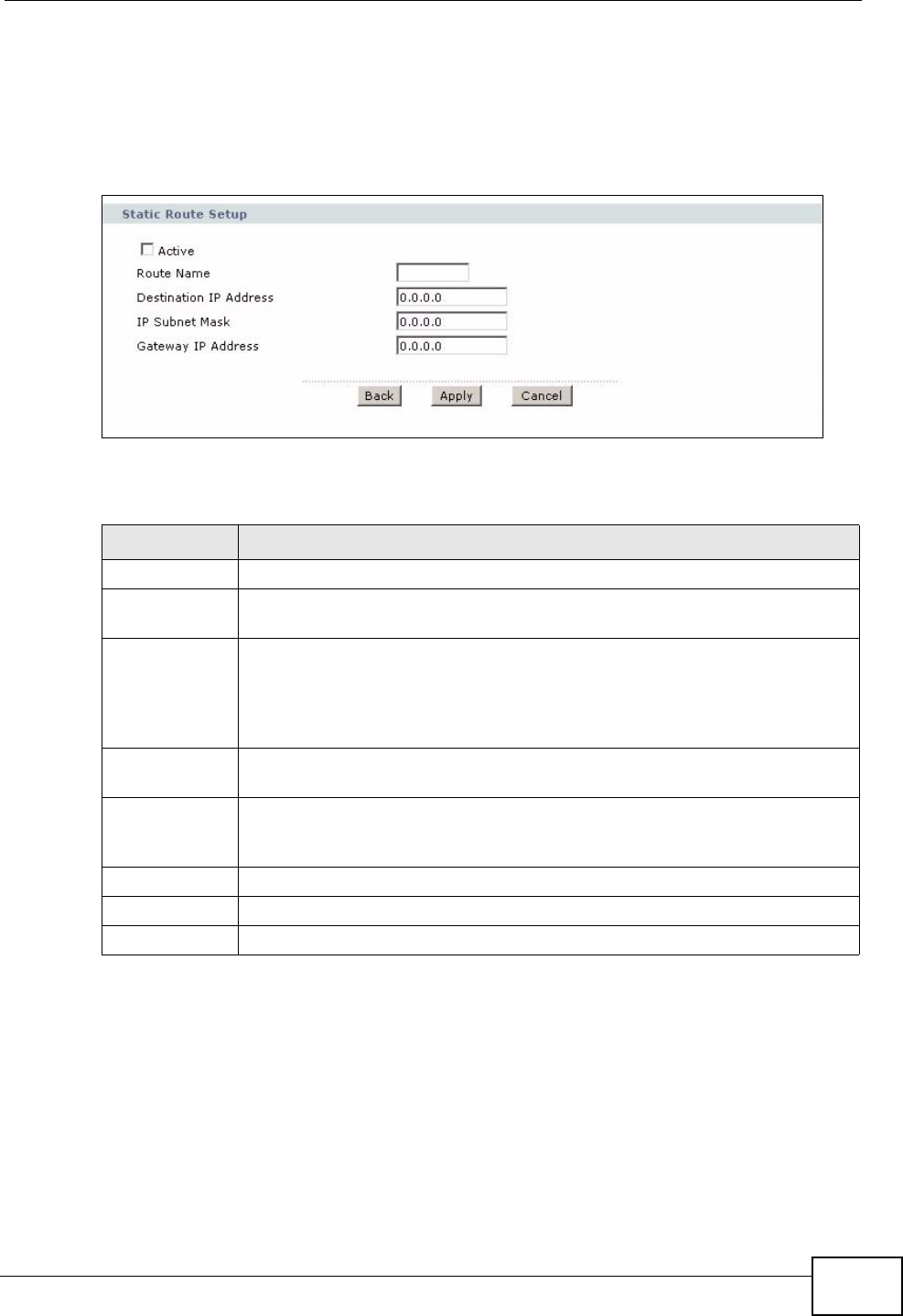
Chapter 13 Static Route
IAD User’s Guide 161
13.2.1 Static Route Edit
Select a static route index number and click Edit. The screen shown next appears.
Use this screen to configure the required information for a static route.
Figure 76 Static Route Edit
The following table describes the labels in this screen.
Table 50 Static Route Edit
LABEL DESCRIPTION
Active This field allows you to activate/deactivate this static route.
Route Name Enter the name of the IP static route. Leave this field blank to delete this
static route.
Destination IP
Address This parameter specifies the IP network address of the final destination.
Routing is always based on network number. If you need to specify a
route to a single host, use a subnet mask of 255.255.255.255 in the
subnet mask field to force the network number to be identical to the host
ID.
IP Subnet
Mask Enter the IP subnet mask here.
Gateway IP
Address Enter the IP address of the gateway. The gateway is a router or switch on
the same network segment as the device's LAN or WAN port. The
gateway helps forward packets to their destinations.
Back Click Back to return to the previous screen without saving.
Apply Click Apply to save your changes back to the IAD.
Cancel Click Cancel to begin configuring this screen afresh.

Chapter 13 Static Route
IAD User’s Guide
162

IAD User’s Guide 163
CHAPTER 14
Quality of Service (QoS)
14.1 Overview
Quality of Service (QoS) refers to both a network’s ability to deliver data with
minimum delay, and the networking methods used to control the use of
bandwidth. Without QoS, all traffic data is equally likely to be dropped when the
network is congested. This can cause a reduction in network performance and
make the network inadequate for time-critical application such as video-on-
demand.
Configure QoS on the IAD to group and prioritize application traffic and fine-tune
network performance. Setting up QoS involves these steps:
1Configure classifiers to sort traffic into different flows.
2Assign priority and define actions to be performed for a classified traffic flow.
The IAD assigns each packet a priority and then queues the packet accordingly.
Packets assigned a high priority are processed more quickly than those with low
priority if there is congestion, allowing time-sensitive applications to flow more
smoothly. Time-sensitive applications include both those that require a low level of
latency (delay) and a low level of jitter (variations in delay) such as Voice over IP
(VoIP) or Internet gaming, and those for which jitter alone is a problem such as
Internet radio or streaming video.
14.1.1 What You Can Do in this Chapter
•The General screen lets you lets you enable or disable QoS and set the
upstream bandwidth (Section 14.2 on page 164).
•The Class Setup screen lets you add, edit or delete QoS classifiers (Section
14.3 on page 166).
•The Monitor screen lets you view the IAD's QoS-related packet statistics
(Section 14.4 on page 175).

Chapter 14 Quality of Service (QoS)
IAD User’s Guide
164
14.1.2 What You Need to Know
The following terms and concepts may help as you read through this chapter.
QoS versus Cos
QoS is used to prioritize source-to-destination traffic flows. All packets in the same
flow are given the same priority. CoS (class of service) is a way of managing traffic
in a network by grouping similar types of traffic together and treating each type as
a class. You can use CoS to give different priorities to different packet types.
CoS technologies include IEEE 802.1p layer 2 tagging and DiffServ (Differentiated
Services or DS). IEEE 802.1p tagging makes use of three bits in the packet
header, while DiffServ is a new protocol and defines a new DS field, which replaces
the eight-bit ToS (Type of Service) field in the IP header.
Tagging and Marking
In a QoS class, you can configure whether to add or change the DSCP (DiffServ
Code Point) value, IEEE 802.1p priority level and VLAN ID number in a matched
packet. When the packet passes through a compatible network, the networking
device, such as a backbone switch, can provide specific treatment or service
based on the tag or marker.
14.2 The QoS General Screen
Click Advanced > QoS to open the screen as shown next.
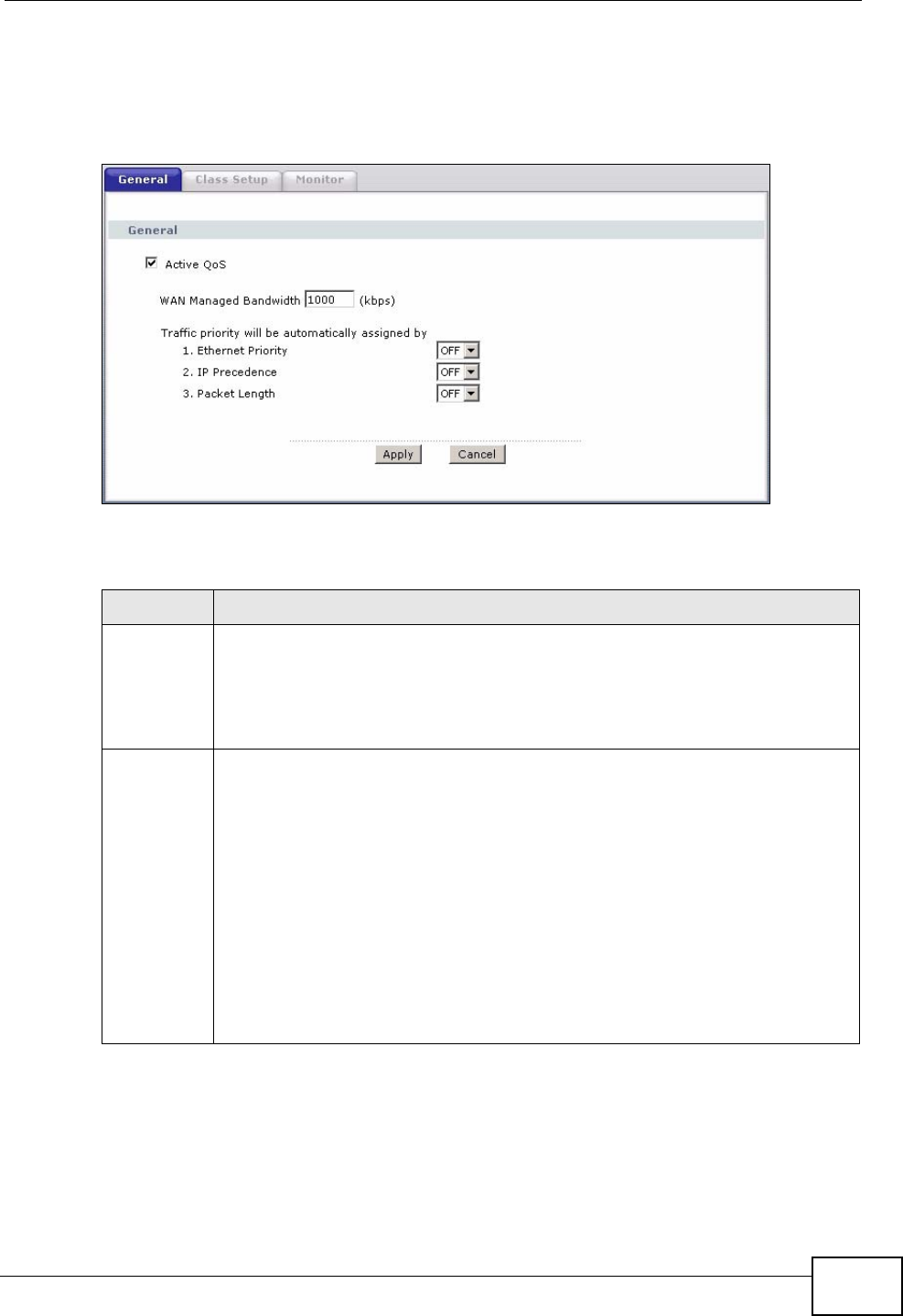
Chapter 14 Quality of Service (QoS)
IAD User’s Guide 165
Use this screen to enable or disable QoS, and select to have the IAD automatically
assign priority to traffic according to the IEEE 802.1p priority level, IP precedence
and/or packet length. See Section 14.1 on page 163 for more information.
Figure 77 QoS > General
The following table describes the labels in this screen.
Table 51 QoS > General
LABEL DESCRIPTION
Active QoS Select the check box to turn on QoS to improve your network performance.
You can give priority to traffic that the IAD forwards out through the WAN
interface. Give high priority to voice and video to make them run more
smoothly. Similarly, give low priority to many large file downloads so that
they do not reduce the quality of other applications.
WAN
Managed
Bandwidth
Enter the amount of bandwidth for the WAN interface that you want to
allocate using QoS.
The recommendation is to set this speed to match the interface’s actual
transmission speed. For example, set the WAN interface speed to 100000
kbps if your Internet connection has an upstream transmission speed of 100
Mbps.
You can set this number higher than the interface’s actual transmission
speed. This will stop lower priority traffic from being sent if higher priority
traffic uses all of the actual bandwidth.
You can also set this number lower than the interface’s actual transmission
speed. This will cause the IAD to not use some of the interface’s available
bandwidth.

Chapter 14 Quality of Service (QoS)
IAD User’s Guide
166
14.3 The Class Setup Screen
Use this screen to add, edit or delete classifiers. A classifier groups traffic into data
flows according to specific criteria such as the source address, destination
address, source port number, destination port number or incoming interface. For
example, you can configure a classifier to select traffic from the same protocol
port (such as Telnet) to form a flow.
Traffic
priority will
be
automatical
ly assigned
by
These fields are ignored if traffic matches a class you configured in the
Class Setup screen.
If you select ON and traffic does not match a class configured in the Class
Setup screen, the IAD assigns priority to unmatched traffic based on the
IEEE 802.1p priority level, IP precedence and/or packet length. See Section
14.5.4 on page 177 for more information.
If you select OFF, traffic which does not match a class is mapped to queue
two.
Apply Click Apply to save your settings back to the IAD.
Cancel Click Cancel to begin configuring this screen afresh.
Table 51 QoS > General
LABEL DESCRIPTION

Chapter 14 Quality of Service (QoS)
IAD User’s Guide 167
Click Advanced > QoS > Class Setup to open the following screen.
Figure 78 QoS > Class Setup
The following table describes the labels in this screen.
Table 52 QoS > Class Setup
LABEL DESCRIPTION
Create a new
Class Click Add to create a new classifier.
Order This is the number of each classifier. The ordering of the classifiers is
important as the classifiers are applied in turn.
Active Select the check box to enable this classifier.
Name This is the name of the classifier.
Interface This shows the interface from which traffic of this classifier should
come.
Priority This is the priority assigned to traffic of this classifier.
Filter Content This shows criteria specified in this classifier.
Modify Click the Edit icon to go to the screen where you can edit the classifier.
Click the Remove icon to delete an existing classifier.
Apply Click Apply to save your changes back to the IAD.
Cancel Click Cancel to begin configuring this screen afresh.
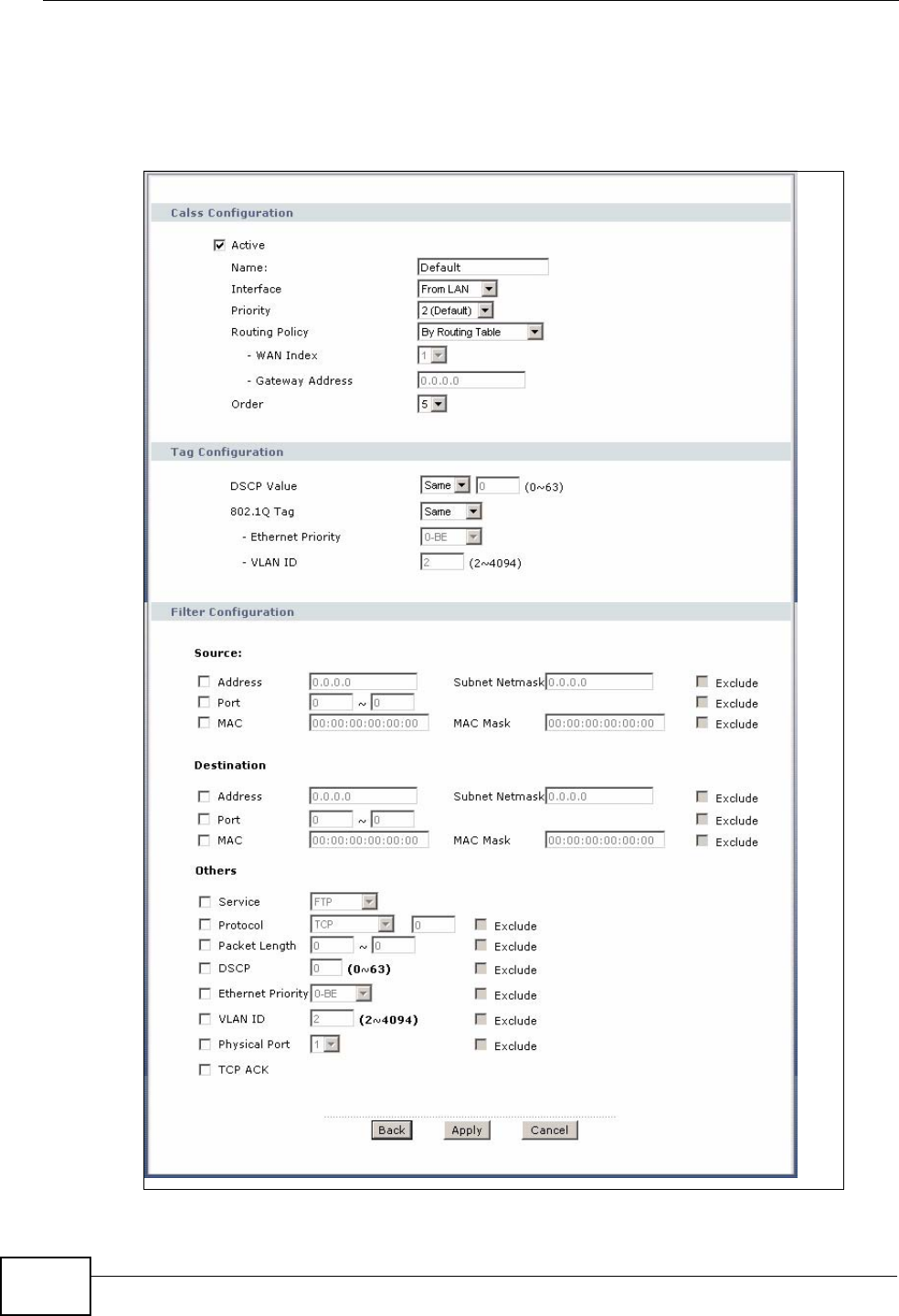
Chapter 14 Quality of Service (QoS)
IAD User’s Guide
168
14.3.1 Class Configuration
Click the Add button or the Edit icon in the Modify field to configure a classifier.
Figure 79 QoS Class Configuration

Chapter 14 Quality of Service (QoS)
IAD User’s Guide 169
See Appendix F on page 313 for a list of commonly-used services. The following
table describes the labels in this screen.
Table 53 QoS Class Configuration
LABEL DESCRIPTION
Class
Configuration
Active Select the check box to enable this classifier.
Name Enter a descriptive name of up to 20 printable English keyboard
characters, including spaces.
Interface Select from which interface traffic of this class should come.
Priority Select a priority level (between 0 and 7) or select Auto to have the
IAD map the matched traffic to a queue according to the internal QoS
mapping table. See Section 14.5.4 on page 177 for more information.
"0" is the lowest priority level and "7" is the highest.
Routing Policy Select the next hop to which traffic of this class should be forwarded.
Select By Routing Table to have the IAD use the routing table to find
a next hop and forward the matched packets automatically.
Select To Gateway Address to route the matched packets to the
router or switch you specified in the Gateway Address field.
WAN Index This field in not configurable at the time of writing.
Gateway
Address Enter the IP address of the gateway, which should be a router or
switch on the same segment as the IAD’s interface(s), that can
forward the packet to the destination.
Order This shows the ordering number of this classifier. Select an existing
number for where you want to put this classifier and click Apply to
move the classifier to the number you selected. For example, if you
select 2, the classifier you are moving becomes number 2 and the
previous classifier 2 gets pushed down one.
Tag Configuration
DSCP Value Select Same to keep the DSCP fields in the packets.
Select Auto to map the DSCP value to 802.1 priority level
automatically.
Select Mark to set the DSCP field with the value you configure in the
field provided.
802.1Q Tag Select Same to keep the priority setting and VLAN ID of the frames.
Select Auto to map the 802.1 priority level to the DSCP value
automatically.
Select Remove to delete the priority queue tag and VLAN ID of the
frames.
Select Mark to replace the 802.1 priority field and VLAN ID with the
value you set in the fields below.
Select Add to treat all matched traffic untagged and add a second
priority queue tag and VLAN.

Chapter 14 Quality of Service (QoS)
IAD User’s Guide
170
Ethernet
Priority Select a priority level (between 0 and 7) from the drop down list box.
VLAN ID Specify a VLAN ID number between 2 and 4094.
Filter
Configuration Use the following fields to configure the criteria for traffic
classification.
Source
Address Select the check box and enter the source IP address in dotted
decimal notation. A blank source IP address means any source IP
address.
Subnet
Netmask Enter the source subnet mask. Refer to the appendix for more
information on IP subnetting.
Port Select the check box and enter the port number of the source. 0
means any source port number. See Appendix F on page 313 for some
common services and port numbers.
MAC Select the check box and enter the source MAC address of the packet.
MAC Mask Type the mask for the specified MAC address to determine which bits
a packet’s MAC address should match.
Enter “f” for each bit of the specified source MAC address that the
traffic’s MAC address should match. Enter “0“ for the bit(s) of the
matched traffic’s MAC address, which can be of any hexadecimal
character(s). For example, if you set the MAC address to
00:13:49:00:00:00 and the mask to ff:ff:ff:00:00:00, a packet with a
MAC address of 00:13:49:12:34:56 matches this criteria.
Exclude Select this option to exclude the packets that match the specified
criteria from this classifier.
Destination
Address Select the check box and enter the destination IP address in dotted
decimal notation.
Subnet
Netmask Enter the destination subnet mask. Refer to the appendix for more
information on IP subnetting.
Port Select the check box and enter the port number of the destination. 0
means any source port number. See Appendix F on page 313 for some
common services and port numbers.
MAC Select the check box and enter the destination MAC address of the
packet.
MAC Mask Type the mask for the specified MAC address to determine which bits
a packet’s MAC address should match.
Enter “f” for each bit of the specified destination MAC address that the
traffic’s MAC address should match. Enter “0“ for the bit(s) of the
matched traffic’s MAC address, which can be of any hexadecimal
character(s). For example, if you set the MAC address to
00:13:49:00:00:00 and the mask to ff:ff:ff:00:00:00, a packet with a
MAC address of 00:13:49:12:34:56 matches this criteria.
Exclude Select this option to exclude the packets that match the specified
criteria from this classifier.
Others
Table 53 QoS Class Configuration (continued)
LABEL DESCRIPTION

Chapter 14 Quality of Service (QoS)
IAD User’s Guide 171
14.3.2 QoS Example
In the following figure, your Internet connection has an upstream transmission
speed of 50 Mbps. You configure a classifier to assign the highest priority queue
(6) to VoIP traffic from the LAN interface, so that voice traffic would not get
delayed when there is network congestion. Traffic from the boss’s IP address
(10.1.1.23 for example) is mapped to queue 5. Traffic that does not match these
Service This field simplifies classifier configuration by allowing you to select a
predefined application. When you select a predefined application, you
do not configure the rest of the filter fields.
SIP (Session Initiation Protocol) is a signaling protocol used in
Internet telephony, instant messaging and other VoIP (Voice over IP)
applications. Select the check box and select VoIP(SIP) from the
drop-down list box to configure this classifier for traffic that uses SIP.
File Transfer Protocol (FTP) is an Internet file transfer service that
operates on the Internet and over TCP/IP networks. A system running
the FTP server accepts commands from a system running an FTP
client. The service allows users to send commands to the server for
uploading and downloading files. Select the check box and select FTP
from the drop-down list box to configure this classifier for FTP traffic.
Protocol Select this option and select the protocol (TCP or UDP) or select User
defined and enter the protocol (service type) number. 0 means any
protocol number.
Packet Length Select this option and enter the minimum and maximum packet
length (from 28 to 1500) in the fields provided.
DSCP Select this option and specify a DSCP (DiffServ Code Point) number
between 0 and 63 in the field provided.
Ethernet Priority Select this option and select a priority level (between 0 and 7) from
the drop down list box.
"0" is the lowest priority level and "7" is the highest.
VLAN ID Select this option and specify a VLAN ID number between 2 and 4094.
Physical Port Select this option and select a LAN port.
Exclude Select this option to exclude the packets that match the specified
criteria from this classifier.
TCP ACK Select this option to set this classifier for TCP ACK (acknowledgement)
packets.
Back Click Back to go to the previous screen.
Apply Click Apply to save your changes back to the IAD.
Cancel Click Cancel to begin configuring this screen afresh.
Table 53 QoS Class Configuration (continued)
LABEL DESCRIPTION
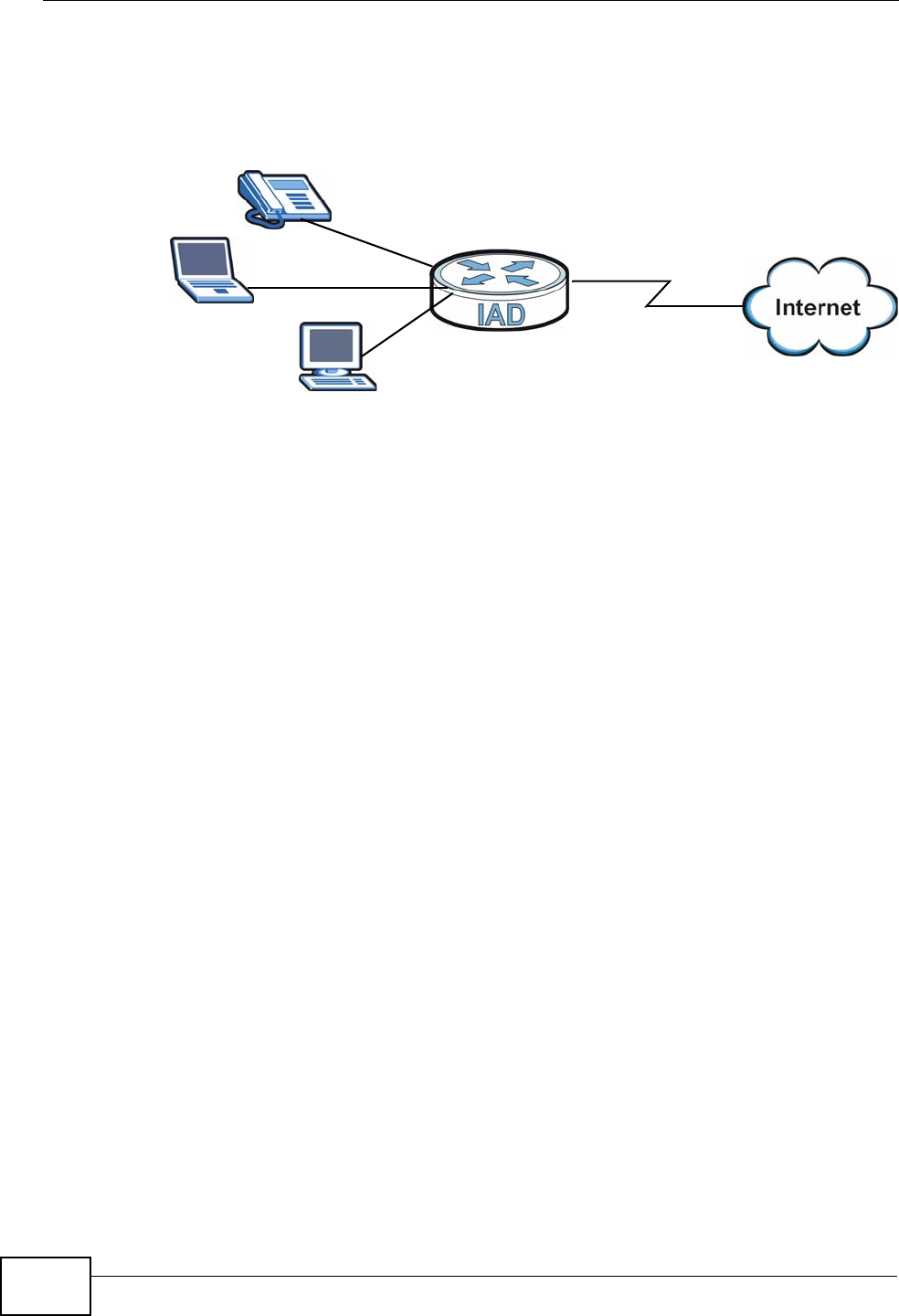
Chapter 14 Quality of Service (QoS)
IAD User’s Guide
172
two classes are assigned priority queue based on the internal QoS mapping table
on the IAD.
Figure 80 QoS Example
50 Mbps
Ethernet
VoIP: Queue 6
Boss: Queue 5
IP=10.1.1.23
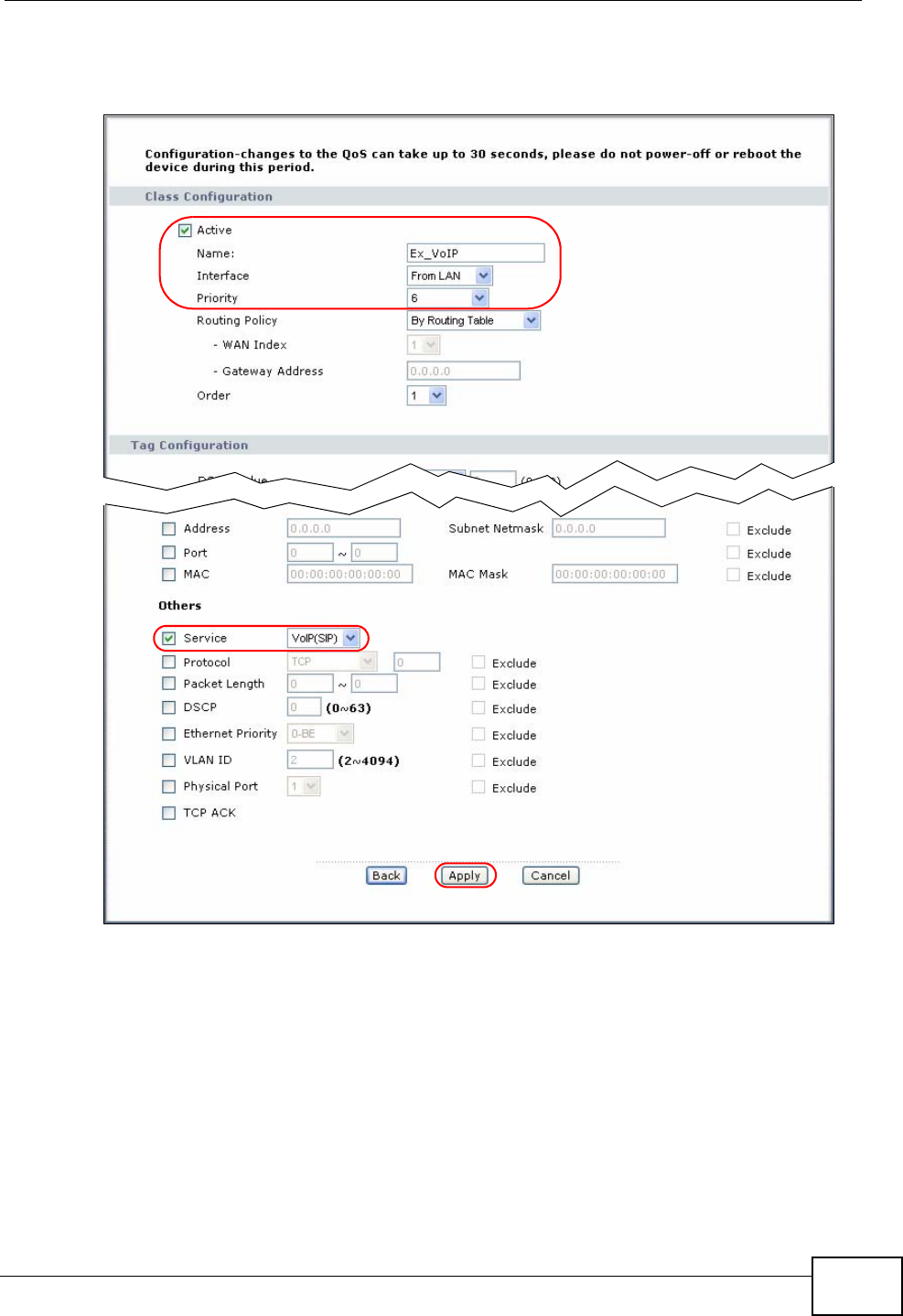
Chapter 14 Quality of Service (QoS)
IAD User’s Guide 173
Figure 81 QoS Class Example: VoIP
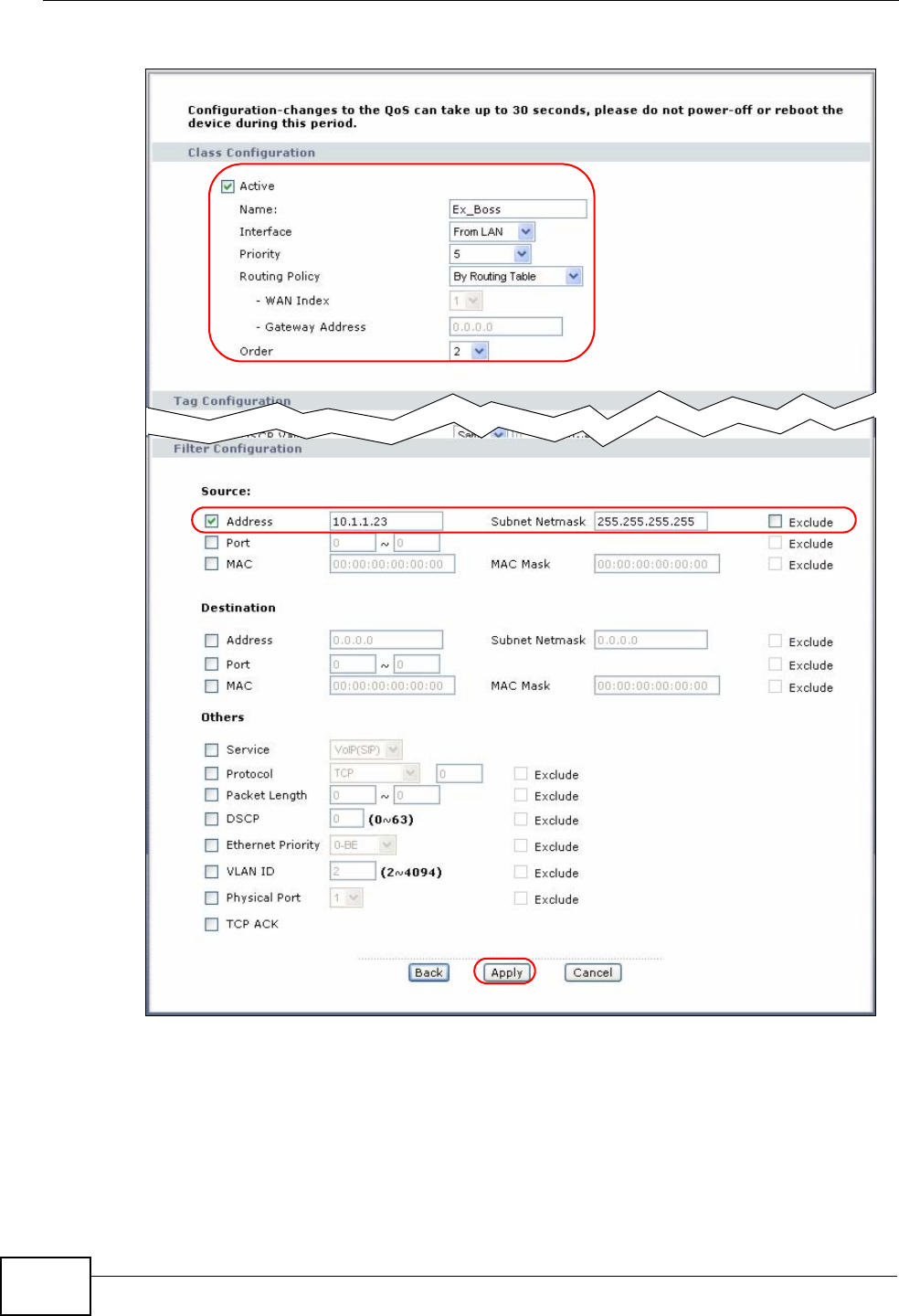
Chapter 14 Quality of Service (QoS)
IAD User’s Guide
174
Figure 82 QoS Class Example: Boss
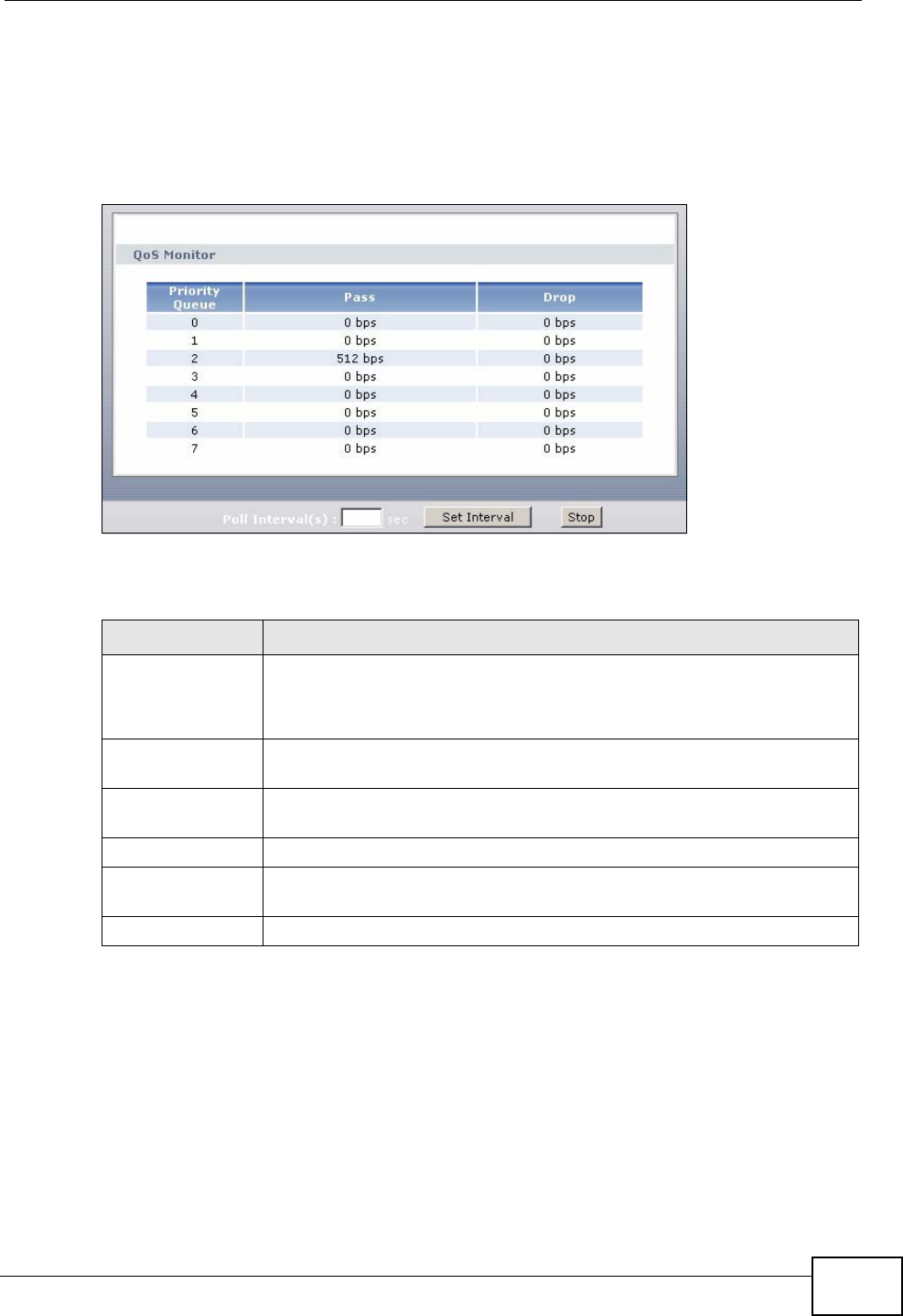
Chapter 14 Quality of Service (QoS)
IAD User’s Guide 175
14.4 The QoS Monitor Screen
To view the IAD’s QoS packet statistics, click Advanced > QoS > Monitor. The
screen appears as shown.
Figure 83 QoS Monitor
The following table describes the labels in this screen.
14.5 Technical Reference
The following section contains additional technical information about the IAD
features described in this chapter.
Table 54 QoS Monitor
LABEL DESCRIPTION
Priority Queue This shows the priority queue number.
Traffic assigned to higher index queues gets through faster while
traffic in lower index queues is dropped if the network is congested.
Pass This shows how many packets mapped to this priority queue are
transmitted successfully.
Drop This shows how many packets mapped to this priority queue are
dropped.
Poll Interval(s) Enter the time interval for refreshing statistics in this field.
Set Interval Click this button to apply the new poll interval you entered in the Poll
Interval(s) field.
Stop Click Stop to stop refreshing statistics.

Chapter 14 Quality of Service (QoS)
IAD User’s Guide
176
14.5.1 IEEE 802.1Q Tag
The IEEE 802.1Q standard defines an explicit VLAN tag in the MAC header to
identify the VLAN membership of a frame across bridges. A VLAN tag includes the
12-bit VLAN ID and 3-bit user priority. The VLAN ID associates a frame with a
specific VLAN and provides the information that devices need to process the frame
across the network.
IEEE 802.1p specifies the user priority field and defines up to eight separate traffic
types. The following table describes the traffic types defined in the IEEE 802.1d
standard (which incorporates the 802.1p).
14.5.2 IP Precedence
Similar to IEEE 802.1p prioritization at layer-2, you can use IP precedence to
prioritize packets in a layer-3 network. IP precedence uses three bits of the eight-
bit ToS (Type of Service) field in the IP header. There are eight classes of services
(ranging from zero to seven) in IP precedence. Zero is the lowest priority level and
seven is the highest.
14.5.3 DiffServ
QoS is used to prioritize source-to-destination traffic flows. All packets in the flow
are given the same priority. You can use CoS (class of service) to give different
priorities to different packet types.
Table 55 IEEE 802.1p Priority Level and Traffic Type
PRIORITY
LEVEL TRAFFIC TYPE
Level 7 Typically used for network control traffic such as router configuration
messages.
Level 6 Typically used for voice traffic that is especially sensitive to jitter (jitter is the
variations in delay).
Level 5 Typically used for video that consumes high bandwidth and is sensitive to
jitter.
Level 4 Typically used for controlled load, latency-sensitive traffic such as SNA
(Systems Network Architecture) transactions.
Level 3 Typically used for “excellent effort” or better than best effort and would
include important business traffic that can tolerate some delay.
Level 2 This is for “spare bandwidth”.
Level 1 This is typically used for non-critical “background” traffic such as bulk
transfers that are allowed but that should not affect other applications and
users.
Level 0 Typically used for best-effort traffic.

Chapter 14 Quality of Service (QoS)
IAD User’s Guide 177
DiffServ (Differentiated Services) is a class of service (CoS) model that marks
packets so that they receive specific per-hop treatment at DiffServ-compliant
network devices along the route based on the application types and traffic flow.
Packets are marked with DiffServ Code Points (DSCPs) indicating the level of
service desired. This allows the intermediary DiffServ-compliant network devices
to handle the packets differently depending on the code points without the need to
negotiate paths or remember state information for every flow. In addition,
applications do not have to request a particular service or give advanced notice of
where the traffic is going.
14.5.3.1 DSCP and Per-Hop Behavior
DiffServ defines a new DS (Differentiated Services) field to replace the Type of
Service (TOS) field in the IP header. The DS field contains a 2-bit unused field and
a 6-bit DSCP field which can define up to 64 service levels. The following figure
illustrates the DS field.
DSCP is backward compatible with the three precedence bits in the ToS octet so
that non-DiffServ compliant, ToS-enabled network device will not conflict with the
DSCP mapping.
The DSCP value determines the forwarding behavior, the PHB (Per-Hop Behavior),
that each packet gets across the DiffServ network. Based on the marking rule,
different kinds of traffic can be marked for different kinds of forwarding. Resources
can then be allocated according to the DSCP values and the configured policies.
14.5.4 Automatic Priority Queue Assignment
If you enable QoS on the IAD, the IAD can automatically base on the IEEE 802.1p
priority level, IP precedence and/or packet length to assign priority to traffic which
does not match a class.
The following table shows you the internal layer-2 and layer-3 QoS mapping on
the IAD. On the IAD, traffic assigned to higher priority queues gets through faster
while traffic in lower index queues is dropped if the network is congested.
DSCP (6 bits) Unused (2 bits)
Table 56 Internal Layer2 and Layer3 QoS Mapping
PRIORITY
QUEUE
LAYER 2 LAYER 3
IEEE 802.1P
USER PRIORITY
(ETHERNET
PRIORITY)
TOS (IP
PRECEDENCE) DSCP IP PACKET
LENGTH (BYTE)
0 1 0 000000
12

Chapter 14 Quality of Service (QoS)
IAD User’s Guide
178
2 0 0 000000 >1100
3 3 1 001110
001100
001010
001000
250~1100
4 4 2 010110
010100
010010
010000
5 5 3 011110
011100
011010
011000
<250
6 6 4 100110
100100
100010
100000
5 101110
101000
7 7 6 110000
111000
7
Table 56 Internal Layer2 and Layer3 QoS Mapping
PRIORITY
QUEUE
LAYER 2 LAYER 3
IEEE 802.1P
USER PRIORITY
(ETHERNET
PRIORITY)
TOS (IP
PRECEDENCE) DSCP IP PACKET
LENGTH (BYTE)

IAD User’s Guide 179
CHAPTER 15
Dynamic DNS Setup
15.1 Overview
Dynamic DNS allows you to update your current dynamic IP address with one or
many dynamic DNS services so that anyone can contact you (in NetMeeting, CU-
SeeMe, etc.). You can also access your FTP server or Web site on your own
computer using a domain name (for instance myhost.dhs.org, where myhost is a
name of your choice) that will never change instead of using an IP address that
changes each time you reconnect. Your friends or relatives will always be able to
call you even if they don't know your IP address.
First of all, you need to have registered a dynamic DNS account with
www.dyndns.org. This is for people with a dynamic IP from their ISP or DHCP
server that would still like to have a domain name. The Dynamic DNS service
provider will give you a password or key.
15.1.1 What You Can Do in this Chapter
Use the Dynamic DNS screen (Section 15.2 on page 180) to enable DDNS and
configure the DDNS settings on the IAD.
15.1.2 What You Need To Know
DYNDNS Wildcard
Enabling the wildcard feature for your host causes *.yourhost.dyndns.org to be
aliased to the same IP address as yourhost.dyndns.org. This feature is useful if
you want to be able to use, for example, www.yourhost.dyndns.org and still reach
your hostname.
If you have a private WAN IP address, then you cannot use Dynamic DNS.
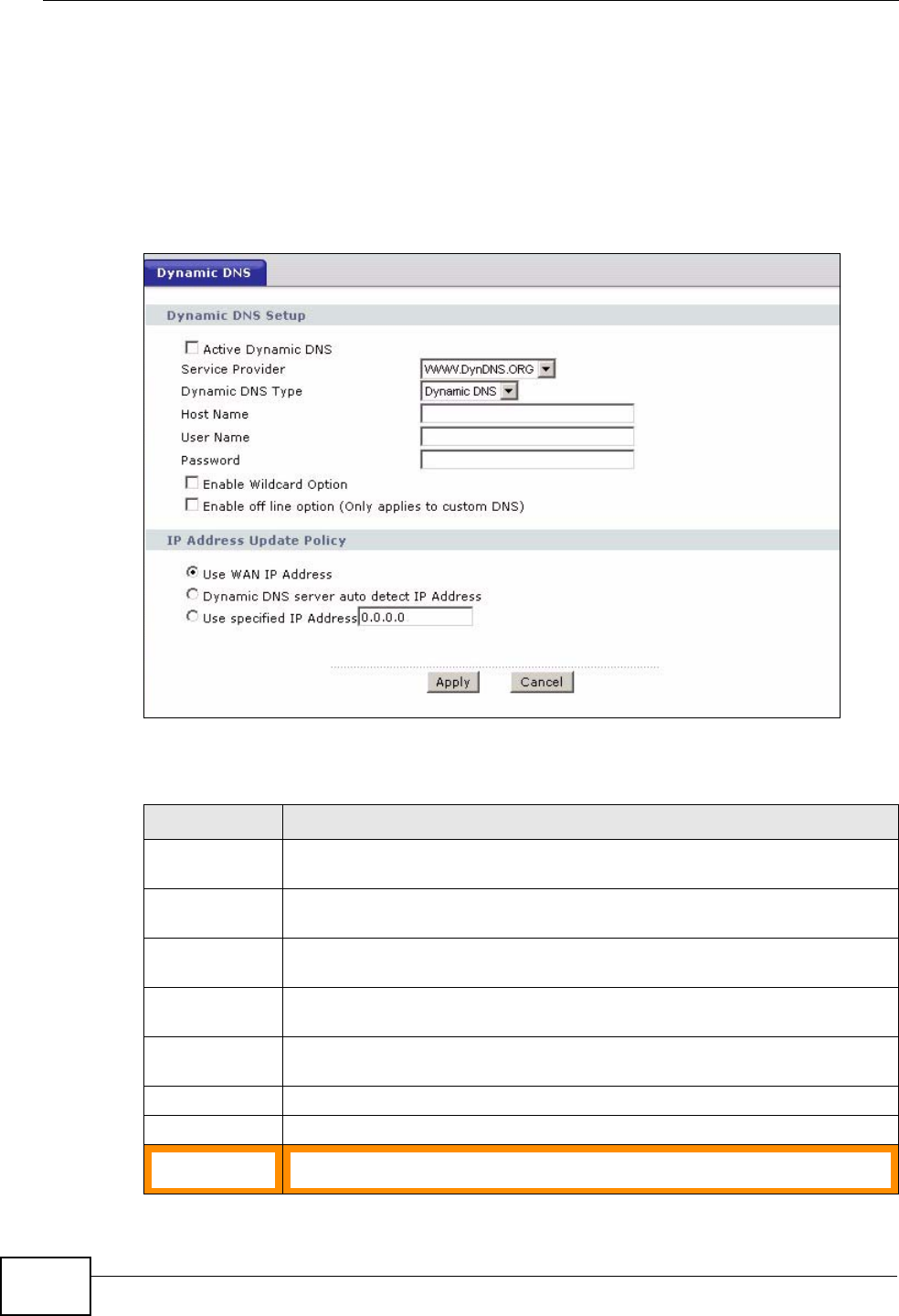
Chapter 15 Dynamic DNS Setup
IAD User’s Guide
180
15.2 The Dynamic DNS Screen
To change your IAD’s DDNS, click Advanced > Dynamic DNS. The screen
appears as shown.
See Section 15.1 on page 179 for more information.
Figure 84 Dynamic DNS
The following table describes the fields in this screen.
Table 57 Dynamic DNS
LABEL DESCRIPTION
Dynamic DNS
Setup
Active
Dynamic DNS Select this check box to use dynamic DNS.
Service
Provider Select the name of your Dynamic DNS service provider.
Dynamic DNS
Type Select the type of service that you are registered for from your Dynamic
DNS service provider.
Host Name Type the domain name assigned to your IAD by your Dynamic DNS
provider.
User Name Type your user name.
Password Type the password assigned to you.
Email Address If you select WWW.No-IP.com or WWW.TZO.com in the Service
Provider field, enter the user name you used to register for this service.

Chapter 15 Dynamic DNS Setup
IAD User’s Guide 181
Key If you select WWW.TZO.com in the Service Provider field, enter the
password you used to register for this service.
Enable
Wildcard
Option
Select the check box to enable DynDNS Wildcard.
Enable off line
option This option is available when CustomDNS is selected in the DDNS Type
field. Check with your Dynamic DNS service provider to have traffic
redirected to a URL (that you can specify) while you are off line.
IP Address
Update Policy
Use WAN IP
Address Select this option to update the IP address of the host name to the WAN
IP address.
Dynamic DNS
server auto
detect IP
Address
Select this option only when there are one or more NAT routers between
the IAD and the DDNS server. This feature has the DDNS server
automatically detect and use the IP address of the NAT router that has a
public IP address.
Note: The DDNS server may not be able to detect the proper IP
address if there is an HTTP proxy server between the IAD and
the DDNS server.
Use specified
IP Address Type the IP address of the host name. Use this if you have a static IP
address.
Apply Click Apply to save your changes back to the IAD.
Cancel Click Cancel to begin configuring this screen afresh.
Table 57 Dynamic DNS (continued)
LABEL DESCRIPTION

Chapter 15 Dynamic DNS Setup
IAD User’s Guide
182
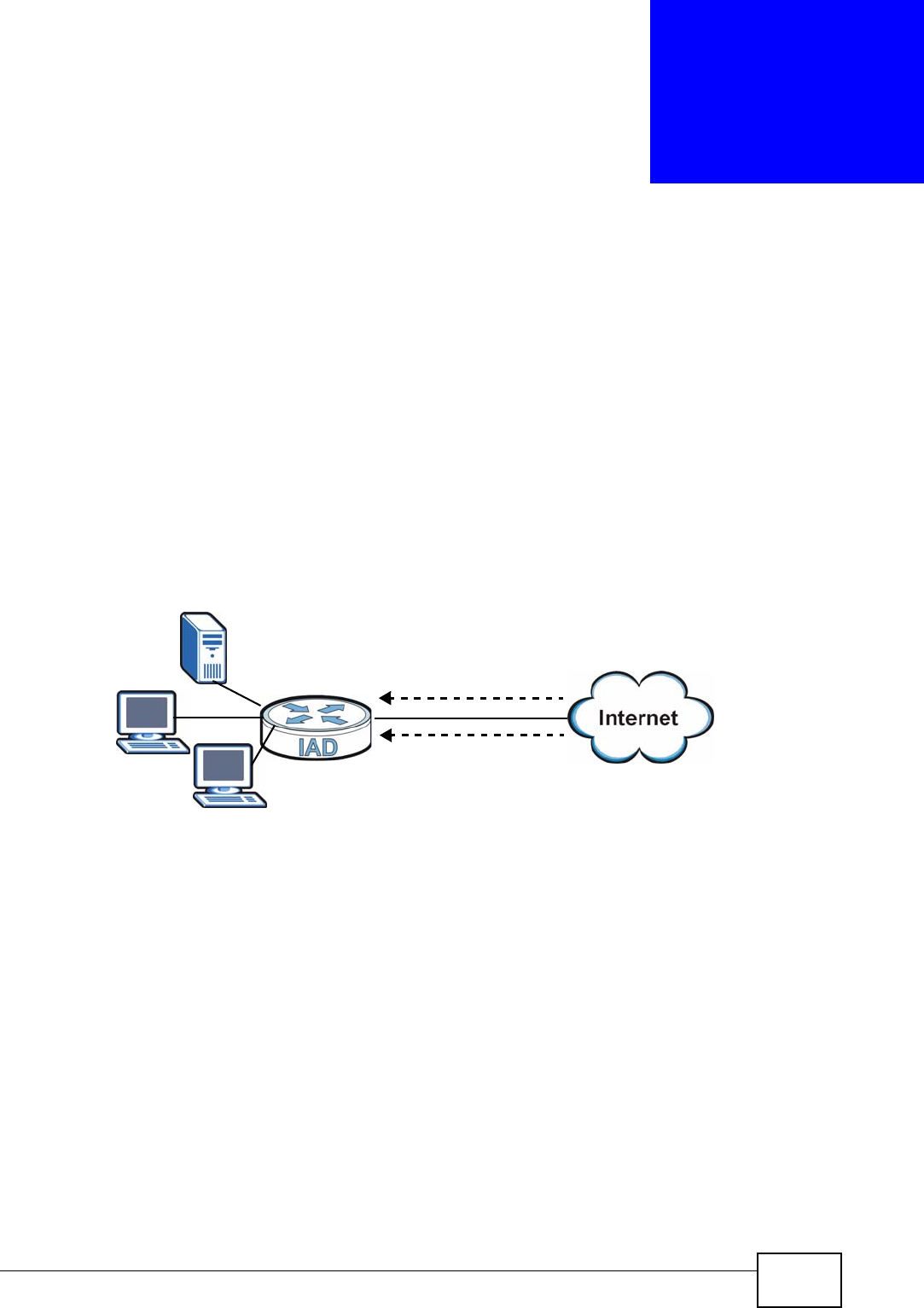
IAD User’s Guide 183
CHAPTER 16
Remote Management
16.1 Overview
Remote management allows you to determine which services/protocols can access
which IAD interface (if any) from which computers.
The following figure shows remote management of the IAD coming in from the
WAN.
Figure 85 Remote Management From the WAN
Note: When you configure remote management to allow management from the WAN,
you still need to configure a firewall rule to allow access.
You may manage your IAD from a remote location via:
•Internet (WAN only)
•ALL (LAN and WAN)
•LAN only,
• Neither (Disable).
Note: When you choose WAN only or LAN & WAN, you still need to configure a
firewall rule to allow access.
To disable remote management of a service, select Disable in the corresponding
Access Status field.
LAN WAN
HTTP
Telnet

Chapter 16 Remote Management
IAD User’s Guide
184
You may only have one remote management session running at a time. The IAD
automatically disconnects a remote management session of lower priority when
another remote management session of higher priority starts. The priorities for
the different types of remote management sessions are as follows.
1SSH
2Telnet
3HTTP
16.1.1 What You Can Do in this Chapter
•Use the WWW screen (Section 16.2 on page 185) to configure through which
interface(s) and from which IP address(es) users can use HTTP to manage the
IAD.
•Use the Telnet screen (Section 16.3 on page 186) to configure through which
interface(s) and from which IP address(es) users can use Telnet to manage the
IAD.
•Use the FTP screen (Section 16.4 on page 187) to configure through which
interface(s) and from which IP address(es) users can use FTP to access the IAD.
•Use the SNMP screen (Section 16.5.3 on page 190) to configure your IAD’s
settings for Simple Network Management Protocol management.
•Use the DNS screen (Section 16.6 on page 191) to configure through which
interface(s) and from which IP address(es) users can send DNS queries to the
IAD.
•Use the ICMP screen (Section 16.7 on page 192) to set whether or not your
IAD will respond to pings and probes for services that you have not made
available.
•Use the SSH screen (Section 16.11 on page 195) to change your IAD’s Secure
Shell settings.
•Use the TR-069 screen
16.1.2 What You Need to Know
Remote Management Limitations
Remote management does not work when:
• You have not enabled that service on the interface in the corresponding remote
management screen.
• You have disabled that service in one of the remote management screens.
• The IP address in the Secured Client IP field does not match the client IP
address. If it does not match, the IAD will disconnect the session immediately.

Chapter 16 Remote Management
IAD User’s Guide 185
• There is already another remote management session with an equal or higher
priority running. You may only have one remote management session running
at one time.
• There is a firewall rule that blocks it.
Remote Management and NAT
When NAT is enabled:
• Use the IAD’s WAN IP address when configuring from the WAN.
• Use the IAD’s LAN IP address when configuring from the LAN.
System Timeout
There is a default system management idle timeout of five minutes (three
hundred seconds). The IAD automatically logs you out if the management session
remains idle for longer than this timeout period. The management session does
not time out when a statistics screen is polling.
16.2 The HTTP Screen
To change your IAD’s World Wide Web settings, click Advanced > Remote MGMT
to display the WWW screen.
Figure 86 Remote Management > HTTP
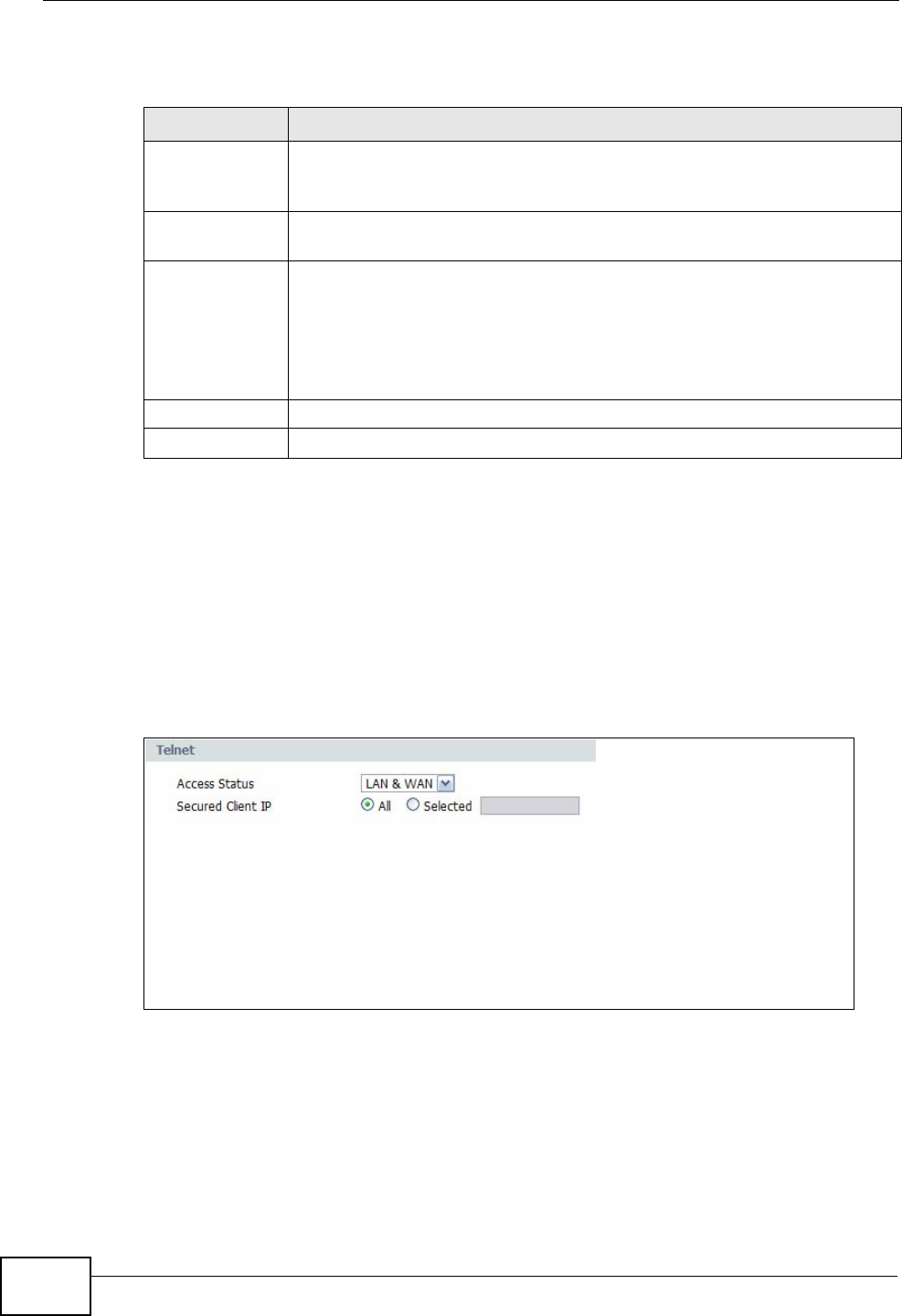
Chapter 16 Remote Management
IAD User’s Guide
186
The following table describes the labels in this screen.
16.3 The Telnet Screen
You can use Telnet to access the IAD’s command line interface. Specify which
interfaces allow Telnet access and from which IP address the access can come.
Click Advanced > Remote MGMT > Telnet to display the screen as shown.
Figure 87 Remote Management > Telnet
Table 58 Remote Management > WWW
LABEL DESCRIPTION
Port You may change the server port number for a service if needed,
however you must use the same port number in order to use that
service for remote management.
Access Status Select the interface(s) through which a computer may access the IAD
using this service.
Secured Client
IP A secured client is a “trusted” computer that is allowed to communicate
with the IAD using this service.
Select All to allow any computer to access the IAD using this service.
Choose Selected to just allow the computer with the IP address that
you specify to access the IAD using this service.
Apply Click Apply to save your settings back to the IAD.
Cancel Click Cancel to begin configuring this screen afresh.
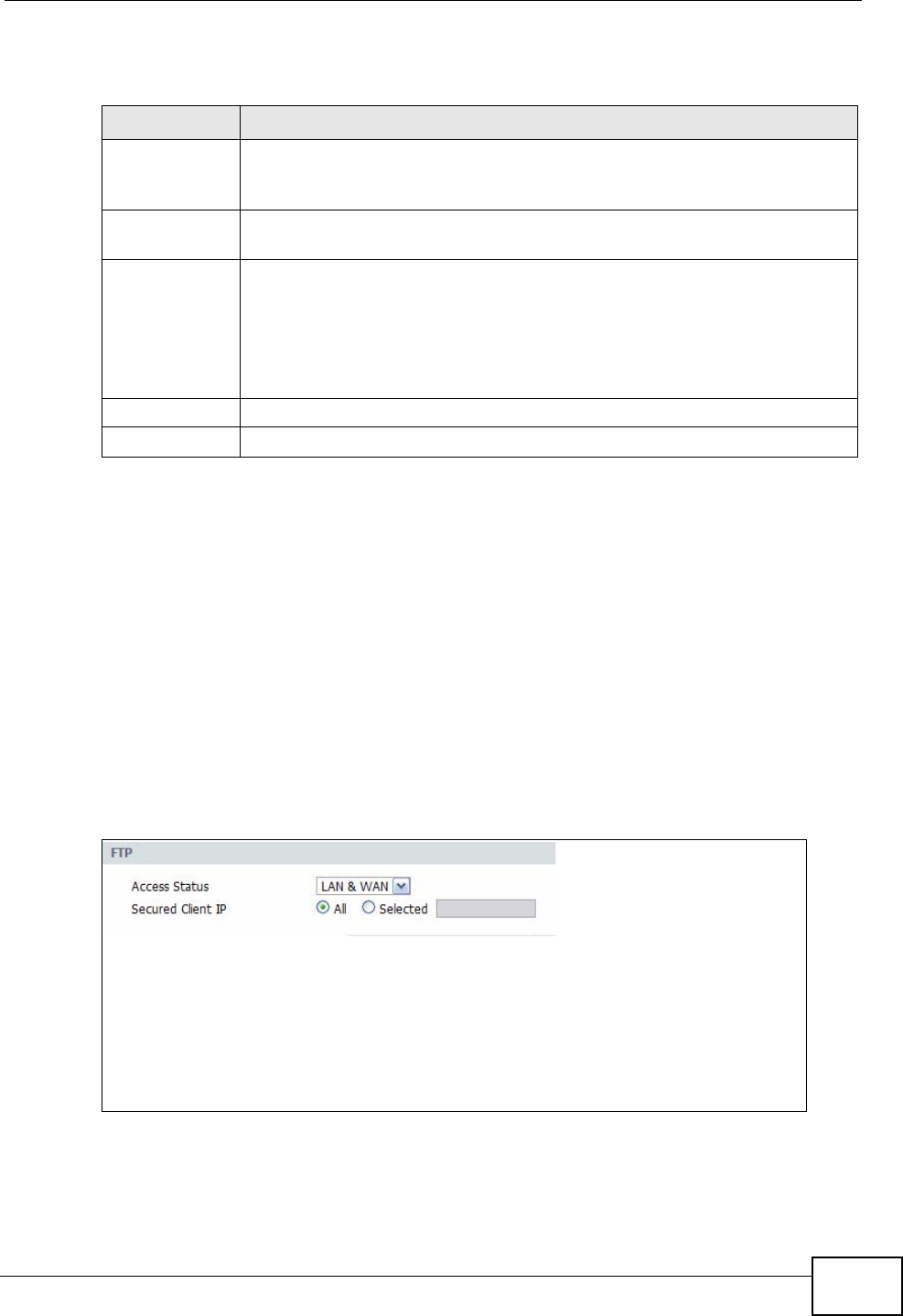
Chapter 16 Remote Management
IAD User’s Guide 187
The following table describes the labels in this screen.
16.4 The FTP Screen
You can use FTP (File Transfer Protocol) to upload and download the IAD’s
firmware and configuration files, please see the User’s Guide chapter on firmware
and configuration file maintenance for details. To use this feature, your computer
must have an FTP client.
To change your IAD’s FTP settings, click Advanced > Remote MGMT > FTP. The
screen appears as shown. Use this screen to specify which interfaces allow FTP
access and from which IP address the access can come.
Figure 88 Remote Management > FTP
Table 59 Remote Management > Telnet
LABEL DESCRIPTION
Port You may change the server port number for a service if needed, however
you must use the same port number in order to use that service for
remote management.
Access Status Select the interface(s) through which a computer may access the IAD
using this service.
Secured Client
IP A secured client is a “trusted” computer that is allowed to communicate
with the IAD using this service.
Select All to allow any computer to access the IAD using this service.
Choose Selected to just allow the computer with the IP address that you
specify to access the IAD using this service.
Apply Click Apply to save your customized settings and exit this screen.
Cancel Click Cancel to begin configuring this screen afresh.

Chapter 16 Remote Management
IAD User’s Guide
188
The following table describes the labels in this screen.
16.5 SNMP
Simple Network Management Protocol (SNMP) is a protocol used for exchanging
management information between network devices. SNMP is a member of the
TCP/IP protocol suite. Your IAD supports SNMP agent functionality, which allows a
manager station to manage and monitor the IAD through the network. The IAD
supports SNMP version one (SNMPv1) and version two (SNMPv2). The next figure
illustrates an SNMP management operation.
Table 60 Remote Management > FTP
LABEL DESCRIPTION
Port You may change the server port number for a service if needed,
however you must use the same port number in order to use that
service for remote management.
Access Status Select the interface(s) through which a computer may access the IAD
using this service.
Secured Client
IP A secured client is a “trusted” computer that is allowed to communicate
with the IAD using this service.
Select All to allow any computer to access the IAD using this service.
Choose Selected to just allow the computer with the IP address that
you specify to access the IAD using this service.
Apply Click Apply to save your customized settings and exit this screen.
Cancel Click Cancel to begin configuring this screen afresh.
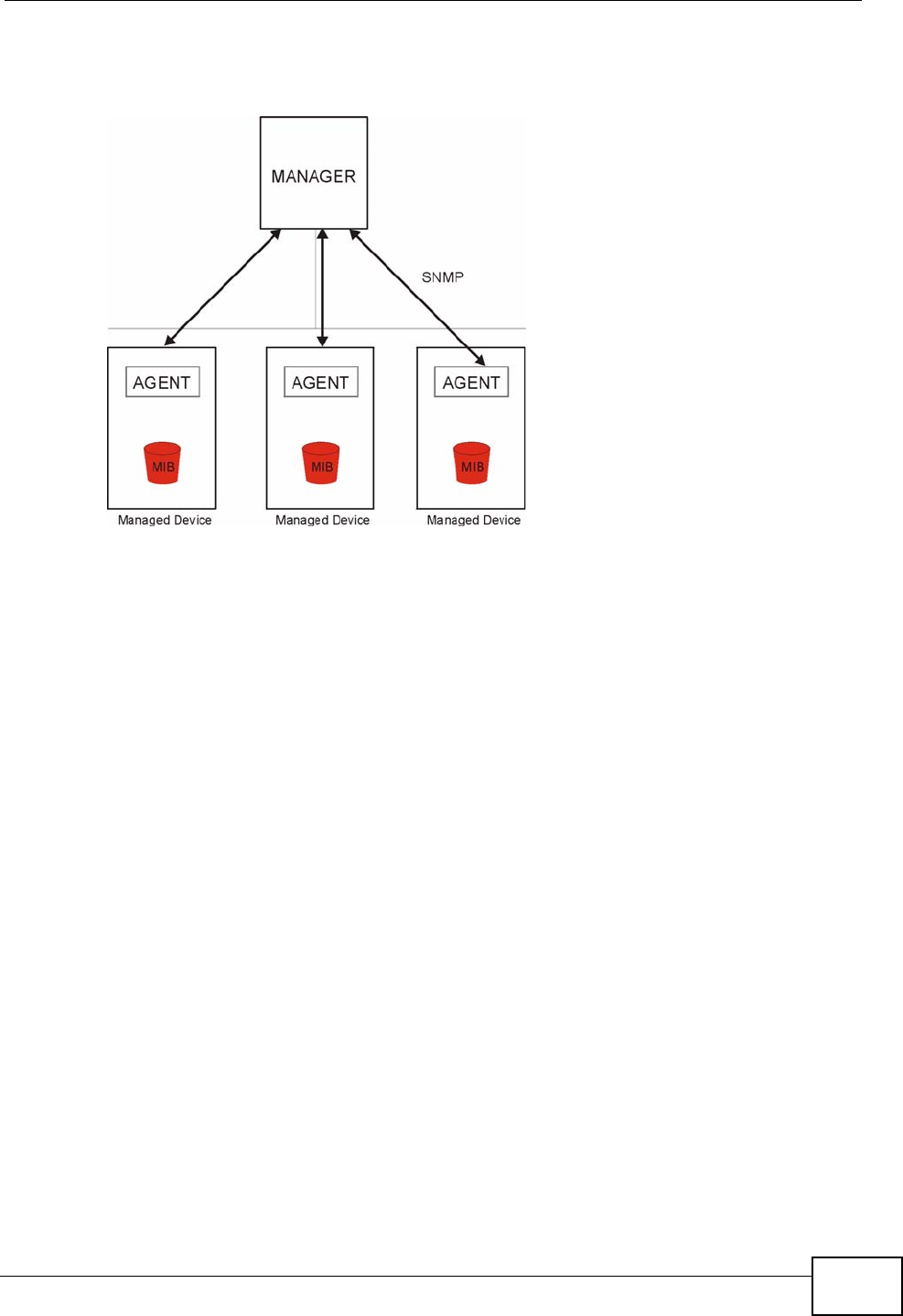
Chapter 16 Remote Management
IAD User’s Guide 189
Note: SNMP is only available if TCP/IP is configured.
Figure 89 SNMP Management Model
An SNMP managed network consists of two main types of component: agents and
a manager.
An agent is a management software module that resides in a managed device (the
IAD). An agent translates the local management information from the managed
device into a form compatible with SNMP. The manager is the console through
which network administrators perform network management functions. It
executes applications that control and monitor managed devices.
The managed devices contain object variables/managed objects that define each
piece of information to be collected about a device. Examples of variables include
such as number of packets received, node port status etc. A Management
Information Base (MIB) is a collection of managed objects. SNMP allows a
manager and agents to communicate for the purpose of accessing these objects.
SNMP itself is a simple request/response protocol based on the manager/agent
model. The manager issues a request and the agent returns responses using the
following protocol operations:
• Get - Allows the manager to retrieve an object variable from the agent.
• GetNext - Allows the manager to retrieve the next object variable from a table
or list within an agent. In SNMPv1, when a manager wants to retrieve all
elements of a table from an agent, it initiates a Get operation, followed by a
series of GetNext operations.
• Set - Allows the manager to set values for object variables within an agent.
• Trap - Used by the agent to inform the manager of some events.
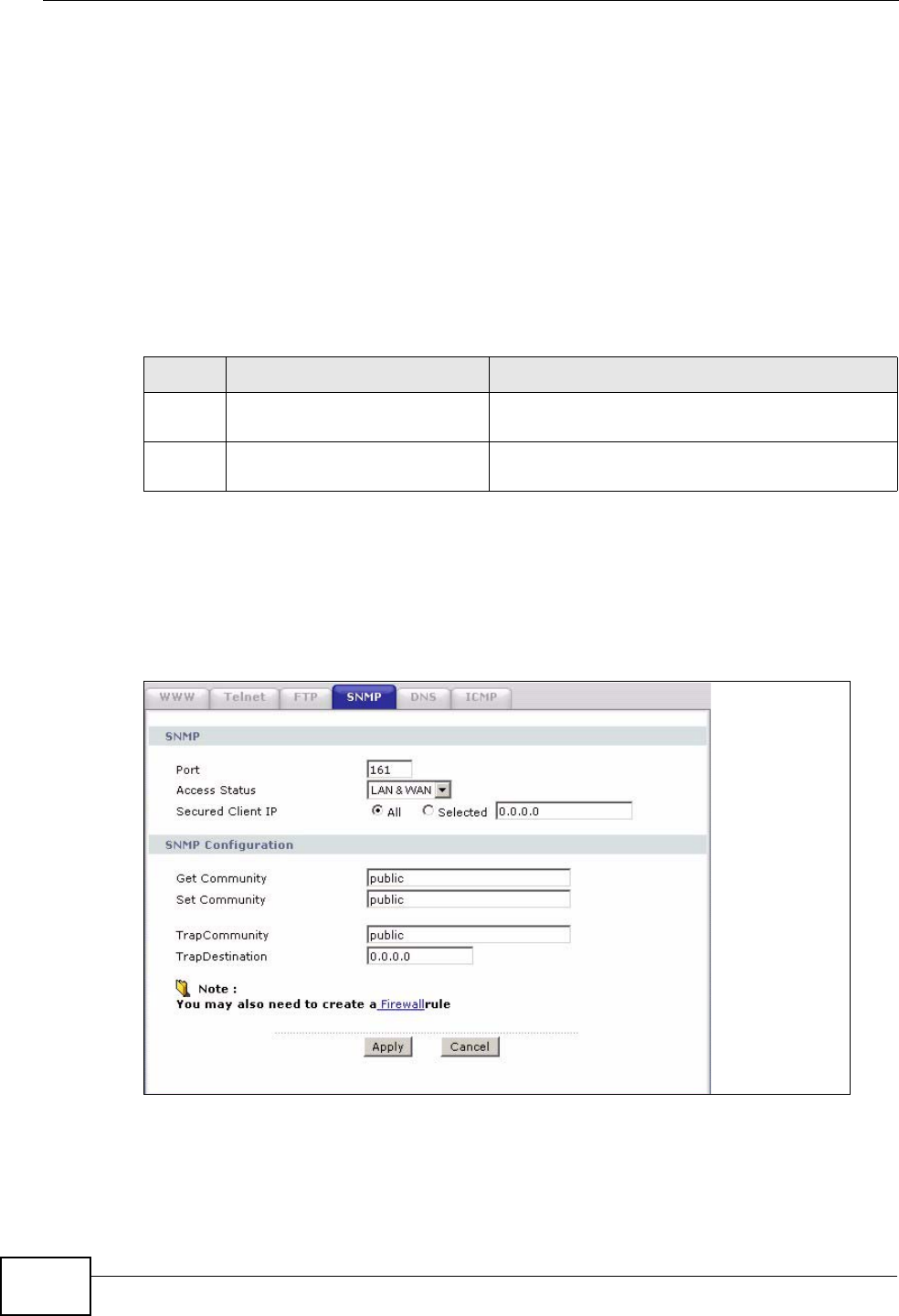
Chapter 16 Remote Management
IAD User’s Guide
190
16.5.1 Supported MIBs
The IAD supports MIB II, which is defined in RFC-1213 and RFC-1215. The focus
of the MIBs is to let administrators collect statistical data and monitor status and
performance.
16.5.2 SNMP Traps
The IAD will send traps to the SNMP manager when any one of the following
events occurs:
16.5.3 The SNMP Screen
To change your IAD’s SNMP settings, click Advanced > Remote MGMT > SNMP.
The screen appears as shown.
Figure 90 Remote Management > SNMP
Table 61 SNMP Traps
TRAP # TRAP NAME DESCRIPTION
0coldStart (defined in RFC-
1215)A trap is sent after booting (power on).
1warmStart (defined in RFC-
1215)A trap is sent after booting (software reboot).

Chapter 16 Remote Management
IAD User’s Guide 191
The following table describes the labels in this screen.
16.6 The DNS Screen
Use DNS (Domain Name System) to map a domain name to its corresponding IP
address and vice versa. Refer to Chapter 7 on page 59 for background
information.
Table 62 Remote Management > SNMP
LABEL DESCRIPTION
SNMP
Port You may change the server port number for a service if needed,
however you must use the same port number in order to use that
service for remote management.
Access Status Select the interface(s) through which a computer may access the IAD
using this service.
Secured Client IP A secured client is a “trusted” computer that is allowed to
communicate with the IAD using this service.
Select All to allow any computer to access the IAD using this service.
Choose Selected to just allow the computer with the IP address that
you specify to access the IAD using this service.
SNMP Configuration
Get Community Enter the Get Community, which is the password for the incoming
Get and GetNext requests from the management station. The default
is public and allows all requests.
Set Community Enter the Set community, which is the password for incoming Set
requests from the management station. The default is public and
allows all requests.
Trap
Community Type the trap community, which is the password sent with each trap
to the SNMP manager. The default is public and allows all requests.
Destination Type the IP address of the station to send your SNMP traps to.
Apply Click Apply to save your customized settings and exit this screen.
Cancel Click Cancel to begin configuring this screen afresh.
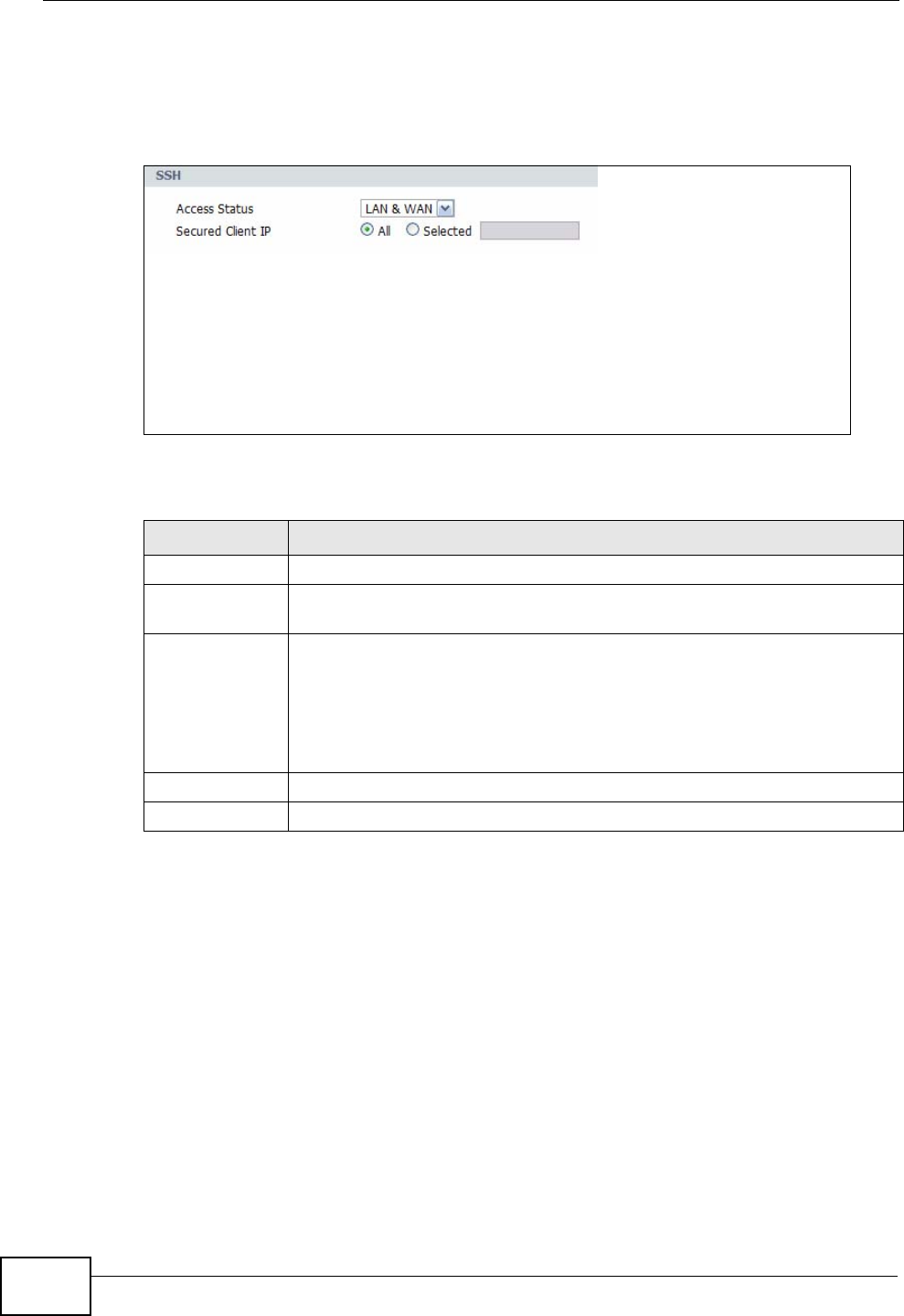
Chapter 16 Remote Management
IAD User’s Guide
192
Click Advanced > Remote MGMT > DNS to change your IAD’s DNS settings.
Use this screen to set from which IP address the IAD will accept DNS queries and
on which interface it can send them your IAD’s DNS settings.
Figure 91 Remote Management > DNS
The following table describes the labels in this screen.
16.7 The ICMP Screen
To change your IAD’s security settings, click Advanced > Remote MGMT >
ICMP. The screen appears as shown.
If an outside user attempts to probe an unsupported port on your IAD, an ICMP
response packet is automatically returned. This allows the outside user to know
the IAD exists. Your IAD supports anti-probing, which prevents the ICMP response
packet from being sent. This keeps outsiders from discovering your IAD when
unsupported ports are probed.
Table 63 Remote Management > DNS
LABEL DESCRIPTION
Port The DNS service port number is 53 and cannot be changed here.
Access Status Select the interface(s) through which a computer may send DNS queries
to the IAD.
Secured Client
IP A secured client is a “trusted” computer that is allowed to send DNS
queries to the IAD.
Select All to allow any computer to send DNS queries to the IAD.
Choose Selected to just allow the computer with the IP address that
you specify to send DNS queries to the IAD.
Apply Click Apply to save your customized settings and exit this screen.
Cancel Click Cancel to begin configuring this screen afresh.
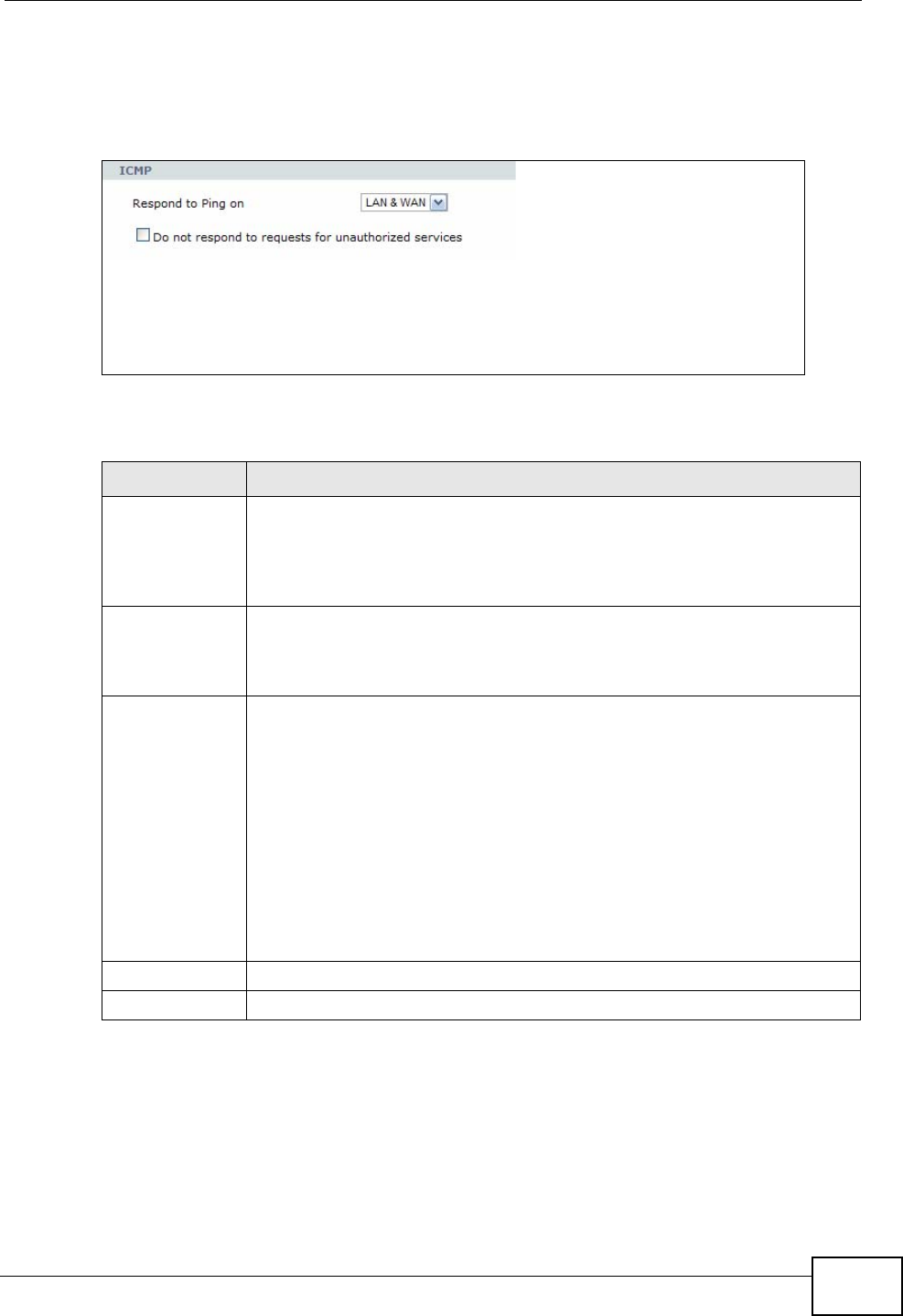
Chapter 16 Remote Management
IAD User’s Guide 193
Note: If you want your device to respond to pings and requests for unauthorized
services, you may also need to configure the firewall anti probing settings to
match.
Figure 92 Remote Management > ICMP
The following table describes the labels in this screen.
16.8 SSH
You can use SSH (Secure SHell) to securely access the IAD’s command line
interface. Specify which interfaces allow SSH access and from which IP address
the access can come.
Table 64 Remote Management > ICMP
LABEL DESCRIPTION
ICMP Internet Control Message Protocol is a message control and error-
reporting protocol between a host server and a gateway to the Internet.
ICMP uses Internet Protocol (IP) datagrams, but the messages are
processed by the TCP/IP software and directly apparent to the
application user.
Respond to
Ping on The IAD will not respond to any incoming Ping requests when Disable is
selected. Select LAN to reply to incoming LAN Ping requests. Select
WAN to reply to incoming WAN Ping requests. Otherwise select LAN &
WAN to reply to both incoming LAN and WAN Ping requests.
Do not respond
to requests for
unauthorized
services
Select this option to prevent hackers from finding the IAD by probing for
unused ports. If you select this option, the IAD will not respond to port
request(s) for unused ports, thus leaving the unused ports and the IAD
unseen. If this option is not selected, the IAD will reply with an ICMP
port unreachable packet for a port probe on its unused UDP ports and a
TCP reset packet for a port probe on its unused TCP ports.
Note that the probing packets must first traverse the IAD's firewall rule
checks before reaching this anti-probing mechanism. Therefore if a
firewall rule stops a probing packet, the IAD reacts based on the firewall
rule to either send a TCP reset packet for a blocked TCP packet (or an
ICMP port-unreachable packet for a blocked UDP packets) or just drop
the packets without sending a response packet.
Apply Click Apply to save your customized settings and exit this screen.
Cancel Click Cancel to begin configuring this screen afresh.
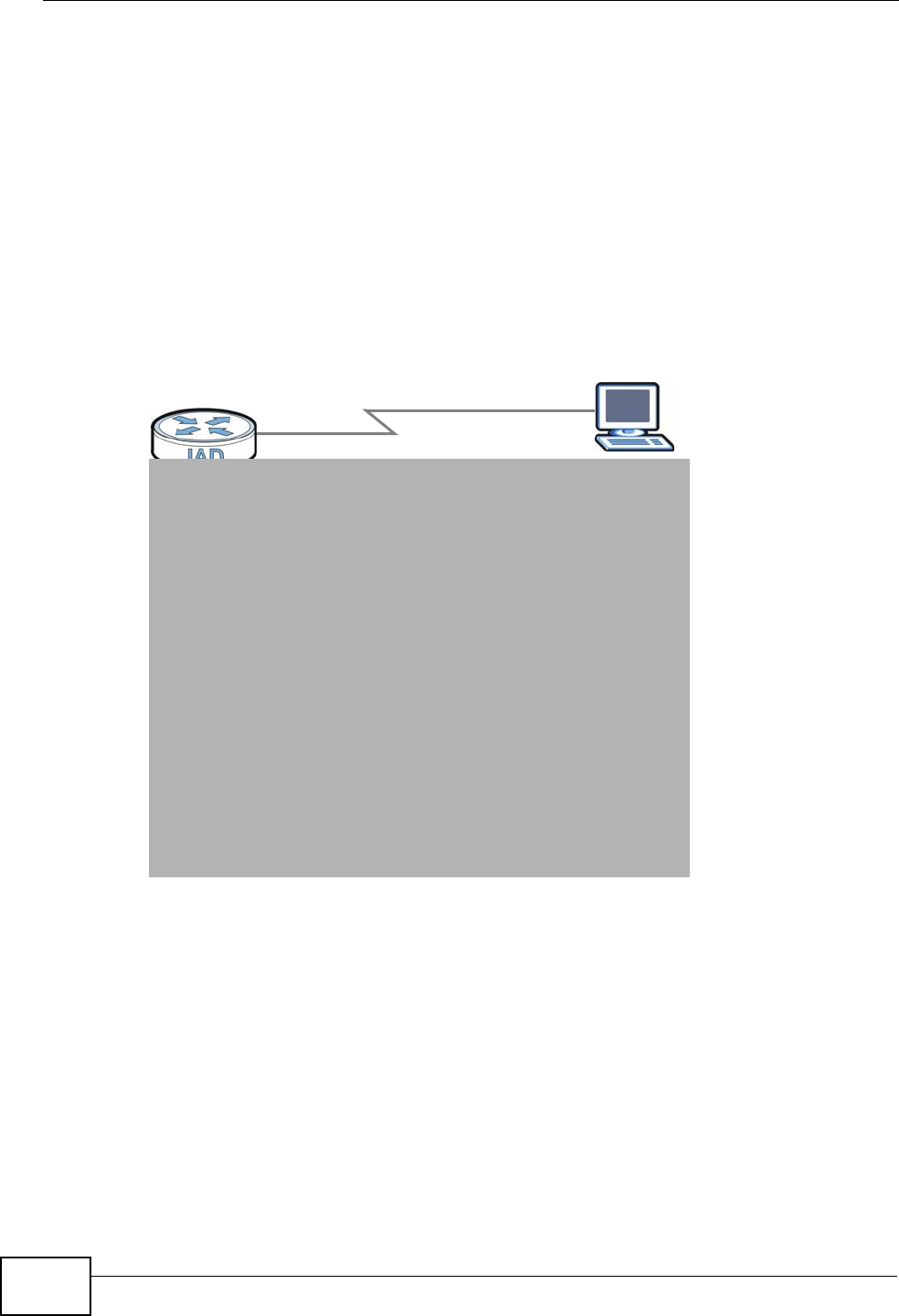
Chapter 16 Remote Management
IAD User’s Guide
194
Unlike Telnet or FTP, which transmit data in plaintext (clear or unencrypted text),
SSH is a secure communication protocol that combines authentication and data
encryption to provide secure encrypted communication between two hosts over an
unsecured network.
16.9 How SSH Works
The following table summarizes how a secure connection is established between
two remote hosts.
Figure 93 How SSH Works
1Host Identification
The SSH client sends a connection request to the SSH server. The server identifies
itself with a host key. The client encrypts a randomly generated session key with
the host key and server key and sends the result back to the server.
The client automatically saves any new server public keys. In subsequent
connections, the server public key is checked against the saved version on the
client computer.
2Encryption Method
Once the identification is verified, both the client and server must agree on the
type of encryption method to use.

Chapter 16 Remote Management
IAD User’s Guide 195
3Authentication and Data Transmission
After the identification is verified and data encryption activated, a secure tunnel is
established between the client and the server. The client then sends its
authentication information (user name and password) to the server to log in to the
server.
16.10 SSH Implementation on the IAD
Your IAD supports SSH version 1.0 using RSA authentication and three encryption
methods (DES, 3DES and Blowfish). The SSH server is implemented on the IAD
for remote SMT management and file transfer on port 22. Only one SSH
connection is allowed at a time.
16.10.1 Requirements for Using SSH
You must install an SSH client program on a client computer (Windows or Linux
operating system) that is used to connect to the IAD over SSH.
16.11 The SSH Screen
Click Click Advanced > Remote MGMT > Telnet to change your IAD’s Secure
Shell settings.
Note: It is recommended that you disable Telnet and FTP when you configure SSH for
secure connections.
Figure 94 Remote Management > SSH

Chapter 16 Remote Management
IAD User’s Guide
196
The following table describes the labels in this screen.
Table 65 Remote Management > SSH
LABEL DESCRIPTION
Server Host
Key Select the certificate whose corresponding private key is to be used to
identify the IAD for SSH connections. You must have certificates already
configured in the My Certificates screen (Click My Certificates and
see Chapter 16 on page 37 for details).
Port You may change the server port number for a service if needed, however
you must use the same port number in order to use that service for
remote management.
Access Status Select the interface(s) through which a computer may access the IAD
using this service.
Secured Client
IP A secure client is a “trusted” computer that is allowed to communicate
with the IAD using this service.
Select All to allow any computer to access the IAD using this service.
Choose Selected to just allow the computer with the IP address that
you specify to access the IAD using this service.
Apply Click Apply to save your customized settings and exit this screen.
Reset Click Reset to begin configuring this screen afresh.

IAD User’s Guide 197
CHAPTER 17
Universal Plug-and-Play (UPnP)
17.1 Overview
Universal Plug and Play (UPnP) is a distributed, open networking standard that
uses TCP/IP for simple peer-to-peer network connectivity between devices. A
UPnP device can dynamically join a network, obtain an IP address, convey its
capabilities and learn about other devices on the network. In turn, a device can
leave a network smoothly and automatically when it is no longer in use.
17.1.1 What You Can Do in this Chapter
Use the UPnP screen (Section 17.2 on page 198) to enable UPnP on the IAD and
allow UPnP-enabled applications to automatically configure the IAD.
17.1.2 What You Need to Know
How do I know if I'm using UPnP?
UPnP hardware is identified as an icon in the Network Connections folder
(Windows XP). Each UPnP compatible device installed on your network will appear
as a separate icon. Selecting the icon of a UPnP device will allow you to access the
information and properties of that device.
NAT Traversal
UPnP NAT traversal automates the process of allowing an application to operate
through NAT. UPnP network devices can automatically configure network
addressing, announce their presence in the network to other UPnP devices and
enable exchange of simple product and service descriptions. NAT traversal allows
the following:
• Dynamic port mapping
• Learning public IP addresses
• Assigning lease times to mappings

Chapter 17 Universal Plug-and-Play (UPnP)
IAD User’s Guide
198
Windows Messenger is an example of an application that supports NAT traversal
and UPnP.
See the NAT chapter for more information on NAT.
Cautions with UPnP
The automated nature of NAT traversal applications in establishing their own
services and opening firewall ports may present network security issues. Network
information and configuration may also be obtained and modified by users in some
network environments.
When a UPnP device joins a network, it announces its presence with a multicast
message. For security reasons, the IAD allows multicast messages on the LAN
only.
All UPnP-enabled devices may communicate freely with each other without
additional configuration. Disable UPnP if this is not your intention.
UPnP and ZyXEL
ZyXEL has achieved UPnP certification from the Universal Plug and Play Forum
UPnP™ Implementers Corp. (UIC). ZyXEL's UPnP implementation supports
Internet Gateway Device (IGD) 1.0.
See the following sections for examples of installing and using UPnP.
17.2 The UPnP Screen
Click Advanced > UPnP to display the screen shown next.
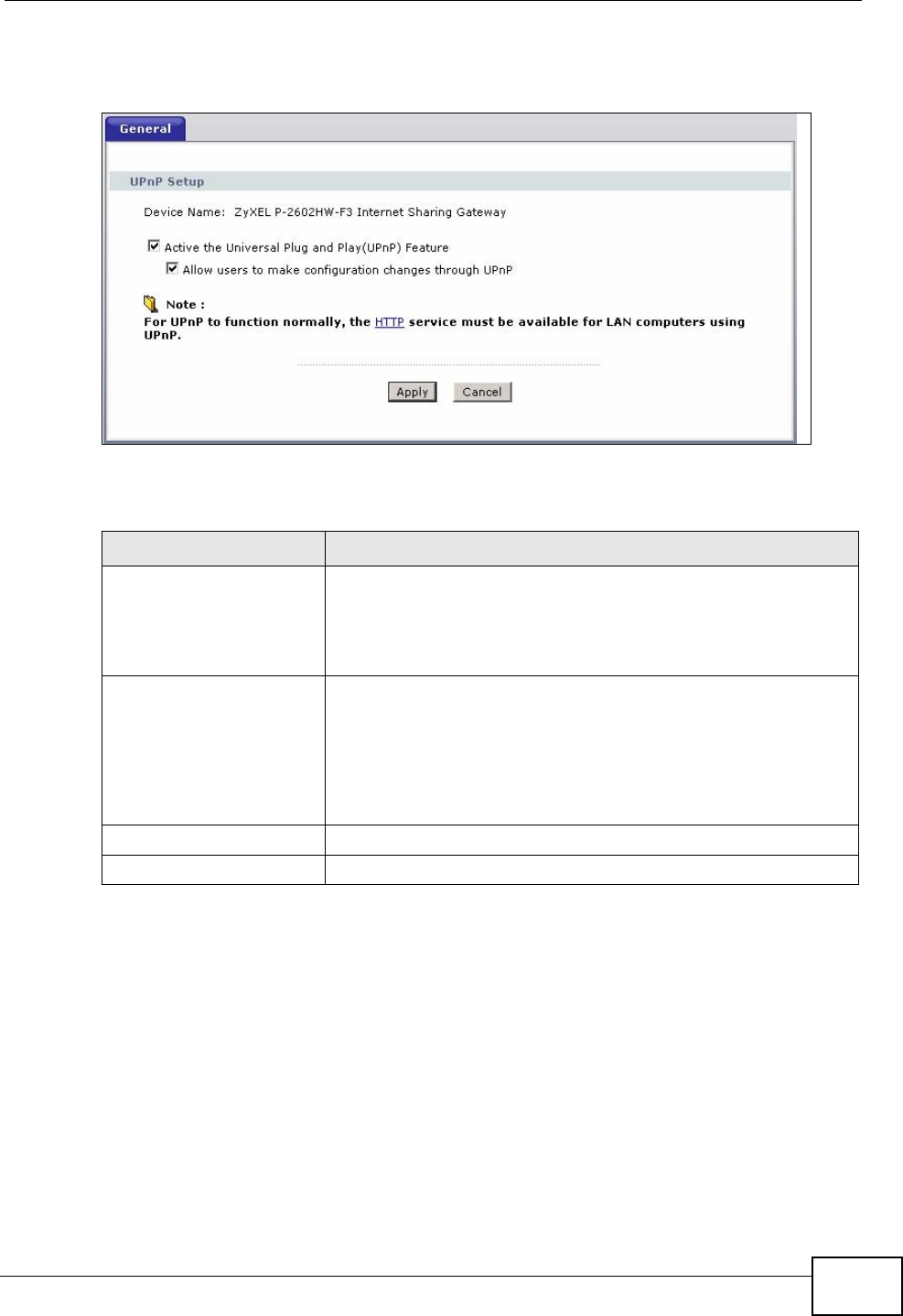
Chapter 17 Universal Plug-and-Play (UPnP)
IAD User’s Guide 199
See Section 17.1 on page 197 for more information.
Figure 95 Configuring UPnP
The following table describes the fields in this screen.
17.3 Installing UPnP in Windows Example
This section shows how to install UPnP in Windows Me and Windows XP.
Installing UPnP in Windows Me
Follow the steps below to install the UPnP in Windows Me.
1Click Start and Control Panel. Double-click Add/Remove Programs.
Table 66 Configuring UPnP
LABEL DESCRIPTION
Active the Universal Plug
and Play (UPnP) Feature Select this check box to activate UPnP. Be aware that anyone
could use a UPnP application to open the web configurator's
login screen without entering the IAD's IP address (although
you must still enter the password to access the web
configurator).
Allow users to make
configuration changes
through UPnP
Select this check box to allow UPnP-enabled applications to
automatically configure the IAD so that they can communicate
through the IAD, for example by using NAT traversal, UPnP
applications automatically reserve a NAT forwarding port in
order to communicate with another UPnP enabled device; this
eliminates the need to manually configure port forwarding for
the UPnP enabled application.
Apply Click Apply to save the setting to the IAD.
Cancel Click Cancel to return to the previously saved settings.
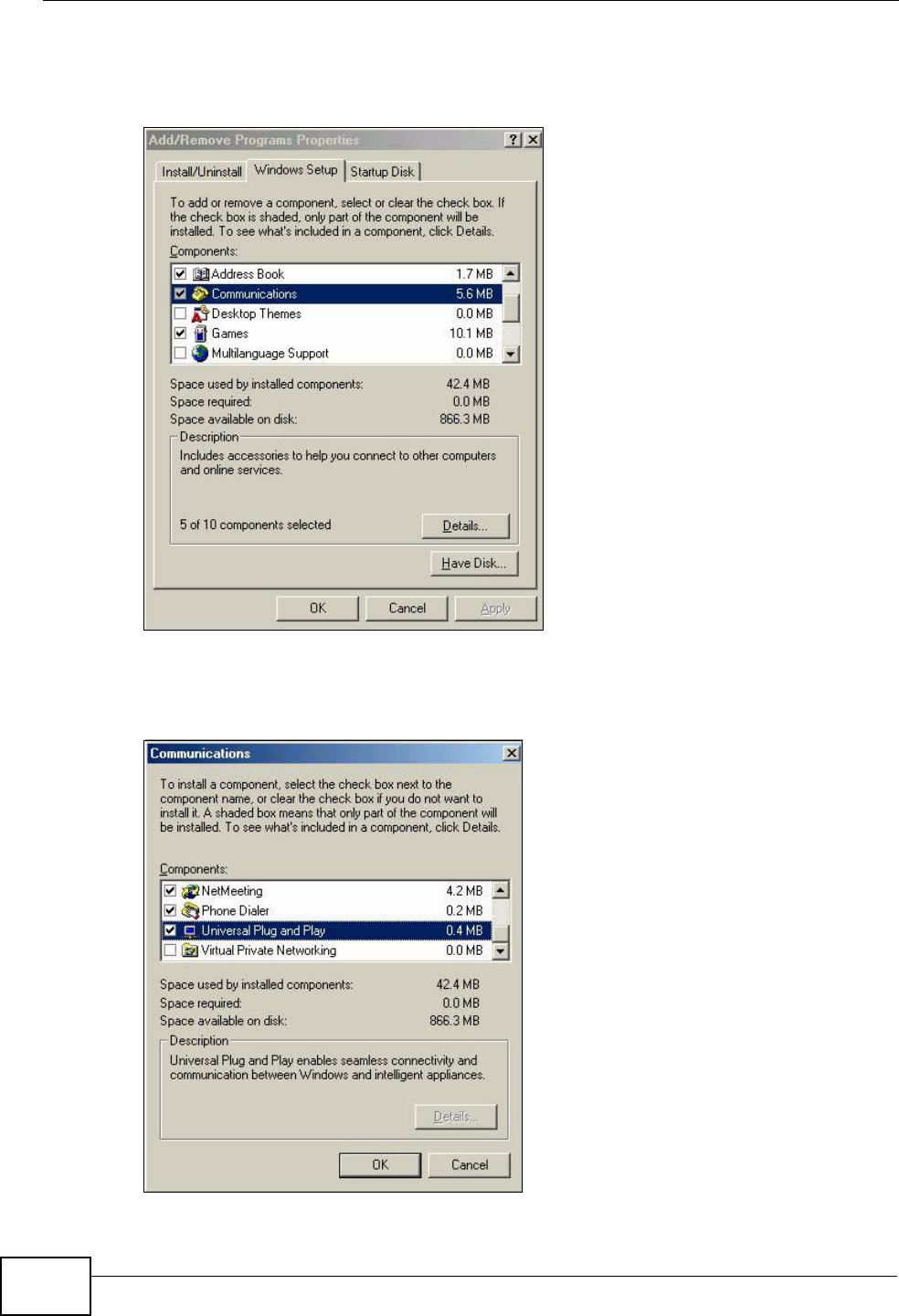
Chapter 17 Universal Plug-and-Play (UPnP)
IAD User’s Guide
200
2Click on the Windows Setup tab and select Communication in the
Components selection box. Click Details.
Figure 96 Add/Remove Programs: Windows Setup: Communication
3In the Communications window, select the Universal Plug and Play check box
in the Components selection box.
Figure 97 Add/Remove Programs: Windows Setup: Communication: Components
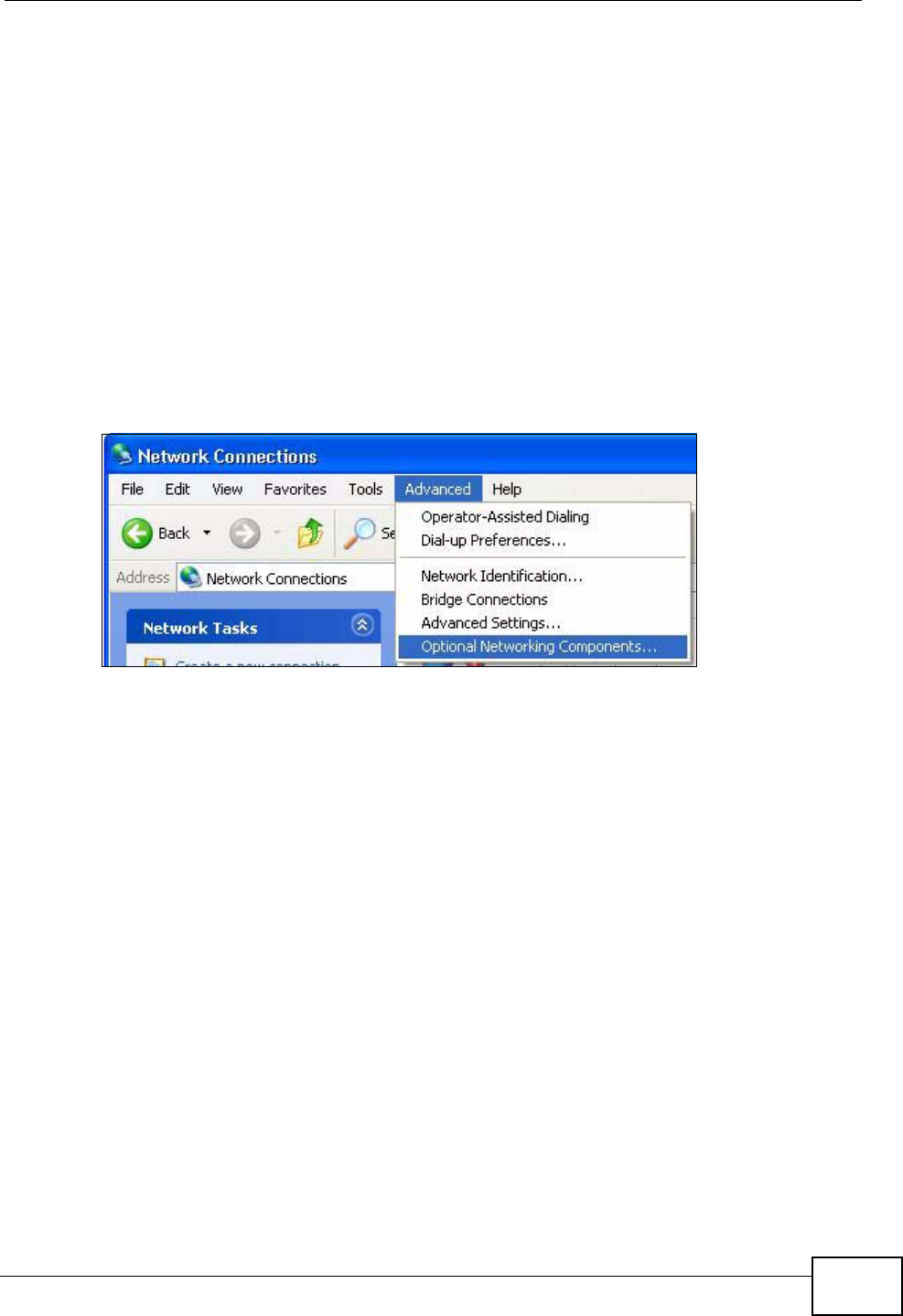
Chapter 17 Universal Plug-and-Play (UPnP)
IAD User’s Guide 201
4Click OK to go back to the Add/Remove Programs Properties window and click
Next.
5Restart the computer when prompted.
Installing UPnP in Windows XP
Follow the steps below to install the UPnP in Windows XP.
1Click Start and Control Panel.
2Double-click Network Connections.
3In the Network Connections window, click Advanced in the main menu and
select Optional Networking Components ….
Figure 98 Network Connections
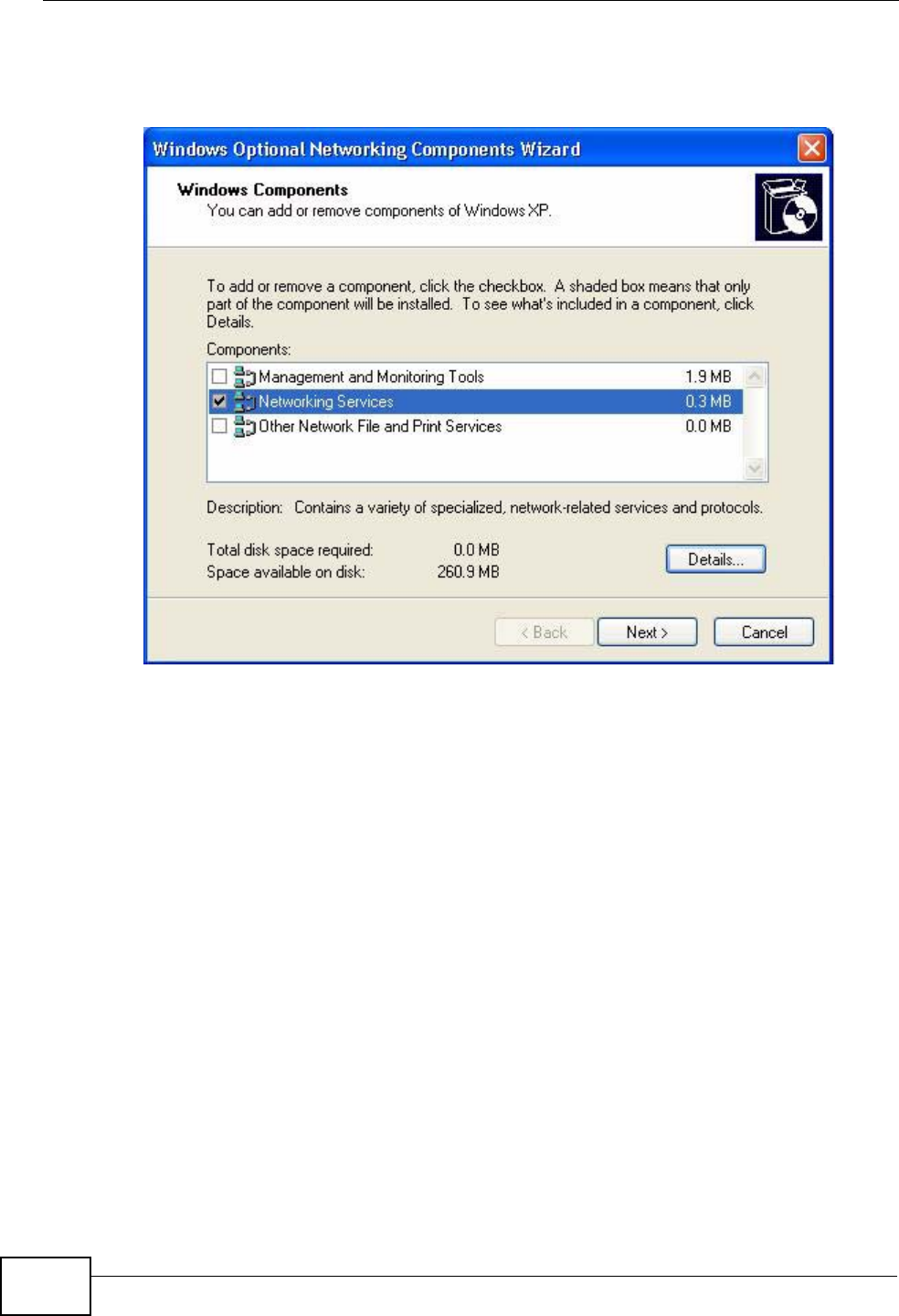
Chapter 17 Universal Plug-and-Play (UPnP)
IAD User’s Guide
202
4The Windows Optional Networking Components Wizard window displays.
Select Networking Service in the Components selection box and click Details.
Figure 99 Windows Optional Networking Components Wizard
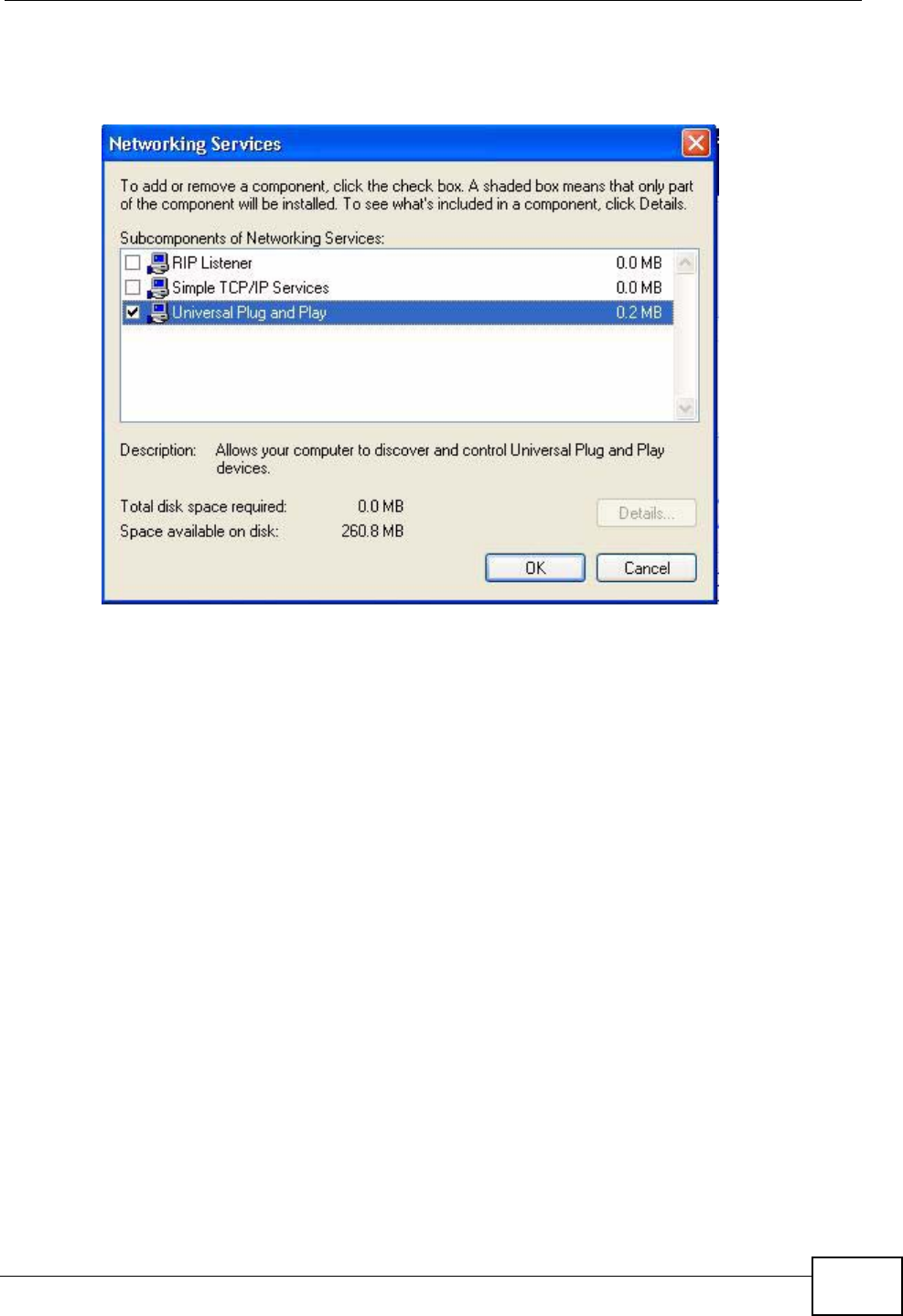
Chapter 17 Universal Plug-and-Play (UPnP)
IAD User’s Guide 203
5In the Networking Services window, select the Universal Plug and Play check
box.
Figure 100 Networking Services
6Click OK to go back to the Windows Optional Networking Component Wizard
window and click Next.
17.4 Using UPnP in Windows XP Example
This section shows you how to use the UPnP feature in Windows XP. You must
already have UPnP installed in Windows XP and UPnP activated on the IAD.
Make sure the computer is connected to a LAN port of the IAD. Turn on your
computer and the IAD.
Auto-discover Your UPnP-enabled Network Device
1Click Start and Control Panel. Double-click Network Connections. An icon
displays under Internet Gateway.
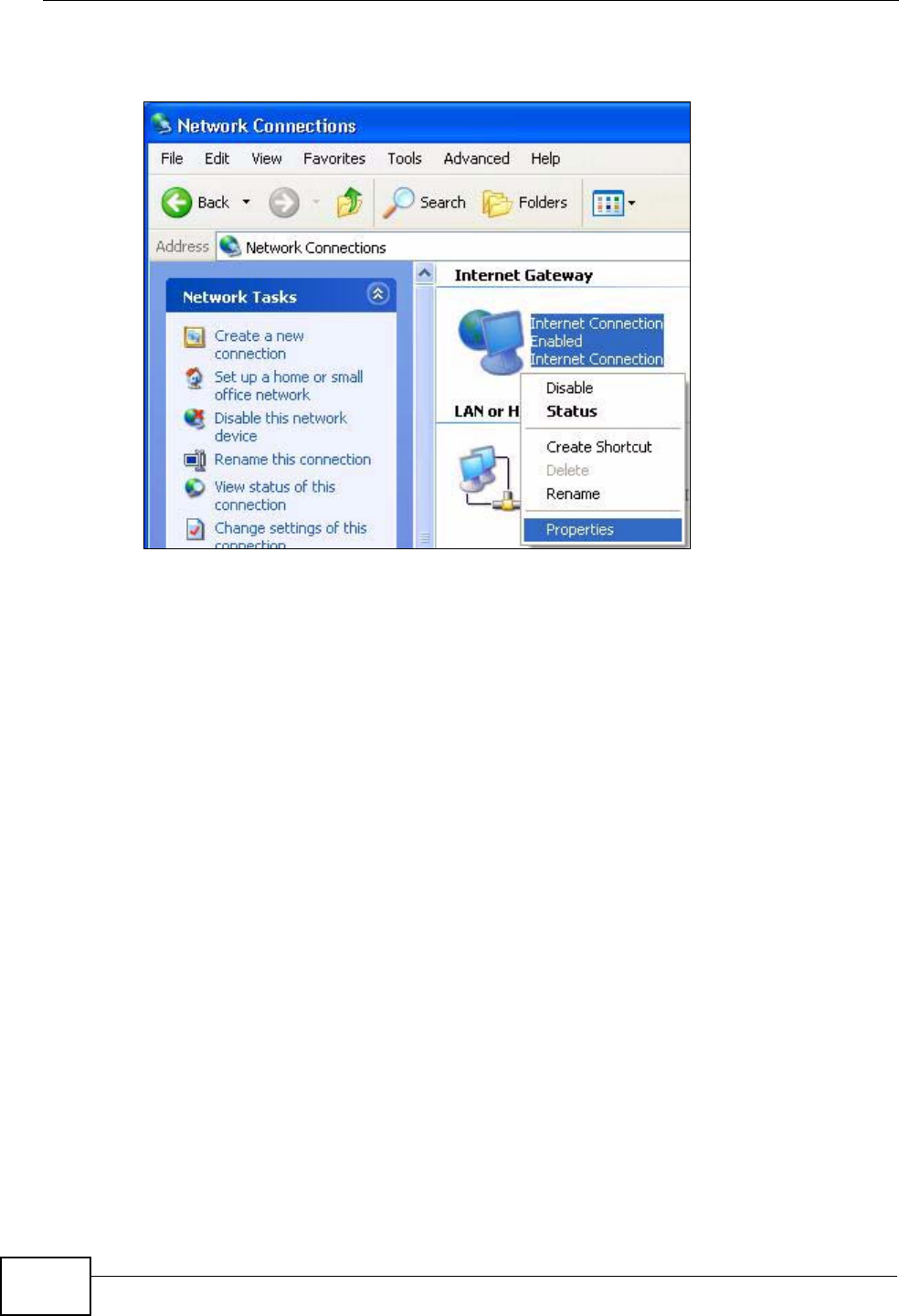
Chapter 17 Universal Plug-and-Play (UPnP)
IAD User’s Guide
204
2Right-click the icon and select Properties.
Figure 101 Network Connections
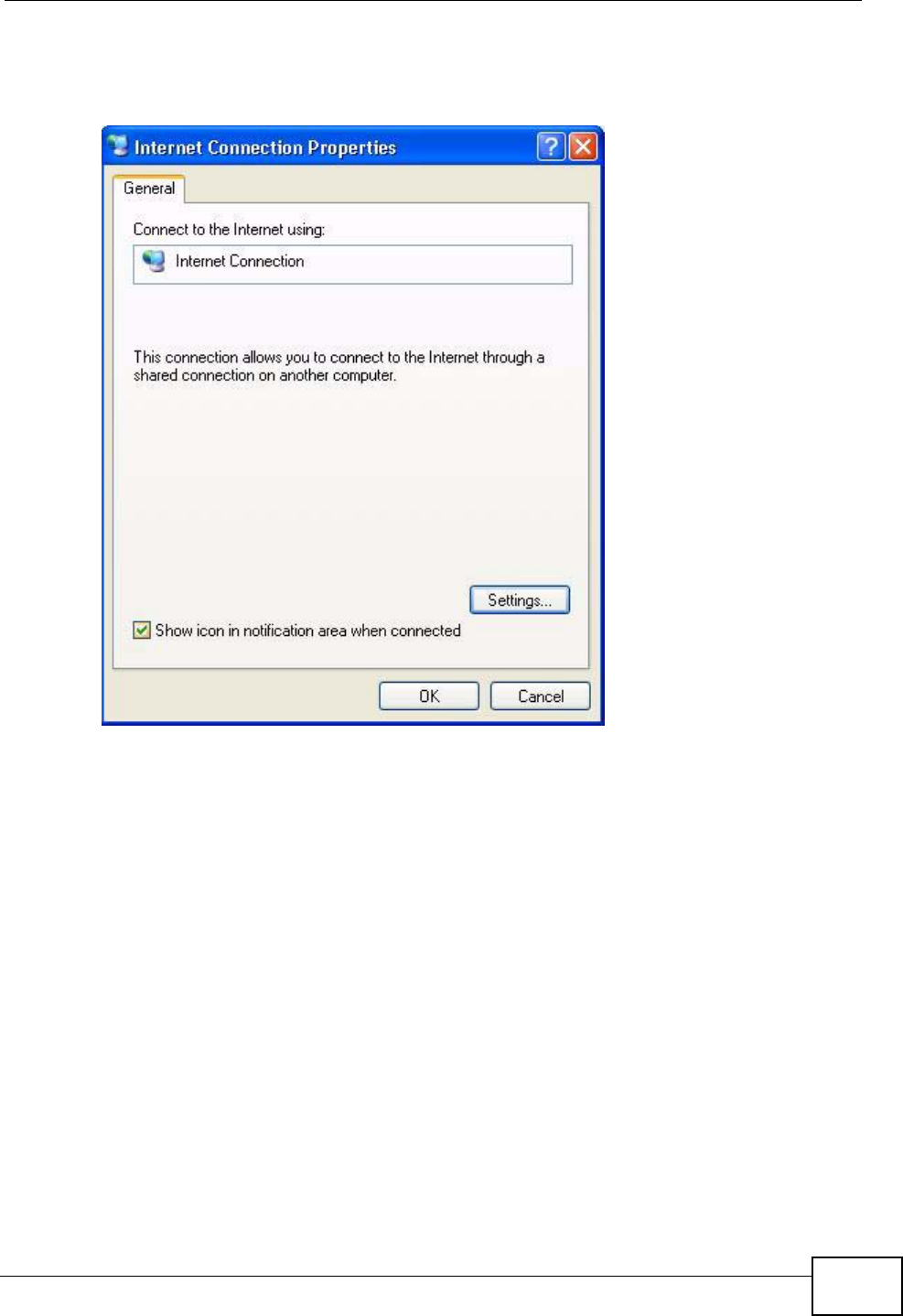
Chapter 17 Universal Plug-and-Play (UPnP)
IAD User’s Guide 205
3In the Internet Connection Properties window, click Settings to see the port
mappings there were automatically created.
Figure 102 Internet Connection Properties
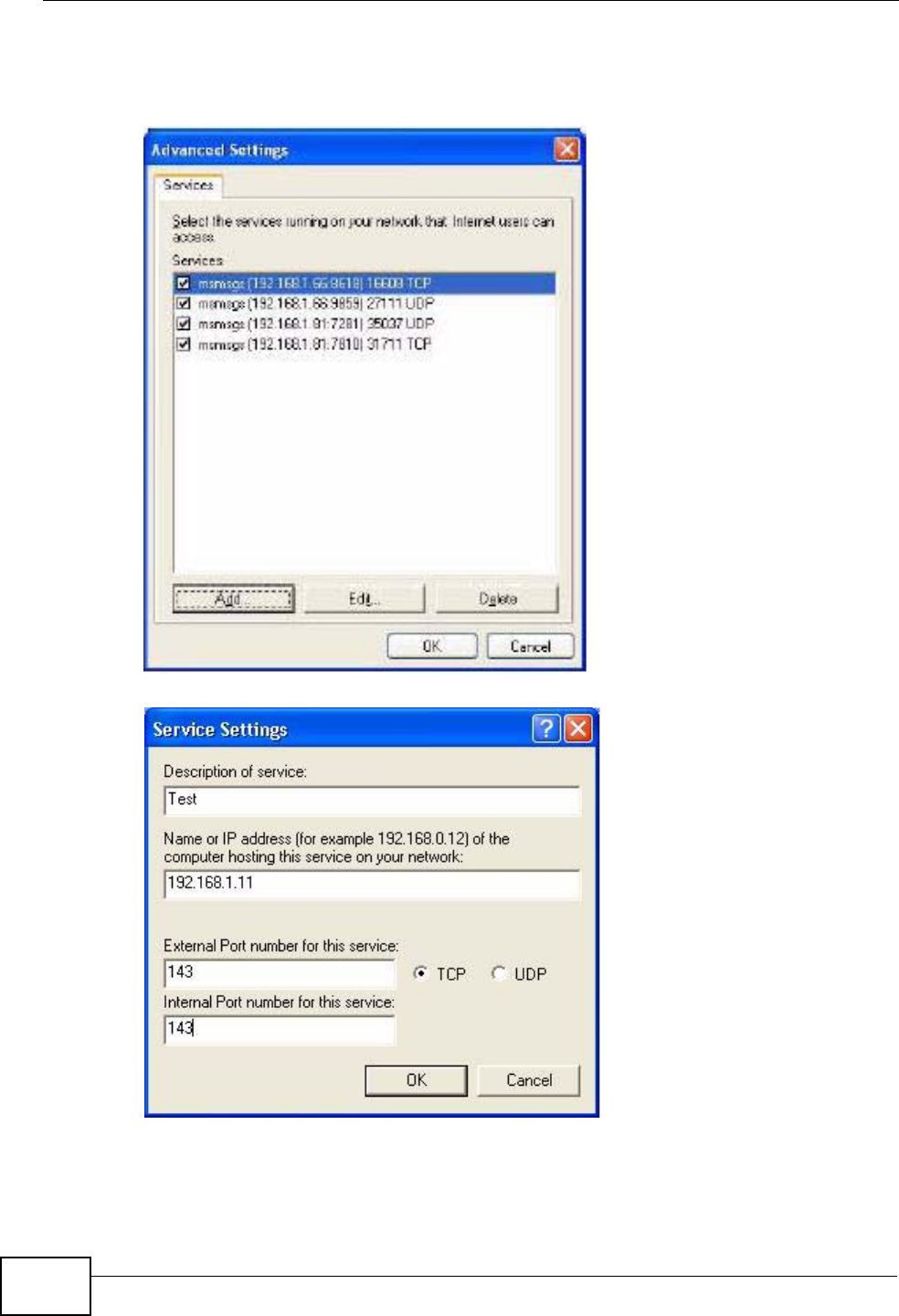
Chapter 17 Universal Plug-and-Play (UPnP)
IAD User’s Guide
206
4You may edit or delete the port mappings or click Add to manually add port
mappings.
Figure 103 Internet Connection Properties: Advanced Settings
Figure 104 Internet Connection Properties: Advanced Settings: Add
5When the UPnP-enabled device is disconnected from your computer, all port
mappings will be deleted automatically.
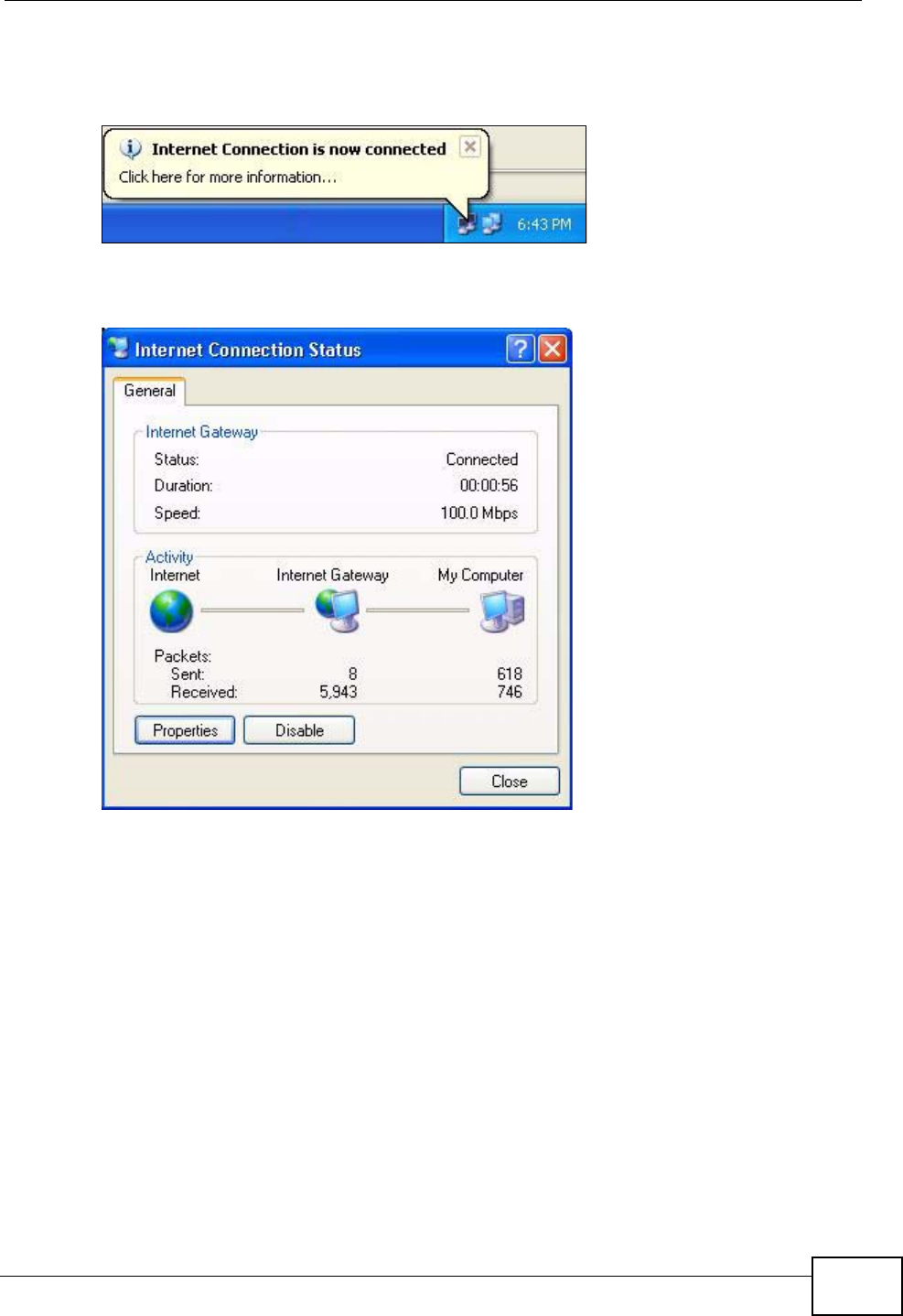
Chapter 17 Universal Plug-and-Play (UPnP)
IAD User’s Guide 207
6Select Show icon in notification area when connected option and click OK.
An icon displays in the system tray.
Figure 105 System Tray Icon
7Double-click on the icon to display your current Internet connection status.
Figure 106 Internet Connection Status
Web Configurator Easy Access
With UPnP, you can access the web-based configurator on the IAD without finding
out the IP address of the IAD first. This comes helpful if you do not know the IP
address of the IAD.
Follow the steps below to access the web configurator.
1Click Start and then Control Panel.
2Double-click Network Connections.
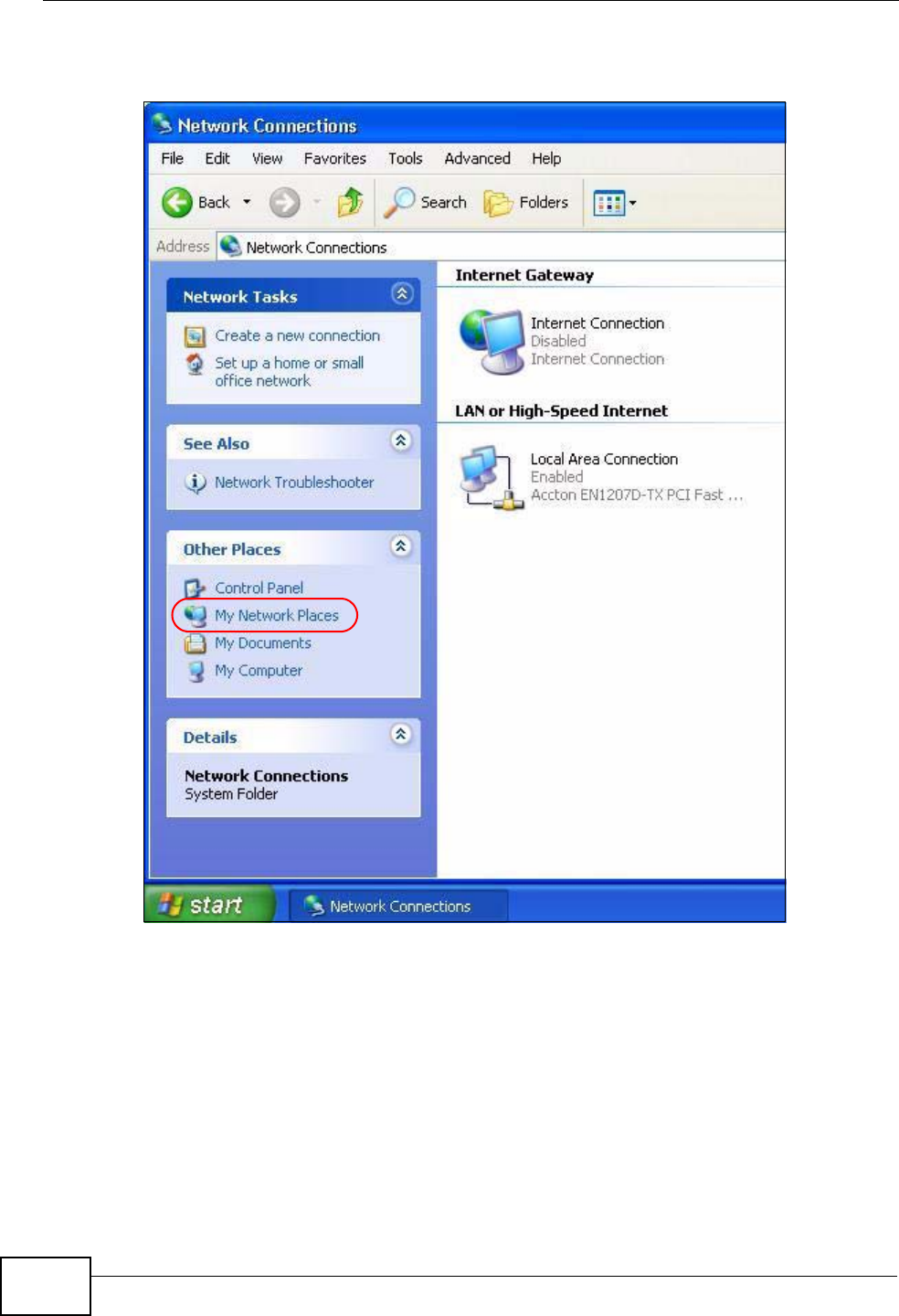
Chapter 17 Universal Plug-and-Play (UPnP)
IAD User’s Guide
208
3Select My Network Places under Other Places.
Figure 107 Network Connections
4An icon with the description for each UPnP-enabled device displays under Local
Network.
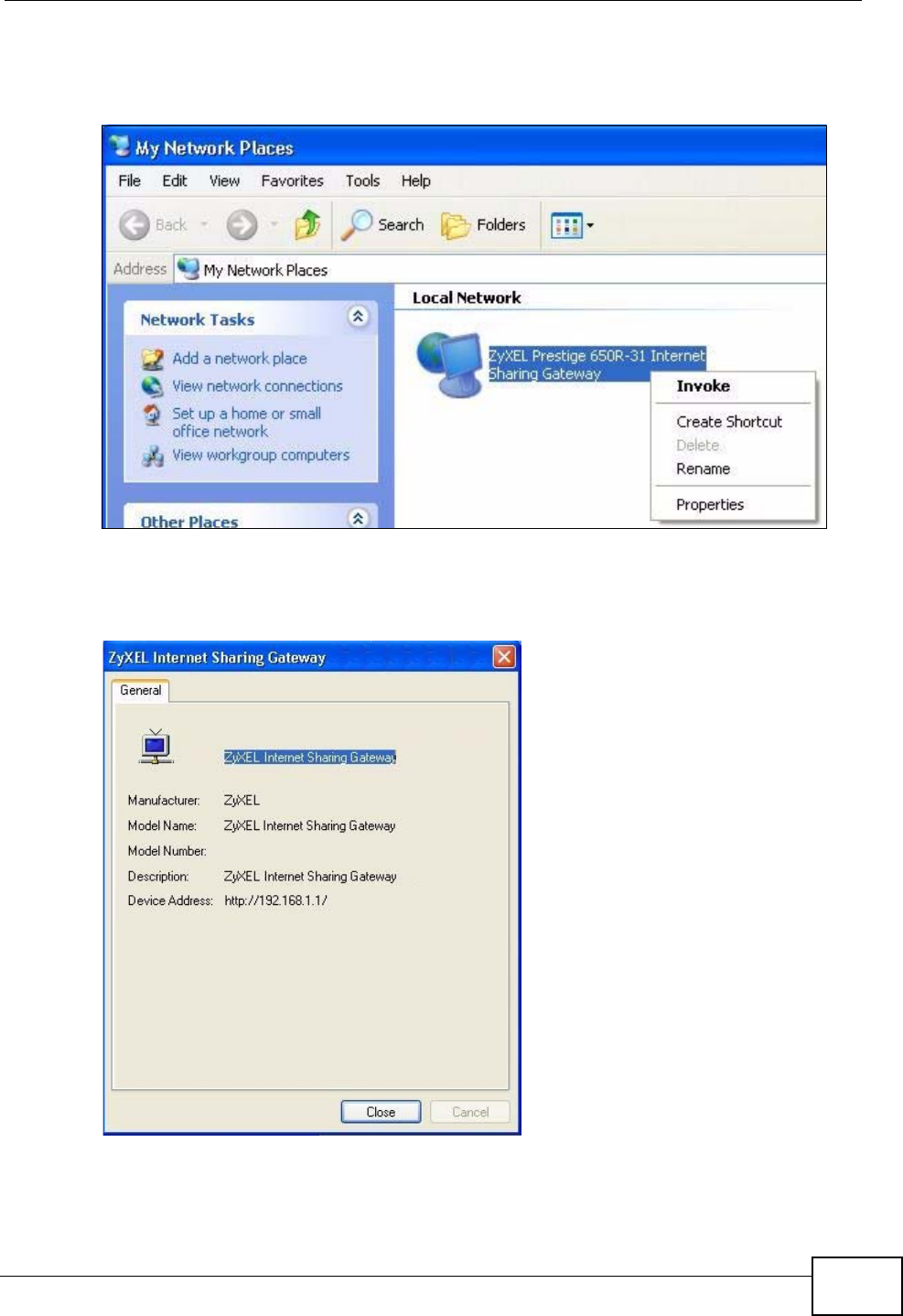
Chapter 17 Universal Plug-and-Play (UPnP)
IAD User’s Guide 209
5Right-click on the icon for your IAD and select Invoke. The web configurator login
screen displays.
Figure 108 Network Connections: My Network Places
6Right-click on the icon for your IAD and select Properties. A properties window
displays with basic information about the IAD.
Figure 109 Network Connections: My Network Places: Properties: Example

Chapter 17 Universal Plug-and-Play (UPnP)
IAD User’s Guide
210

IAD User’s Guide 211
CHAPTER 18
System
18.1 Overview
Use this screen to configure the IAD’s time and date settings.
18.1.1 What You Need to Know
The following terms and concepts may help as you read through this chapter.
General Setup and System Name
General Setup contains administrative and system-related information. System
Name is for identification purposes. However, because some ISPs check this name
you should enter your computer's "Computer Name".
• In Windows 2000, click Start > Settings > Control Panel and then double-
click System. Click the Network Identification tab and then the Properties
button. Note the entry for the Computer name field and enter it as the
System Name.
• In Windows XP, click Start > My Computer > View system information and
then click the Computer Name tab. Note the entry in the Full computer
name field and enter it as the IAD System Name.
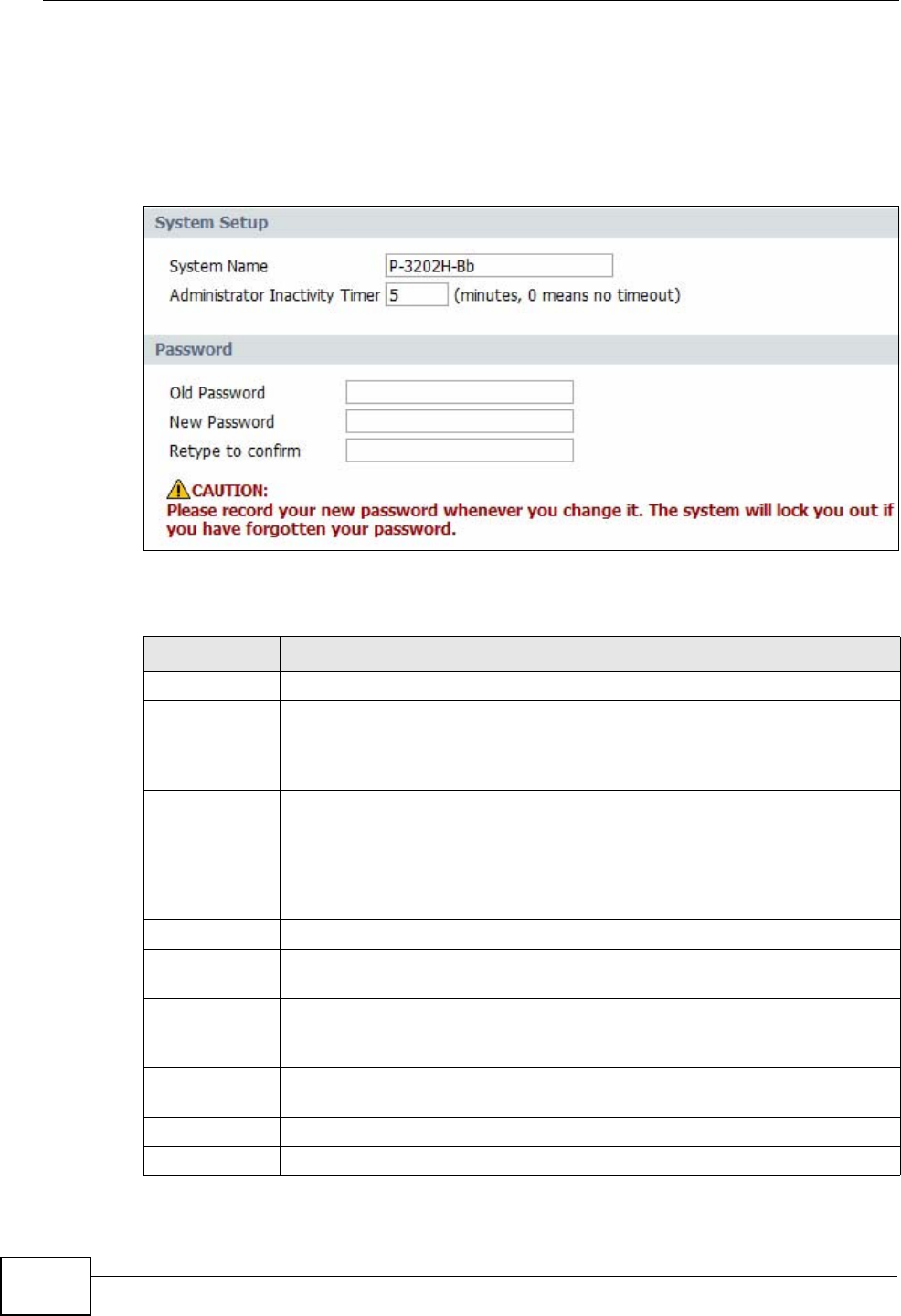
Chapter 18 System
IAD User’s Guide
212
18.2 General Setup
Use this screen to configure the IAD’s system name, inactivity timer, and
password. Click Maintenance > System to open the General screen.
Figure 110 System > General Setup
The following table describes the labels in this screen.
Table 67 General Setup
LABEL DESCRIPTION
General Setup
System Name Choose a descriptive name for identification purposes. It is
recommended you enter your computer’s “Computer name” in this field.
This name can be up to 30 alphanumeric characters long. Spaces are not
allowed, but dashes “-” and underscores "_" are accepted.
Administrator
Inactivity
Timer
Type how many minutes a management session (either via the web
configurator or telnet) can be left idle before the session times out. The
default is 5 minutes. After it times out you have to log in with your
password again. Very long idle timeouts may have security risks. A value
of "0" means a management session never times out, no matter how
long it has been left idle (not recommended).
Password
Old Password Type the default password or the existing password you use to access the
system in this field.
New Password Type your new system password (up to 30 characters). Note that as you
type a password, the screen displays a (*) for each character you type.
After you change the password, use the new password to access the IAD.
Retype to
Confirm Type the new password again for confirmation.
Apply Click Apply to save your changes back to the IAD.
Cancel Click Cancel to begin configuring this screen afresh.
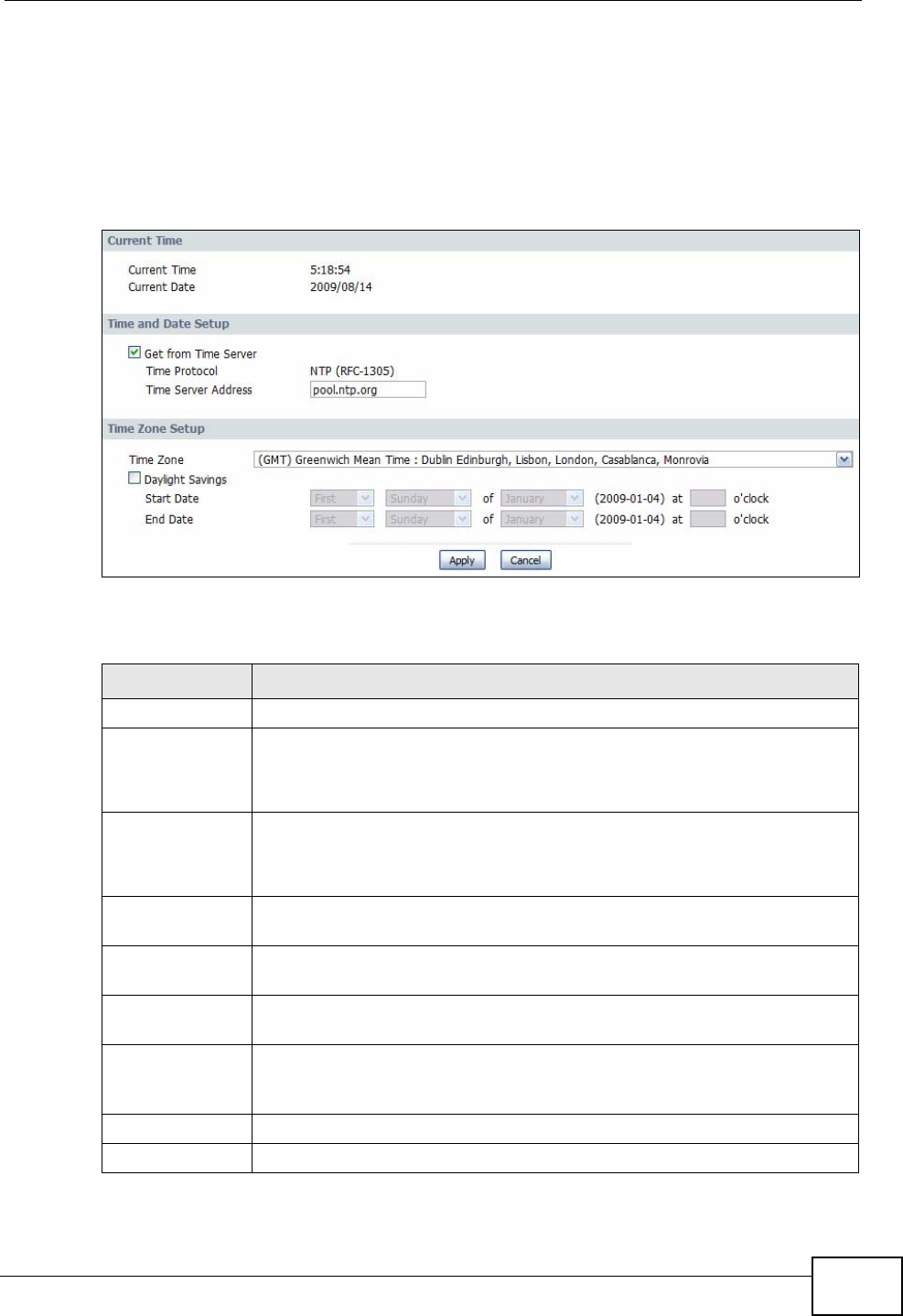
Chapter 18 System
IAD User’s Guide 213
18.3 Time Setting
To change your IAD’s time and date, click Maintenance > System > Time
Setting. The screen appears as shown. Use this screen to configure the IAD’s
time based on your local time zone.
Figure 111 System > Time Setting
The following table describes the fields in this screen.
Table 68 Time Setting
LABEL DESCRIPTION
Current Time
Current Time This field displays the time of your IAD.
Each time you reload this page, the IAD synchronizes the time with the
time server.
Current Date This field displays the date of your IAD.
Each time you reload this page, the IAD synchronizes the date with the
time server.
Time and Date
Setup
Get from Time
Server Select this radio button to have the IAD get the time and date from the
time server you specified below.
Time Protocol Indicates that the IAD uses the NTP format, which displays a 4-byte
integer giving the total number of seconds since 1970/1/1 at 0:0:0.
Time Server
Address Enter the IP address or URL (up to 20 extended ASCII characters in
length) of your time server. Check with your ISP/network administrator
if you are unsure of this information.
Apply Click Apply to save your changes back to the IAD.
Cancel Click Cancel to begin configuring this screen afresh.

Chapter 18 System
IAD User’s Guide
214
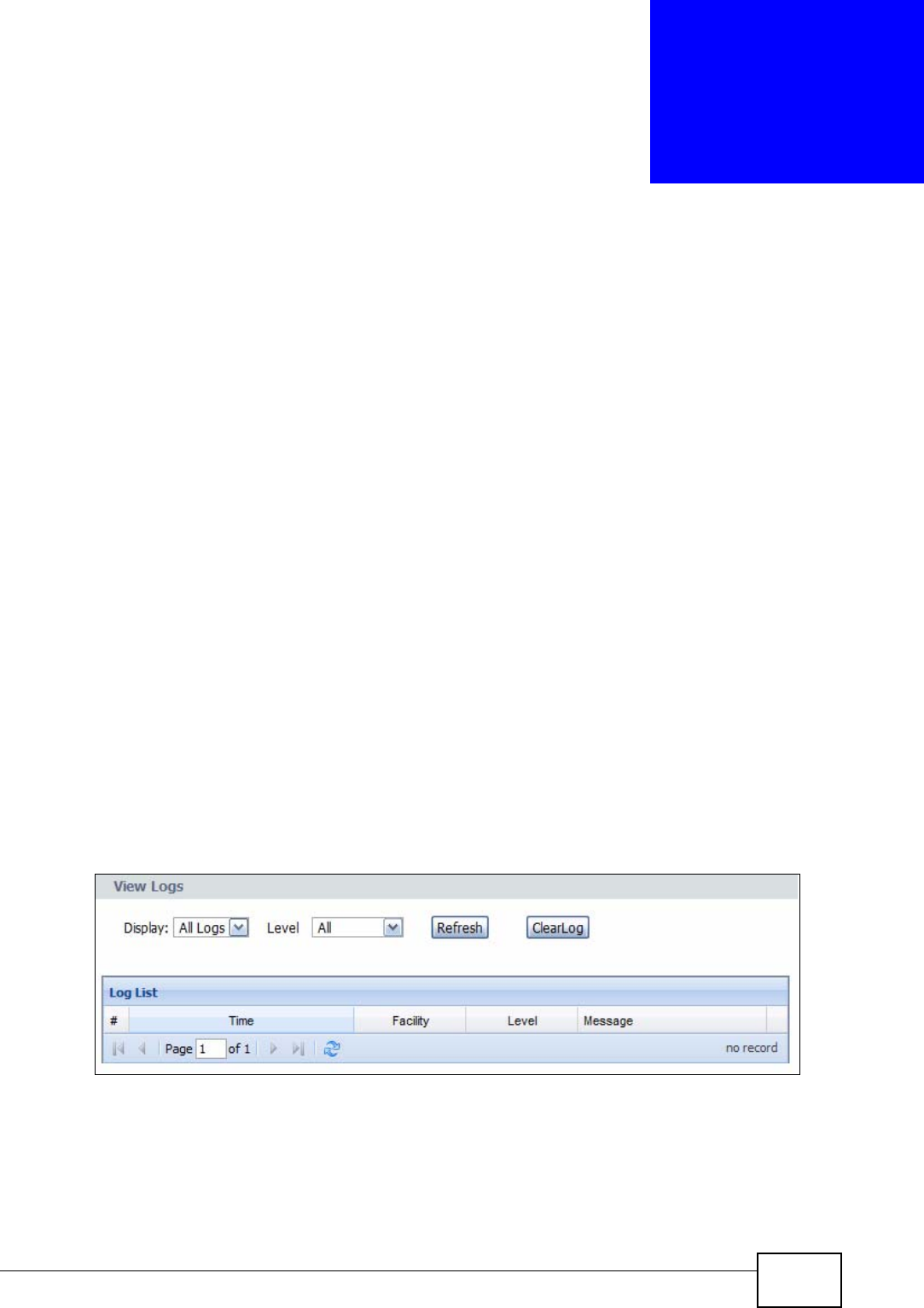
IAD User’s Guide 215
CHAPTER 19
Logs
19.1 Overview
This chapter contains information about configuring general log settings and
viewing the IAD’s logs.
The web configurator allows you to choose which categories of events and/or
alerts to have the IAD log and then display the logs or have the IAD send them to
an administrator (as e-mail) or to a syslog server.
19.2 View Log
Click Maintenance > Logs to open the View Log screen. Use this screen to see
the logs for the categories that you selected in the Log Settings screen (see
Section 19.3 on page 217).
Log entries in red indicate alerts. The log wraps around and deletes the old entries
after it fills. Click a column heading to sort the entries. A triangle indicates
ascending or descending sort order.
Figure 112 View Log

Chapter 19 Logs
IAD User’s Guide
216
The following table describes the fields in this screen.
Table 69 View Log
LABEL DESCRIPTION
Display The categories that you select in the Log Settings screen display in the
drop-down list box.
Select a category of logs to view; select All Logs to view logs from all of
the log categories that you selected in the Log Settings page.
Refresh Click Refresh to renew the log screen.
Clear Log Click Clear Log to delete all the logs.
#This field is a sequential value and is not associated with a specific entry.
Time This field displays the time the log was recorded.
Facility This indicates the type of connection to the IAD.
Facility types are as follows:
•tr069 - This indicates a log from an external auto-configuration
server.
•ntpclient - This indicates a log from the ntpclient.
•login - This indicates a message from the login server.
•udhcpc - This indicates a log message from the device’s DHCP server.
•dnsmasq - This indicates a log message from the device’s DNS
forwarder.
•PPPD - This indicates a log message from the device’s Point-to-Point
Protocol daemon.
•kernel - This indicates a log message related to the device’s Central
Processing Unit (CPU), memory, and I/O ports.
•OMCI - This indicates a log message about the OpenManage Client
Instrumentation.
•VoIP - This indicates a log a message from the SIP server.
Level This indicates the log severity.
Message This field states the reason for the log.
First Click this to cycle to the first page of logs.
Previous Click this to cycle to the previous page of logs.
Page This indicates which page you are on, out of how many. You can enter a
page number here and press [Enter] to jump directly to that page.
Next Click this to cycle to the next page of logs.
Last Click this to cycle to the last page of logs
Refresh Click this to refresh the logs screen.
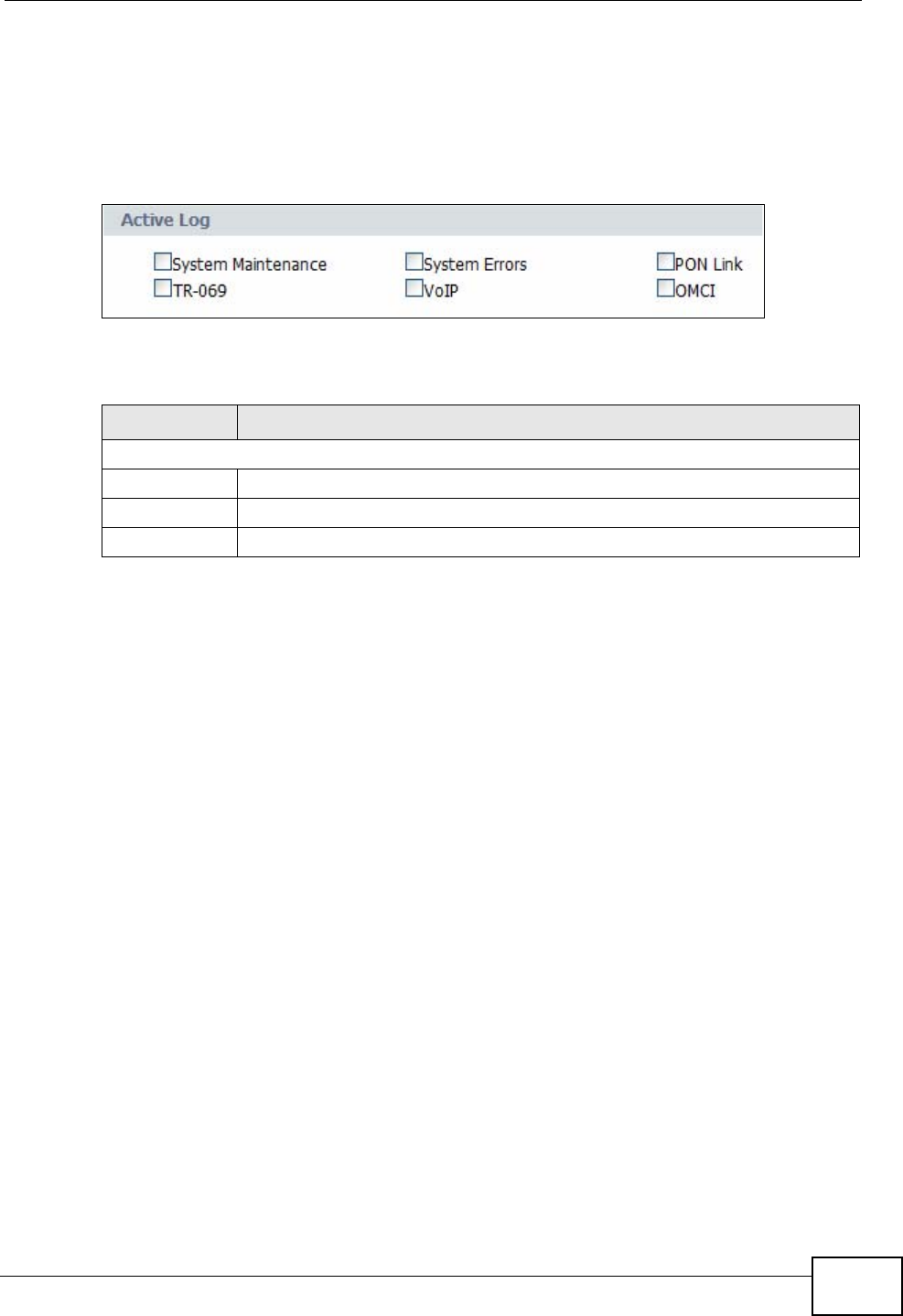
Chapter 19 Logs
IAD User’s Guide 217
19.3 Log Settings
Use this screen to configure which logs to display on the View Logs screen (see
Chapter 19 on page 215). Click Maintenance > Logs > Log Settings.
Figure 113 Log Settings
The following table describes the fields in this screen.
Table 70 Log Settings
LABEL DESCRIPTION
Active Log
[Log Type] Select the type of log you want to be displayed on the View Logs screen.
Apply Click Apply to save your customized settings and exit this screen.
Cancel Click Cancel to return to the previously saved settings.

Chapter 19 Logs
IAD User’s Guide
218

IAD User’s Guide 219
CHAPTER 20
Tools
20.1 Overview
This chapter explains how to upload new firmware, manage configuration files and
restart your IAD.
Use the instructions in this chapter to change the device’s configuration file or
upgrade its firmware. After you configure your device, you can backup the
configuration file to a computer. That way if you later misconfigure the device, you
can upload the backed up configuration file to return to your previous settings.
You can alternately upload the factory default configuration file if you want to
return the device to the original default settings. The firmware determines the
device’s available features and functionality.
20.1.1 Some Warnings
The following are some friendly reminders about your device:
Do NOT turn off the IAD while a firmware upload is in progress!
Only use firmware for your device’s specific model. Refer to the
label on the bottom of your IAD.
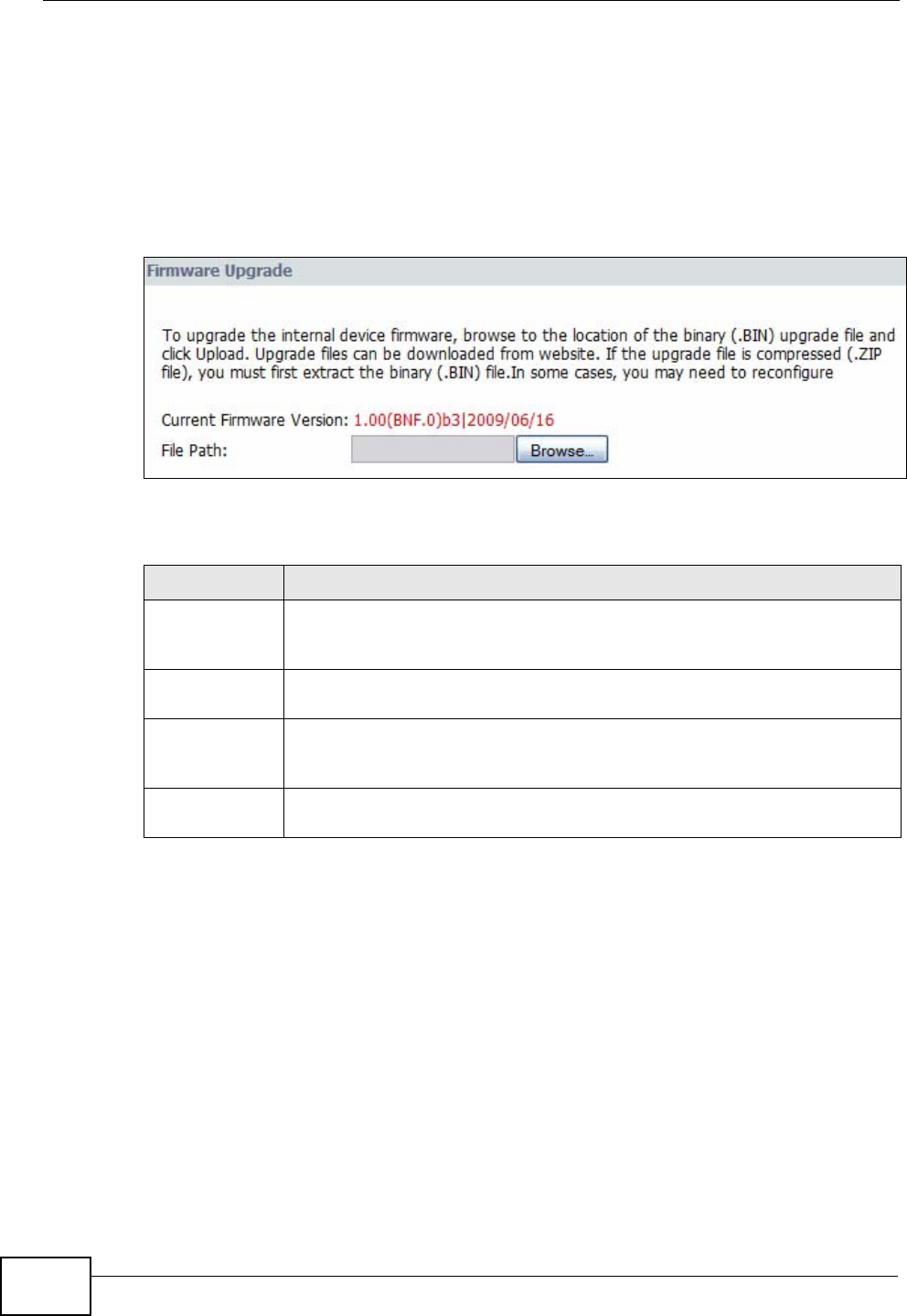
Chapter 20 Tools
IAD User’s Guide
220
20.2 Firmware Upgrade
Click Maintenance > Tools to open the Firmware screen. Follow the
instructions in this screen to upload firmware to your IAD. The upload process
uses HTTP (Hypertext Transfer Protocol) and may take up to two minutes. After a
successful upload, the system will reboot.
Figure 114 Firmware Upgrade
The following table describes the labels in this screen.
After you see the Firmware Upload in Progress screen, wait three minutes
before logging into the IAD again.
The IAD automatically restarts in this time causing a temporary network
disconnect.
After two minutes, log in again and check your new firmware version in the
Status screen.
If the upload was not successful, the following screen will appear. Click Return to
go back to the Firmware screen.
Table 71 Firmware Upgrade
LABEL DESCRIPTION
Current
Firmware
Version
This is the present Firmware version and the date created.
File Path Type in the location of the file you want to upload in this field or click
Browse ... to find it.
Browse... Click Browse... to find the .bin file you want to upload. Remember that
you must decompress compressed (.zip) files before you can upload
them.
Upload Click Upload to begin the upload process. This process may take up to
two minutes.
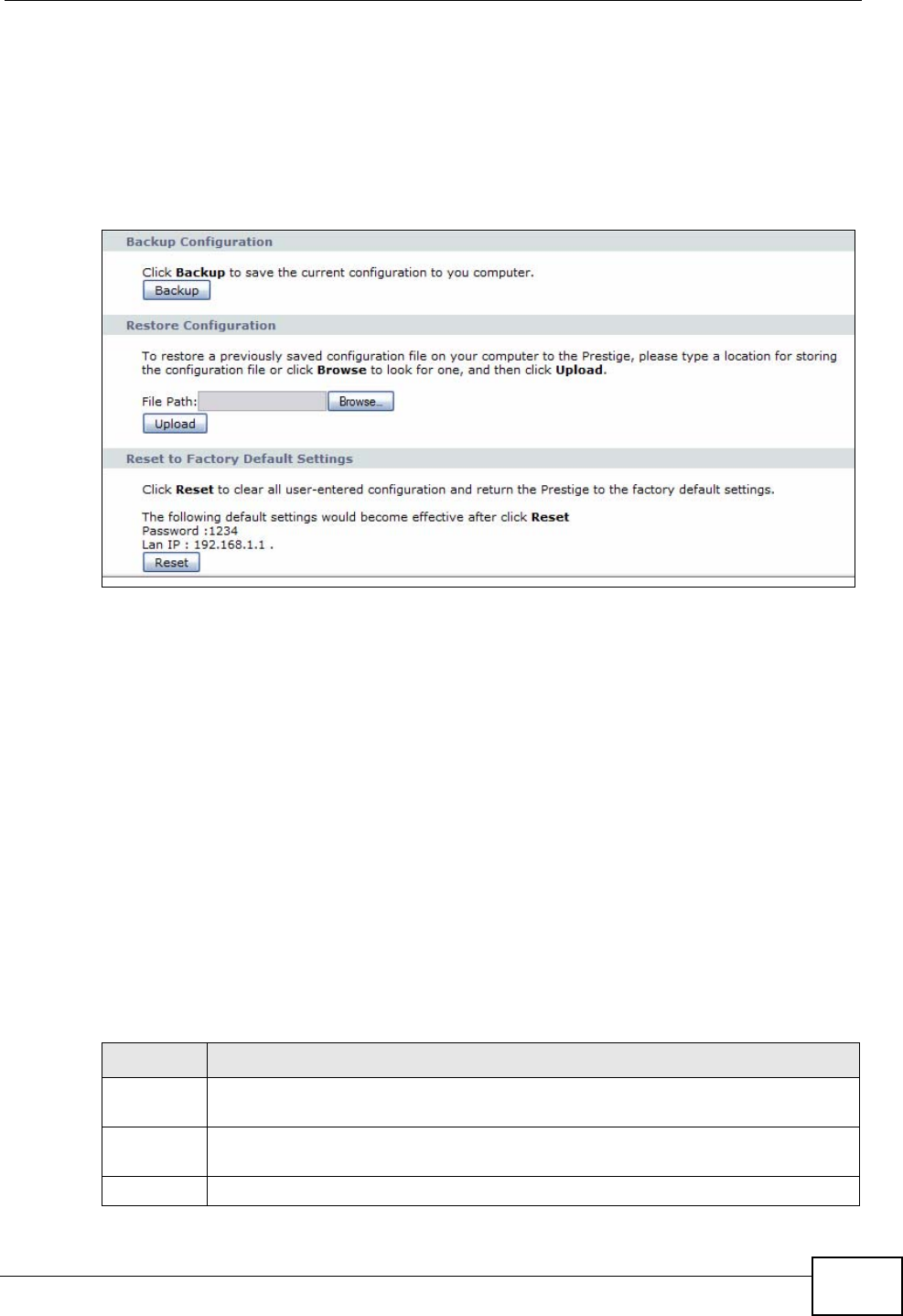
Chapter 20 Tools
IAD User’s Guide 221
20.3 Configuration
Click Maintenance > Tools > Configuration. Information related to factory
defaults, backup configuration, and restoring configuration appears in this screen,
as shown next.
Figure 115 Configuration
20.3.1 Backup Configuration
Backup Configuration allows you to back up (save) the IAD’s current configuration
to a file on your computer. Once your IAD is configured and functioning properly, it
is highly recommended that you back up your configuration file before making
configuration changes. The backup configuration file will be useful in case you
need to return to your previous settings.
Click Backup to save the IAD’s current configuration to your computer.
20.3.2 Restore Configuration
Restore Configuration allows you to upload a new or previously saved
configuration file from your computer to your IAD.
Table 72 Restore Configuration
LABEL DESCRIPTION
File Path Type in the location of the file you want to upload in this field or click
Browse ... to find it.
Browse... Click Browse... to find the file you want to upload. Remember that you must
decompress compressed (.ZIP) files before you can upload them.
Upload Click Upload to begin the upload process.
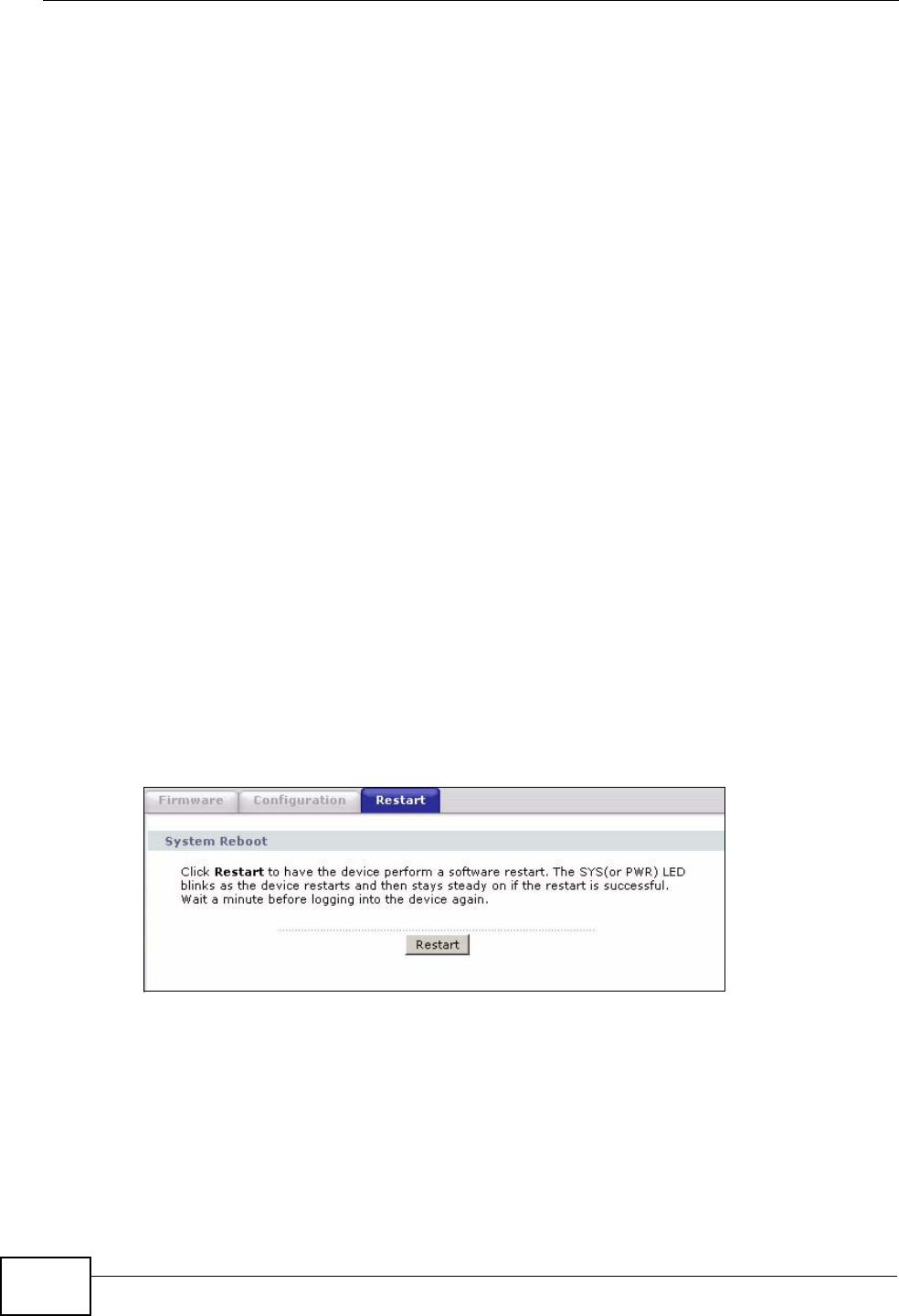
Chapter 20 Tools
IAD User’s Guide
222
After you see a “restore configuration successful” screen, you must then wait one
minute before logging into the IAD again.
The IAD automatically restarts in this time causing a temporary network
disconnect.
If you uploaded the default configuration file you may need to change the IP
address of your computer to be in the same subnet as that of the default device IP
address (10.0.0.138). See Appendix B on page 245 for details on how to set up
your computer’s IP address.
If the upload was not successful, the following screen will appear. Click Return to
go back to the Configuration screen.
20.3.3 Reset to Factory Defaults
Click the Reset button to clear all user-entered configuration information and
return the IAD to its factory defaults. You can also press the RESET button on the
rear panel to reset the factory defaults of your IAD.
20.4 Restart
System restart allows you to reboot the IAD without turning the power off. Click
Maintenance > Tools > Restart. Click Restart to have the IAD reboot. This
does not affect the IAD's configuration.
Figure 116 Restart Screen
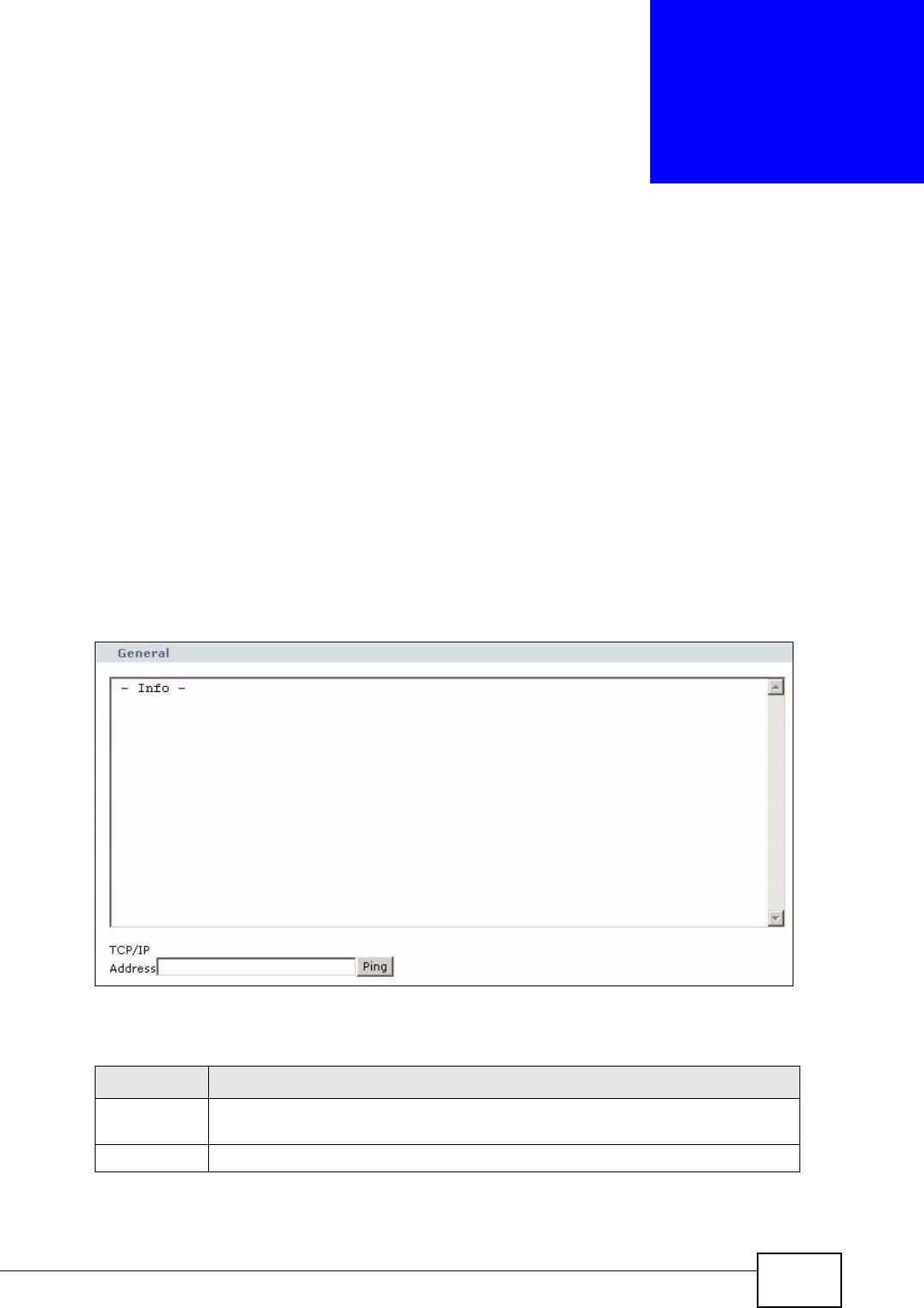
IAD User’s Guide 223
CHAPTER 21
Diagnostic
21.1 Overview
This read-only screen displays information to help you identify problems with the
IAD.
21.2 General
Click Maintenance > Diagnostic to open the screen shown next.
Figure 117 Diagnostic > General
The following table describes the fields in this screen.
Table 73 General
LABEL DESCRIPTION
TCP/IP
Address Type the IP address of a computer that you want to ping in order to test a
connection.
Ping Click this button to ping the IP address that you entered.

Chapter 21 Diagnostic
IAD User’s Guide
224

IAD User’s Guide 225
CHAPTER 22
Troubleshooting
22.1 Overview
This chapter offers some suggestions to solve problems you might encounter. The
potential problems are divided into the following categories.
•Power, Hardware Connections, and LEDs
•IAD Access and Login
•Internet Access
•Phone Calls and VoIP
22.2 Power, Hardware Connections, and LEDs
The IAD does not turn on. None of the LEDs turn on.
1Make sure the IAD is turned on.
2Make sure you are using the power adaptor or cord included with the IAD.
3Make sure the power adaptor or cord is connected to the IAD and plugged in to an
appropriate power source. Make sure the power source is turned on.
4Turn the IAD off and on.
5If the problem continues, contact the vendor.

Chapter 22 Troubleshooting
IAD User’s Guide
226
One of the LEDs does not behave as expected.
1Make sure you understand the normal behavior of the LED. See Section 1.6 on
page 26.
2Check the hardware connections. See the Quick Start Guide.
3Inspect your cables for damage. Contact the vendor to replace any damaged
cables.
4Turn the IAD off and on.
5If the problem continues, contact the vendor.
22.3 IAD Access and Login
I forgot the IP address for the IAD.
1The default IP address is 192.168.1.1.
2If you changed the IP address and have forgotten it, you might get the IP address
of the IAD by looking up the IP address of the default gateway for your computer.
To do this in most Windows computers, click Start > Run, enter cmd, and then
enter ipconfig. The IP address of the Default Gateway might be the IP address
of the IAD (it depends on the network), so enter this IP address in your Internet
browser.
3If this does not work, you have to reset the device to its factory defaults. See
Section 1.5 on page 25.
I cannot see or access the Login screen in the web configurator.
1Make sure you are using the correct IP address.
• The default IP address is 192.168.1.1.
• If you changed the IP address, use the new IP address.

Chapter 22 Troubleshooting
IAD User’s Guide 227
• If you changed the IP address and have forgotten it, see the troubleshooting
suggestions for I forgot the IP address for the IAD.
2Check the hardware connections, and make sure the LEDs are behaving as
expected. See the Quick Start Guide.
3Make sure your Internet browser does not block pop-up windows and has
JavaScripts and Java enabled. See Appendix C on page 275.
4Reset the device to its factory defaults, and try to access the IAD with the default
IP address. See Section 1.5 on page 25.
5If the problem continues, contact the network administrator or vendor, or try one
of the advanced suggestions.
I can see the Login screen, but I cannot log in to the IAD.
1Make sure you have entered the user name and password correctly. The default
user name is admin. These fields are case-sensitive, so make sure [Caps Lock] is
not on.
2You cannot log in to the web configurator while someone is using Telnet to access
the IAD. Log out of the IAD in the other session, or ask the person who is logged
in to log out.
3Turn the IAD off and on.
4If this does not work, you have to reset the device to its factory defaults. See
Section 22.2 on page 225.
22.4 Internet Access
I cannot access the Internet.
1Check the hardware connections, and make sure the LEDs are behaving as
expected. See the Quick Start Guide and Section 1.6 on page 26.
2Make sure you entered your ISP account information correctly in the wizard. These
fields are case-sensitive, so make sure [Caps Lock] is not on.

Chapter 22 Troubleshooting
IAD User’s Guide
228
3Disconnect all the cables from your device, and follow the directions in the Quick
Start Guide again.
4If the problem continues, contact your ISP.
I cannot access the Internet anymore. I had access to the Internet (with the IAD),
but my Internet connection is not available anymore.
1Check the hardware connections, and make sure the LEDs are behaving as
expected. See the Quick Start Guide and Section 1.6 on page 26.
2Turn the IAD off and on.
3If the problem continues, contact your ISP.
The Internet connection is slow or intermittent.
1There might be a lot of traffic on the network. Look at the LEDs, and check Section
1.6 on page 26. If the IAD is sending or receiving a lot of information, try closing
some programs that use the Internet, especially peer-to-peer applications.
2Turn the IAD off and on.
3If the problem continues, contact the network administrator or vendor, or try one
of the advanced suggestions.
22.5 Phone Calls and VoIP
The telephone port won’t work or the telephone lacks a dial tone.
1Check the telephone connections and telephone wire.

Chapter 22 Troubleshooting
IAD User’s Guide 229
I can access the Internet, but cannot make VoIP calls.
1The PHONE light should come on. Make sure that your telephone is connected to
the PHONE port.
2You can also check the VoIP status in the Status screen.
3If the VoIP settings are correct, use speed dial to make peer-to-peer calls. If you
can make a call using speed dial, there may be something wrong with the SIP
server, contact your VoIP service provider.

Chapter 22 Troubleshooting
IAD User’s Guide
230
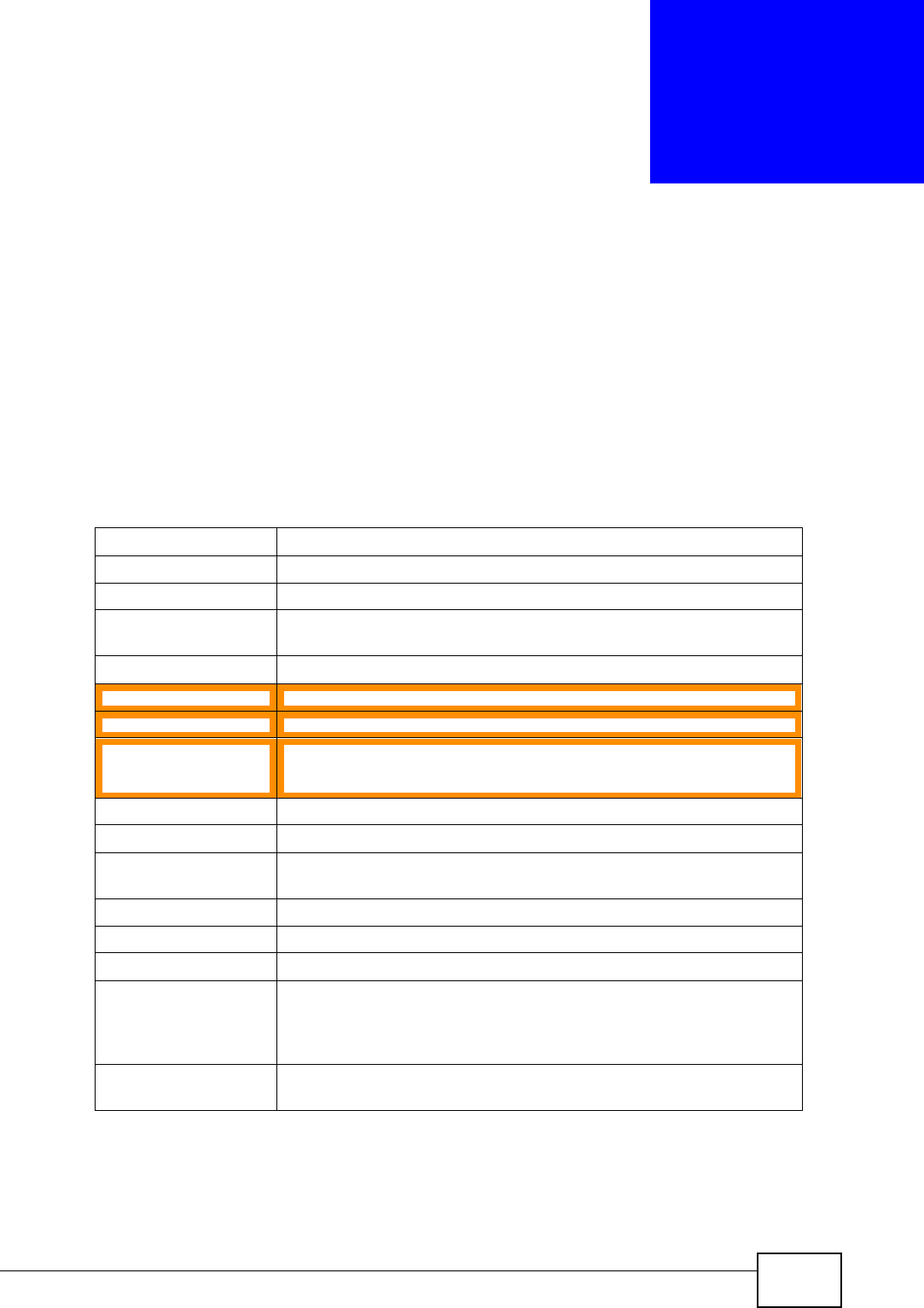
IAD User’s Guide 231
CHAPTER 23
Product Specifications
The following tables summarize the IAD’s hardware and firmware features.
Hardware Specifications
Table 74 Hardware Specifications
Dimensions 215 W x 145 D x 35 H mm
Weight 390 g
Power Specification 18V DC 1A
Built-in Switch Four auto-negotiating, auto MDI/MDI-X 10/100 Mbps RJ-45
Ethernet ports
PHONE Port 2 RJ-11 FXS POTS ports
CATV Port 1 F-type coaxial connector
Antennas 2 attached external dipole antennas, 2dBi
WPS Button 1 second: turn on or off WLAN
5 seconds: enable WPS (Wi-Fi Protected Setup)
RESET Button Restores factory defaults
PON Port 1 SC/UPC type fiber-optic connector
Operation
Temperature 0º C ~ 40º C
Storage Temperature -20º ~ 60º C
Operation Humidity 20% ~ 85% RH
Storage Humidity 20% ~ 90% RH
Distance between the
centers of the holes
(for wall-mounting)
on the device’s back
137.20mm
Screw size for wall-
mounting M4 tap

Chapter 23 Product Specifications
IAD User’s Guide
232
Voice Specifications
Note: To take full advantage of the supplementary phone services available through
the IAD's phone port, you may need to subscribe to the services from your VoIP
service provider.
Note: Not all features are supported by all service providers. Consult your service
provider for more information.
Table 75 Voice Features
Call Park and
Pickup Call park and pickup lets you put a call on hold (park) and then
continue the call (pickup). The caller must still pay while the call is
parked.
When you park the call, you enter a number of your choice (up to
eight digits), which you must enter again when you pick up the call. If
you do not enter the correct number, you cannot pickup the call. This
means that only someone who knows the number you have chosen
can pick up the call.
You can have more than one call on hold at the same time, but you
must give each call a different number.
Call Return With call return, you can place a call to the last number that called
you (either answered or missed). The last incoming call can be
through either SIP or PSTN.
Country Code Phone standards and settings differ from one country to another, so
the settings on your IAD must be configured to match those of the
country you are in. The country code feature allows you to do this by
selecting the country from a list rather than changing each setting
manually. Configure the country code feature when you move the IAD
from one country to another.
Do not Disturb
(DnD) This feature allows you to set your phone not to ring when someone
calls you. You can set each phone independently using its keypad, or
configure global settings for all phones using the command line
interpreter.
Auto Dial You can set the IAD to automatically dial a specified number
immediately whenever you lift a phone off the hook. Use the Web
Configurator to set the specified number. Use the command line
interpreter to have the IAD wait a specified length of time before
dialing the number.
Phone config The phone config table allows you to customize the phone keypad
combinations you use to access certain features on the IAD, such as
call waiting, call return, call forward, etc. The phone config table is
configurable in command interpreter mode.
HTTP pincode If your service provider uses an auto provisioning server, you need to
enter a personal identification number (supplied by your service
provider) before you first use the feature.

Chapter 23 Product Specifications
IAD User’s Guide 233
Firmware update
enable / disable If your service provider uses this feature, you hear a recorded
message when you pick up the phone when new firmware is available
for your IAD. Enter *99# in your phone’s keypad to have the IAD
upgrade the firmware, or enter #99# to not upgrade. If your service
provider gave you different numbers to use, enter them instead. If
you enter the code to not upgrade, you can make a call as normal.
You will hear the recording again each time you pick up the phone,
until you upgrade.
Call waiting This feature allows you to hear an alert when you are already using
the phone and another person calls you. You can then either reject
the new incoming call, put your current call on hold and receive the
new incoming call, or end the current call and receive the new
incoming call.
Call forwarding With this feature, you can set the IAD to forward calls to a specified
number, either unconditionally (always), when your number is busy,
or when you do not answer. You can also forward incoming calls from
one specified number to another.
Caller ID The IAD supports caller ID, which allows you to see the originating
number of an incoming call (on a phone with a suitable display).
REN A Ringer Equivalence Number (REN) is used to determine the number
of devices (like telephones or fax machines) that may be connected
to the telephone line. Your device has a REN of three, so it can
support three devices per telephone port.
Dynamic Jitter
Buffer The built-in adaptive buffer helps to smooth out the variations in
delay (jitter) for voice traffic. This helps ensure good voice quality for
your conversations.
Multiple SIP
Accounts You can simultaneously use multiple voice (SIP) accounts and assign
them to to the telephone port.
Multiple Voice
Channels Your device can simultaneously handle multiple voice channels
(telephone calls). Additionally you can answer an incoming phone call
on a VoIP account, even while someone else is using the account for a
phone call.
Voice Activity
Detection/Silence
Suppression
Voice Activity Detection (VAD) reduces the bandwidth that a call uses
by not transmitting when you are not speaking.
Comfort Noise
Generation Your device generates background noise to fill moments of silence
when the other device in a call stops transmitting because the other
party is not speaking (as total silence could easily be mistaken for a
lost connection).
Table 75 Voice Features
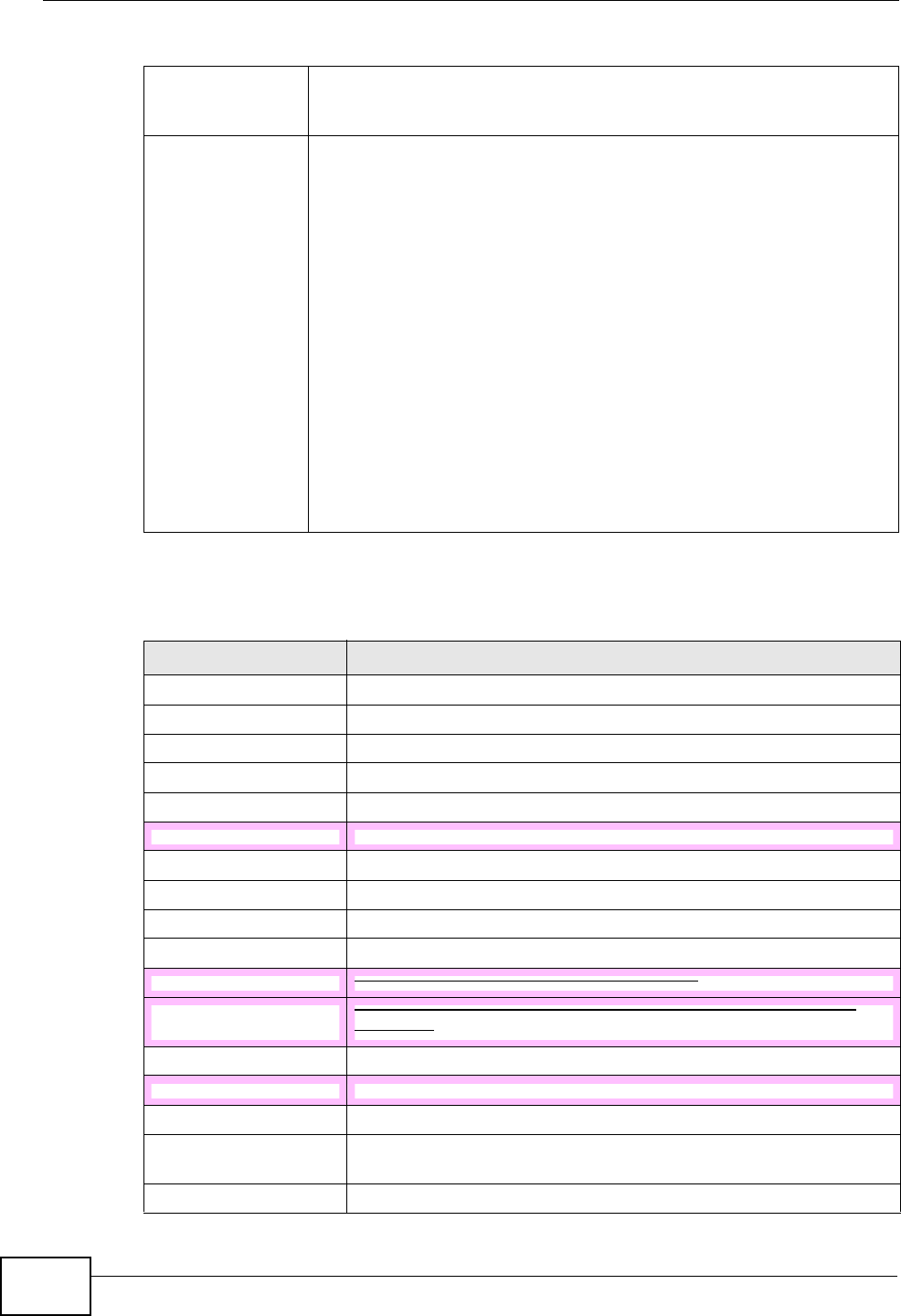
Chapter 23 Product Specifications
IAD User’s Guide
234
The following list, which is not exhaustive, illustrates the standards supported in
the IAD.
Echo Cancellation You device supports G.168, an ITU-T standard for eliminating the
echo caused by the sound of your voice reverberating in the
telephone receiver while you talk.
Other Voice
Features SIP version 2 (Session Initiating Protocol RFC 3261)
SDP (Session Description Protocol RFC 2327)
RTP (RFC 1889)
RTCP (RFC 1890)
Voice codecs (coder/decoders) G.711, G.726, G.729
Fax and data modem discrimination
DTMF Detection and Generation
DTMF: In-band and Out-band traffic (RFC 2833),(PCM), (SIP INFO)
Point-to-point call establishment between two IADs
Quick dialing through predefined phone book, which maps the phone
dialing number and destination URL.
Flexible Dial Plan (RFC3525 section 7.1.14)
Table 76 Standards Supported
STANDARD DESCRIPTION
RFC 867 Daytime Protocol
RFC 868 Time Protocol.
RFC 1058 RIP-1 (Routing Information Protocol)
RFC 1112 IGMP v1
RFC 1305 Network Time Protocol (NTP version 3)
RFC 1483 Multiprotocol Encapsulation over ATM Adaptation Layer 5
RFC 1631 IP Network Address Translator (NAT)
RFC 1661 The Point-to-Point Protocol (PPP)
RFC 1723 RIP-2 (Routing Information Protocol)
RFC 2236 Internet Group Management Protocol, Version 2.
RFC 2364 PPP over AAL5 (PPP over ATM over ADSL)
RFC 2408 Internet Security Association and Key Management Protocol
(ISAKMP)
RFC 2516 A Method for Transmitting PPP Over Ethernet (PPPoE)
RFC 2684 Multiprotocol Encapsulation over ATM Adaptation Layer 5.
RFC 2766 Network Address Translation - Protocol
IEEE 802.11d Standard for Local and Metropolitan Area Networks: Media
Access Control (MAC) Bridges
IEEE 802.11x Port Based Network Access Control.
Table 75 Voice Features

Chapter 23 Product Specifications
IAD User’s Guide 235
Power Adaptor Specifications
ANSI T1.413, Issue 2 Asymmetric Digital Subscriber Line (ADSL) standard.
Microsoft PPTP MS PPTP (Microsoft's implementation of Point to Point Tunneling
Protocol)
RFC 2383 ST2+ over ATM Protocol Specification - UNI 3.1 Version
1.363.5 Compliant AAL5 SAR (Segmentation And Re-assembly)
Table 76 Standards Supported (continued)
STANDARD DESCRIPTION
Table 77 Power Adaptor Specifications
North American PLUG
standards LEI (LEADER ELECTRONICS INC.)
AC Power Adapter Model MU18-2180100-A1
Input Power AC 100~240Volts/50/60Hz/0.6A
Output Power DC 18Volts/1A
Power Consumption 16 Watt max
Safety Standards UL,CUL(UL 60950-1)
EUROPEAN PLUG
STANDARDS
AC Power Adapter Model MU18-Y1180-K105
Input Power AC 230V~50Hz 0.5A
Output Power DC 18Volts/1A
Power Consumption 16 Watt max
Safety Standards TUV, CE(EN 60950-1)
UNITED KINGDOM PLUG
STANDARDS
AC Power Adapter Model MU18-2180100-B2
Input Power AC 100~240Volts/50/60Hz/0.6A
Output Power DC 18Volts/1A
Power Consumption 12 Watt max
Safety Standards TUV, CE(EN 60950-1)

Chapter 23 Product Specifications
IAD User’s Guide
236
G-PON Specification
Wall-mounting Instructions
Do the following to hang your IAD on a wall.
Note: See Table 74 on page 231 for the size of screws to use and how far apart to
place them.
1Locate a high position on a wall that is free of obstructions. Use a sturdy wall.
2Drill two holes for the screws. Make sure the distance between the centers of the
holes matches what is listed in the product specifications appendix.
Be careful to avoid damaging pipes or cables located inside the
wall when drilling holes for the screws.
3Do not screw the screws all the way into the wall. Leave a small gap of about 0.5
cm between the heads of the screws and the wall.
4Make sure the screws are snugly fastened to the wall. They need to hold the
weight of the IAD with the connection cables.
Table 78 G-PON Specifications
SPECIFICATION DESCRIPTION
Standard IEEE 802.3ah
Upstream Bit Rate 1.25 Gb/s
Downstream Bit Rate 1.25 Gb/s
Distance 10 Km/20 Km
Power Budget Class A: 5~20 dB
Class B: 10~25 dB
Wavelength Allocation Up: 1260~1360 nm
Down: 1480~1500 nm
Splitter Ratio >16
FEC Not Supported
DBA Not Supported
Encryption Not Supported
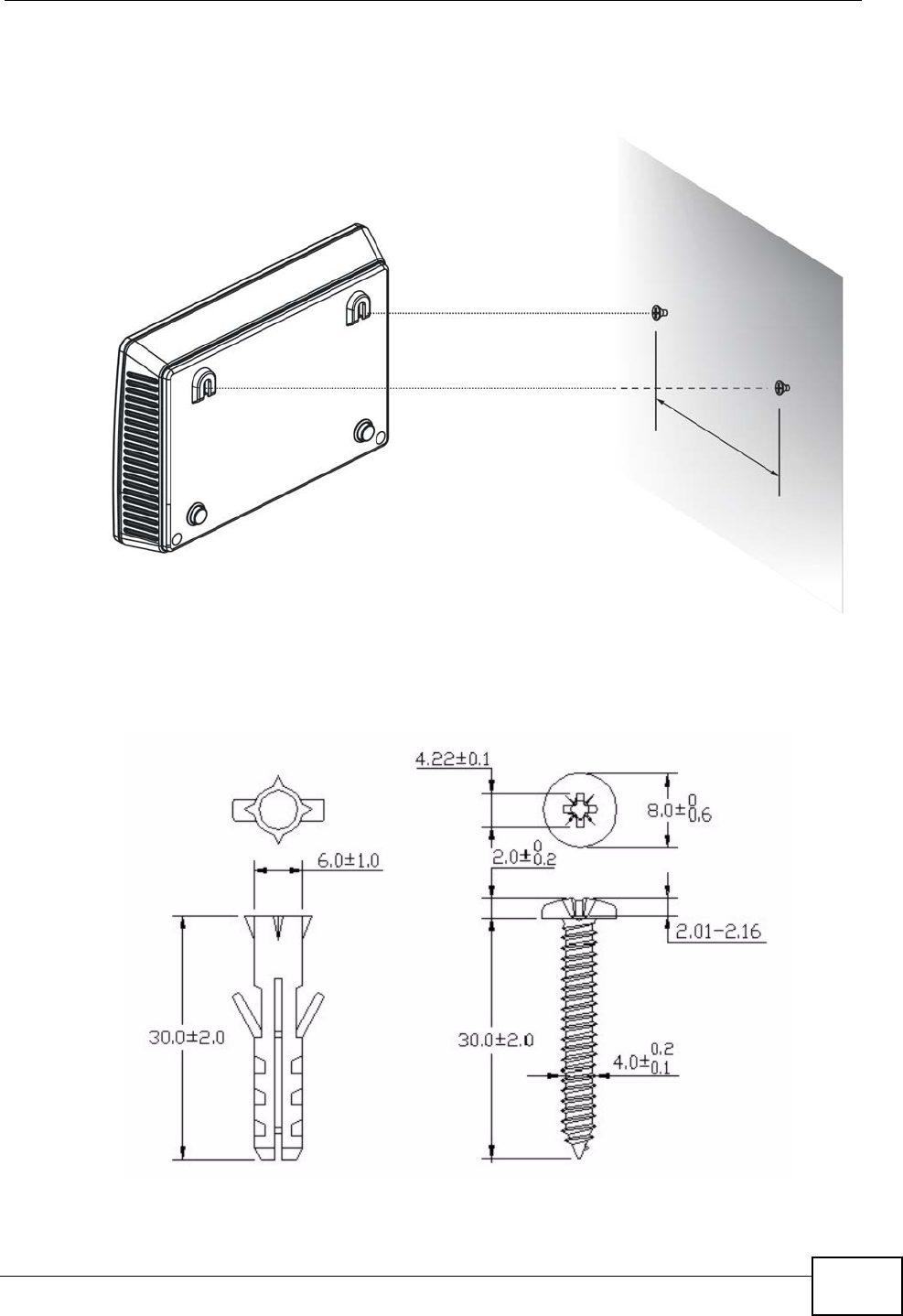
Chapter 23 Product Specifications
IAD User’s Guide 237
5Align the holes on the back of the IAD with the screws on the wall. Hang the IAD
on the screws.
Figure 118 Wall-mounting Example
The following are dimensions of an M4 tap screw and masonry plug used for wall
mounting. All measurements are in millimeters (mm).
Figure 119 Masonry Plug and M4 Tap Screw

Chapter 23 Product Specifications
IAD User’s Guide
238

IAD User’s Guide 239
APPENDIX A
Passive Optical Networks
Optical fiber allows for data to be transmitted in the form of staggered light
impulses. It is composed of flexible plastic or glass piping. Light waves traverse
the length of the piping by perpetually reflecting itself off of its mirrored inner
core, much like an optical waveguide.
The most common application for optical fiber is as a medium to transmit digital
information from one location to another over great distances. However, one of
the drawbacks of this medium is that light attenuates and eventually loses its
coherency. The great challenge in optical fiber research lies in the development of
fiber cables capable of minimizing this light attenuation for as long as physically
possible. Despite this, optical fiber technology remains on the cutting edge of
network communications development.
Optical fiber offers enormous benefits in terms of speed, quality, and quantity over
other methods such as copper wire, and is the core technology behind the Passive
Optical Network (PON).
What You Need to Know
The following terms and concepts may help as you read through this chapter.
PON
A Passive Optical Network (PON) sends fiber optical cables from a service provider
to the premises. "Passive" means that no power is required once the data, which
is transmitted as light, enters the cables.
ONU
An Optical Network Unit (ONU) is a fiber optical modem that allows a subscriber or
client to receive very high-speed Internet access.

Appendix A Passive Optical Networks
IAD User’s Guide
240
OLT
An Optical Line Terminal (OLT) is placed at a broadband service provider’s central
office, where it receives voice, video, and other data from the service provider’s
networking servers. It then converts and transmits this data as light across a fiber
optical network, where it is received and translated on the opposite end by one or
more Optical Network Units (ONUs).
FTTx
Fiber-To-The-x (FTTx) refers to networking infrastructure that extends from a
service provider to the x, where x can be one of many locations: Office (FTTO),
Home (FTTH), Desk (FTTD), Building (FTTB) or even Curb (FTTC), to name a few.
In an FTTO connection, the Optical Network Unit (ONU) is often placed inside the
building, whereas in FTTH or FTTC the fiber ends at an end-user’s house (or
somewhere nearby), or at a curb-side unit.
Gigabit Ethernet
Gigabit Ethernet (IEEE 802.3z standard) uses Ethernet over copper wire
technology to increase network data rates to 1 Gbit/sec. It is built upon standard
4-pair Category 5 copper cabling.
GEM
The Generic Encapsulation Method (GEM) provides a method for PON devices to
natively transmit both Ethernet and TDM data over optical fiber.
ATM
Asynchronous Transfer Method (ATM) is a LAN and WAN networking technology
that provides high-speed data transfer. ATM uses fixed-size packets of information
called cells. With ATM, a high QoS (Quality of Service) can be guaranteed.
TDM
In Time Division Multiplexing (TDM), individual data subchannels can occupy the
entire frequency bandwidth of a communication stream at certain specific times,
and cannot transmit at other times. Each subchannel takes turns using the
communications stream. TDM is typically used in FTTx and satellite
communication.
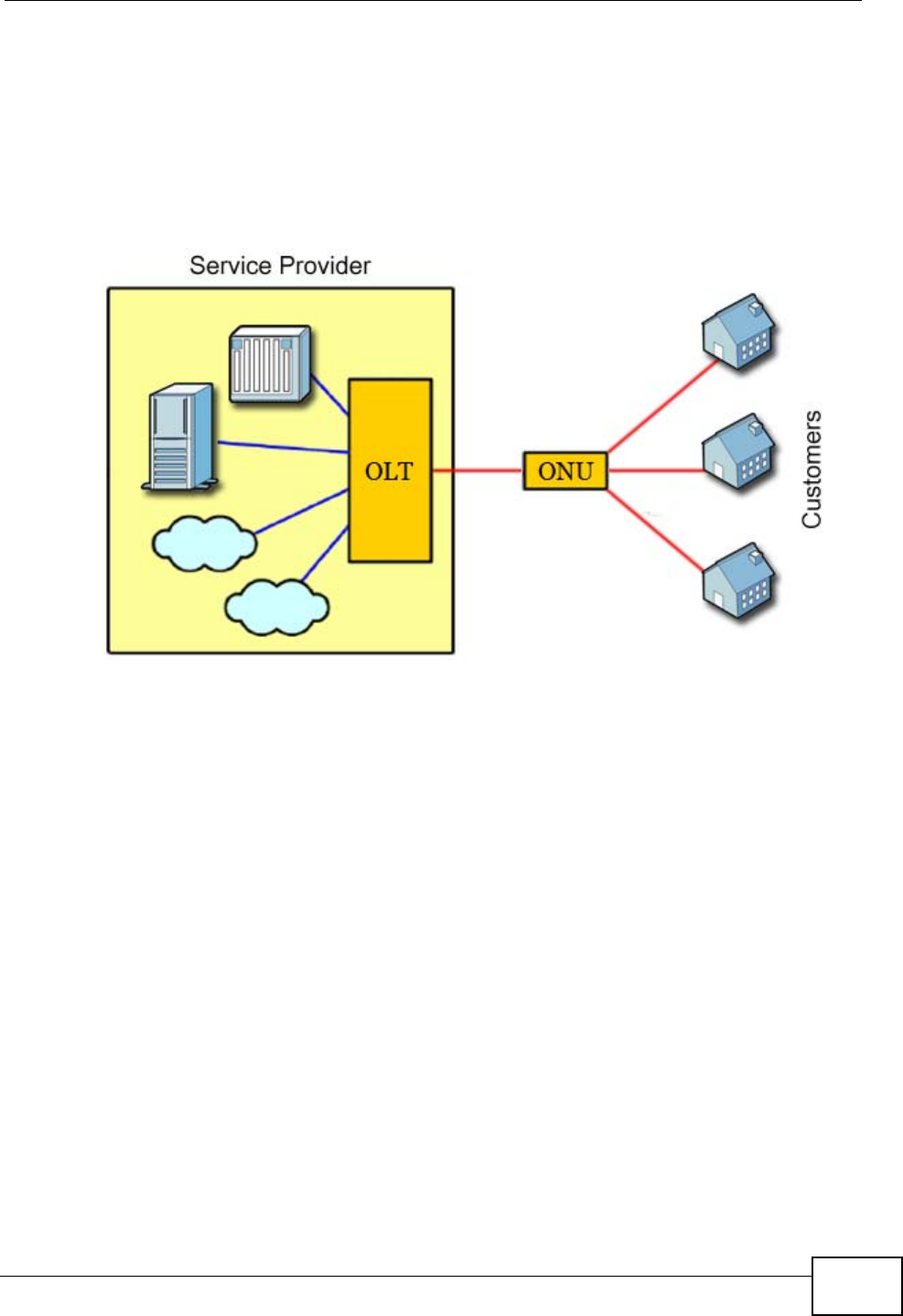
Appendix A Passive Optical Networks
IAD User’s Guide 241
How It Works
There are no active components in the PON backbone that require power. Light
impulses move from point A to point B with nothing inbetween to facilitate it other
than optical physics. Although the devices at the point of origin and the point of
termination undoubtedly require power, the network itself does not.
Figure 120 An example of Passive Optical Networking
In this example, the PON consists of: one or more Optical Line Terminals (OLTs)
located at the service provider’s central office (A) to convert and transmit data; a
network of fiber optical cables to passively carry the data (B); and one or more
Optical Network Units (ONUs) at the subscriber end to receive the data (C).
PON Development
As a technology, PON has been around for quite some time although it was initially
unusable for network communications.
One of the original improvements made to it was Asynchronous Transfer Method
PON (ATM PON, more commonly called APON). The benefit of using a well
established networking protocol (such as ATM in this case) to enhance the fiber
network is that it is usually backwards-compatible with an existing Wide Area
Network (WAN). Unfortunately, ATM has fallen out of favor due to its relative
complexity and the rapid rise in popularity of the Internet Protocol (IP), which is
both less complex and more cost effective due to the ubiquitousness of the
hardware that supports it. A more robust off-shoot of APON offering faster
transmission speeds is Broadband PON (BPON).
A
B
C

Appendix A Passive Optical Networks
IAD User’s Guide
242
Ethernet PON (EPON), meanwhile, offers slightly slower data transmission rates
but shows a smaller overhead and is markedly better at transmitting over the
Ethernet layer using IP. Because Ethernet is so widespread and relies on a well-
established universal networking protocol, manufacturers can use existing
hardware to build EPON units, making it a very cost effective solution in
comparison to the other types of PON devices available. Moreover, Ethernet cables
(RJ-45) and infrastructure already exist in many office buildings, so making the
transition to EPON is even easier.
GEPON is the other name by which EPON is known and marketed. For all intents
and purposes, it is the same. Both fall under the purview of the IEEE802.3ah
specification.
Gigabit Ethernet PON (GPON) offers a speed boost over APON/BPON and EPON. It
retains ATM compatibility in addition to offering Time-Division Multiplexing (TDM).
It can utilize both the ATM and Ethernet transport layers, but only by emulating
them with the Generic Encapsulation Protocol (GEM).
The following table outlines the major differences between the three PON
protocols.
PON Limitations
The most significant limitation of PON is something known as “attenuation.” This is
the gradual decrease in signal strength as the light wave passes down the fiber
optical cable stemming from a combination of absorption and scattering.
Table 79 PON Types Comparison
PARAMETERS EPON/GEPON APON/BPON GPON
Standard IEEE802.3ah ITU-T (FSAN) ITU-T SG15 (FSAN)
Standardization Date 2004.07 1998 ITU.T G.983 2003.11 ITU.T
G.984
Speed 1 Gbps 155/622 Mbps
622/1244 Mbps
1.25 Gbps
symmetric and
higher (up to 2.488
Gbps)
Basic Protocol Ethernet ATM Ethernet/ATM/TDM
Protocol Overhead for
IP Small Large Middle
US MAC Scheme TDMA TDMA TDMA
Coding Line 8B/10B Scramble NRZ Scramble NRZ
BER 10-12 10-10 10-12
ODN Type Type1, Type2 Class A, B Class A, B, C
Max Reach Type1 up to 10 km
Type2 up to 20 km
20 km 20 km (Max 60 km
for ranging
protocol)
Standard Driver Vendors Service Provider Service Provider

Appendix A Passive Optical Networks
IAD User’s Guide 243
Absorption happens as the light’s energy is converted into heat; scattering occurs
when the light hits stray particles of other matter inside the cable and some its
photons are redirected in other directions. As a result, the further the light in the
pipe travels, the less coherent it becomes and eventually it disintegrates. In
current PON implementations, there are two standard distances that a service
provider can choose: 1-10 kilometers and 1-20 kilometers. Light does not
attentuate differently over the greater of the two distances; rather, the service
provider simply uses much more powerful equipment to transmit the light signals
into the network, thus boosting the relative signal strength to such a point that
attentuation does not set in as rapidly.
The other major limitation is the “splitting.” To make the most of available
bandwidth, service providers must split a backbone line into many smaller lines
which are then extended to multiple customers.
For example, a backbone line leaving the service provider’s central office may split
twice, sending subsidiary lines to branch office ONUs or secondary OLTs. These, in
turn, can be split again and again until a certain number of customers have been
served. However, each time a light signal is split each subsequent subsidiary beam
is at a markedly lower intensity than the original. If a service provider’s maximum
bandwith allocation is approximately 60 Mbps/sec (the physical limitation of the
fiber), this bandwidth must be shared among all customers connected to the
backbone. If only one customer is connected, they reap the benefits of full 60
Mbps/sec bandwidth; on the other hand, if the service provider splits the signal so
that three customers in three disparate locations can benefit, each one only
receives ~20 Mbps/sec of bandwidth because of the tripartite split. The maximum
number of splits that a service provider can make is 64, at which point the data
flood from the signal source becomes but a trickle by the time it reaches the end
of its journey.
Bit Rate Requirements
The kind of transmission speeds a PON provides depends primarily on the kind of
network your service provider maintains and any bandwidth limits it enforces (if it
does so at all). Various programs and applications can take advantage of the
network’s bandwidth as long as it meets their requirements.
Below is a table listing the minimum bit rates various types of applications require
in order to operate at their full potential over a PON. If you are not sure about

Appendix A Passive Optical Networks
IAD User’s Guide
244
your connection speeds, check with your service provider or network
administrator.
Table 80 Applications and Required Bit Rates
APPLICATION MINIMUM BIT RATE
Voice over Internet Protocol (VoIP) 16 kbps
Full-screen Video Conferenceing (H.263) 384 kbps
Basic Web Browsing 1 Mbps
5-Megapixel JPG in 10 seconds 1.5 Mbps
SDTV (MPEG-2) 4 Mbps
SDTV (MPEG-4) 1.5 Mbps
HDTV (MPEG-2) 15 Mbps
HDTV (MPEG-4) 7-9 Mbps

IAD User’s Guide 245
APPENDIX B
Setting Up Your Computer’s IP
Address
Note: Your specific IAD may not support all of the operating systems described in this
appendix. See the product specifications for more information about which
operating systems are supported.
This appendix shows you how to configure the IP settings on your computer in
order for it to be able to communicate with the other devices on your network.
Windows Vista/XP/2000, Mac OS 9/OS X, and all versions of UNIX/LINUX include
the software components you need to use TCP/IP on your computer.
If you manually assign IP information instead of using a dynamic IP, make sure
that your network’s computers have IP addresses that place them in the same
subnet.
In this appendix, you can set up an IP address for:
•Windows XP/NT/2000 on page 245
•Windows Vista on page 249
•Windows 7 on page 253
•Mac OS X: 10.3 and 10.4 on page 257
•Mac OS X: 10.5 and 10.6 on page 261
•Linux: Ubuntu 8 (GNOME) on page 264
•Linux: openSUSE 10.3 (KDE) on page 269
Windows XP/NT/2000
The following example uses the default Windows XP display theme but can also
apply to Windows 2000 and Windows NT.
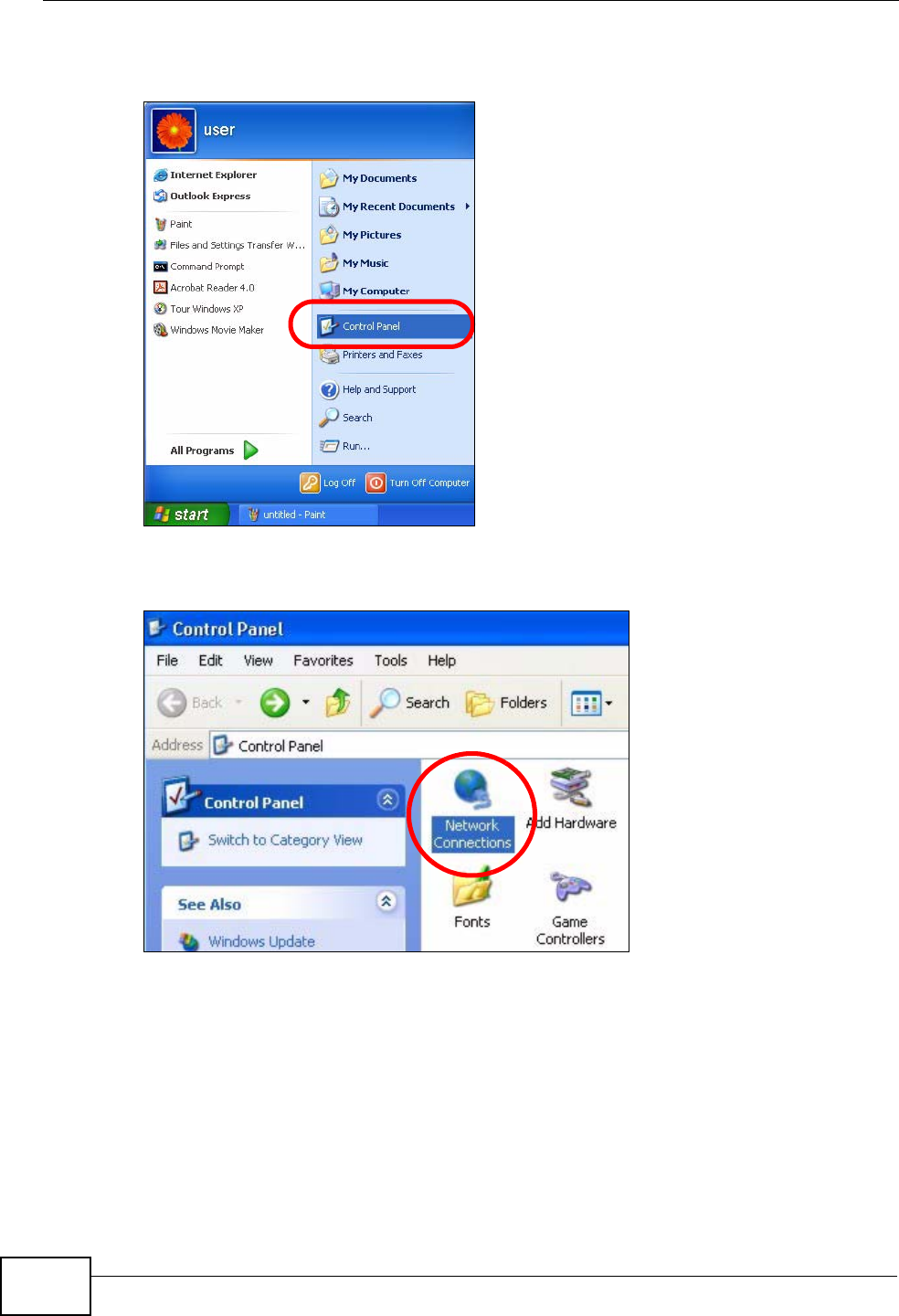
Appendix B Setting Up Your Computer’s IP Address
IAD User’s Guide
246
1Click Start > Control Panel.
Figure 121 Windows XP: Start Menu
2In the Control Panel, click the Network Connections icon.
Figure 122 Windows XP: Control Panel
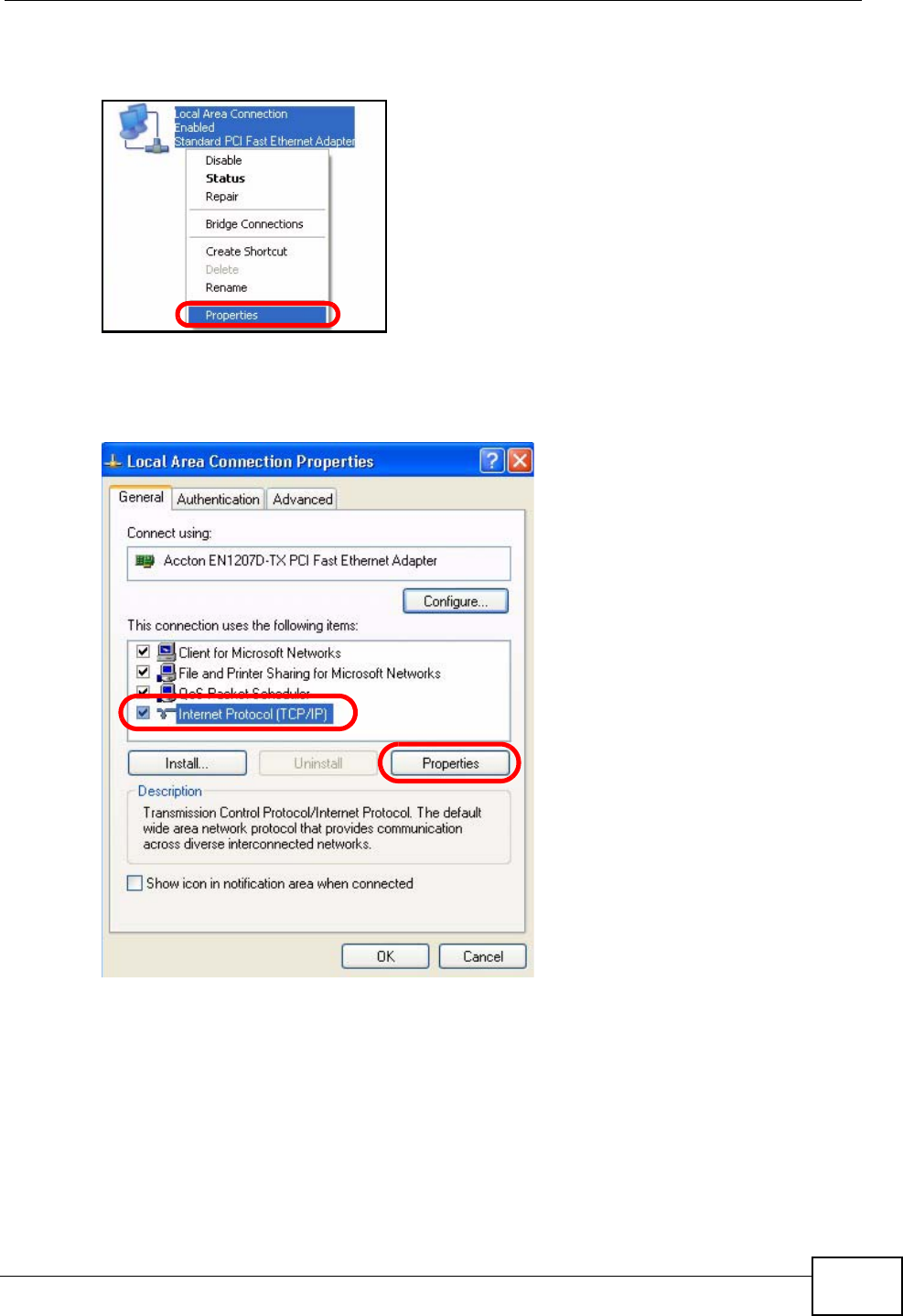
Appendix B Setting Up Your Computer’s IP Address
IAD User’s Guide 247
3Right-click Local Area Connection and then select Properties.
Figure 123 Windows XP: Control Panel > Network Connections > Properties
4On the General tab, select Internet Protocol (TCP/IP) and then click
Properties.
Figure 124 Windows XP: Local Area Connection Properties
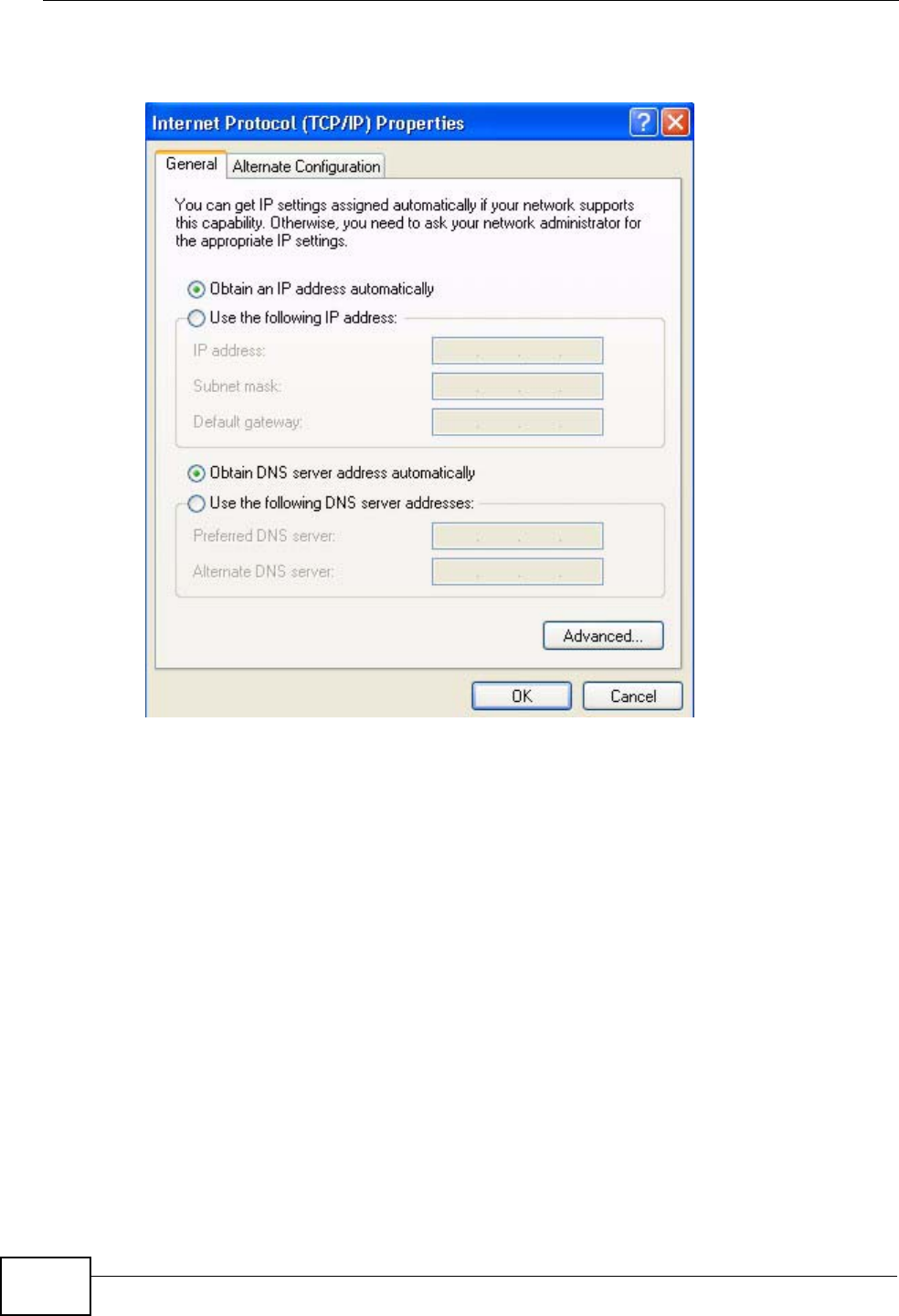
Appendix B Setting Up Your Computer’s IP Address
IAD User’s Guide
248
5The Internet Protocol TCP/IP Properties window opens.
Figure 125 Windows XP: Internet Protocol (TCP/IP) Properties
6Select Obtain an IP address automatically if your network administrator or ISP
assigns your IP address dynamically.
Select Use the following IP Address and fill in the IP address, Subnet mask,
and Default gateway fields if you have a static IP address that was assigned to
you by your network administrator or ISP. You may also have to enter a Preferred
DNS server and an Alternate DNS server, if that information was provided.
7Click OK to close the Internet Protocol (TCP/IP) Properties window.
8Click OK to close the Local Area Connection Properties window.
Verifying Settings
1Click Start > All Programs > Accessories > Command Prompt.
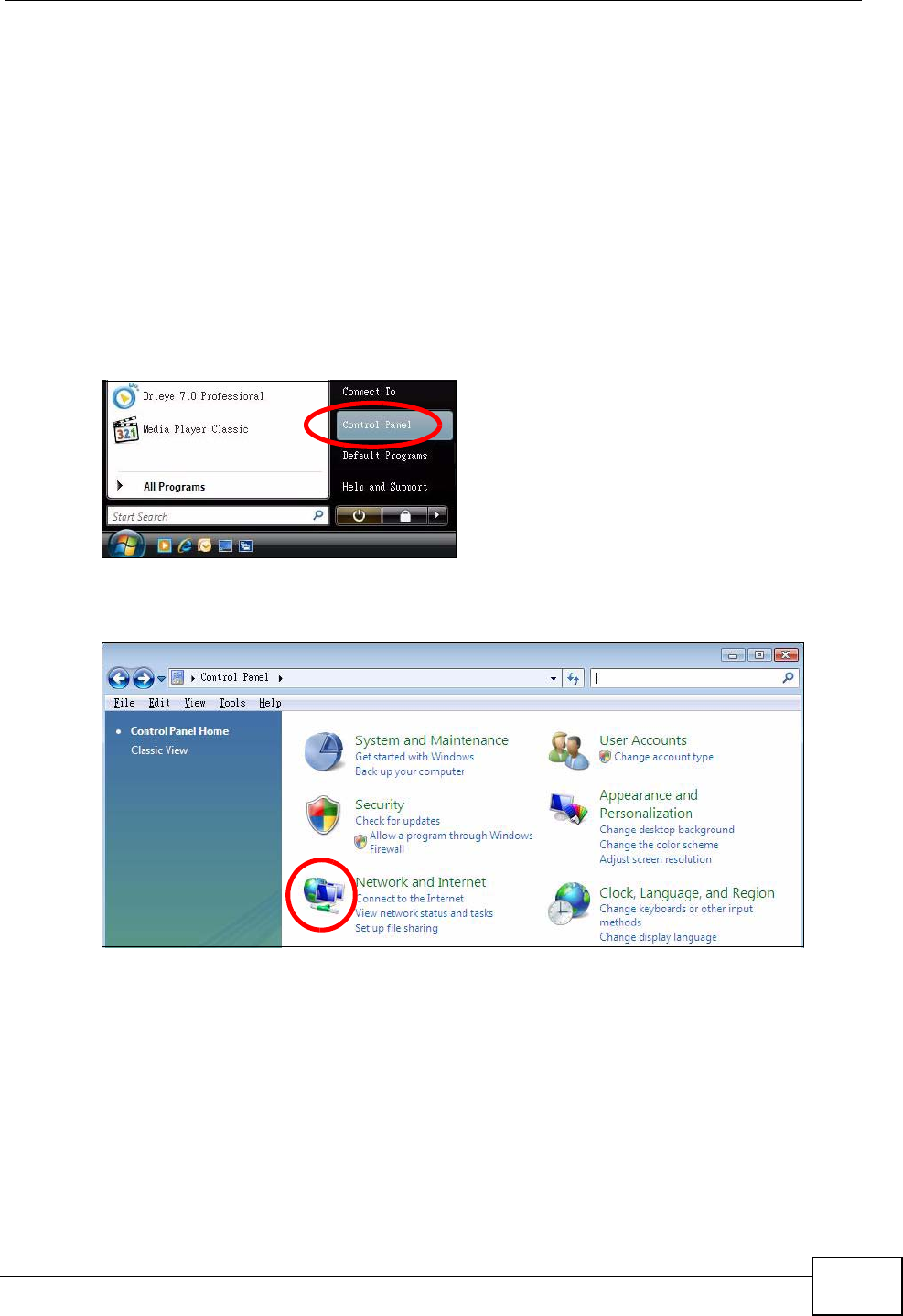
Appendix B Setting Up Your Computer’s IP Address
IAD User’s Guide 249
2In the Command Prompt window, type "ipconfig" and then press [ENTER].
You can also go to Start > Control Panel > Network Connections, right-click a
network connection, click Status and then click the Support tab to view your IP
address and connection information.
Windows Vista
This section shows screens from Windows Vista Professional.
1Click Start > Control Panel.
Figure 126 Windows Vista: Start Menu
2In the Control Panel, click the Network and Internet icon.
Figure 127 Windows Vista: Control Panel
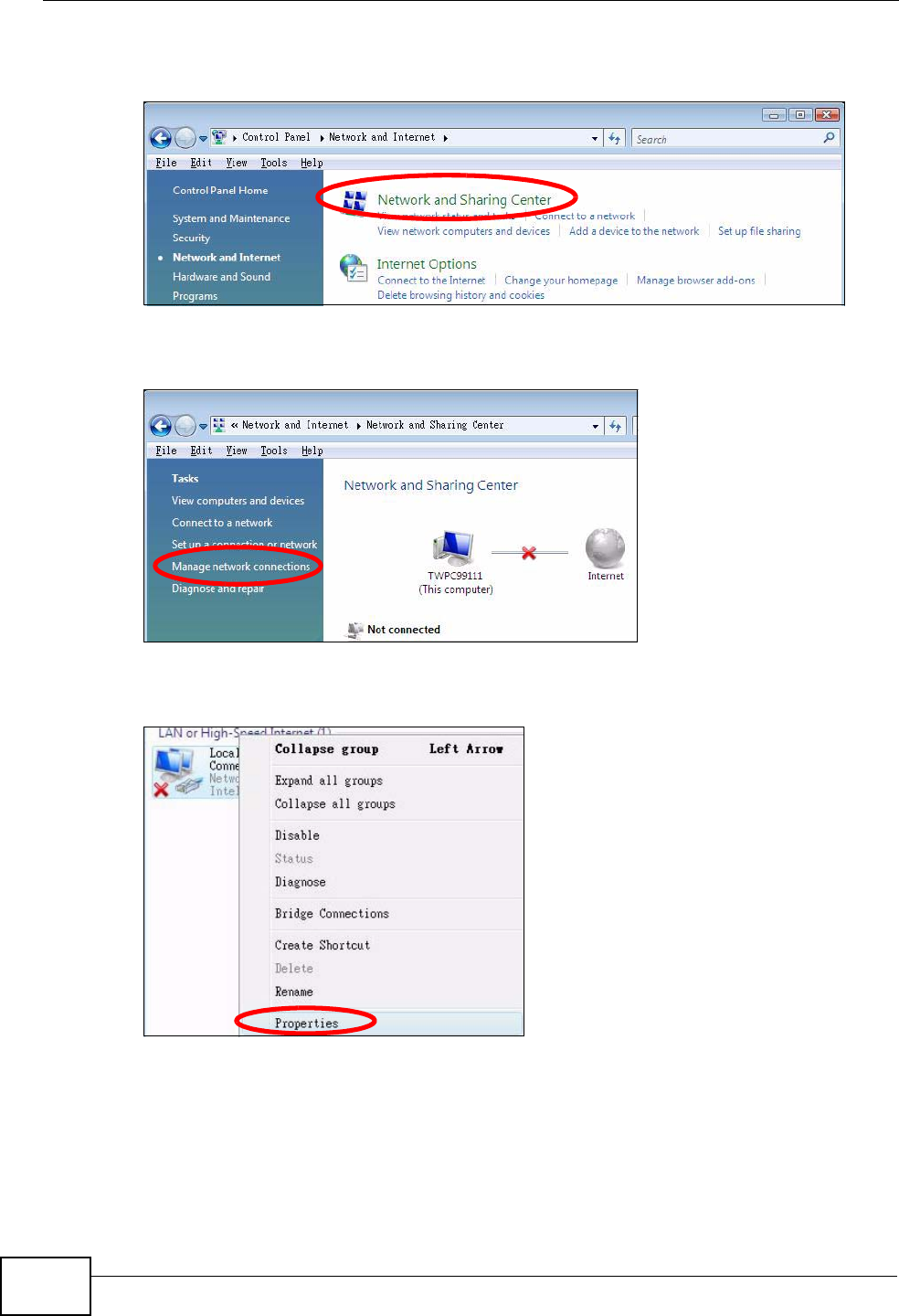
Appendix B Setting Up Your Computer’s IP Address
IAD User’s Guide
250
3Click the Network and Sharing Center icon.
Figure 128 Windows Vista: Network And Internet
4Click Manage network connections.
Figure 129 Windows Vista: Network and Sharing Center
5Right-click Local Area Connection and then select Properties.
Figure 130 Windows Vista: Network and Sharing Center
Note: During this procedure, click Continue whenever Windows displays a screen
saying that it needs your permission to continue.